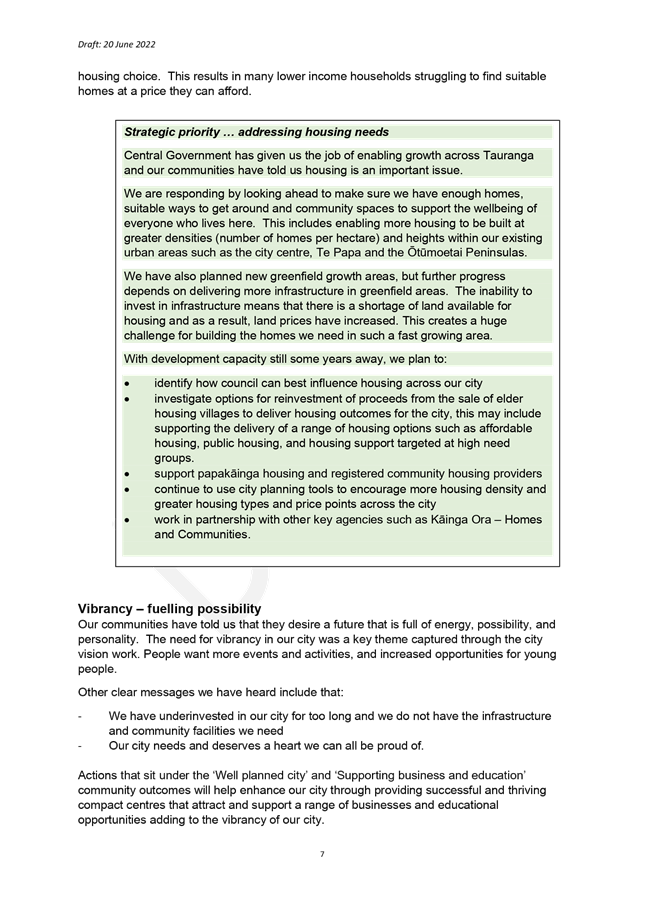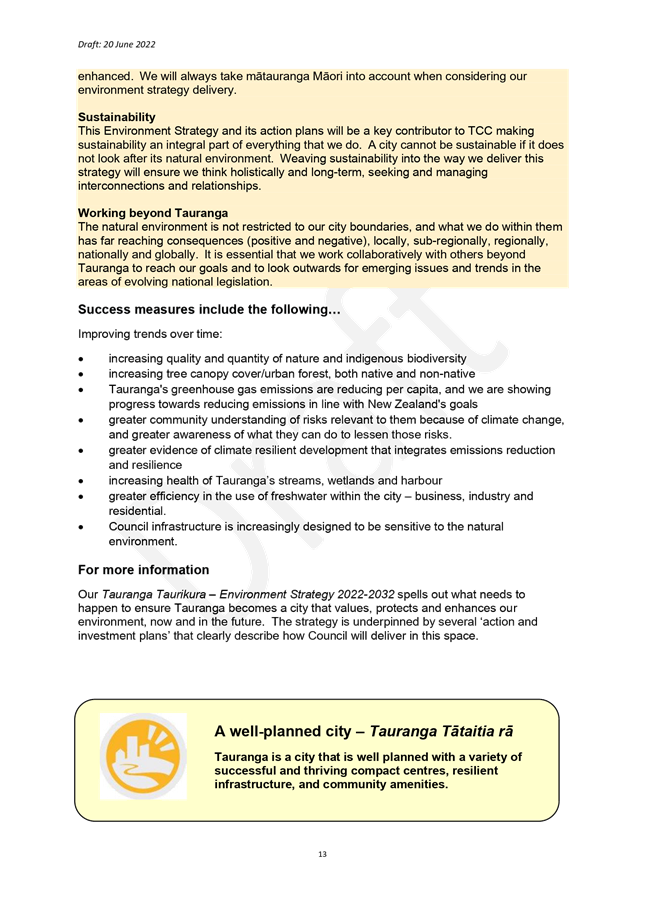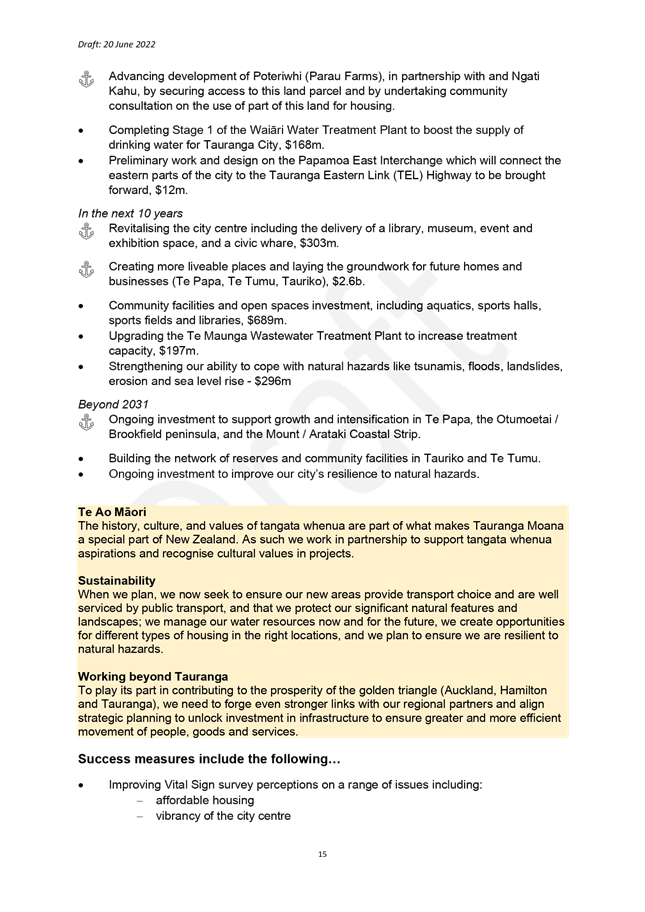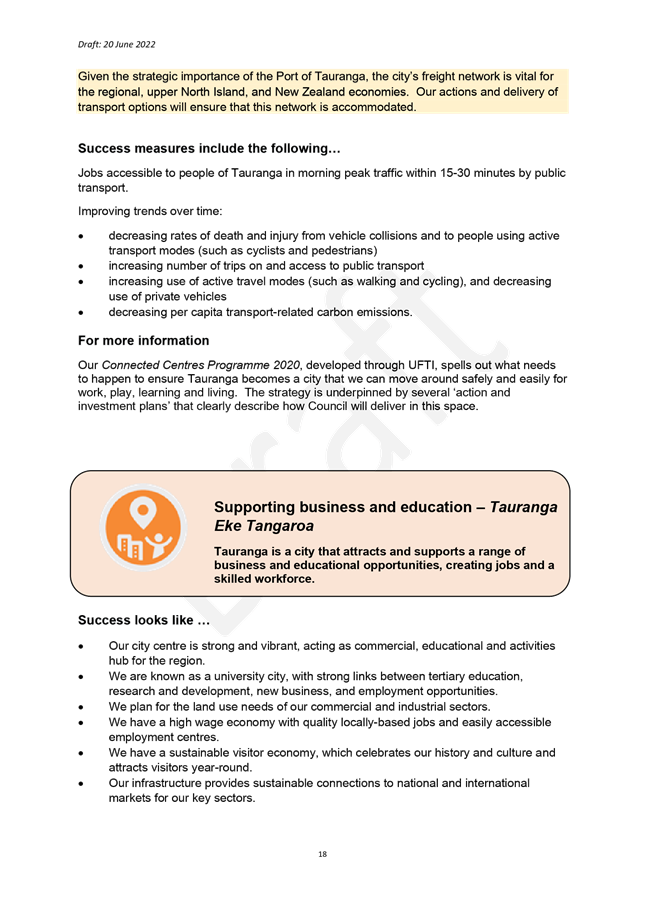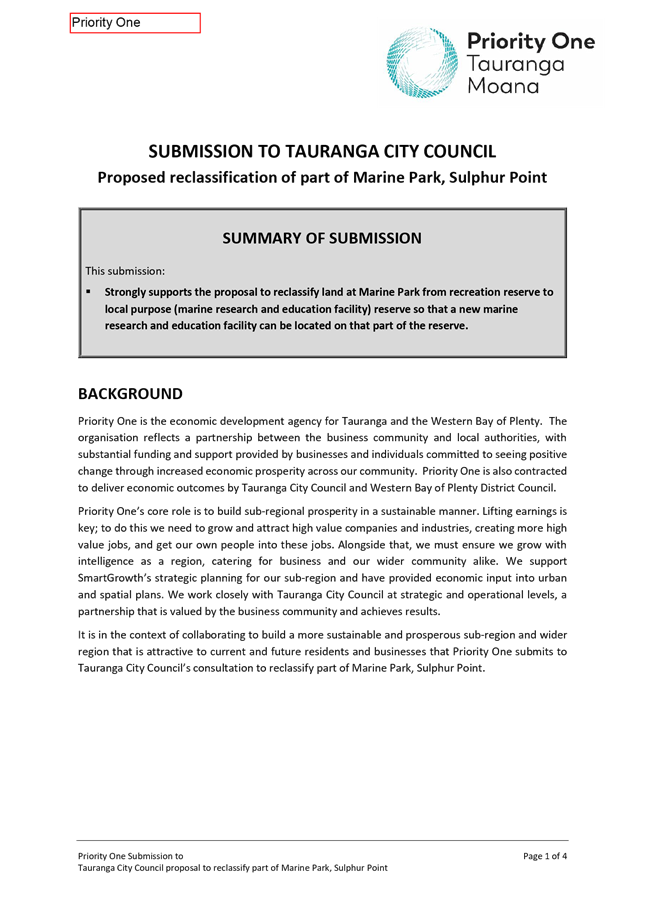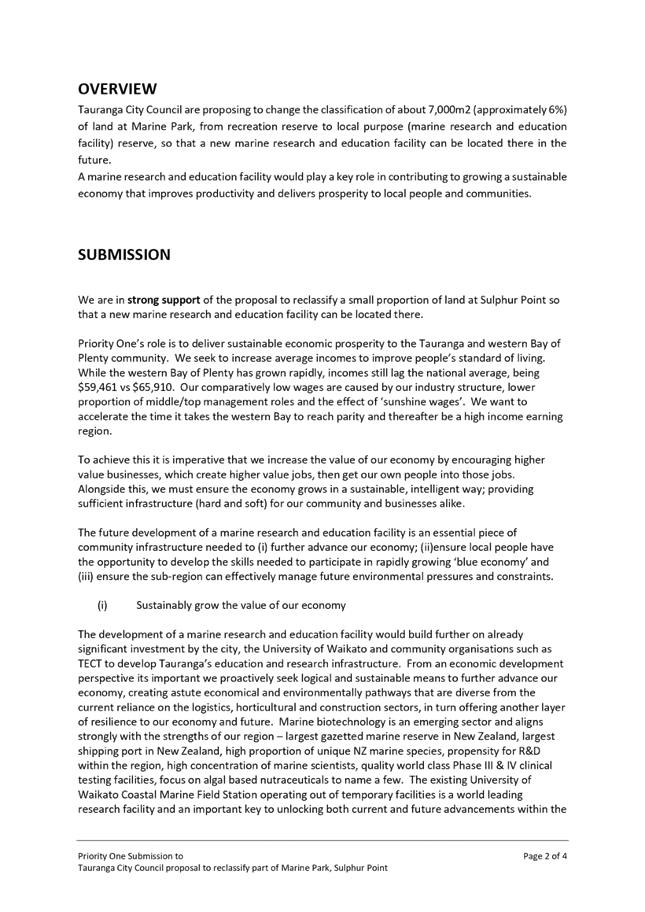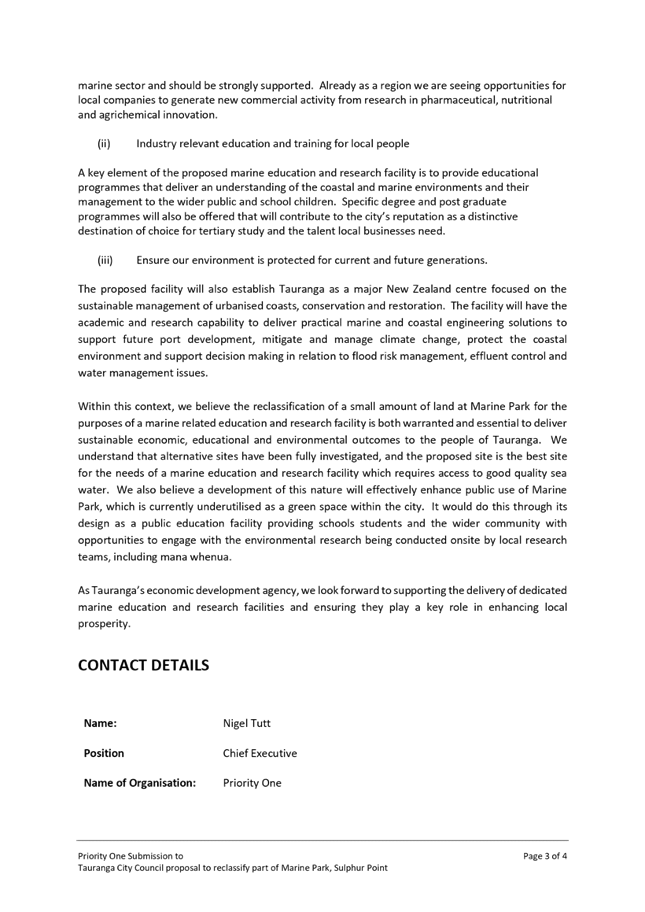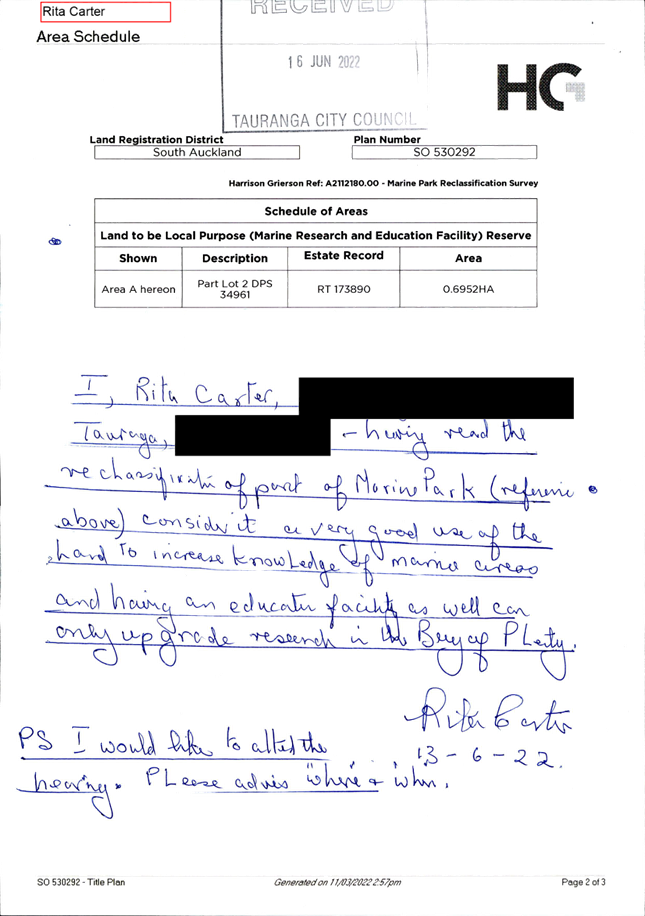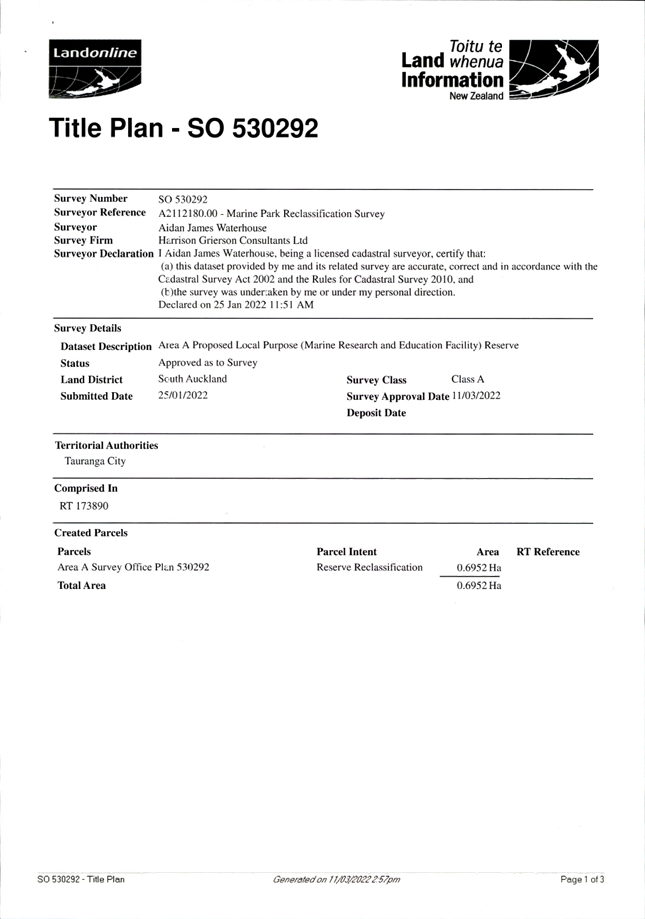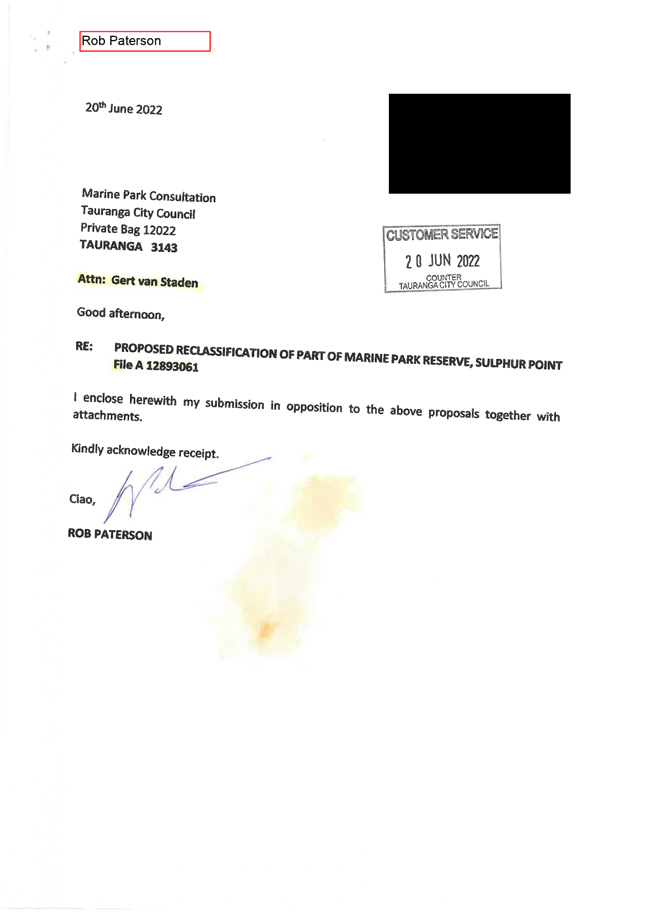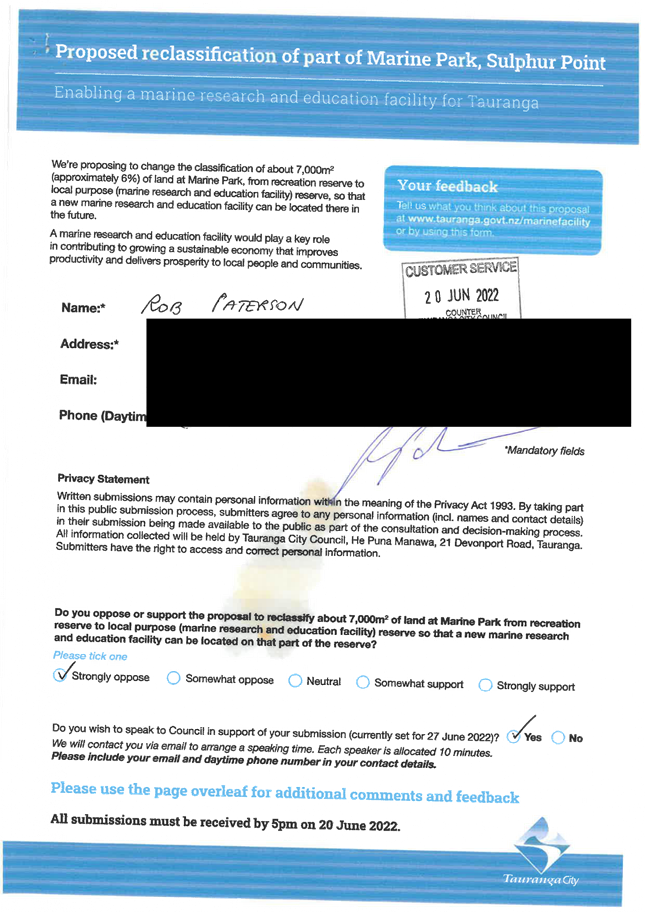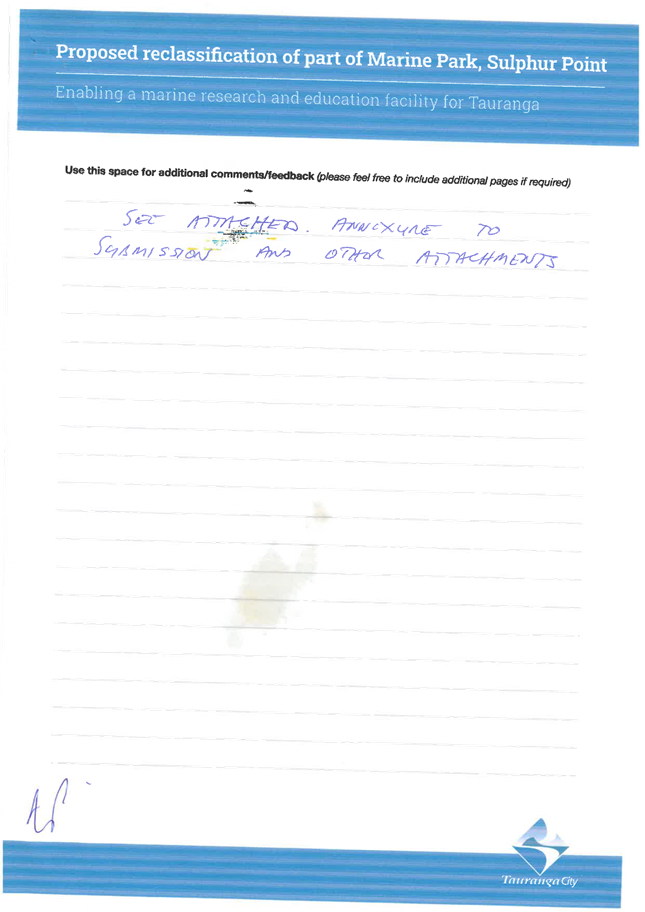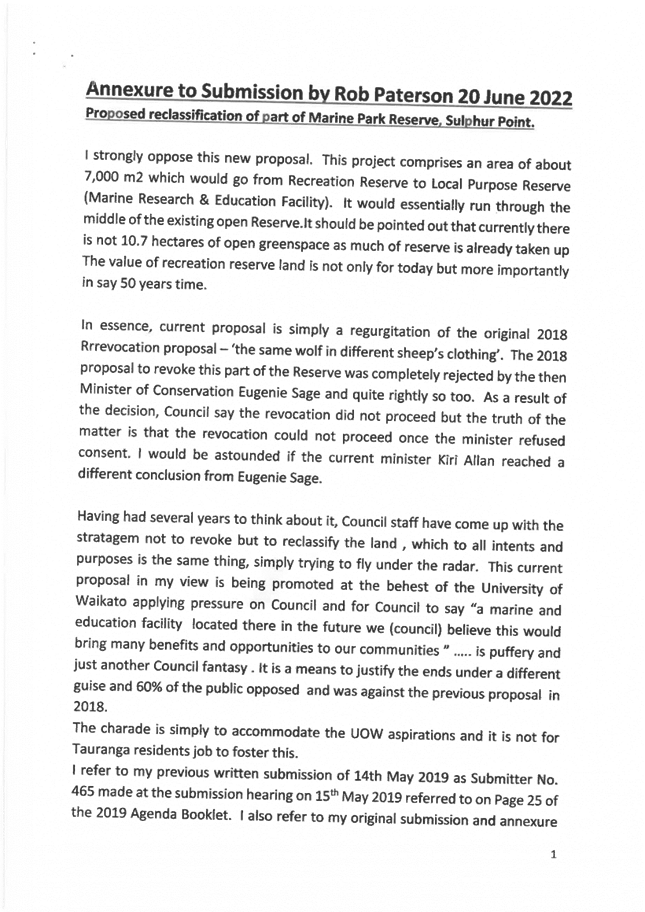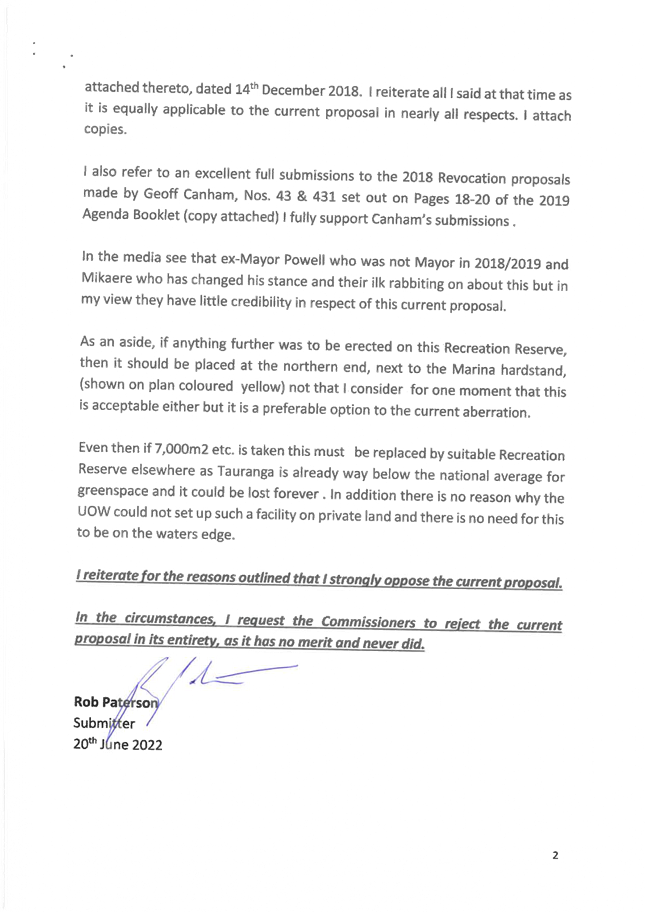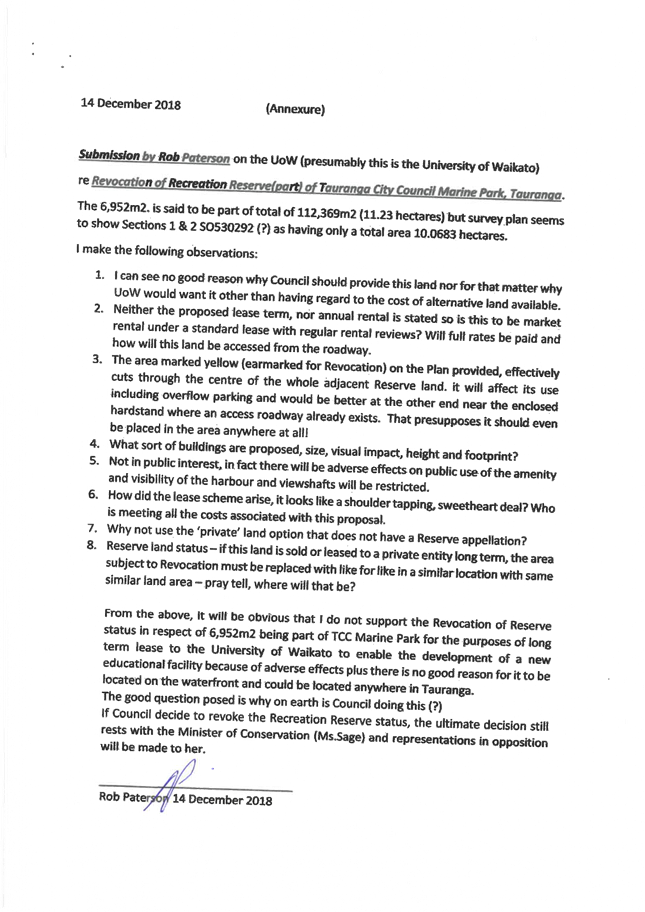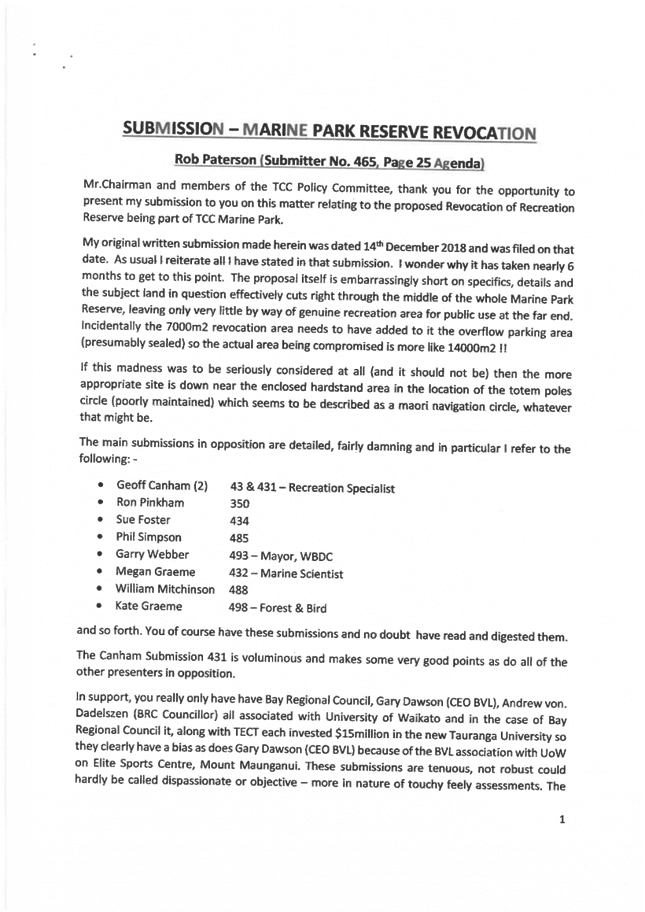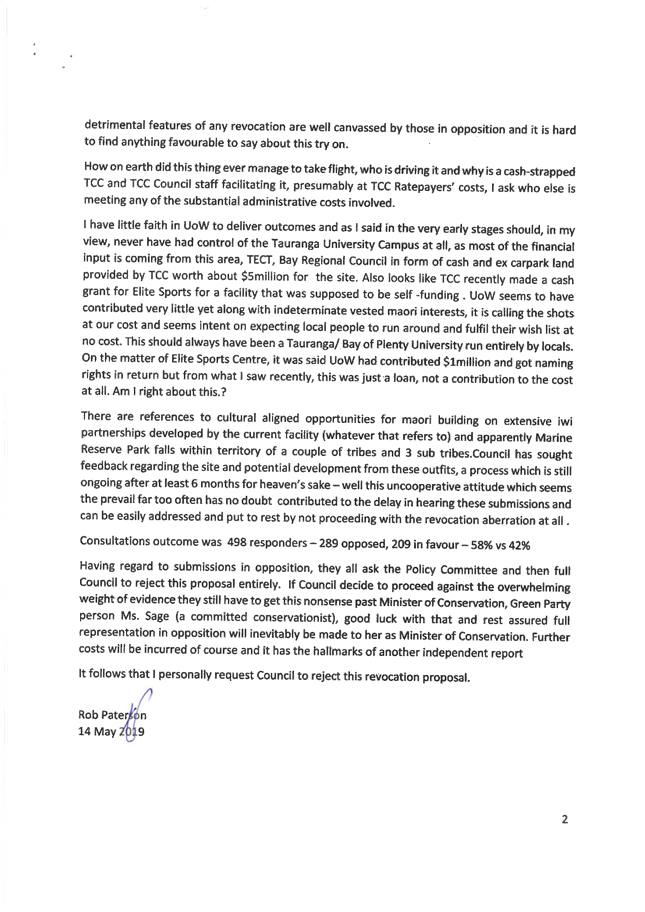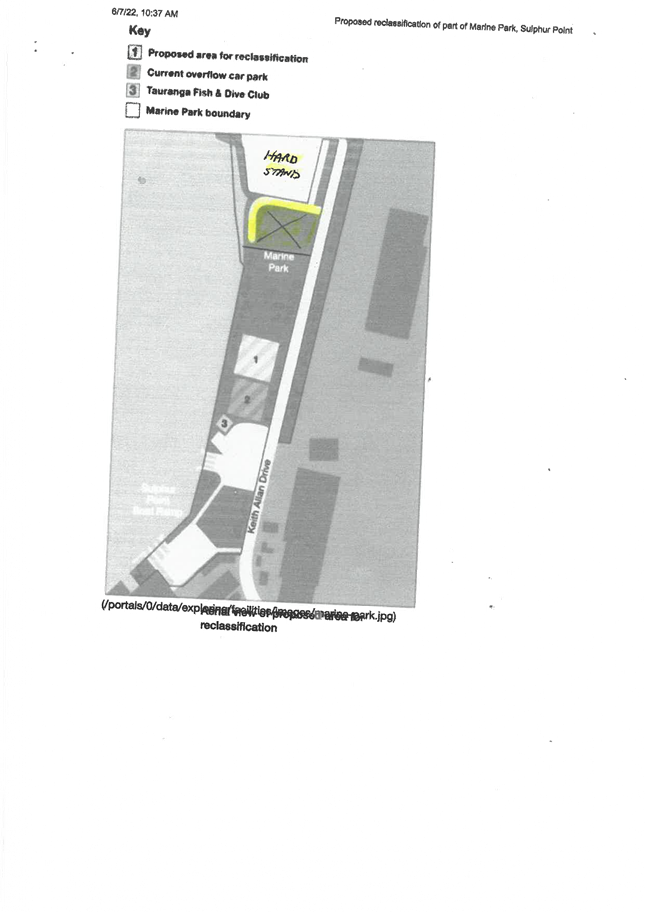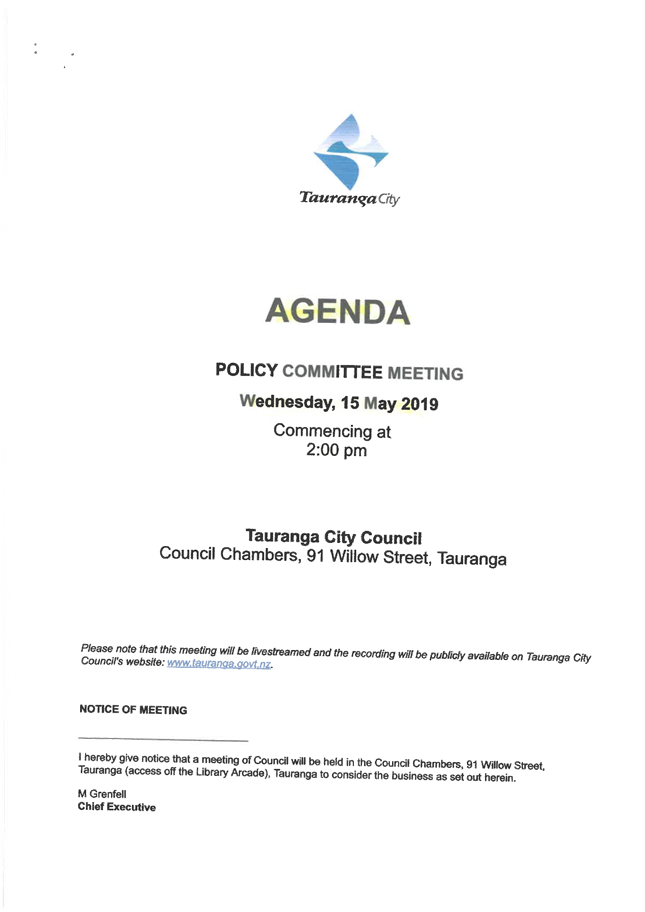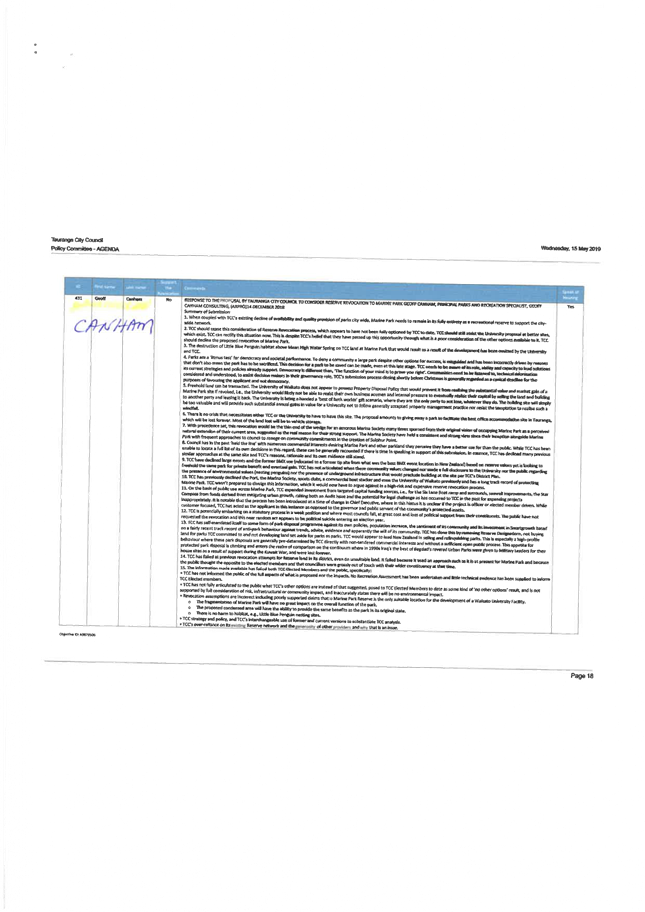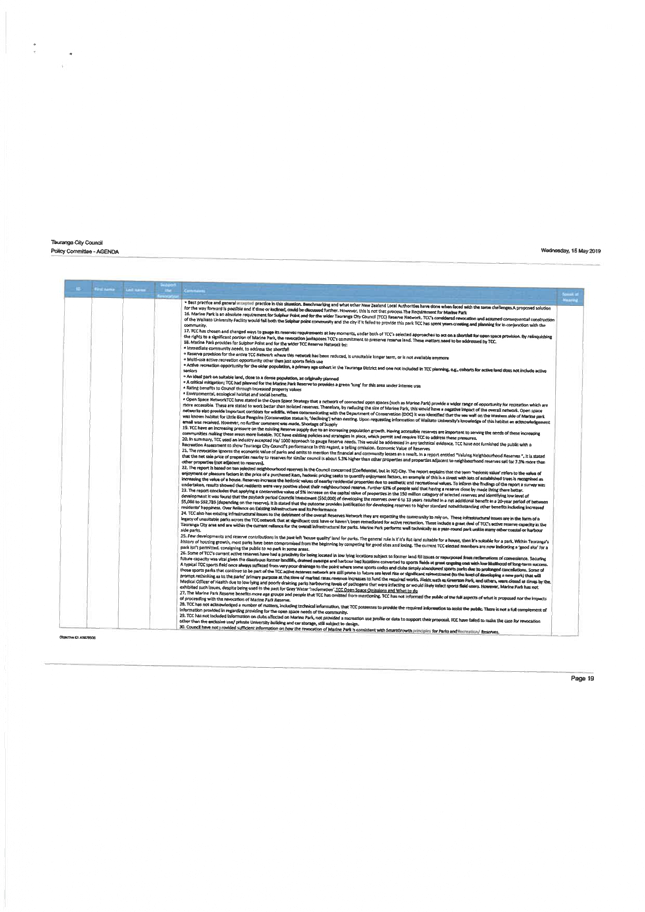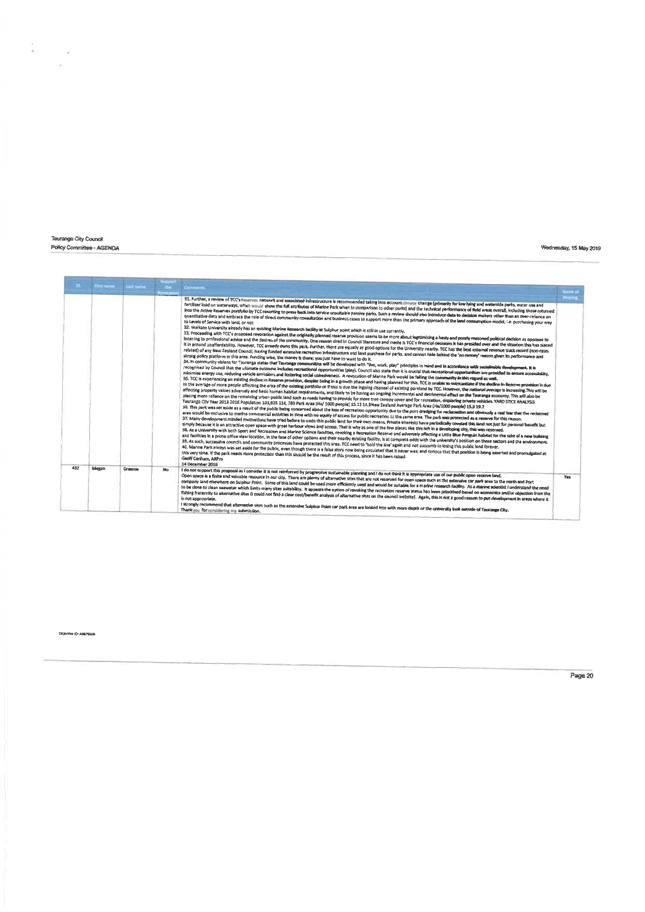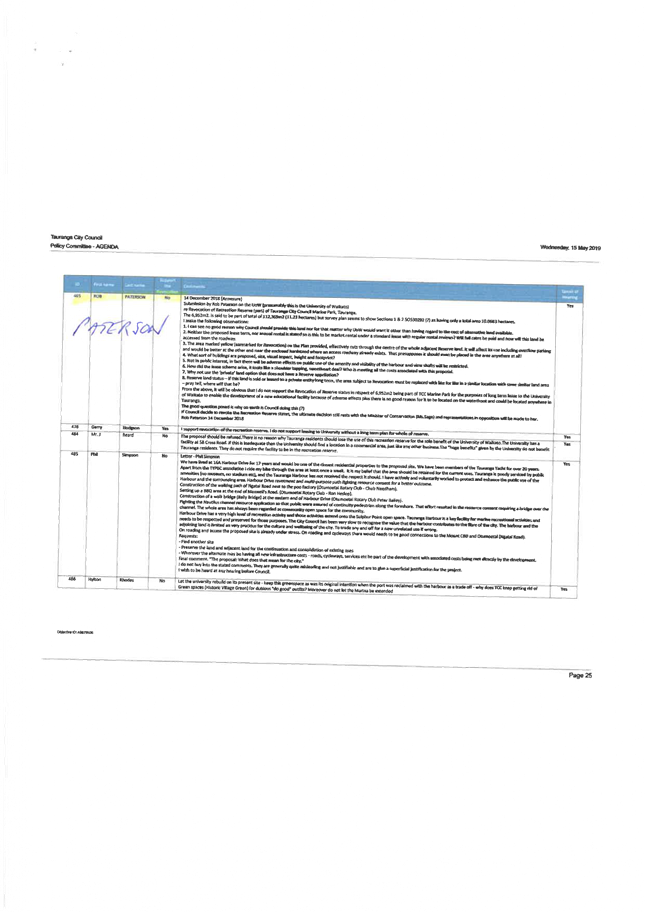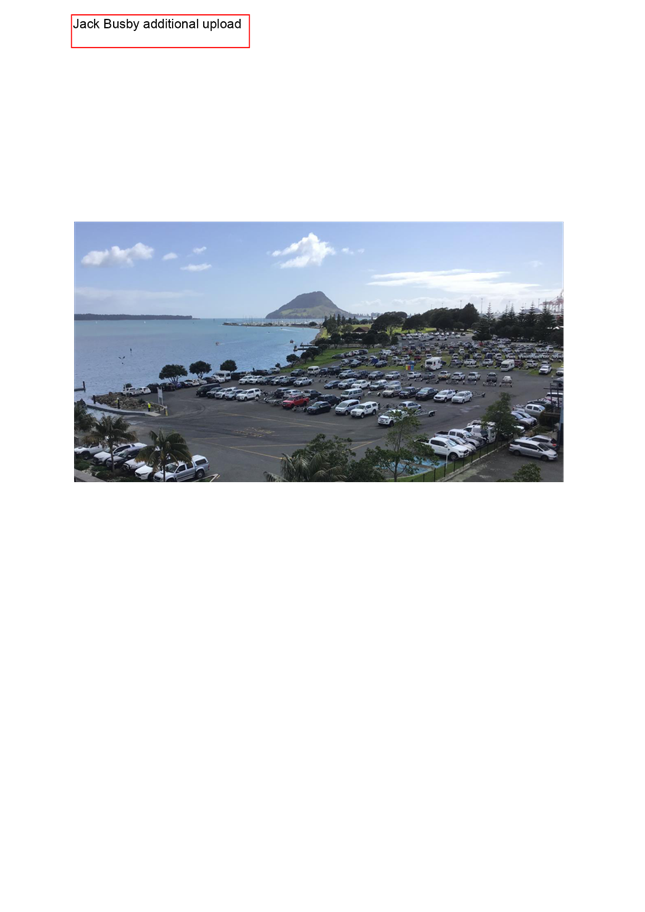|

|
|
AGENDA
Ordinary Council meeting
Monday, 27 June 2022
|
|
I hereby give notice that an Ordinary Meeting of
Council will be held on:
|
|
Date:
|
Monday, 27 June 2022
|
|
Time:
|
9.30am
|
|
Location:
|
Bay of Plenty Regional Council Chambers
Regional House
1 Elizabeth Street
Tauranga
|
|
Please note that this
meeting will be livestreamed and the recording will be publicly available on
Tauranga City Council's website: www.tauranga.govt.nz.
|
|
Marty Grenfell
Chief Executive
|
Membership
|
Chairperson
|
Commission Chair Anne Tolley
|
|
Members
|
|
|
Quorum
|
Half
of the members physically present, where the number of members (including
vacancies) is even; and a majority of the members physically
present, where the number of members (including vacancies) is odd.
|
|
Meeting frequency
|
As
required
|
Role
·
To ensure the effective and
efficient governance of the City
·
To enable leadership of the City
including advocacy and facilitation on behalf of the community.
Scope
·
Oversee the work of all
committees and subcommittees.
·
Exercise all non-delegable and
non-delegated functions and powers of the Council.
·
The powers Council is legally prohibited from delegating include:
o
Power to make a rate.
o
Power to make a bylaw.
o
Power to borrow money, or purchase or dispose of assets, other
than in accordance with the long-term plan.
o
Power to adopt a long-term plan, annual plan, or annual report
o
Power to appoint a chief executive.
o
Power to adopt policies required to be adopted and consulted on
under the Local Government Act 2002 in association with the long-term plan or
developed for the purpose of the local governance statement.
o
All final decisions required to be made by resolution of the
territorial authority/Council pursuant to relevant legislation (for example:
the approval of the City Plan or City Plan changes as per section 34A Resource
Management Act 1991).
·
Council has chosen not to delegate the following:
o
Power to compulsorily acquire land under the Public Works Act
1981.
·
Make those decisions which are required by legislation to be made
by resolution of the local authority.
·
Authorise all expenditure not delegated to officers, Committees
or other subordinate decision-making bodies of Council.
·
Make appointments of members to the CCO Boards of Directors/Trustees
and representatives of Council to external organisations.
·
Consider any matters referred from any of the Standing or Special
Committees, Joint Committees, Chief Executive or General Managers.
Procedural matters
·
Delegation of Council powers to Council’s committees and
other subordinate decision-making bodies.
·
Adoption of Standing Orders.
·
Receipt of Joint Committee minutes.
·
Approval of Special Orders.
·
Employment of Chief Executive.
·
Other Delegations of Council’s powers, duties and
responsibilities.
Regulatory matters
Administration, monitoring and
enforcement of all regulatory matters that have not otherwise been delegated or
that are referred to Council for determination (by a committee, subordinate
decision-making body, Chief Executive or relevant General Manager).
7 Confirmation
of minutes
7.1 Minutes
of the Council meeting held on 28 February 2022
File
Number: A13589051
Author: Robyn
Garrett, Team Leader: Committee Support
Authoriser: Robyn
Garrett, Team Leader: Committee Support
|
Recommendations
That the Minutes of the Council meeting held on 28 February
2022 be confirmed as a true and correct record.
|
Attachments
1. Minutes
of the Council meeting held on 28 February 2022
|
Ordinary Council meeting Minutes
|
28 February 2022
|
|

|
|
MINUTES
Ordinary Council meeting
Monday, 28 February 2022
|
Order of Business
1 Opening karakia. 4
2 Apologies. 4
3 Public Forum.. 4
3.1 Nigel Tutt - Tauriko West 4
3.2 Richard Stilwell - Tauriko West 5
4 Acceptance of late items. 5
5 Confidential business to be transferred into the open. 6
6 Change to the order of business. 6
7 Confirmation of Minutes. 6
7.1 Minutes of the Extraordinary Council meeting held on 14 February
2022. 6
7.2 Minutes of the Council meeting held on 8 February 2022. 6
7.3 Minutes of the Council meeting held on 6 December 2021. 6
8 Declaration of conflicts of interest 7
9 Deputations, Presentations, Petitions. 7
9.1 Papamoa Residents and Ratepayers Association - Links Ave Petition
and Report 7
10 Recommendations from Other Committees. 7
10.1 Terms of Reference for Tangata Whenua/Tauranga City Council
Committee. 7
11 Business. 8
11.1 Long-term Plan Amendment Financials. 8
11.2 Te Manawataki O Te Papa (Civic Precinct) programme Governance
Structure and Key Project Approval Processes. 9
11.3 2022/2023 - Draft User Fees and Charges Update. 11
13.6 TCC’s Infrastructure Funding and Financial proposals –
TSP and Tauriko West 12
11.4 Executive Report 13
11.5 Tauriko West - Enabling Works Business Case. 15
12 Discussion of Late Items. 16
13 Public excluded session. 16
13.1 Public Excluded Minutes of the Council meeting held on 8 February
2022. 17
13.2 Public Excluded Minutes of the Council meeting held on 6 December
2021. 17
13.3 Litigation Report 17
13.4 Commercial Land Assessable for Rates. 18
13.5 Addressing vessels at risk on Bridge Wharf 18
L.6 TCC's Infrastructure Funding and Financing proposals - TSP and
Tauriko West 18
Confidential Attachment 3 11.5 - Tauriko West - Enabling Works Business Case. 18
14 Closing karakia. 18
MINUTES
OF Tauranga City Council
Ordinary Council meeting
HELD AT THE Bay of Plenty
Regional Council Chambers, Regional House, 1 Elizabeth Street, Tauranga
ON Monday, 28 February 2022 AT
10am
PRESENT: Commission Chair Anne Tolley, Commissioner Shadrach Rolleston,
Commissioner Stephen Selwood, Commissioner Bill Wasley
IN ATTENDANCE: Marty
Grenfell (Chief Executive), Tony Aitken (Acting General Manager: People &
Engagement), Paul Davidson (General Manager: Corporate Services), Barbara
Dempsey (General Manager: Regulatory & Compliance), Nic Johansson (General
Manager: Infrastructure), Christine Jones (General Manager: Strategy &
Growth), Gareth Wallis (General Manager: Community Services), Kathryn Sharplin
(Manager: Finance), Frazer Smith (Manager: Strategic Finance & Growth),
Tracey Hughes (Financial Insights & Reporting Manager), Jim Taylor
(Manager: Transactional Services), Jeremy Boase (Manager: Strategy and
Corporate Planning), Andrew Mead (Manager: City and Infrastructure Planning),
Mike Naude (Programme Manager - Civic Redevelopment Projects), Brendan Bisley
(Director of Transport), Alistair Talbot (Team Leader: Transport Strategy &
Planning), Ben Corbett (Team Leader: Growth Funding), Coral Hair (Manager:
Democracy Services), Robyn Garrett (Team Leader: Committee Support), Sarah
Drummond (Committee Advisor), Anahera Dinsdale (Committee Advisor)
1 Opening
Karakia
Commissioner
Rolleston opened the meeting with a karakia.
2 Apologies
Nil
3 Public
Forum
|
3.1 Nigel
Tutt - Tauriko West
|
|
Key points
·
Noted the importance of the Tauriko West development
to the local economy – 6,000 to 12,000 jobs expected in the Tauriko
Business Estate.
·
Public transport was a must for employees and
residents for quality of life, access to jobs, sustainability and emission
reduction.
·
Key transport route included part of SH29;
vital for the Port and for connection to the Golden Triangle.
·
Emphasised the urgency of SH29 works; ideally
the work would have been done already and needed to be done as quickly as
possible.
In response
to questions
·
The Waka Kotahi Business Case barely mentioned
the 12000 jobs or up to 15000 homes that could be in the area. Vital to
connect not only by road but by public transport. Current central government
evaluation processes did not take sufficiently into account the wider social
and economic benefits of the proposal.
·
Often repeating work that had already been
undertaken as part of urban growth strategy planning; should be able to
leapfrog over some of the Waka Kotahi business planning process.
|
|
3.2 Richard
Stilwell - Tauriko West
|
|
Key points
·
Not opposed to the development in Tauriko West
or the business estate; but Tauranga Crossing was concerned about work
proceeding in a partial way.
·
Business case was part of a package –
the enabling works needed to be considered as a part of a larger suite of
public transport works and transport planning.
·
The enabling works were the first of three
stages; the expected outcomes were slight by themselves and needed to be part
of the wider package.
·
Objectives could not be met by the enabling
works on their own.
·
Key risk is that future elements would not
follow.
·
The investment objectives relied on delivery
of all the parts of the package; could not be achieved purely by the enabling
works.
Discussion
points raised
·
Recognised the disconnect between government
policy in terms of housing/public transport/carbon emissions; some of the
processes in place reflected this disconnect and did not provide
certainty. Work on the bigger project needed to start now.
·
Supported the point about the disconnect and
the need for the whole package to be committed – however, necessary to
start with the enabling works. Bigger project needed to be fast-tracked
and certainty provided. Needs of the region were urgent.
|
4 Acceptance
of late items
|
Resolution CO4/22/1
Moved: Commissioner Shadrach
Rolleston
Seconded: Commissioner
Bill Wasley
That the Council:
Accepts the following late item for
consideration in the public excluded section of the meeting:
• TCC’s
Infrastructure Funding and Financing proposals – TSP and Tauriko West
Carried
|
5 Confidential
business to be transferred into the open
|
Resolution CO4/22/2
Moved: Commissioner Bill
Wasley
Seconded: Commissioner
Stephen Selwood
That the Council transfers the late item
report TCC’s Infrastructure Funding and Financing proposals –
TSP and Tauriko West from public excluded session into open session for
consideration.
Carried
|
6 Change
to the order of business
Nil
7 Confirmation
of Minutes
|
7.2 Minutes
of the Council meeting held on 8 February 2022
|
|
Resolution
CO4/22/4
Moved: Commissioner Stephen
Selwood
Seconded: Commissioner
Bill Wasley
That the minutes of the Council meeting
held on 8 February 2022 be confirmed as a true and correct record, subject to
the following corrections:
·
Omanawa Falls – further clarification
provided regarding evaluation of revenue opportunities and charges;
·
Acceptance of Mr Paterson’s late
submission be included in the resolution
Carried
|
8 Declaration
of conflicts of interest
Nil
9 Deputations,
Presentations, Petitions
|
9.1 Papamoa
Residents and Ratepayers Association - Links Ave Petition and Report
|
|
External Philip Brown, Papamoa Residents and Ratepayers Association
(PRRA)
Key points
·
The petition presented to TCC on 25 November
had called for an immediate end to the Links Ave trial, improved engagement
and consultation, and full disclosure of any information gathered by TCC.
·
Considered full and proper community
consultation was not undertaken.
·
Supported removal of the bus lane.
Should be no bus lanes or bus routes on Links Ave, was moved due to the B2B
roadworks.
·
Did not support an extension of the trial.
·
Considered the trial a waste of time and that
TCC was not listening to the residents.
·
PRRA requested full disclosure of traffic and
usage data, and bus patronage. Did not consider the data publicly
available was complete or reliable.
·
Considered the proposed closure was overkill
for the problem; the closure could be time-limited for specific periods.
·
Need to consider data from other surrounding
roads as well as Links Ave.
·
Requested a road user committee be formed of
residents and TCC staff to oversee the trial.
·
Requested TCC hold a “Town Hall”
meeting of all concerned residents on the Links Ave proposals.
Discussion
points raised
·
In the short-term Links Ave was a residential
street and not intended as an arterial. Council must take account of
the safety report received that there was a significant risk for school
children using that street. A bigger long-term piece of work regarding
how Papamoa residents travelled into town and to work was already underway.
·
All data used in the decisions had been
provided to residents; TCC did not have the bus patronage data which had been
requested from Bay of Plenty Regional Council (BOPRC).
·
Noted the formation of the joint Tauranga
Public Transport committee with BOPRC, which would look at how achieve
integrated public transport around the city. Use of public transport on
the B2B route would come to that committee for consideration.
·
All traffic data used in the decision-making
process was in the public domain.
|
10 Recommendations
from Other Committees
|
10.1 Terms
of Reference for Tangata Whenua/Tauranga City Council Committee
|
|
Staff Coral
Hair, Manager: Democracy Services
Key points
·
Move to more marae-based meetings with formal
and informal parts.
·
Included the development of a work programme.
Discussion
points raised
·
Great initiative to engage with hapū at
their place.
|
|
Resolution CO4/22/6
Moved: Commissioner Bill
Wasley
Seconded: Commissioner
Shadrach Rolleston
That
the Council:
(a) Approves
the recommendations from the Tangata Whenua/Tauranga City Council Committee
of 16 February 2022 and adopts the following changes to the Terms of
Reference for the Tangata Whenua/Tauranga City Council Committee.
(i) Remove
distinction of formal and informal meetings.
(ii) Six
meetings per year to be held on marae.
(iii) Members
of Te Rangapū Mana Whenua o Tauranga Moana be
invited to all six meetings. At the
Chairperson’s discretion, Te Rangapū Mana
Whenua o Tauranga Moana members may speak to reports. To avoid doubt only
members of the Committee can move or second recommendations or vote.
(iv) Hapū presentations to be
held at the beginning of each meeting.
(v) The remainder of the business of the Tangata Whenua/Tauranga City
Council Committee will be held at the conclusion of the hapū presentation.
(vi) Minutes will be confirmed at each meeting.
(vii) The
decision on appointing a Deputy Chairperson will be deferred until the new
Independent Chairperson is appointed.
(viii) Livestreaming
of meetings will continue. Livestreaming of presentations by hapū will be subject to permission
from the marae.
Carried
|
11 Business
|
11.1 Long-term
Plan Amendment Financials
|
|
Staff Kathryn
Sharplin, Manager: Finance
Josh Logan, Team Leader: Corporate
Planning
Frazer Smith, Manager: Strategic Finance
& Growth
Tracey Hughes, Finance Insights &
Reporting Manager
Key points
·
Introduced the concept of Infrastructure
Funding and Financing (IFF) levies.
·
Outlined what rate options would look like
without the IFF levies; looking at around 16%.
·
IFF levy brought that rate number down;
provided the ability to smooth the cost of infrastructure over a longer
period; did not require the high levels of debt retirement in early years
that would be required for balance sheets.
In response
to questions
·
Option 1C was the preferred option but other
options would be included in the consultation as well.
·
Extra costs for civic centre rebuild were
included in a targeted rate.
·
Operational costs included interest and debt
costs as well as operational costs, so only new investments were proposed to
be included in the community targeted rate, existing library costs were
included in the general rate. As new projects came on, they would be
included in the targeted rate so the general rate would start to reduce.
·
Grant funding was still subject to
confirmation; the resolution passed capped ratepayer contribution at $150m.
Discussion
points raised
·
Need to think carefully about how to explain
the different options to the community. Need a very clear ‘with
and without’ comparison so the benefits were clearly explained.
|
|
Resolution CO4/22/7
Moved: Commissioner Bill
Wasley
Seconded: Commissioner
Stephen Selwood
That
the Council:
(a) Receives
the report Long-term Plan Amendment Financials;
Carried
|
|
The remaining report recommendations
were left to lie until after the Infrastructure
Funding and Financial proposals report had been considered; and were then put
to the vote.
|
|
Resolution CO4/22/8
Moved: Commissioner Bill Wasley
Seconded: Commissioner
Stephen Selwood
That the Council:
(i) Agrees to
the proposed updates to the draft financials for the proposed 2021-31
Long-term Plan Amendment,
(ii) Agrees to include
the proposed Crown Infrastructure Partners Levies within the Long-term Plan
amendment with offset adjustments to transportation targeted rates applying
from 2025,
iii) Confirms that Option 1c be included in the draft LTPA as
the preferred option and the rating reduction that may be achieved through
the introduction of IFF levies requires further analysis and confirmation and
will be finalised when Council adopts the draft LTPA on 24 March 2022.
Carried
|
|
Attachments
1 LTPA
Graphs
|
|
11.2 Te
Manawataki O Te Papa (Civic Precinct) programme Governance Structure and Key
Project Approval Processes
|
|
Staff Marty
Grenfell, Chief Executive
Mike Naude, Programme Manager: Civic
Redevelopment Projects
External David Lambie, TwentyTwo
John Brockies, Chair Governance Group
Key points
·
The report brought the framework of governance
and delivery of the civic precinct project to Council for approval, needed
assurance that the project was structured and resourced for success.
·
Processes and steps for checking and approval
were outlined in the report, for each component of the project, with the
appropriate gateways and decision points noted.
·
Governance structure was working well so far,
with a number of working and design groups established. This model for
delivery would be retained as the project moved forward.
·
The Governance Group Chair noted that
the Governance Group had collectively spent time going through all the
requirements for the project and was confident to recommend this structure
which drew on subject matter experts but within the Willis Bond agreement
framework. Checks and balances were included to ensure the partnering
agreement was working effectively and equitably. Confident had the
right strategy and structure but would be actively refining as different
stages of the project were reached.
·
Having commissioners chairing a couple of the
steering groups was a deliberate decision, to ensure that the
Commission’s view on integration was reflected throughout and the focus
on future generations maintained.
·
The governance structure struck a balance
between good leadership and good experience, and drew Willis Bond as
development partner into the decision-making framework.
In response
to questions
·
Suggested that a Council “box” be
included in the governance structure diagram as the overall accountable body.
Responsibility for delivery and implementation sat with the Chief Executive
and this responsibility should be reflected in the Terms of Reference.
·
Mana whenua representation was not necessarily
provided for as members of each steering group but were involved as subject
matter experts. Mana whenua cultural input needed to be reflected
across all steering groups and Josh Te Kani had been appointed to fulfil that
function.
·
Acknowledged restoration and historic
importance of the site to mana whenua.
|
|
Resolution
CO4/22/9
Moved: Commissioner Shadrach
Rolleston
Seconded: Commissioner
Bill Wasley
That
the Council:
(a) Receives
this report Te Manawataki O Te Papa (Civic Precinct)
programme Governance Structure and Key Project Approval Processes Report.
(b) Approves
the Te Manawataki O Te Papa Governance and Project Structure:

(c) Approves
the following persons as Chairpersons of the Te Manawataki O Te Papa
Governance Group and Project Steering Groups:
|
Governance/Project
Steering Group
|
Chairpersons
|
|
Te Manawataki o
Te Papa Governance Group
|
Independent Chairperson John Brockies
|
|
Library and Community Hub Steering Group
|
Commissioner Bill Wasley
|
|
Museum and
Cultural Centre Steering Group
|
Commissioner Shadrach Rolleston
|
|
Civic Whare and Exhibition
Facility Steering Group
|
Commissioner Stephen Selwood
|
|
Baycourt
Refurbishment Steering Group
|
General Manager Community Services -
Gareth Wallis
|
|
90 Devonport Road Commercial Building
Fitout Steering Group
|
Independent Chairperson – David
Lambie
|
(d) Acknowledges
the key project approval processes required for the implementation of the Te
Manawataki O Te Papa Programme and the Commercial Development at
90 Devonport Road, as outlined in the Tauranga City Council and Willis
Bond and Company (Tauranga) Partnering Agreement, signed 06 July 2018, to
ensure appropriate Council oversight and decision-making.
Carried
|
|
11.3 2022/2023
- Draft User Fees and Charges Update
|
|
Staff Kathryn
Sharplin, Manager: Finance
Key points
·
Updated schedule following feedback received
from previous council meeting regarding inflation rates and volumetric water
charging, and beachside cabin prices.
·
Revised schedule had adjusted general
increases up to reflect the 5.9% inflation rate.
·
Beachside rates had been examined and looked
at comparatively, and remained unchanged as considered at an appropriate
price point.
·
Water volumetric charges had been increased
slightly.
·
Dog registration charges were not included in
the consultation document as dogs needed to be registered by 1 July
2022. There would be a separate consultation process as a charge
increase was proposed.
In response
to questions
·
Noted the Commission focus on shifting away
from general ratepayer charges to user pays; the adjustment of volumetric
water charging should reflect water usage. Raising water charges and
fees might reduce the need to raise the rate as much – offset by water
user fees rather than the cost sitting with the general ratepayer –
needed to make these options clear to the community.
·
Funding was quarantined within the activity,
though debt retirement funding allowed some flexibility.
|
|
Resolution
CO4/22/10
Moved: Commissioner Stephen
Selwood
Seconded: Commissioner
Bill Wasley
That
the Council:
(a) Receives the report, 2022/2023 - Draft
User Fees and Charges Update.
(b) Approves the draft user fees and charges as
set out in Attachment 1, in order to form part of the supporting
information for consultation on the 2022/23 Annual Plan.
(c) Agrees
to include in the annual plan an overall rates increase, including water
volumetric charging of 13.7%. Notes that excluding water volumetric charging
the overall rates increase is 13%.
Carried
|
|
13.6 TCC’s
Infrastructure Funding and Financial proposals – TSP and Tauriko West
|
|
Staff Paul Davidson, General Manager: Corporate Services
Christine
Jones, General Manager: Strategy and Growth
Key points
·
Noted the difference between the two projects
in terms of the levy.
·
The IFF levy allowed smoothing of costs over a
longer period of time.
·
Levy required going to market for financing
which posed some risk as was an unknown in terms of interest rates.
Considered any risk offset by the overall benefits.
·
Levy placed a charge against every property,
was irreversible and in place for 30 years. Was a legislative charge
that could not be undone. Would be registered on Tauriko titles for new
properties. The Tauriko charge was against appropriate Tauriko West
properties; TSP would be citywide.
·
IFF levy was only one part of funding for
Tauriko West and TSP; council was working with Waka Kotahi and developers in
terms of fair share of payment.
In response
to questions
·
Levies were based on project estimates which
could be variable. Looking at funding $200m via IFF levy, any
subsequent changes would be funded by traditional funding methods such as
rating and development contribution charges. Once set, the IFF levy
could not generate additional revenue. TSP funding was for a bundle of
projects and could be moved around the projects within the bundle; Tauriko
West would have a tendered return before moving to IFF funding which would
provide more certainty for quantum. Need to be as certain as possible
that project estimates were accurate and variation minimised. Noted that
IFF funding only provided a percentage of the costs; balance would be
absorbed/provided elsewhere.
Discussion
points raised
·
High debt levels, low rates and residential
ratepayers bearing a significant portion of the burden of rates had not
provided appropriate funding for the infrastructure needs of the city; these
IFF levies were part of a concerted effort and workload to source alternative
funding mechanisms.
·
The levy spread cost intergenerationally and
transferred debt off TCC balance sheet and into a different structure.
TCC was one of the first councils taking advantage of the IFF tool.
·
Congratulated staff on the work spent getting
these proposals to this point.
|
|
Resolution
CO4/22/11
Moved: Commissioner Stephen
Selwood
Seconded: Commissioner
Shadrach Rolleston
That
the Council:
(a) Receives report “Infrastructure Funding and Financing
Proposals – Transport Systems Plan and Tauriko West’.
(b) Approves progressing the Infrastructure Funding and Financing levy
proposals for the Transport Systems Plan and for Tauriko West.
(c) Notes and confirms the following resolutions of the 21 February
2022 Council meeting with respect to the Tauriko West levy:
(i)
Agrees to consult through the Long-term Plan
Amendment process on the proposal to establish an Infrastructure Funding and
Financing (IFF) local levy for delivery of the infrastructure needed to
enable the first 2,000 dwellings in Tauriko West.
(ii) Approves the principle of ‘development fair share’
funding being applied.
(iii) Notes that the expected level of the Tauriko West IFF levy will be
circa $2,000 -$2,500 per annum.
(iv) Council to engage with developers / landowners on the further
option of a mix of Tauriko West IFF levy and other developer / landowner
funding arrangements with the requirement that these arrangements fully cover
the development fair share costs.
(d) Notes and confirms the following resolutions of the 21 February
2022 Council meeting with respect to the Transport System Plan Levy:
(i)
Agrees to include within the Long-term Plan
Amendment preparation process the proposal to establish an Infrastructure
Funding and Financing (IFF) citywide levy to enable delivery of ten Transport
Systems Plan projects.
(ii) Approves the levy charge being calculated at the same proportional
share as the proposed allocation of transportation rates between residential
and commercial ratepayers (50/50).
(e) With respect to the Transport System Plan Levy, notes that
TCC’s current estimates of the level of the Transport System Plan IFF
levy will be, at the commencement of the levy, $75 - 85 for the median
residential property and $570 - 630 for the median non-residential property.
These estimates are subject to change.
Carried
|
At 11.32am the
meeting adjourned.
At 11.42am the
meeting reconvened.
|
11.4 Executive
Report
|
|
Staff Gareth
Wallis, General Manager: Community Services
Nic Johansson, General Manager:
Infrastructure Services
Barbara Dempsey, General Manager:
Regulatory & Compliance
Paul Davidson, General Manager Corporate
Services
Christine Jones, General Manager:
Strategy & Growth
Tony Aitken, Acting General Manager:
People and Engagement
Key points
·
Noted the success of Angus Muir Christmas
lighting installations on the Strand; noted that the library closed on Sunday
and would reopen in one month in the He Puna Manawa. Kulim Park
playground had opened before Christmas, the rest of the park redevelopment
would be finished by April. Noted ongoing impact of COVID on events.
·
COVID impacts were putting real pressure on
the infrastructure team externally and internally, with lead times for
projects extending and supply of materials an issue.
·
Noted the move of the customer services team
and the change in delivery of services as part of the physical work, now a
concierge model. Noted the move into BOPRC Chambers and the work of the
Democracy team to make that happen.
·
The IENZ audit was postponed due to
Omicron. Building consents had seen a huge influx of applications (up
by 20% over the same period as last year) and there continued to be staff
shortages. TCC was checking with other councils to see if they could
provide assistance and was looking to find contractors to help increase
application turnover; however, turnover times were down. Noted the
impacts on house owner/applicants. Staff were utilising Saturdays for
site inspections.
·
Noted the citywide revaluation distribution;
noted disruption to airport activity due to flight crew issues.
In response
to questions
·
Considered that the governance input was too
involved in the specifics of the Kulim Park project. The basketball
court was removed to allow the rest of the project to start; since the
redevelopment had started there was good community feedback regarding the
basketball court so it was added back in as the project was under
budget. If aspects significantly affected the project outcomes then
would come back for further governance sign-off.
·
Need to provide for recreational needs for all
age groups with city places and spaces, not just younger children.
·
Would be useful to understand where people are
travelling from to attend the various destination parks, to then consider
provision of these types of facilities on a network level. Had very
specific level of service requirements e.g. for playgrounds, but not
well-developed in terms of play and recreation outcomes.
·
Strategic review of green spaces throughout
the community was critical.
·
Detailed input into a project from a specific
group e.g. disability access was required early on in a project. The
community partnerships team could access large parts/sectors of the community
and foster/facilitate input into specific projects, internally need to be
willing to accept that input early on. Cross team and department
collaboration was vital e.g. between Places and Spaces and Infrastructure.
·
Omanawa Falls process was delayed as
responding to a request for additional information from another council.
·
Regarding cost estimations on projects,
project scoping needed to be reviewed to ensure budgeting was as accurate as
possible. Aware of need to improve organisational performance in this
regard – there had been an organisational restructure, Capital Projects
Assurance Division (CPAD) was rolling out consistent templates and industry best
practice for procurement and project management. Noted that standards
could increase/change over time which increased the cost required to meet
those standards.
·
Need to ensure that cyclists could still use
the cycleway network while various roading and infrastructure projects took
place; also, signage about the works would be useful e.g. Totara Street and
Cameron Rd.
·
Raised possibility of an extra
rubbish/recycling pick up over the Christmas period. Including pickups from
reserves and parks.
·
Noted the extension of the Epidemic
Preparedness Order until 18 March, expected to be extended again at that
point.
·
Ramifications of Court decision on mandates
for police and NZDF unknown; at this stage Council had not lost any staff due
to vaccination policies.
·
Citywide revaluations – some areas such
as the CBD saw lower valuations than in the past which would flow onto rates
with a lower increase. Much more disparity with commercial valuations in
terms of impact of Covid.
|
|
Resolution CO4/22/12
Moved: Commissioner Bill
Wasley
Seconded: Commissioner
Shadrach Rolleston
That
the Council:
(a) Receives
the Executive Report.
Carried
|
|
11.5 Tauriko
West - Enabling Works Business Case
|
|
Staff Alistair
Talbot, Team Leader: Transport Strategy & Planning
Andy Mead, Manager, City and
Infrastructure Planning
External Jess Andrew, Waka Kotahi
Key points
·
Business case had identified a package of
improvements in Tauriko West, which would enable 2000 new homes, enable Stage
3 of the Tauriko Business Case and part of the works necessary for Stage 4.
·
Noted travel planning improvements to promote
multi-modal use and deliver the right transport demand pattern.
·
Works continued to be ongoing with funding
partners; once the resolution was passed conversations could continue with
Waka Kotahi, IFF and developers.
·
Engagement had continued with stakeholders,
directly affected landowners, tangata whenua liaison group, Western Bay of
Plenty District Council (WBOPDC), Bay of Plenty Regional Council (BOPRC) and
the general Tauriko community.
·
Outlined risks for the project/business case.
·
Business case would be submitted by April;
ongoing work with Waka Kotahi to confirm pre-implementation phase of work in
term of acquisition and consenting.
·
Longer term business case would continue to be
progressed, this vital to the further development of the area.
In response
to questions
·
These works were part of a much larger
development, all about live/work/play – a significant amount of house
and job growth would result from the long-term development. It was
frustrating that Waka Kotahi and other government processes were limited and
did not facilitate certainty around the longer-term package of works.
·
Noted the significant shift in the costing of
this project, this could undermine confidence in the process.
·
Interregional state highway traffic would be
completely separated from local traffic, walking and cycling routes would
still generally be on local road corridors. Some of the options that
would improve residents’ and community experience would not be realised
until the longer-term Option B works were completed.
·
Overall water and wastewater costs were not
significant. Need to be conscious of changes in terms of concerns
expressed around project scoping and cost estimates.
·
Clarification was sought around the various
percentiles provided for costs. The 95 percentile related to 1/20 and
included risk and P&E costs. Use of percentiles provided a risk
assessment tool for incorporating risk into cost estimates. Costs
included were peer reviewed; escalation of costs were considered at both the
3% and 6% level. Waka Kotahi was involved in cost review to help
achieve certainty of funding.
Discussion
points raised
·
These resolutions approved a small part of a
long-term project that would unlock significant housing and economic growth;
however, council was required to work through a piecemeal stage by stage
business case approval process. The benefits of the project could be
compromised by being forced into this incremental process, only made sense in
terms of the wider social and economic benefits and outcomes. Criticality of
accelerating Long term Option B must be recognised.
|
|
Resolution CO4/22/13
Moved: Commissioner Stephen
Selwood
Seconded: Commissioner
Bill Wasley
That
the Council:
(a) Endorses
the Tauriko West Enabling Works business case for submission to Waka Kotahi
New Zealand Transport Agency for their consideration and investment approval.
(b) Notes
the investment timing, estimated costs, cost sharing and funding sources as
outlined in the Enabling Works business case are subject to final agreement
through project partner decision-making (i.e. National Land Transport Fund)
and wider processes associated with the Infrastructure Funding and Financing
Levies and Infrastructure Acceleration Fund grants.
(c) Notes
that the project costs are estimated to be above those included in the
Councils Long Term Plan 2021-2031 and that these costs will be reflected in
the draft Annual Plan 2022/23 and the Long-Term Plan Amendment being
developed.
(d) Notes
that Waka Kotahi New Zealand Transport Agency have signalled intention to
lead the delivery of the pre-implementation and implementation/construction
phases as presented in the Enabling Works business case and that discussions
to confirm how this occurs is progressing between Council and Waka Kotahi New
Zealand Transport Agency.
(e) Notes that endorsement of the Enabling
Works business case does not commit TCC / Waka Kotahi to implementation, a
further decision-making gate will occur when construction tender costs are
available. This decision gate will be after Waka Kotahi Board decisions on
the Tauriko Network Connections Long-Term Business Case including planned
timing and staging of those works such as a complimentary public transport
package.
(f) Strongly
encourages Waka Kotahi to bring forward and deliver the:
(i) Public
Transport package alongside the Enabling Works; and
(ii) Full State
Highway 29 long term works package with construction commencing by 2025.
(g) Retains Attachment 3 in confidential to
protect Council to carry on, without prejudice or disadvantage commercial
negotiations.
Carried
|
|
Attachments
1 Tauriko
West enabling works presentation
|
12 Discussion
of Late Items
As part of
business.
13 Public
excluded session
RESOLUTION
TO EXCLUDE THE PUBLIC
|
Resolution
CO4/22/14
Moved: Commissioner Bill
Wasley
Seconded: Commissioner
Stephen Selwood
(a)
That the public be excluded from the following
parts of the proceedings of this meeting, with the exception of Mary Hill, Cooney
Lees Morgan, to be present for Item 13.3, Litigation Report.
The
general subject matter of each matter to be considered while the public is
excluded, the reason for passing this resolution in relation to each matter,
and the specific grounds under section 48 of the Local Government Official
Information and Meetings Act 1987 for the passing of this resolution are as
follows:
|
General subject of each
matter to be considered
|
Reason for passing this
resolution in relation to each matter
|
Ground(s) under section 48
for the passing of this resolution
|
|
13.1 - Public Excluded
Minutes of the Council meeting held on 8 February 2022
|
s7(2)(a) - The withholding of the
information is necessary to protect the privacy of natural persons,
including that of deceased natural persons
s7(2)(g) - The withholding of the
information is necessary to maintain legal professional privilege
s7(2)(h) - The withholding of the
information is necessary to enable Council to carry out, without prejudice
or disadvantage, commercial activities
s7(2)(i) - The withholding of the
information is necessary to enable Council to carry on, without prejudice
or disadvantage, negotiations (including commercial and industrial
negotiations)
|
s48(1)(a) - the public conduct of the relevant
part of the proceedings of the meeting would be likely to result in the
disclosure of information for which good reason for withholding would exist
under section 6 or section 7
|
|
13.2 - Public Excluded
Minutes of the Council meeting held on 6 December 2021
|
s7(2)(a) - The withholding of the
information is necessary to protect the privacy of natural persons,
including that of deceased natural persons
s7(2)(h) - The withholding of the
information is necessary to enable Council to carry out, without prejudice
or disadvantage, commercial activities
s7(2)(i) - The withholding of the
information is necessary to enable Council to carry on, without prejudice
or disadvantage, negotiations (including commercial and industrial
negotiations)
|
s48(1)(a) - the public conduct of the
relevant part of the proceedings of the meeting would be likely to result
in the disclosure of information for which good reason for withholding
would exist under section 6 or section 7
|
|
13.3 - Litigation Report
|
s7(2)(a) - The withholding of the
information is necessary to protect the privacy of natural persons,
including that of deceased natural persons
s7(2)(g) - The withholding of the
information is necessary to maintain legal professional privilege
s7(2)(i) - The withholding of the
information is necessary to enable Council to carry on, without prejudice
or disadvantage, negotiations (including commercial and industrial
negotiations)
|
s48(1)(a) - the public conduct of the
relevant part of the proceedings of the meeting would be likely to result
in the disclosure of information for which good reason for withholding
would exist under section 6 or section 7
|
|
13.4 - Commercial Land
Assessable for Rates
|
s7(2)(b)(ii) - The withholding of the
information is necessary to protect information where the making available
of the information would be likely unreasonably to prejudice the commercial
position of the person who supplied or who is the subject of the
information
s7(2)(i) - The withholding of the
information is necessary to enable Council to carry on, without prejudice
or disadvantage, negotiations (including commercial and industrial
negotiations)
|
s48(1)(a) - the public conduct of the
relevant part of the proceedings of the meeting would be likely to result
in the disclosure of information for which good reason for withholding
would exist under section 6 or section 7
|
|
13.5 - Addressing vessels
at risk on Bridge Wharf
|
s7(2)(h) - The withholding of the
information is necessary to enable Council to carry out, without prejudice
or disadvantage, commercial activities
|
s48(1)(a) - the public conduct of the
relevant part of the proceedings of the meeting would be likely to result
in the disclosure of information for which good reason for withholding
would exist under section 6 or section 7
|
|
L.6 - TCC's Infrastructure
Funding and Financing proposals - TSP and Tauriko West
|
s7(2)(i) - The withholding of the
information is necessary to enable Council to carry on, without prejudice
or disadvantage, negotiations (including commercial and industrial
negotiations)
|
s48(1)(a) - the public conduct of the
relevant part of the proceedings of the meeting would be likely to result
in the disclosure of information for which good reason for withholding
would exist under section 6 or section 7
|
|
Confidential Attachment 3 -
11.5 - Tauriko West - Enabling Works Business Case
|
s7(2)(h) - The withholding of the
information is necessary to enable Council to carry out, without prejudice
or disadvantage, commercial activities
s7(2)(i) - The withholding of the
information is necessary to enable Council to carry on, without prejudice
or disadvantage, negotiations (including commercial and industrial
negotiations)
|
s48(1)(a) the public conduct of the
relevant part of the proceedings of the meeting would be likely to result
in the disclosure of information for which good reason for withholding
would exist under section 6 or section 7
|
Carried
|
14 Closing
Karakia
Commissioner Rolleston closed the meeting
with a karakia.
The meeting
closed at 4.55pm.
The
minutes of this meeting were confirmed as a true and correct record at the
Ordinary Council meeting held on 27 June 2022.
........................................................
CHAIRPERSON
7.2 Minutes
of the Council meeting held on 24 March 2022
File
Number: A13591732
Author: Robyn
Garrett, Team Leader: Committee Support
Authoriser: Robyn
Garrett, Team Leader: Committee Support
|
Recommendations
That the Minutes of the Council meeting held on 24 March
2022 be confirmed as a true and correct record.
|
Attachments
1. Minutes
of the Council meeting held on 24 March 2022
|
 Ordinary Council meeting Minutes Ordinary Council meeting Minutes
|
24 March 2022
|
|

|
|
MINUTES
Ordinary Council meeting
Thursday, 24 March 2022
|
Order of Business
1 Opening karakia. 3
2 Apologies. 4
3 Public forum.. 4
4 Acceptance of late items. 4
5 Confidential business to be transferred into the open. 4
6 Change to the order of business. 4
7 Confirmation of minutes. 4
7.1 Minutes of the Council meeting held on 8 February 2022. 4
7.2 Minutes of the Council meeting held on 21 February 2022. 4
8 Declaration of conflicts of interest 4
9 Deputations, presentations, petitions. 4
Nil
10 Recommendations from other committees. 5
Nil
11 Business. 5
11.1 Adoption of consultation document and supporting material -
Long-term Plan Amendment and Annual Plan 2022/23. 5
11.2 Adoption of the Draft 2022/23 Development Contributions Policy. 6
11.3 Active Reserves - actions to increase capacity. 7
11.4 Blake Park and Gordon Spratt Reserve & Alice Johnson Oval -
actions following 'future state' user workshops. 8
11.5 Traffic & Parking Bylaw 2012 - Amendment 35. 9
12 Discussion of late items. 9
13 Public excluded session. 9
13.1 Public Excluded minutes of the Council meeting held on 21 February
2022. 10
13.2 Te Maunga Pond 1 Desludging. 10
13.3 Sale of Elder Housing. 10
13.4 The Sale of Pitau Road and Hinau Street Elder Housing Villages. 10
13.5 19 Grove Avenue, Mount Maunganui 11
11.3 Confidential Attachment 2 - Active Reserves - actions to increase
capacity. 10
14 Closing karakia. 11
MINUTES
OF Tauranga City Council
Ordinary Council meeting
HELD AT THE Ground Floor -
Meeting Room 1, 306 Cameron Road, Tauranga
ON Thursday, 24 March 2022 AT
10am
PRESENT: Commission Chair Anne Tolley, Commissioner Shadrach Rolleston,
Commissioner Stephen Selwood, Commissioner Bill Wasley
IN ATTENDANCE: Marty
Grenfell (Chief Executive), Tony Aitken (Acting General Manager: People &
Engagement), Paul Davidson (General Manager: Corporate Services), Barbara
Dempsey (General Manager: Community Services), Nic Johansson (General Manager:
Infrastructure), Christine Jones (General Manager: Strategy & Growth),
Gareth Wallis (General Manager: Central City Development), Steve Pearce (Acting
General Manager: Regulatory and Compliance), Brendan Bisley (Director of
Transport), Josh Logan (Team Leader: Corporate Planning), Kathryn Sharplin
(Manager: Finance), Tracey Hughes (Financial Insights and Reporting Manager),
Frazer Smith (Manager: Strategic Finance & Growth), Ana Blackwood
(Development Contributions Policy Analyst), Ben Corbett (Team Leader: Growth
Funding), Paul Dunphy (Director of Places & Spaces), Ross Hudson (Team
Leader: Planning), Warren Aitken (Manager: Parks & Recreation), Ceilidh
Dunphy (Community Relations Manager), Libby Dodds (Team Leader: Community
Relations), Robyn Garrett (Team Leader: Committee Support), Sarah Drummond
(Committee Advisor), Anahera Dinsdale (Committee Advisor)
Clarence Susan and Anton Labuschagne, Audit NZ
1 Opening
karakia
Commissioner
Rolleston opened the meeting with a karakia.
|
Staff
Presentation – Warren Aitken – 25 years' service
|
|
·
Warren Aitken joined TCC in 1997 as a Park
Ranger at McLaren Falls and contributed much to the development of the Falls
Park, particularly with significant improvements to the park’s roading
and plantings. Reputed to have piped in the New Year at the Park a
number of times.
·
Moved into the Parks team with a variety of
responsibilities over the years, including leading the Park Ranger team which
looked after all our green spaces and wahi tapu, including Mauao, Moturiki,
Kopurererua Valley and McLaren Falls.
·
Noted his thoughtful and accommodating
approach; genuinely wants to improve the environment and the city’s
green spaces. An acknowledged expert in all thing’s relating to
Tauranga’s natural environment.
·
Chair Tolley thanked Warren on behalf of the
Council and the community for 25 years of outstanding service.
·
Warren – responded that he had been
working for TCC for more than half his life and had thoroughly enjoyed
working for TCC. He was proud of the Parks team and its achievements, and
particularly proud of setting up the programme of removal of coastal
encroachments and restoration of special ecological areas.
|
2 Apologies
Nil
3 Public
forum
Nil
4 Acceptance
of late items
Nil
5 Confidential
business to be transferred into the open
Nil
6 Change
to the order of business
Nil
7 Confirmation
of minutes
8 Declaration
of conflicts of interest
Nil
9 Deputations,
presentations, petitions
Nil
10 Recommendations
from other committees
Nil
11 Business
|
11.1 Adoption
of consultation document and supporting material - Long-term Plan Amendment
and Annual Plan 2022/23
|
|
Staff Paul
Davidson, General Manager: Corporate Services
Kathryn Sharplin, Manager: Finance
External Clarence Susan and Anton Labuschagne, Audit NZ
Key points
·
The civic precinct project and Infrastructure
Funding and Financing (IFF) proposal were key features of the Long-term Plan
Amendment (LTPA). Noted the impact of IFF funding on the balance sheet and
rephasing of the delivery of the capital programme.
·
Annual Plan (AP) proposed to increase the
rating contribution by the commercial sector over the next two years.
Audit NZ
·
Audit opinion covered the LTPA not the
AP. The emphasis of matters noted two issues – uncertainty around
grants funding and the impacts of IFF funding on the balance sheet.
·
Audit had reviewed and tested the underlying
information, including assumptions related to external funding; development
of an LTPA was a complex and difficult process successfully managed in this
case. Thanked the council finance staff for their work.
·
Considered the Consultation Document was clear
around the impacts of receiving/not receiving grant funding for the civic
precinct redevelopment.
·
Intention of IFF was to remove the debt from
Council’s balance sheet – the assumption was reasonable but more
information available would become available as the IFF process continued and
the accounting treatment of each project could be confirmed.
Discussion
points raised
·
Was an important document with exciting opportunities
for the city; there was a choice for Tauranga residents about creating a
vibrant exciting central city or a scaled down version. Would generate
discussion about what should be at the heart of the city.
·
Residents felt they were carrying too bigger a
load in terms of share of rates. The commercial sector had responded
constructively and the Annual Plan included a significant change to how
transport rates were funded, based on an investigation about who benefitted
from the transport infrastructure, which increased the percentage of
transport rates that commercial would pay.
·
A lift in development contributions was
proposed to account for a share of the development of community facilities.
·
Considered alternative methods of funding and
financing; borrowing money where the debt does not show on Council’s
books.
·
Future councils would have more flexibility
about decisions made with the alternative funding arrangements that were now
possible with IFF.
·
Noted the percentage proportions of where
rates would sit with commercial and residential ratepayers. Noted the
increases for the commercial sector and the impact on the business sector;
business community was supportive of the city moving forward and development
taking place.
·
Property valuation increases also impacted on
rates increases. A third of central CBD businesses would have no or
very low rates increases as commercial CBD property values had not increased
significantly.
·
Without rates increases, residents would pay
in other ways through a loss of services and amenity in the city.
·
Expectation of timely and efficient delivery
of services by the organisation, particularly as fees and charges increase.
·
Civic redevelopment as the heart of the city,
working in partnership with iwi and hapū partners.
·
The LTPA sought an additional $221m for the
civic centre development from what was originally committed in the LTP.
Council was also looking at grant funding and funding from asset sales to
minimise the increased cost for ratepayers.
|
|
Resolution CO5/22/3
Moved: Commissioner Stephen
Selwood
Seconded: Commissioner
Bill Wasley
That
the Council:
(a) Receives
the report.
(b) Approves
the consultation document for the proposed amendment to the Long-term Plan
2021-2031 and draft Annual Plan 2022/23 (Attachment 1).
(c) Adopts the
proposed amendment to the Long-term Plan 2021-2031(Attachment 2) to be
consulted on through the Long-term Plan Amendment consultation document.
(d) Adopts the
draft Annual Plan 2022/23 supporting financial information (Attachment 3).
(e) Adopts the
proposed amendments to the fees and charges schedule and the Statement of
Proposal for the draft 2022/23 user fees and charges as the basis for public
consultation (Attachments 4 and 5).
Carried
|
|
Audit NZ
spoke to their audit report and the remaining recommendations were put to the
vote.
|
|
Resolution CO5/22/4
Moved: Commissioner Shadrach
Rolleston
Seconded: Commissioner
Stephen Selwood
That the Council:
(f) Receives
the audit opinion on the consultation document for the proposed Long-term
Plan Amendment, pursuant to s93D (4) of the Local Government Act 2002.
(g) Adopts the
audited consultation document for public consultation for the proposed
Long-term Plan Amendment, using the special consultative procedure pursuant
to s93 and s93A of the Local Government Act 2002.
(h) Authorises
the Chief Executive to make minor amendments to the documentation to ensure
accuracy and correct minor drafting errors.
Carried
|
|
11.2 Adoption
of the Draft 2022/23 Development Contributions Policy
|
|
Staff Christine
Jones, General Manager: Strategy & Growth
Ana
Blackwood, Development Contributions Policy Analyst
Ben Corbett, Team Leader: Growth Funding
Key points
·
Direction given previously on development
contributions had been incorporated into the policy.
·
There had been engagement with the development
and construction sectors.
In response
to questions
·
Consultation had included use of two council
newsletters – planning and environmental – that went out to a
large number of participants in the sector; had been specific contact with
the bigger developers and with the larger building sector. Staff were
trying to reach out to building companies so they were aware the increase was
coming. Had used social media to try and alert “mum and
dad” developers and builders, and linked to the TCC
website. Once the policy was adopted there would be a formal
consultation process.
·
The active reserves policy would be reviewed
this year, which would also include looking at the development contributions
side to assess suitability. 50% of active reserves could be funded by
development contributions.
·
The difference between financial contributions
and development contributions was clarified, in relation to Papamoa reserves.
·
Development contributions were based on cost
estimates and the portion of services/benefit provided that related to
growth; it was better to wait to collect until the project costings were
well-defined for some projects. The Memorial Park aquatic/recreation
centre costs were currently being peer reviewed, materials cost could change
over the years. Noted that project delay was a risk in terms of
collection of development contributions; this risk was managed by collecting
at a rate slightly lower than actual costs then adjusting upwards as a
project progressed.
Discussion
points raised
·
Communication was very important for a no
surprises approach for developers and home buyers.
|
|
Resolution CO5/22/5
Moved: Commissioner Bill
Wasley
Seconded: Commissioner
Stephen Selwood
That
the Council:
(a) Adopts
the Statement of Proposal and Draft 2022/23 Development Contributions Policy
for public consultation
(b) Authorises
the Chief Executive to approve minor draft, financial and presentation
amendments to the Draft 2022/23 Development Contributions Policy prior to
printing if necessary.
Carried
|
|
11.3 Active
Reserves - actions to increase capacity
|
|
Staff Paul
Dunphy, Director, Places and Spaces
Ross
Hudson, Team Leader: Planning
Key points
·
Noted that it was hard to get a clear picture
of the city’s active needs now and in the future and suggested a
workshop would be helpful to gain a more overall picture and context.
In response
to questions
·
It was a very complex picture. Noted the
LTP submissions from various sports clubs about lack of investment and
planning. There was a lot of information in the reports to digest;
suggested that the relevant information could have been pulled out of the
appendices and presented in a more open direct way.
·
Specific parts of the reports could be
progressed separately while other recommendations could be reconsidered after
the workshop. A further report could be brought back in six weeks with
a wider perspective; and a workshop set up to look at wider and future active
needs.
·
Users at Gordon Spratt Reserve were very keen
to see works progress.
Discussion
points raised
·
Consideration should include areas in the
wider Bay of Plenty rather than stopping at TCC boundaries; look at the
possibility of sub-regional development.
·
Need a blueprint for the city and a strategic
overview of sub-regional opportunities; a strategic view was required to be
able to make informed individual decisions on individual projects.
·
Need to look at from a user perspective as
well.
·
Noted that council was currently backfilling
from lack of investment decisions and development over years; but adequate
provision for increased population and their recreational and sporting needs
also needed to be made.
·
Recommendations should clearly outline options
and decisions required rather than refer to appendices.
|
|
Resolution CO5/22/6
Moved: Commissioner Bill
Wasley
Seconded: Commissioner
Stephen Selwood
That
the Council:
(c) Endorses upgrades to Links Avenue
Reserve and Macville Park in Mount Maunganui, to enable the development of a
centralised facility for football talent development and a football academy
for the city, pending agreements with the football clubs and agreement of
budget reallocations through the Annual Plan Deliberations process.
Carried
|
|
Resolution CO5/22/7
Moved: Commissioner Bill
Wasley
Seconded: Commissioner
Shadrach Rolleston
That the
Council:
d) Endorses the provision of
artificial turfs as a sustainable and efficient method to meet local
community demand for sports fields, in appropriate circumstances, and notes
the need to amend the Active Reserve Level of Service Policy in due course to
accommodate this.
Carried
|
|
11.4 Blake
Park and Gordon Spratt Reserve & Alice Johnson Oval - actions following
'future state' user workshops
|
|
Staff Paul
Dunphy, Director, Places and Spaces
Ross
Hudson, Team Leader: Planning
In response
to questions
·
Clarification was provided around a multi-use
pavilion at Alice Johnson Oval and available funding.
·
Provision of cricket nets in Waipuna Park had
been recommended as part of the LTP – wider engagement with Welcome Bay
residents around reserves and recreational needs was now completed and
findings would be provided to the commissioners.
|
|
Resolution CO5/22/8
Moved: Commissioner Bill
Wasley
Seconded: Commissioner
Shadrach Rolleston
That
the Council:
(a) Thanks
the users of Blake Park and Gordon Spratt Reserve and Alice Johnson Oval for
their open-minded engagement in the Future State workshops, and recognises
the support of Sport Bay of Plenty in facilitating these sessions in the
second half of 2021.
(c) Notes
the opportunity for accelerated delivery of a new cricket pavilion at the
Alice Johnson Oval, with budget reallocations to be considered through the
2022/23 Annual Plan Deliberations process.
(d) Notes
the opportunity for early implementation of lighting projects to increase
availability of sports fields, with budget reallocations to be considered
through the 2022/23 Annual Plan Deliberations process .
(f) Completes
the business case for a multi-purpose clubroom facilities, and requests that
staff report to Council with indicatively priced proposals for key actions in
2022.
Carried
|
|
11.5 Traffic
& Parking Bylaw 2012 - Amendment 35
|
|
Staff Brendan
Bisley, Director of Transport
Key points
·
The bylaw changes were associated with the new
Papamoa school; around parking to achieve a safe environment particularly for
drop-offs and pick-ups.
·
There was no on-street parking as the corridor
too narrow.
|
|
Resolution CO5/22/9
Moved: Commissioner Bill
Wasley
Seconded: Commissioner
Stephen Selwood
That
the Council:
(a) Receives the Traffic and Parking Bylaw 2012
Amendments Report.
(b) Adopts the proposed amendments to the Traffic and
Parking Bylaw 2012 Attachment as per Appendix B, effective from 25 March
2022.
Carried
|
12 Discussion
of late items
Nil
13 Public
excluded session
RESOLUTION
TO EXCLUDE THE PUBLIC
|
Resolution CO5/22/10
Moved: Commissioner Shadrach
Rolleston
Seconded: Commissioner
Bill Wasley
That
the public be excluded from the following parts of the proceedings of this
meeting, with the exception of Simon Waalkens and Charlotta Harpur from Rice
Speir for Agenda Item 13.5, 19 Grove Avenue.
The
general subject matter of each matter to be considered while the public is
excluded, the reason for passing this resolution in relation to each matter,
and the specific grounds under section 48 of the Local Government Official
Information and Meetings Act 1987 for the passing of this resolution are as
follows:
|
General subject of each
matter to be considered
|
Reason for passing this resolution
in relation to each matter
|
Ground(s) under section 48
for the passing of this resolution
|
|
11.3 - Confidential
Attachment 2 - Active Reserves - actions to increase capacity
|
s7(2)(h) - The withholding of the
information is necessary to enable Council to carry out, without prejudice
or disadvantage, commercial activities
|
s48(1)(a) the public conduct of the
relevant part of the proceedings of the meeting would be likely to result
in the disclosure of information for which good reason for withholding
would exist under section 6 or section 7
|
|
13.1 - Public Excluded
minutes of the Council meeting held on 21 February 2022
|
s7(2)(i) - The withholding of the
information is necessary to enable Council to carry on, without prejudice
or disadvantage, negotiations (including commercial and industrial
negotiations)
|
s48(1)(a) - the public conduct of the
relevant part of the proceedings of the meeting would be likely to result
in the disclosure of information for which good reason for withholding
would exist under section 6 or section 7
|
|
13.2 - Te Maunga Pond 1
Desludging
|
s7(2)(b)(ii) - The withholding of the
information is necessary to protect information where the making available
of the information would be likely unreasonably to prejudice the commercial
position of the person who supplied or who is the subject of the
information
s7(2)(i) - The withholding of the
information is necessary to enable Council to carry on, without prejudice
or disadvantage, negotiations (including commercial and industrial
negotiations)
|
s48(1)(a) - the public conduct of the
relevant part of the proceedings of the meeting would be likely to result
in the disclosure of information for which good reason for withholding
would exist under section 6 or section 7
|
|
13.3 - Sale of Elder
Housing
|
s7(2)(i) - The withholding of the
information is necessary to enable Council to carry on, without prejudice
or disadvantage, negotiations (including commercial and industrial
negotiations)
|
s48(1)(a) - the public conduct of the
relevant part of the proceedings of the meeting would be likely to result
in the disclosure of information for which good reason for withholding
would exist under section 6 or section 7
|
|
13.4 - The Sale of Pitau
Road and Hinau Street Elder Housing Villages
|
s7(2)(i) - The withholding of the
information is necessary to enable Council to carry on, without prejudice
or disadvantage, negotiations (including commercial and industrial
negotiations)
|
s48(1)(a) - the public conduct of the
relevant part of the proceedings of the meeting would be likely to result
in the disclosure of information for which good reason for withholding
would exist under section 6 or section 7
|
|
13.5 - 19 Grove Avenue,
Mount Maunganui
|
s7(2)(a) - The withholding of the
information is necessary to protect the privacy of natural persons,
including that of deceased natural persons
s7(2)(g) - The withholding of the
information is necessary to maintain legal professional privilege
s7(2)(i) - The withholding of the
information is necessary to enable Council to carry on, without prejudice
or disadvantage, negotiations (including commercial and industrial
negotiations)
|
s48(1)(a) - the public conduct of the
relevant part of the proceedings of the meeting would be likely to result
in the disclosure of information for which good reason for withholding
would exist under section 6 or section 7
|
Carried
|
14 Closing
karakia
Commissioner Rolleston closed the meeting
with a karakia.
The
recent passing of Sir Wira Gardiner was acknowledged and his contributions both
at a Māori/Crown
perspective and on a local level were noted.
The
passing of Oscar Nathan’s mother Puawaitanga Nathan-Parra was also
acknowledged.
The
meeting closed at 12.05pm.
The
minutes of this meeting were confirmed as a true and correct record at the
Ordinary Council meeting held on 27 June 2022.
........................................................
CHAIRPERSON
7.3 Minutes
of the Council meeting held on 23 May 2022
File
Number: A13589034
Author: Robyn
Garrett, Team Leader: Committee Support
Authoriser: Robyn
Garrett, Team Leader: Committee Support
|
Recommendations
That the Minutes of the Council meeting held on 23 May 2022
be confirmed as a true and correct record.
|
Attachments
1. Minutes
of the Council meeting held on 23 May 2022
|
 Ordinary Council meeting minutes Ordinary Council meeting minutes
|
23 May 2022
|
|

|
|
MINUTES
Ordinary Council meeting
Monday, 23 May 2022
|
Order of Business
1 Opening karakia. 3
2 Apologies. 3
3 Public forum.. 3
3.1 Mr Matt Nicholson - Links Ave. 3
4 Acceptance of late items. 4
4.1 Acceptance of late item - Baypark, Blake Park, Tauranga Domain -
Masterplans and Indicative Actions. 4
5 Confidential business to be transferred into the open. 4
6 Change to the order of business. 5
7 Confirmation of minutes. 5
7.1 Minutes of the Council meeting held on 2 May 2022. 5
8 Declaration of conflicts of interest 5
9 Deputations, presentations, petitions. 5
9.1 Kingswood Road petition Carolyn Lee and Peter Ross. 5
10 Recommendations from other committees. 6
Nil
11 Business. 6
11.1 Community Stadium - feasibility study and next steps. 6
11.8 Baypark, Blake Park, Tauranga Domain - Masterplans and Indicative
Actions. 8
11.2 Three Waters Reform.. 9
11.3 Executive Report 11
11.4 Growth & Land Use Projects Progress Report - May 2022. 12
11.5 Transport Strategy and Planning Progress Report - May 2022. 13
11.6 Traffic & Parking Bylaw (2012) Amendment 37. 14
11.7 Long-term Plan 2021 - Actions Report 15
12 Discussion of late items. 15
13 Public excluded session. 15
13.1 Public Excluded Minutes of the Council meeting held on 2 May 2022. 15
13.2 Exemption to Open Competition - Demolition of Vessels, Chatham
Explorer and Loyal 16
13.3 Exemption from Open Competition for the Relocation of the Central
City Bus Interchange 16
13.4 Interim Litigation Report 16
14 Closing karakia. 16
MINUTES
OF Tauranga City Council
Ordinary Council meeting
HELD AT THE Bay of Plenty Regional
Council Chambers, Regional House, 1 Elizabeth Street, Tauranga
ON Monday, 23 May 2022 AT
9.30am
PRESENT: Commission Chair Anne Tolley, Commissioner Shadrach Rolleston,
Commissioner Stephen Selwood, Commissioner Bill Wasley
IN ATTENDANCE: Marty
Grenfell (Chief Executive), Tony Aitken (Acting General Manager: People &
Engagement), Paul Davidson (General Manager: Corporate Services), Barbara
Dempsey (Acting General Manager: Community Services), Nic Johansson (General
Manager: Infrastructure), Christine Jones (General Manager: Strategy &
Growth), Gareth Wallis (General Manager: Central City Development), Paul Dunphy
(Director of Spaces and Places), Dianne Bussey (Contractor – Three Water
Reforms), Cathy Davidson (Manager: Directorate Services), Stephen Burton
(Director of City Waters), Carlo Ellis (Manager: Strategic Māori
Engagement), Andy Mead (Manager: City & Infrastructure Planning), Will
Hyde, (Senior Transportation Engineer), Alister Talbot (Team Leader, Transport
Strategy and Planning), Josh Logan (Team Leader: Corporate Planning), Coral
Hair (Manager: Democracy Services), Robyn Garrett (Team Leader: Committee
Support), Sarah Drummond (Committee Advisor), Anahera Dinsdale (Committee
Advisor), Janie Storey (Committee Advisor)
1 Opening
karakia
Commissioner Rolleston opened the meeting with a karakia.
2 Apologies
Nil
3 Public
forum
|
3.1 Mr
Matt Nicholson - Links Ave
|
|
Key Points
·
Considered the first road closure trialled to
help safety of children at local schools was not fit for purpose and while it
may have achieved some of its outcomes it did not meet them all.
·
Second trial was confusing, the signage
inadequate and was not well publicised. 8,500 road users were fined and
many more warned, which resulted in making people feel like criminals.
·
There was minimal consultation with those
affected; Links Ave users were isolated from families and friends and did not
feel heard by the Council.
·
One resident was denied a waiver three times
to exit her own street.
·
Fines were imposed at a time of
unaffordability with high inflation and increasing costs and people should
not have to choose between paying fines and buying food.
·
Residents felt their concerns remained unheard
and unconsidered.
·
All fines should be refunded.
·
Safety was not just a Links Ave issue, it
affected a wider area. The street’s capacity for pedestrian
traffic was not suitable and there were a number of children now walking on
the street.
·
Narrow footpaths for kids walking and biking;
there was a flow on effect onto Golf Road which had resulted in a safety
issue for children.
·
The road was used by 7500 motorists a day,
traffic had to go somewhere and had been pushed onto the already congested
surrounding streets.
·
If the trial was there to protect children why
was it operating at times when there were not children going to or from
school.
·
Mr Nicholson tabled the petition.
At 9.41am the
meeting adjourned.
At
10.12am the meeting reconvened.
In response
to questions
·
Two issues on the table - the first being
remissions of fines on which staff would provide a report to the 13 June 2022
Council meeting. Second issue was the ongoing issues around the trial
which was currently at the mid-point of a four-month trial. Council would
come back to community with an update following the trial.
·
A group of people, including those with an
interest in or affected by Links Avenue, would come together to find what a
solution might look like for residents and the wider community. This
was still being worked on and would also be discussed at the 13 June 2022
Council meeting.
·
The trial would continue as a change of
behaviours was starting to be seen.
·
If petitioners wished to speak in the public
forum at the Council meeting they must follow the process and register. To
avoid duplication, a decision would then be made as to who would speak.
·
Thanks to all for attending the meeting as
Councillors had been struggling for two terms to deal with the issue.
·
It must now be dealt with as it was a safety
issue for children going to and from school and no one wanted to see a child
hurt.
·
Council understood the disruption to lives but
asked everyone to follow the rules while a sensible solution was found.
|
|
Attachments
1 Links
Ave petition
|
4 Acceptance
of late items
5 Confidential
business to be transferred into the open
Nil
6 Change
to the order of business
Nil
7 Confirmation
of minutes
8 Declaration
of conflicts of interest
Nil
9 Deputations,
presentations, petitions
|
9.1 Kingswood
Road petition Carolyn Lee and Peter Ross
|
|
Key Points
·
Concerned with behaviour of drivers in the
street and seeking Council to provide a safer environment within the area.
·
Burnouts happened quite often; cars had also
lost control and damanged fences etc with instances of dangerous driving and
speeding becoming more frequent.
·
Neighbourhood included many young families so
there was a big concern for the safety of children.
·
Many motorists entering Kingswood Road tended
to accelerate and often reached speeds of 80km.
·
Petitioner had seen four accidents caused due
to speed.
·
There was nowhere to safely cross the road for
familes and people coming from the Clifton Terrace reserve because of the
excessive speed of some vehicles.
·
Petition with 105 signatures showed the concern
expressed by residents.
·
Volunteers were prepared to install speed
humps themselves if needed.
·
Suggested that traffic islands be installed as
pedestrian refuges for people crossing the road or speed humps similar to
Sutherland Road to slow the traffic.
·
Kingswood Ave was a cul-de-sac not a
thoroughfare.
In response
to questions
·
Currently there were no pedestrian crossings
on the section of road.
·
Traffic going over speed humps could be quite
noisy.
·
Drivers try to make the street as straight as
possible by cutting corners, with the Woodford Road and Clifton Terrace
intersections being danger zones.
·
Danger to motorists coming out of side roads
with traffic travelling so fast.
Discussion
points raised
·
It was noted that there was funding included
in the Annual Budget (being decided on 24 May 2022) to implement safety
improvement works in Kingswood Rd.
|
|
Resolution CO9/22/3
Moved: Commissioner Bill
Wasley
Seconded: Commissioner
Stephen Selwood
That the Council
receives the Kingswood Road petition.
Carried
|
10 Recommendations
from other committees
Nil
11 Business
|
11.1 Community
Stadium - feasibility study and next steps
|
|
Staff Gareth
Wallis, General Manager: Central City Development
External Dean Kimpton, Nigel Tutt and Hugh Hutchison
from Priority 1
Key points
·
Partnership approach, while the project was on
Council land, TCC would be a partner but not run the process; other
organisations involved included Sport BOP, BOPRC.
·
Not just a sports stadium – it would
have other uses including cultural events and concerts.
·
Feasibility study only at this stage and was
not a finished product - there was much work still to be done.
·
Believed stadium was feasible and strongly
recommended to proceed to the next stage of detailed design work.
·
Noted key requirements to enable constant
community use of domain - it would work equally well for all users, maximise
revenue generation, complement wider network and CBD precinct, carve a unique
niche for city and be world leading in its approach.
·
Recommended location Wharepai Domain, seen as
ideal location for what was trying to achieve.
·
Sight line between the Domain and Mauao a key
consideration, particularly for stunning views for on-air broadcasting.
·
Had considered geotechnical issues along the
boundary with the highway; also the interaction with tree lines and
residential areas.
·
A three sided stadium would retain the Mauao
sightline and be protected from prevailing conditions rather than making it a
four sided or covered stadium.
·
Could unlock the potential of the whole
domain when needed - e.g. tent sites, stages etc.
·
Capacity of 8,000 permanent seating, this
could be scaled up to 18,000; or up to 40,000 upper limit if in full event
mode.
·
Recommend Open-air boutique “people
stadium”, three sided with ability to put full sided.
·
Outlined next steps aimed at opening the
stadium in 2026.
·
Processes to be followed were outlined
including a Charitable Trust being explored to run the stadium.
In response to
questions
·
Would need to reconsider timing for
consultation to be held with the community in terms of the next LTP; the
initial consultation was factored into the timeline and again as part of
consenting, with a budget allocated for that consultation.
·
The closest example for uniqueness of the
project was the Central Coast Stadium but no real benchmark in NZ, there were
a couple in Australia and Europe.
·
Research on crowd numbers was factored into
design – three-sided design would allow a ‘closed-in’ feel
and enhanced viewer experience.
·
Project would have a significant number of
gateways - the next being the business case where further analysis would indicate
whether it needed to be included in an LTPA next year or LTP in 2024.
Discussion
points raised
·
Project has had a long gestation and was
included in the Te Papa Spatial Plan as a possibility.
·
Boutique, multi-functional arena, with good
connections to the CBD that would not be just a sports stadium.
·
Covered stadium on this site ruled out as it
would not be suitable .
·
Need to consider how the exhibition space
interacted with the development of the civic centre.
·
Bay Oval was an example of an orphaned trust -
if the trust ran out of money and the project could not be completed, it
would fall back on the Council. Need to think carefully about the
establishment of a trust, its function and purpose, the ongoing management,
ownership and the financial oversights that needed to be in place.
·
A master planning process was underway for
other key reserves/sportsfields e.g. Baypark, Bay Oval. The timing was
critical to provide a holistic and helicopter view of key facilities
throughout the city to ensure they worked well.
·
Need to give consideration to the connection
of the Domain area to the CBD and whether there was a need to look at the
northern end of Cameron Rd to achieve connection to the area in more
comprehensive manner.
·
Synergy between the development of the
stadium, the civic centre redevelopment and the private investment planned as
outlined by Priority 1 Blueprint report released recently.
·
Need to get it right, know the event and
exhibition markets, make sure all facilities worked together and did not
compete with each other.
·
Need to give considerable thought to the
appropriate management and governance arrangements/operating model for the Stadium,
including being appropriately resourced.
|
|
Resolution
CO9/22/4
Moved: Commission Chair Anne
Tolley
Seconded: Commissioner
Bill Wasley
That
the Council:
(a) Receives the Tauranga Multi-Function
Stadium Feasibility Study (Attachment 1) and appendices (Attachment 2).
(b) Agrees in principle that the Tauranga
Domain is a suitable site for a community stadium.
(c) Approves Council’s participation
in the project’s next steps, including development of the business case
and further design work.
(d) Continues to engage directly with mana
whenua and affected parties, including existing users of the Tauranga Domain,
and with wider stakeholders as appropriate.
Carried
|
|
Change to the
order of business
|
|
Resolution
CO9/22/5
Moved: Commissioner Bill
Wasley
Seconded: Commissioner
Stephen Selwood
Amends
the order of business so the next item of business is 11.8, the late item Baypark,
Blake Park, Tauranga Domain - Masterplans and Indicative Actions.
Carried
|
|
11.8 Baypark,
Blake Park, Tauranga Domain - Masterplans and Indicative Actions
|
|
Staff Barbara Dempsey; General Manager: Community Services
Paul Dunphy; Director of Places and
Spaces
Key points
·
Looking at understanding what TCC needed from
an active reserve planning perspective and maximise what already had.
·
Report outlined overall suggestions but there
needed to be a lot of engagement with key parties such as netball and
speedway.
In response
to questions
·
Commissioners expected a further report back
by late August/early September 2022.
·
Would do a network approach and next tier down
(Tier 2) active reserves e.g. Gordon Spratt Reserve.
·
Report would include what city had today and
where it needed to be in the next 10 years for both Tiers 1 and 2.
Discussion
points raised
·
Opportunities offered by change would unfold
as engagement with key stakeholders/users took place.
·
Fundamental to involve Bay Venues Limited.
|
|
Resolution
CO9/22/6
Moved: Commissioner Bill
Wasley
Seconded: Commissioner
Stephen Selwood
That the Council:
(a) Undertakes
masterplans for Baypark, Blake Park, and the Tauranga and Wharepai Domains,
with Bay Venues Limited and other key stakeholders, to be reported back by
early September 2022; and
Pending finalisation of those masterplans;
(b) Identifies
Baypark as the preferred location for a new Tauranga netball facility,
consults and works with the Netball Association towards that objective;
(c) Works with Bay
Venues Limited to explore options for the relocation of the Tauranga Domain
athletics track and in doing so, consults with the Bay of Plenty Speedway
Association about co-location and relocation options for a facility, subject
to the community stadium development proceeding;
(d) Works with
Tauranga lawn bowls and croquet to explore co-location and relocation
options, subject to the community stadium development proceeding; and
(e) Continues to
engage directly with affected parties, including existing users of the
reserves, and with mana whenua and wider stakeholders as appropriate.
Carried
|
|
Attachments
1 Presentation
- Community Stadium Feasibility Presentation Overview
|
|
11.2 Three
Waters Reform
|
|
Staff Nic
Johansson; General Manager: Infrastructure
Stephen Burton; Director
of City Waters
Carlo Ellis; Manager: Strategic
Māori Engagement
Cathy Davidson, Manager: Directorate
Services
Key points
·
Attempted to distil the key issues; National
Working Group’s recommendations around responsibility, governance and
accountability.
·
Took the Department of Internal Affairs (DIA)
some time to respond to the ten concerns raised by TCC; response was largely
how they would take into account those concerns in the process.
·
Two tier governance model – still a lot
of detail needed to be worked through around the regional representative
group and how that would be set up; operational board appointed by the
regional representative group.
·
Two main areas of work – reform and
transition. TCC had input into the reform process as much as the government
allowed; transition area provided more ability to get alongside in the
transition work to represent the community, meet legislation and be fully
operational to move into a large entity.
·
Summarised nine areas of key concern grouped
into reform and transition categories. Majority of reform issues were
still of significant concern and legislation needed to be sighted before it
could be taken to the community.
·
Only privatisation exclusion had been
addressed effectively – high bar including a 75% majority of MPs.
·
TCC staff were included on the national
working groups that were working with the government.
·
Te Rangapū were meeting on 25 May 2022 to
work through the recommendations; very principle focussed.
·
Noted significant issues for Te Rangapū -
Te Tiriti o Waitangi and Te Mana o te Wai, natural Māori alliances,
discharge to whenua, protect kaitiakitanga, utilisation of Māori land
and natural form and function of taiao.
·
Next steps included various pieces of
legislation being developed; anticipated that the Water Services Bill would
be available next month.
·
Funding arrangements to support transitional
activities were still an issue.
·
A number of issues were still to be resolved
regarding the interface between the governance and regulatory requirements.
·
Discovery requests were still coming from the
National Transition Unit (NTU) that required substantial information
responses.
In response
to questions
·
NTU working on response to funding issues
around transition costs; working with other local councils to see where costs
could be shared and do things together to save costs.
·
Recognition of value of the assets built up
over generations and queried how the shareholding was calculated and what its
purpose was - shareholding based on population rather than value of the
assets of the individual councils – seemed to do a disservice to TCC
ratepayers when the city’s water infrastructure was recognised as being
in the top four in the country.
·
Concern that there was no place for ratepayers
to have a say other than through the submission process to
parliament. Still a misunderstanding in the community that the
reforms were a local government issue rather than being put upon them by
central government.
·
TCC’s submission to the legislation would
be made available to the public for consideration and contribution. Iwi
supported this approach - a lot could be done whether reforms go ahead or not
and it offered respect to community.
·
Would identify issues within the community and
how to address these where possible regardless of the outcome of the reform.
·
Stormwater reference group had been
reconvened; delineation needed as to who had responsibility and where;
principles need to be refined. There was a stormwater technical team
with one staff member on it in the transition unit; had not seen anything out
of that working group yet.
·
Consent arrangements e.g. Waiāri – it
was unclear how these monitoring groups would transition over and where the
relationship would sit, with the entity or the local authority/community.
Unknown at this stage but was a current workstream. Important that these
relationships be recognised as permanent and given certainty.
Discussion
points raised
·
Considerable feeling in the community about
the reforms. Noted that the organisation had to prudently prepare for
the transition process; the cost and uncertainty for staff and the
organisation which was separate from any political considerations about the
reform itself.
·
Serious concerns about how the shareholding of
councils was calculated and the limitations of it being based on a population
model, without consideration of asset value. Significant reservations around
the governance structure proposed and the means to bring iwi to the table as
they needed to be represented.
·
Government had not clearly explained the
benefits/outcomes of the reform process to the community - a strong
representation to government to be clear was needed.
·
Was a complex issue that would not suit an
“agree or not” referendum approach.
·
Stormwater management was integral to
placemaking in the city, including its contribution to all amenities e.g.
reserves used as cycleways. Need to be able to use critical elements of
stormwater management in placemaking as they had amenity value.
·
Needs to be clarity with the relationship
between water entity and the local authority around this issue.
·
There was an ongoing lack of clarity around
how the puzzle pieces fitted together and who would have the responsibilities
and roles. Expect a lengthy transition period to have these matters sorted
out.
·
All water was a resource regardless of the
type or source of that water – need to think about the value of the
resource, in terms of what it provides for the environment, the people and
what was gained from it. Priority use seemed to have been commercial
value and economic development then municipal supply then the environment
itself – considered this was wrong prioritising and should be flipped.
·
Costs would fall on ratepayers so need to do
the very best for the community.
·
Noted the Commissioners recognised the
pressure the reforms were putting on staff.
|
|
Resolution CO9/22/7
Moved: Commission Chair Anne
Tolley
Seconded: Commissioner
Stephen Selwood
That
the Council:
(a) Receives
the report Three Waters Reforms Programme – Impact Assessment on
Working Group Recommendations.
(b) Notes
the approach to consider information based on two categories; (1) Reforms,
(2) Transition.
(c) Notes the summarised updates for the
ten key concern categories.
(d) Notes the revised impact assessment by
staff on the concerns raised by community, Te Rangapū and commission.
(e) Notes that a verbal update will be
provided by Te Rangapū
representative, post discussions on 19 May 2022.
(f) Notes and confirms that staff
continue to work with NTU at a national level and a local level with the
establishment of an Entity B Local Transition Team to strengthen TCC’s
readiness to successfully move three waters operations and services into the
proposed future arrangement.
(g) Notes
the continuation to develop funding requirements for ongoing TCC
participation to support funding application/allocation to enable backfilling
instances where TCC staff provide input into transition activities.
(h) Notes
the continuation to meet discovery request requirements and support
requirements as advised by NTU.
(i) Requests
that TCC’s submission to the reform legislation be made available to
the community for consideration and discussion.
Carried
|
|
Attachments
1 Presentation
- 3 Waters Reform
|
|
11.3 Executive
Report
|
|
Staff Nic
Johansson, General Manager: Infrastructure Services
Paul Davidson, General Manager:
Corporate Services
Christine Jones, General Manager:
Strategy & Growth
Tony Aitken, Acting General Manager:
People and Engagement
Barbara Dempsey, General Manager:
Community Services
Key points
·
Item 10 - The cost for the section of Opal
Drive pipeline currently being renewed was $7m.
·
Noted the success of the heritage collection
tours and launch of He Puna Manawa and positive comments being received by
staff. Noted success of the interactive Echoes exhibition.
·
Removal of exotic trees from Mauao –
only one helicopter that can do the work, need to manage in terms of timing
with Matariki.
·
Business sector and feedthrough airport travel
bookings into international sectors continued to increase.
·
Objections to property revaluations were being
worked through, as were the individual rating arrangements.
·
Draft National Adaptation Plan had been
released, timeframes would require retrospective endorsement by Council so
staff would work with Commissioners as the response was being developed.
·
Additional resourcing was being recruited for
Takawaenga, partially to support tangata whenua committee appointees and
building capacity to work with tangata whenua.
·
The Pecuniary Interests Bill was currently
only for elected members and excluded appointed members. Commissioners
to hold discussion around whether they should be included and require the
date of effect and reporting requirements.
·
A number of community stakeholder events had
been held by regulation teams – e.g. liquor licensing, changes to the
Building Act.
·
Teams had worked very hard to get building
consent applications allocated and down to a manageable level by using
contractors for some applications.
In response
to questions
·
Totara Street improvements – maintenance
included in asset management plans and would be maintained at a suitable
level once the work had been done. Need to stipulate an appropriate
level of service for each development, balancing the level of aesthetics with
cost.
·
Electric rubbish trucks were substantially
heavier than non-electric trucks, but as they were used in a street only once
a week there was less pressure impact on the roading network.
·
Three spaces would be made immediately
available to the Kulim Park Sculpture Trust.
·
Disability access and inclusion would be
provided in the next report.
·
Comparison requested between visitor numbers
to the old library and He Puna Manawa.
·
Staff were currently looking at planning,
design and delivery at the right level for playgrounds/reserves.
·
CRM system was an overreaching system that
picked up all relationships with a customer in one place, recording
interactions, did not replace personal contact. Was initially dealing
with organisational or institutional stakeholders rather than individual
ratepayers.
·
Could take up to three years for a building
control officer to be fully qualified, but they could gain competency and
partial qualification in 9-12 months. Need to ensure competency prior to
being given responsibility as the liability falls onto the Council.
·
Some groups of home developers were willing to
share predictions around building volume; staff also worked with Master
Builders and known developers to gauge building consent workloads.
·
The quality of consent applications was an
issue particularly with building consent applications, which often had to go
back for further information. There were also issues with the supply of
materials resulting in amendments being required.
Discussion
points raised
·
Install project billboards with photos at work
sites when a project was being undertaken to tell the residents the story of
what was occurring, the reason for it, a timeline for the works and cost -
e.g. Opal Drive and Totara Street improvements.
·
Acknowledgement of the collaboration between
the Incubator and TCC with the development of the Historic Village.
·
Requested that the month of completion be
provided when reporting on projects.
·
Noted the success of the Heritage Collection
visits and the Priority 1 series of city walks currently being run. Need to
expand the opportunities/initiatives to engage the community with collections
and the wider history of the city.
·
Noted the economic and social benefit to the
city of a one-day event, e.g. the Black Clash.
|
|
Resolution CO9/22/8
Moved: Commissioner Shadrach Rolleston
Seconded: Commissioner
Bill Wasley
That
the Council:
(a) Receives
the Executive Report.
Carried
|
At 12.35pm the meeting adjourned.
At 1.20pm the meeting reconvened.
|
11.4 Growth
& Land Use Projects Progress Report - May 2022
|
|
Staff Christine
Jones, General Manager: Strategy and Growth
Andy
Mead, Manager: City & Infrastructure Planning
Key points
·
Report to Council as the next Strategy Finance
and Risk Committee had a large agenda.
·
Challenge to deliver the city’s growth
needs at the pace required; also working through SmartGrowth.
·
PC27 - two appeals had been received and a
third was also expected. The resources needed to respond to the appeals would
impact on other projects.
·
Working to implement decisions on the Urban
Design Panel.
·
Waka Kotahi commitments made to Tauriko West
business case had been included in the final round for the Infrastructure
Acceleration Fund. Problems still remained around wetlands issues and
staff were waiting to see how much had been incorporated into the freshwater
reforms by the government.
·
Te Tumu – working positively with the
Trust; however, it was a long and challenging process with the likelihood of
houses not being built until 2030. The project estimates would be revised to
meet this timing.
·
Industrial Land Strategy was a big piece of
work moving forward and integrated with the broader spatial planning work for
Mount Maunganui.
In response
to questions
·
Enabling works for Tauriko West urban
development area – Waka Kotahi Board approval but as there was still no
provision for public transport included, it did not make sense to move on the
enabling works without this being addressed.
·
The missing link was with Waka Kotahi and the
state highway network for public transport and was sitting with Waka Kotahi’s
long-term business case; Waka Kotahi was engaging with Priority 1, the
Tauranga Crossing and other stakeholders.
·
A commitment had been received from Waka
Kotahi that they would engage with Tauranga Crossing and Mr Stillwell, and
that an early warning be given for the pending resource consent
application. It was critical for TCC involvement as it could hold up
progression of the enabling works.
·
Risk was that TCC would be held up in
delivering on the National Standard for Urban Development through lack of
resourcing by Waka Kotahi.
·
Frustration noted due to the funding
restrictions and Waka Kotahi processes in TCC being able to progress delivery
of housing which would affect outcomes and impact on potential house buyers.
·
There was a need to work through the issues in
a much more expeditious way and to work closely with SmartGrowth who had a
growth partnership agreement signed with the Crown and central government.
·
Acknowledged that government had provided a
lot of money through various funding arrangements and projects, but these
were not necessarily joined-up processes.
·
Need for the SH29 and 29A public transport
links to be accelerated in order to unlock the development of the Western
Corridor e.g. Tauriko West and Te Tumu.
·
TCC was the only city that could not meet its
obligations under the NPS for Urban Development. May not be able to
fully utilise the IFF funding unless other legislative and funding actions were
taken.
·
Need for a streamlined and integrated planning
approach and to work in parallel with BOPRC in terms of the development of
the RPS.
|
|
Resolution
CO9/22/9
Moved: Commission Chair Anne
Tolley
Seconded: Commissioner
Stephen Selwood
That
the Council:
(a) Receives
the Growth and Land Use Projects Progress Report – May 2022.
(b) Resolves to write
to relevant Ministers detailing the lack of alignment of agencies and
legislation around planning and funding urban development, seeking an
urgent meeting to discuss the issues.
Carried
|
|
11.5 Transport
Strategy and Planning Progress Report - May 2022
|
|
Staff Andy
Mead, Manager: City & Infrastructure Planning
Alister
Talbot, Team Leader: Transport Strategy and Planning
Key points
·
Emissions Reduction Plan would have a
considerable impact on a number of TCC projects.
·
TSP Partnership would need further
consideration; seeking guidance from Waka Kotahi about how certain targets
were applied at a project level in a growth area, as these targets needed to
be understood at a practical project level.
·
Funding had been received to progress the
long-term city centre bus facility to allow the business case to be
completed.
In response
to questions
·
The business case for the city centre bus
facility would allow consideration of alternative layout options and
locations.
·
Cameron Road Stage 2/15th
Ave/Turret Rd - request to utilise ‘check in and check-up’ method
as the projects moved forward to ensure appropriate discussions were held
with the Commissioners throughout the development of the business cases.
Discussion
points raised
·
Transition of people from cars to public
transport would not happen as quickly as the government would like and the
incentivising of electric cars would also increase vehicle numbers and
movements. There would still be congestion and queuing issues. Public
policy was contradictory and not delivering the outcomes required.
·
Noted that some of the issues raised in the
report be included in the meeting/discussions noted in the resolutions for
Item 11.4.
·
There was a need to consider the housing
developments happening further out from the city and in other parts of the
region in terms of impact on the transport system.
·
The cost of housing in Tauranga was driving
people further out of the city for affordable housing e.g. Matamata, but many
still commuted into the city for work and school.
|
|
Resolution CO9/22/10
Moved: Commissioner Shadrach
Rolleston
Seconded: Commissioner
Bill Wasley
That
the Council:
(a) Receives
the Transport Strategy and Planning Progress Report – May 2022.
Carried
|
|
11.6 Traffic
& Parking Bylaw (2012) Amendment 37
|
|
Staff Will
Hyde, Senior Transportation Engineer
In response to questions
·
Girven Rd/Maranui/Ocean Beach Rd parking was a
large building project with construction traffic possibly adding to the
issue.
·
“No parking on berms” was a matter
of safety in order to maintain sightlines for intersections. . It was
suggested staff speak to the construction company involved.
·
Once the development was completed, private
parking would be provided on the site.
|
|
Resolution
CO9/22/11
Moved: Commissioner Bill
Wasley
Seconded: Commissioner
Stephen Selwood
That
the Council:
(a) Receives the Traffic and Parking Bylaw (2012)
Amendments Report.
(b) Adopts the proposed amendments to the Traffic and
Parking Bylaw (2012) Attachment as per Appendix B, relating to minor changes
for general safety or amenity purposes, to become effective from 24 May 2022.
Carried
|
|
11.7 Long-term
Plan 2021 - Actions Report
|
|
Staff Christine
Jones, General Manager: Strategy and Growth
Key points
·
Requested overall time frame for projects
including milestones and completion dates.
·
Noted that a significant number of actions
were completed and an update report would be provided in three months.
|
|
Resolution CO9/22/12
Moved: Commissioner Bill
Wasley
Seconded: Commissioner
Stephen Selwood
That
the Council:
(a) Receives
the Long-term Plan 2021 – Actions Report.
(b) Notes
the progress to date as reported in Attachment 1.
Carried
|
12 Discussion
of late items
Included in
business.
13 Public
excluded session
RESOLUTION
TO EXCLUDE THE PUBLIC
|
Resolution CO9/22/13
Moved: Commissioner Shadrach
Rolleston
Seconded: Commissioner
Stephen Selwood
That
the public be excluded from the following parts of the proceedings of this
meeting.
The
general subject matter of each matter to be considered while the public is
excluded, the reason for passing this resolution in relation to each matter,
and the specific grounds under section 48 of the Local Government Official
Information and Meetings Act 1987 for the passing of this resolution are as
follows:
|
General subject of each
matter to be considered
|
Reason for passing this
resolution in relation to each matter
|
Ground(s) under section 48
for the passing of this resolution
|
|
13.1 - Public Excluded
Minutes of the Council meeting held on 2 May 2022
|
s7(2)(h) - The withholding of the information
is necessary to enable Council to carry out, without prejudice or
disadvantage, commercial activities
s7(2)(i) - The withholding of the
information is necessary to enable Council to carry on, without prejudice
or disadvantage, negotiations (including commercial and industrial
negotiations)
|
s48(1)(a) - the public conduct of the
relevant part of the proceedings of the meeting would be likely to result
in the disclosure of information for which good reason for withholding
would exist under section 6 or section 7
|
|
13.2 - Exemption to Open
Competition - Demolition of Vessels, Chatham Explorer and Loyal
|
s7(2)(h) - The withholding of the
information is necessary to enable Council to carry out, without prejudice
or disadvantage, commercial activities
|
s48(1)(a) - the public conduct of the
relevant part of the proceedings of the meeting would be likely to result
in the disclosure of information for which good reason for withholding
would exist under section 6 or section 7
|
|
13.3 - Exemption from Open
Competition for the Relocation of the Central City Bus Interchange
|
s7(2)(h) - The withholding of the
information is necessary to enable Council to carry out, without prejudice
or disadvantage, commercial activities
|
s48(1)(a) - the public conduct of the
relevant part of the proceedings of the meeting would be likely to result
in the disclosure of information for which good reason for withholding
would exist under section 6 or section 7
|
|
13.4 - Interim Litigation
Report
|
s7(2)(a) - The withholding of the
information is necessary to protect the privacy of natural persons,
including that of deceased natural persons
s7(2)(g) - The withholding of the
information is necessary to maintain legal professional privilege
|
s48(1)(a) - the public conduct of the
relevant part of the proceedings of the meeting would be likely to result
in the disclosure of information for which good reason for withholding
would exist under section 6 or section 7
|
Carried
|
14 Closing
karakia
Commissioner
Rolleston closed the meeting with a karakia.
The
meeting closed at 2.43pm.
The
minutes of this meeting were confirmed as a true and correct record at the
Ordinary Council meeting held on 27 June 2022.
........................................................
CHAIRPERSON
7.4 Minutes
of the Council meeting held on 24 May 2022
File
Number: A13589037
Author: Robyn
Garrett, Team Leader: Committee Support
Authoriser: Robyn
Garrett, Team Leader: Committee Support
|
Recommendations
That the Minutes of the Council meeting held on 24 May 2022
be confirmed as a true and correct record.
|
Attachments
1. Minutes
of the Council meeting held on 24 May 2022
|
 Ordinary Council meeting Minutes Ordinary Council meeting Minutes
|
24 May 2022
|
|

|
|
MINUTES
Ordinary Council meeting
Tuesday, 24 May 2022
|
Order of Business
1 Opening
Karakia. 3
2 Apologies. 3
3 Public
Forum.. 3
4 Acceptance
of late items. 3
5 Confidential
business to be transferred into the open. 3
6 Change to
the order of business. 4
7 Confirmation
of Minutes. 4
7.1 Minutes
of the Council meeting held on 9 and 11 May 2022. 4
8 Declaration
of conflicts of interest 4
9 Deputations,
Presentations, Petitions. 4
Nil
10 Recommendations from Other
Committees. 4
Nil
11 Business. 4
11.1 Long-term
Plan Amendment/Annual Plan 2022/23 Deliberations. 4
11.2 Long-term
Plan Amendment Deliberations - Engagement Insights. 5
11.6 Tsunami
Sirens. 5
11.3 Long-term
Plan Amendment Deliberations - Civic Precinct Issues and Options Report 6
11.4 Transport
System Plan – Infrastructure Funding and Financing Proposal 8
11.5 Tauriko
West – Infrastructure Funding and Financing Proposal 9
11.7 Executive
Report to the Annual Plan. 10
11.8 Annual
Plan 2022/23 Deliberations - Issues and Options - Other feedback and
suggestions. 12
11.9 Rating
Policy Proposals. 18
11.10 Submissions
on the 2022/23 Development Contributions Policy. 19
11.1 Long-term
Plan Amendment/Annual Plan 2022/23 Deliberations continued. 20
12 Discussion of Late Items. 21
13 Public excluded session. 21
Confidential Attachment 1 11.4
- Transport System Plan – Infrastructure Funding and Financing Proposal 21
14 Closing Karakia. 21
MINUTES OF Tauranga City Council
Ordinary Council meeting
HELD
AT THE TAURANGA CITY COUNCIL CHAMBERS, GROUND FLOOR MEETING ROOM 1 , 306
CAMERON ROAD, Tauranga
ON
Tuesday, 24 May 2022 AT 9am
PRESENT: Commission
Chair Anne Tolley, Commissioner Shadrach Rolleston, Commissioner Stephen
Selwood, Commissioner Bill Wasley
IN
ATTENDANCE: Marty Grenfell (Chief Executive), Tony Aitken
(Acting General Manager: People & Engagement), Paul Davidson (General
Manager: Corporate Services), Barbara Dempsey (Acting General Manager:
Community Services), Nic Johansson (General Manager: Infrastructure), Christine
Jones (General Manager: Strategy & Growth), Steve Pearce (Acting General
Manager: Regulatory and Compliance), Gareth Wallis (General Manager: Central
City Development), Josh Logan (Team Leader: Corporate Planning), Kathryn
Sharplin (Manager: Finance), Tracey Hughes (Financial Insights & Reporting
Manager), Paula Naude (Manager: Emergency Management), Ceilidh Dunphy
(Community Relations Manager), Ben Corbett (Team Leader: Growth Funding), James
Woodward (Delivery Manager), Malcolm Gibb (Project Manager: Rating Review), Jim
Taylor (Transactional Services Manager), Ana Blackwood (Senior Advisor: Growth
Funding), Sam Fellows (Manager: Sustainability and Waste), Coral Hair (Manager:
Democracy Services), Robyn Garrett (Team Leader: Committee Support), Sarah
Drummond (Committee Advisor), Anahera Dinsdale (Committee Advisor), Janie
Storey (Committee Advisor)
Wayne
Silva and Verity Judge - Willis Bond
|
Tuesday, 24 May
2022 at 9am
|
1 Opening
Karakia
Commissioner Rolleston
opened the meeting with a karakia.
2 Apologies
Nil
3 Public
Forum
Nil
4 Acceptance
of late items
Nil
5 Confidential
business to be transferred into the open
Nil
6 Change
to the order of business
Nil
7 Confirmation
of Minutes
|
7.1 Minutes
of the Council meeting held on 9 and 11 May 2022
|
|
Correction: Item 34 should read restore mauri moana
|
|
Resolution CO10/22/1
Moved: Commissioner
Bill Wasley
Seconded: Commissioner
Stephen Selwood
That, subject to the foregoing correction, the minutes of
the Council meeting held on 9 and 11 May 2022 be confirmed as a true and
correct record.
.Carried
|
8 Declaration
of conflicts of interest
Nil
9 Deputations,
Presentations, Petitions
Nil
10 Recommendations
from Other Committees
Nil
11 Business
|
11.1 Long-term
Plan Amendment/Annual Plan 2022/23 Deliberations
|
|
Staff Christine
Jones, General Manager: Strategy and Growth
Paul Davidson, General Manager: Corporate Services
Josh Logan, Team Leader: Corporate Planning
Kathryn Sharplin, Manager: Finance
Key points
·
Outline of the processes undertaken, the decisions made, the
methods of consultation and submissions received.
·
Appreciation to Commissioners for leading the process and
owning the document as their own.
·
Deliberation decisions to go to Audit NZ for approval and
adoption by Council on 27 June 2022.
In response to questions
·
There were no changes to the capital projects, however some
were pushed out to be completed later than first anticipated.
Discussion points raised
·
Challenges included the restrictions imposed due to Covid and
changes to the rating system.
·
While consultation was varied across the district, a review of
what other local authorities were doing to capture community conversations
would be helpful to ensure the decisions made were reasonable for a cross
section of the residents.
·
Appreciation given to all involved in the process.
·
Commissioners comfortable with the process given challenges but
would continue to do better.
|
|
Resolution CO10/22/2
Moved: Commissioner
Stephen Selwood
Seconded: Commissioner
Bill Wasley
That the Council:
(a) Receives
the report, Long-term Plan Amendment/Annual Plan
2022/23 Deliberations.
(b) Leaves
the balance of the recommendations listed lie on table until the end of the
meeting.
Carried
|
|
11.2 Long-term Plan
Amendment Deliberations - Engagement Insights
|
|
Staff Ceilidh
Dunphy, Community Relations Manager
Key points
·
Consultation challenge was to attract residents that were not
normally reached.
·
Use of opportunities to get informal feedback from people where
they were congregating.
·
Majority of public support was received for Option 1.
In response to questions
·
Appreciation for the efforts from staff to reach a cross
section of people and making the process more accessible.
·
Challenge now was how to capture these conversations.
·
Staff had not been able to capture geographic areas of
responders through social media, but could capture some demographic
information if required.
Discussion points raised
·
Support for looking at other consultation mechanisms going
forward e.g. different surveys for different demographics, looking at new and
innovative ways to capture comments.
·
Significant numbers had taken time to comment on social media,
keenness to explore survey methods to get balanced views.
·
Suggestion included having a Slido poll at public meetings with
opportunities to put questions for those not wanting/able to speak at the
meeting.
|
|
Resolution CO10/22/3
Moved: Commissioner
Shadrach Rolleston
Seconded: Commissioner
Bill Wasley
That the Council:
(a) Receives
the report Long-term Plan Amendment Deliberations – Engagement
Insights.
Carried
|
|
11.6 Tsunami Sirens
|
|
Staff Barbara
Dempsey, General Manager: Community Services
Paula
Naude, Manager: Emergency Management
Key points
·
A number of examples overseas indicated Option 1 was a good
national warning system.
·
Consultation supported Option 1 including the continuation of
education and awareness programmes.
In response to questions
·
Inclusion of a prompt to check your neighbour would be
formalised on the website and in written material.
·
The wider community would need ongoing campaigns to ensure
residents were well aware of how to respond to message and to ensure they
included the people around them.
·
A project plan would be provided to a future meeting to ensure
knowledge of what was being proposed.
|
|
Resolution CO10/22/4
Moved: Commissioner
Stephen Selwood
Seconded: Commissioner
Bill Wasley
That the Council:
(a) Continues
investing in tsunami education, awareness and supporting community networks
including targeted focus on more isolated or vulnerable members of the
community.
(b) Does not install a tsunami
siren network.
Carried
|
|
11.3 Long-term
Plan Amendment Deliberations - Civic Precinct Issues and Options Report
|
|
Staff Gareth
Wallis, General Manager: City Centre Development
External Wayne
Silva and Verity Judge - Willis Bond - Presentation
Key points
·
Consulted within LTPA on 3 options with 1181 submissions and a
lot of formal and informal feedback being received.
·
Outline of process undertaken to date to proceed with consultation
summary and presentations.
·
Determination of the buildings and use for each would allow
greater certainty of costings and design.
·
Design consultants over all disciplines had been included as
part of team.
·
$303m did not include some elements such as the development of
the water front and playground. This had been transferred to a new
programme of works for Dive Crescent and the Waterfront Reserve.
·
Precinct could be delivered within budget. 20% of the total
included escalation and contingency items such as inflation and increased
costs.
·
Costings were based on 5 star green rating - to move to 6 star
the construction would need to be wooded, include solar panels and other
green elements which would be investigated at the next design stage.
·
Decisions, including the façade, would be required for
the resource consent pack (preliminary design) which was planned for November
2022.
·
Liquefaction in some locations on the site would require a 12
month settlement period prior to building.
·
Library to be the first building commenced followed by the
museum.
In response to questions
·
The carbon difference was 90% moving from a steel and concrete
construction to wood. It would be lighter, reduce the amount of piles
needed and create opex savings with water recycling and solar generation of
power.
·
It would be seen as a bold leadership stance to reach 6 star
and would be leading edge and display good practice behaviours to the
community.
·
Creation of more soft surfaces was needed within the walk
through areas and the provision of shade and power for performers and the
public in the greenspaces.
·
Funding of shortfall, including external grant funding, would
continue in earnest and include recycling of assets and three waters funding.
Discussion points raised
·
Project delivers confidence to others to invest in the CBD and
opportunities for a citywide transformation, provides a range of art and
cultural amenities, connects the waterfront to the city and reflects the
hopes and dreams of many in the city.
·
Acknowledgement given to all involved in the project.
|
|
A copy of the staff presentation for this item can be
viewed on Tauranga City Council’s website in the Minutes Attachments
document for this committee meeting.
|
|
Resolution CO10/22/5
Moved: Commission
Chair Anne Tolley
Seconded: Commissioner
Bill Wasley
That
the Council:
(a) Receives
the report Long-term Plan Amendment Deliberations – Civic Precinct
Issues and Options Report.
(b) Approves
Option 1 – Te Manawataki O Te Papa (Civic Precinct) Masterplan
(Refreshed 2021) at a capital cost of $303.4 million, for inclusion in the
Long-term Plan Amendment 2021-31.
(c) Notes that
whilst the total project cost was the same as the draft budget consulted on,
there were a number of changes outlined in this report, including the addition of a temperature controlled
archive within the library and community hub (not previously budgeted within
the programme), and the removal of $8 million for a waterfront playground,
which was now budgeted as part of a separate Dive Crescent and Waterfront
Reserve upgrade project.
(d) Notes the
programme of works was subject to achieving 50% of the required funding from
sources other than rates-funded debt, with an estimated net cost to
ratepayers of $151.5 million. Each project would be subject to gateways
recognised in resolution (e), prior to proceeding.
(e) Reconfirms
that the Civic Precinct project was required to have appropriate governance
arrangements, business cases, funding mix, and decision gateways for each key
facility. Specific consideration before gateway approval was to be given to
the following matters raised by the community through the Long-term Plan
Amendment submissions process:
· Size
and scale of the individual facilities.
· Opportunities
to deliver facilities which were exemplar in terms of sustainability; and
· Less concrete
and softer, greener design elements.
Carried
|
|
Attachments
1 Presentation
- Civic Centre Enhanced Costings
|
At 10.47am the meeting adjourned
At 11.02am the meeting reconvened.
|
11.4 Transport System Plan – Infrastructure Funding
and Financing Proposal
|
|
Staff Christine
Jones, General Manager: Strategy and Growth
Paul Davidson, General Manager: Corporate Services
Ben Corbett, Team Leader: Growth Funding
Key points
·
Infrastructure Funding and Financing (IFF) provided more
flexibility, longer term financing and increased capacity into the future.
·
Waka Kotahi approved $89m funding for a package of projects
with $79m approved for Tauriko.
·
Two key financial risks - $38m probable funding and $190m still
to be submitted to Waka Kotahi for some projects that were not yet in place
or some that may not proceed.
·
Once approved and signed off by Council the funding could only
be used for projects within the pool.
·
Waka Kotahi and Council were working together with funding
options and to align National Land Transport Fund (NLTF) funding with IFF
funding, but were not yet in a position where certainty could be given for
the entire package.
·
Continuing to work with Waka Kotahi on the level of certainty
for projects and then a decision could be made to accept/reject and
proceed/not proceed.
·
Once a decision was made it would not be reversable.
In response to questions
·
Decisions would be made once all information and funding
implications had been provided.
·
The cost to ratepayers for IFF would be lower than the a
development levy cost being added to a mortgage and would free up TCC debt to
borrow for other items.
·
Need to ensure ratepayers were receiving value for money and
the Council was using the funding wisely.
·
TSP and IFF were innovative and Council were working with crown
agencies to accept as a method to fund transport projects across the city.
|
|
Resolution CO10/22/6
Moved: Commissioner
Stephen Selwood
Seconded: Commissioner
Bill Wasley
That the Council:
(a) Approves
the Long-Term Plan Amendment reflecting Infrastructure Funding and Financing
Levy (IFF) as a means of funding for Transport System Plan (TSP) Projects.
(b) Approves
the addition of the following projects to the TSP IFF project schedule:
(i) Tauriko Crossing Bus
Facility Improvements
(ii) City Centre public
Transport infrastructure
(iii) Barkes Corner to Tauranga
Crossing Multi-modal local road components
(iv) SH2 Revocation – Cameron Rd
to Bethlehem.
(c) Receives
a further report on the outcome of finance proposals and further advice on
the status of Waka Kotahi Funding to enable a final decision to be made on
whether to proceed with a IFF Levy to finance and fund the 14 identified TSP
projects.
(d) Supports
the drafting of a Levy Proposal and associated documentation in preparation
for seeking Ministerial approvals should the IFF Levy be fully endorsed.
Carried
|
|
11.5 Tauriko West – Infrastructure Funding
and Financing Proposal
|
|
Staff Christine
Jones, General Manager: Strategy and Growth
Ben
Corbett, Team Leader: Growth Funding
Key points
·
Engagement would continue to be undertaken with landowners in
the area on how the programme would roll out.
·
Existing home owners would not be charged only new ones, with
most submitters preferring $1,000 rather than $2,500.
·
Assessments and opportunities to modify the model and
affordability of different options would be carried out and independent
advice sought prior to the next decision.
·
Developers were required to pay their fair share and the IFF
was a mechanism for that.
·
IFF would free up the TCC balance sheet to do other projects
that were in the pipeline.
In response to questions
·
The Tauriko West development was constrained to 2,000 houses,
when there was room for 4,000. This was due to permission from Waka
Kotahi being withheld because of the transport network and access onto the
state highway.
·
The development at Omokoroa was unable to proceed until
adequate transport infrastructure was in place.
·
To increase the housing numbers, a plan change would be
required and Waka Kotahi would fight through that process.
·
IFF was based on 2,000 houses as any future development does
not have any certainty. This was sufficient to enable it to
proceed.
·
The use of development contributions would create a bigger risk
on the balance sheet.
·
Frustration was noted at the conflicting government policy of
requiring more homes to be built, when the Waka Kotahi policy was preventing
this.
·
There was a need to change the system - Kainga Ora had bought
land to support social needs but were also restrained by these policies.
|
|
Resolution CO10/22/7
Moved: Commissioner
Bill Wasley
Seconded: Commissioner
Stephen Selwood
That the Council:
(a) Approves the Long-Term Plan
Amendment reflecting an IFF Levy as a means of financing and funding for the
Tauriko West growth area infrastructure.
(b) Approves a levy proposal being
prepared to introduce an Infrastructure Funding and Financing levy at Tauriko
West.
(c) Continues to engage in the
finance process to identify a preferred financier and to confirm the cost of
finance.
(d) Continues to engage with
relevant stakeholders, including landowners and developers in Tauriko West,
to understand their views on the acceptability, or otherwise, of the proposed
finance package; and
(e) Receives a further report on
completion of the finance process with a final levy proposal for
Council’s consideration including details of the proposed levy model,
the cost to levy payers over the levy period, and outcome of the
landowner/developer engagement.
(f) Supports the drafting
of a Levy Proposal and associated documentation in preparation for seeking
Ministerial approvals should the IFF levy be fully endorsed.
Carried
|
|
11.7 Executive Report to the
Annual Plan
|
|
Staff Paul
Davidson, General Manager: Corporate Services
Kathryn
Sharplin, Manager: Finance
James Woodward, Delivery Manager
Key points
·
Management changes requested as work was unable to be completed
within last year and had been added to this year.
·
Included an adjustment of how much could be achieved and
included a capital programme adjustment of $55m.
In response to questions
Ongoing conversations
were being held with Waka Kotahi on all network work decisions for rehabilitation
and changes proposed.
·
Changes to the levels of service for walkways would be
considered when the new Manager was in place and while it may result in extra
funding, staff were unsure of the quantum as yet.
·
The Public Arts Policy would be provided to Council. Three
locations would be made available to the Sculpture Trust and $106k provided
for the link between Kulim and Fergusson Parks.
·
A Community Facilities Strategy would be provided to Council on
13 June 2022 which would include each community centre and community garden
throughout the city.
Discussion points raised
·
Acknowledgment to staff for taking up the Graduate Programme
and the benefits to the Council were noted.
·
It was important to deliver and complete the work programmes
that had been approved last year and there was a high expectation from the
community that these would be done.
|
|
Resolution CO10/22/8
Moved: Commissioner
Bill Wasley
Seconded: Commissioner
Stephen Selwood
That the Council:
(a) Receives
the Executive report to the Annual Plan.
(b) Approves
the amendments to the draft annual plan budget as proposed in this report.
(c) Agrees
to loan fund the following operational expenditure which provides long-term
benefits greater than one year:
(i) a
grant to Gordon Spratt Tennis Club of $118,750 as part share of the costs of
installing lights, with the loan to be retired over 10 years through the
spaces and places activity
(ii) note
that previously agreed loan funded opex does not require additional approval.
(d) Agrees
to transfer rates surplus from 2022 of $7.1m to fund carried forward
expenditure and additional costs of interest, revisions to Waka Kotahi
revenue and the risks around expenditure budgets.
(e) Agrees to the carry forward
of loan or reserve-funded expenditure of $4.9m from 2021-22 to cover grants
and infrastructure planning work and completion of minor projects.
(f) Agrees
to the revised capital programme (for TCC delivery and reimbursement)
of $298m after a capital programme adjustment of $55m.
(g) Notes
the capital figure above does not include $54m of costs for Tauriko West
projects that were sitting in the LTP. This cost along with land sales
and vested assets brings the total capital programme to $320m.
(h) Delegates
to the Chief Executive the ability to bring forward projects approved as per
the LTPA 2021-31 to manage deliverability across the capital programme
subject to consistency with borrowing limits and the borrowing resolution.
(i) Notes
only $250K of the $750K budget is allocated to 2023. The remainder, including
funding external funding, is recommended to be budgeted in 2024.
Carried
|
|
11.8 Annual
Plan 2022/23 Deliberations - Issues and Options - Other feedback and
suggestions
|
|
Staff Christine
Jones, General Manager: Strategy and Growth
Gareth Wallis, General
Manager: City Development & Partnerships
Josh Logan, Team
Leader: Corporate Planning
Sam Fellows, Manager:
Sustainability and Waste
Nic Johansson, General
Manager: Infrastructure
|
|
Dive Crescent and the Tauranga Waterfront (Attachment 1)
Key points
·
The refreshed project was included in the broader waterfront
geographical area with the first meeting of the group being held later at the
end of May.
·
Funding was being sought to support short and medium term
projects to develop the area as soon as possible so that the area could meet
expectations and be open for events at the end of the year.
In
response to questions
·
Creating drop off areas for prams and disabled needed to be addressed
and greenspace would be maximised.
·
No work had been done at this stage in relation to the
possibility of leased carparking.
·
As much parking space as possible would be created and would
also bring broader CBD parking into the area. The new spaces would be
confirmed in the near future.
·
Planting would be used to stop people parking on the grass
berm.
·
The relocation of the water front playground and development
would occur before end of the financial year.
|
|
Resolution CO10/22/9
Moved: Commissioner
Bill Wasley
Seconded: Commissioner
Shadrach Rolleston
That the Council:
(a) Approves
the inclusion of the following budgets in the 2022/23 financial year:
(i) $1.45m
for the Dive Crescent at-grade carpark project
(ii) $2.6m
for the Beacon Wharf remediation and upgrade project
(iii) $5m
for the Waterfront Reserve development project, noting the balance of funds
needed to complete the project ($7m) need to be added to the 2023/24
financial year.
(iv) $350K
for the Cargo Shed interior fitout (Option 1).
Carried
|
|
Tourism Funding
from the Airport Activity (Attachment 2)
Key points
·
$1m from airport reserves was ringfenced for tourism activities
and would be brought into future LTPs to continue on an ongoing basis.
In
response to questions
·
The government was requiring that funding continued to be
provided for regional tourism operations.
·
Council was continually trying to generate other funding
methods.
·
The Art Gallery Christmas light exhibition was designed to get
people into town.
·
Robust framework was required to manage this funding now and
into the future.
·
Strong signal to Tourism BOP that they also need to continue to
access funding elsewhere.
|
|
Resolution CO10/22/10
Moved: Commissioner
Shadrach Rolleston
Seconded: Commissioner
Stephen Selwood
That the Council:
(b) Establishes
a tourism fund of $1 million to come out of the Airport reserves in the
2022/2023 financial year.
(c) Allocates
$621,000 of the fund towards continued funding for the
implementation/delivery of Tourism Bay of Plenty’s destination
management strategy, with some clearly measurable deliverables.
(d) Agrees
that the remaining balance of $379,000 would go towards funding
beautification projects across key tourism hotspots/gateway and tourism
activation, e.g. Mount North and Tauranga CBD, including $68,000 to be
allocated to the Tauranga Art Gallery to contribute towards programme and
exhibition costs for 2022/2023 (see Issues and Options – Tauranga Art
Gallery Funding.) (Option 1).
Carried
|
|
Tauranga Art Gallery Funding (Attachment 3)
|
|
Resolution CO10/22/11
Moved: Commissioner
Bill Wasley
Seconded: Commissioner
Shadrach Rolleston
That the Council:
(e) Approves
a one-off increase to the operating grant of Tauranga Art Gallery of $68,000
in the Annual Plan 2022/23 to come out of the Airport activity, contributing
to programme and exhibition costs to activate the CBD and tourism
opportunities. (Option 4).
Carried
|
|
Community Grant Fund – Partnership Agreements (Attachment
4)
Key points
·
A report would be provided outlining the funding partnership
agreements and work would continue with the five groups to ensure they had
appropriate KPIs going into the partnership.
In
response to questions
·
Groups requesting three-year agreements to allow them to be
able to have certainty of funding would be addressed in the community funding
report and a clear indication of this would be included in the next LTP.
|
|
Resolution CO10/22/12
Moved: Commissioner
Bill Wasley
Seconded: Commissioner
Stephen Selwood
That the Council:
(f) Approves
additional opex of $340,000 to be included in the Annual Plan 2022/23 to fund
the following partnership agreements (Option 1):
(i) Good Neighbour
Aotearoa Trust $50,000
(ii) Here to Help U $80,000
(iii) Tauranga Community Food
Bank $60,000
(iv) Envirohub $100,000
(v) SociaLink $50,000
Carried
|
|
Creative Bay
of Plenty (Attachment 6)
Key points
·
The request pre-empted the arts strategy and duplicated some of
the work being done.
|
|
Resolution CO10/22/13
Moved: Commission
Chair Anne Tolley
Seconded: Commissioner
Bill Wasley
That the
Council:
(g) Declines the funding request
from Creative Bay of Plenty (Option 2).
Carried
|
|
Merivale Community
Centre (Attachment 7)
Key points
·
A much needed community centre, which when built the
Council would own and the Trust would manage on a day to day basis.
·
The total cost of the project was $4.8m with Council providing
$2.8m.
|
|
Resolution CO10/22/14
Moved: Commissioner
Bill Wasley
Seconded: Commissioner
Shadrach Rolleston
That the Council:
(h) Approves
the proposed budget adjustments to enable delivery of key community centre
projects (Option 1):
(i) Approves
additional $3.9m (incl $2m external funding) to 2023/24 to enable completion
of the Merivale Community Centre and add $100k per annum to a community
centre operational budget from 202/25, pending agreement of a sustainable
governance and management model.
(ii) Endorses
a new Council-led delivery model for the build, ownership and ongoing
maintenance of Merivale Community Centre, with the Merivale Community
Incorporated trust continuing to manage the centre.
Carried
|
|
Active reserves
– Links, Gordon Spratt, Blake (Attachment 8)
Key points
·
Include in recommendation (ii) with associated rates-funded
debt retirement…
·
Project made better use of existing assets with no need to
purchase more land.
|
|
Resolution CO10/22/15
Moved: Commissioner
Bill Wasley
Seconded: Commissioner
Stephen Selwood
That the Council:
(i) Reallocates
Long-term Plan budgets in later years to enable delivery of active reserve
improvement projects (Option 1):
(i) Reallocates
Long-term Plan budgets from later years to 2022/23 to provide an additional $6.2m
towards active reserve improvement projects and note that $12.6m will be
required in the 2023/24 and $22.7m in 2024/25.
(ii) Agrees
to loan fund $1.7m opex in 2022/23 for warm season grasses over a 10‑year
period, with associated rates-funded debt retirement. Note that opex of $576k
in 2023/24 and $2.8m in 2024/25 will also be required to be loan-funded over
a 10-year period.
(iii) Allocates
$51k opex in 2022/23 towards for Blake Park mowing and note that ongoing opex
will be required in future years to be confirmed through future Annual Plan
and LTP processes.
Carried
|
|
At 12.27pm the meeting
adjourned.
At 1.19pm the meeting reconvened
|
|
The Bay Oval Trust (Attachment 10)
Key points
·
Include in recommendation (j) to be loan-funded over 10
years, with associated debt retirement…
·
Assistance with funding the pavilion would allow the Trust to
proceed with moving forward with the provision of an indoor training
facility.
|
|
Resolution
CO10/22/16
Moved: Commission
Chair Anne Tolley
Seconded: Commissioner
Bill Wasley
That the
Council:
(j) Funds
the shortfall request for the Stage 2 Pavilion (additional $1,934,240 grant
in 2022/23 to be loan-funded over 10 years, with associated debt retirement) to,
with other funders, enable the project to proceed; and
(k) Supports
in principle Council fund one-third ($2m) of the indoor training centre as
part of a future Long-term Plan process if/when the Bay Oval Trust
demonstrate funds have been secured for the remaining two-thirds and Council
receives an annual update report on progress as part of the Annual Plan
process (Option 3).
Carried
|
|
Carlton Street reserve playground (Attachment
11)
Key points
·
The work would not improve the potential to flood in the area
as it was a stormwater reserve.
·
It would provide the community with a better facility while the
Otūmoetai spatial plan was being developed.
|
|
Resolution CO10/22/17
Moved: Commissioner
Shadrach Rolleston
Seconded: Commissioner
Bill Wasley
That the
Council:
(l) Delivers
improvements to Carlton Street Reserve playground and skate park (including
accessibility, shade and skatepark improvements in 2022/23 utilising existing
budgets.) (Option 1).
Carried
|
|
Sub-Regional
Equine Racing Working Group and Relocation Study (Attachment 12)
Key points
·
Provided opportunities for the co-location of facilities in the
area with TCC paying $80k and WBOPDC $40k of the cost.
|
|
Resolution CO10/22/18
Moved: Commissioner
Bill Wasley
Seconded: Commissioner
Shadrach Rolleston
That the
Council:
(m) Supports
investigations of a potential racecourse relocation site in the Bay of Plenty
by providing $80,000 funding for Stage 1 of the proposed Working Group and
Relocation Study within the 2022/23 Annual Plan budget (Option 1).
Carried
|
|
Equestrian strategy funding (Attachment 13)
|
|
Resolution
CO10/22/19
Moved: Commissioner
Bill Wasley
Seconded: Commissioner
Shadrach Rolleston
That the
Council:
(n) Continues
to work with the Tauranga Equestrian Sports Association (TESA) group to
complete a concurrent relocation site options study for day-to-day equestrian
activities.
(o) Notes
that the racing working party will consider specific equestrian eventing opportunities,
as appropriate.
(p) Agrees
not to fund the Tauranga Equestrian Strategy at this time.
(q) Notes
that better outcomes can be achieved for the Bay of Plenty region if the
National Equestrian Strategy work and Bay of Plenty regional facilities work
is undertaken prior to a Tauranga Equestrian Strategy being developed; and
that the relocation site options study for day-to-day equestrian activities
will feed into these processes (Option 1).
Carried
|
|
Sustainability
Projects (Attachment 14)
Key points
·
A lot of strategic work was being done across every Council
activity.
·
Quick win projects were provided through submissions e.g.
replacing light fittings at the Historic Village.
In
response to questions
·
Providing subsidies to work through consent process and to give
initial boost to get projects moving such as worm farms, rain tanks and
targeting some other specific areas.
·
Energy audits often ended up paying for themselves in the
savings generated - e.g. street lighting saved $1.5m.
·
Holistic approach would be taken to savings with projects such
as the use of waste water by-products to generate electricity, creating solar
arrays across the buildings at the Historic Village.
·
Would create a package of initiatives for people to refer to
and provide confidence to the public and have sustainable projects ingrained
in their thinking.
|
|
Resolution CO10/22/20
Moved: Commissioner
Bill Wasley
Seconded: Commissioner
Stephen Selwood
That the
Council:
(r) Approves
additional funding of $250,000 for sustainability initiatives (Options 1-5).
Carried
|
|
Te Maunga
Redevelopment (Attachment 15)
Key points
·
Strong relationship developed with the Ministry for the
Environment (MfE) who had also used TCC as a model for creating a regional
transfer station.
·
MfE was supporting the station and wanting TCC to do more,
which would hopefully result in more funding to be able to receive full
benefits for Te Maunga transfer station.
·
Recognition of the station as a regional hub for waste, and the
opportunity to future proof it for the next 20-25 years.
·
The national waste levy would continue to increase by $10 per
tonne until 2025 so continual need to look at ways to recycle, including
through construction and demolition waste where loads were inspected and recyclable
products removed for recycling.
Discussion
points raised
·
It was noted that information on the facility would be included
as an item for the next Mayoral Forum to share with regional partners to
ensure they were aware that a regional facility was being developed.
·
If there was a shortfall in funding there may be an option to
discuss a regional rate.
·
Acknowledgement of the government support for the project.
|
|
Resolution CO10/22/21
Moved: Commissioner
Shadrach Rolleston
Seconded: Commissioner
Bill Wasley
That the
Council:
(s) Approves the increased scope
and increased Council contribution of $6m, with a report on a funding plan to
follow if Ministry for the Environment funding to bridge the funding gap was
not secured (Option 1).
Carried
|
|
Kingswood
Road Traffic Calming (Attachment 18)
Key points
·
This road attracted unwanted behaviours behind the wheel.
·
A speed management plan for the city would allow some calming
measures once the best option had been decided and residents consulted.
Discussion
points raised
·
The petition was weighted with residents from the top end of
the road - it was important that consultation occurred with all of the
communities along the road.
·
There was a need to understand both ends of the roadway and
come up with a solution that worked for the whole corridor.
|
|
Resolution CO10/22/22
Moved: Commissioner
Bill Wasley
Seconded: Commissioner
Stephen Selwood
That the
Council:
(t) Undertakes design and
installation of speed management devices on Kingswood Road (Option 1).
Carried
|
|
11.9 Rating
Policy Proposals
|
|
Staff Paul
Davidson, General Manager: Corporate Services
Kathryn
Sharplin, Manager: Finance
Jim Taylor, Transactional Services Manager
Key points
·
90% of submitters supported a targeted transport rate with the
majority seeking implementation over a two-year period.
In
response to questions
·
There was agreement with the alternate trip generation rates
noted in the Transport Engineer’s report and these would be brought
into the work over next 12 months.
·
The peer review report would be placed on the TCC website.
·
While most talked to thought a two-year phase in was
reasonable, the Property Council did not want any changes as they felt that
commercial property owners had been carrying the burden.
·
While it would be included in next year’s annual plan, no
separate consultation would be required.
Discussion points raised
·
Signalled that Council wanted to investigate these further to
ensure everyone was paying their fair share to run the city.
|
|
Resolution CO10/22/23
Moved: Commissioner
Bill Wasley
Seconded: Commissioner
Stephen Selwood
That the Council:
(a) Receives
the Deliberations Report – Rating Policy Proposals.
(b) Approves
the commercial and industrial sector contributing a larger share of the rate
funding for the transportation activity.
(c) Approves
a phase-in period of two years for changes to the differentials:
(i) Commercial
and industrial general rate differential to move to 1.9 in 2022/23;
(ii) Transportation
targeted rate differential for commercial and industrial ratepayers to move
to 3.33 in 2022/23;
(iii) Includes
a second increase in the commercial and industrial general rate differential to
2.13 in the 2023/24 Annual Plan process;
(iv) Includes
a second increase in the transportation targeted rate differential for
commercial and industrial ratepayers to 5 in the 2023/24 Annual Plan process.
(d) Requests
staff to continue to look at further options for the appropriate rating of
the commercial and industrial sectors.
Carried
|
|
11.10 Submissions on the 2022/23
Development Contributions Policy
|
|
Staff Christine
Jones, General Manager: Strategy and Growth
Ana
Blackwood, Senior Advisor: Growth Funding
Key points
·
Submissions received had been analysed and each point had been
responded to with further work being carried out prior to formal adoption of
the policy.
|
|
Resolution CO10/22/24
Moved: Commissioner
Stephen Selwood
Seconded: Commissioner
Bill Wasley
That the Council:
(a)
Approves the responses to external submissions received on the draft
2022/23 Development Contributions Policy as set out in Attachment A
and any consequential amendments required to the 2022/23 Development
Contributions Policy and Annual Plan.
Carried
|
|
11.1 Long-term
Plan Amendment/Annual Plan 2022/23 Deliberations (continued)
|
|
Resolution CO10/22/25
Moved: Commissioner
Bill Wasley
Seconded: Commissioner
Stephen Selwood
That Council:
(b) Includes
in the final drafting of the Annual Plan 2022/23 the resolutions relating to
the following reports:
(i) Executive
Report to the Annual Plan
(ii) Annual
Plan 2022/23 Deliberations - Issues and Options other feedback and
suggestions
(iii) Rating
Policy Proposals
(iv) Tsunami
Sirens.
(c) Includes
in the final drafting of the Long-term Plan Amendment the resolutions
relating to the following reports:
(i) Long-term
Plan Amendment Deliberations - Civic Precinct Issues and Options Report
(ii) Transport
System Plan - Infrastructure Funding and Financing Proposal
(iii) Tauriko
West - Infrastructure Funding and Financing Proposal.
(d) Notes
staff comments on submissions relating to user fees and charges in Attachment
2.
(e) Notes
that the final User Fees and Charges 2022/23 document would be reported for
adoption to Council at its meeting on 27 June 2022.
(f) Reduces
the amount of community targeted rate debt retirement charge for 2022-23 to
ensure rates remain at the same level as the draft 2022/23 Annual Plan,
noting the implications on debt and risk resulting. This would be
confirmed following processing all changes to the Annual Plan and was
estimated at approximately $1.32m.
Carried
|
12 Discussion
of Late Items
Nil
13 Public
excluded session
RESOLUTION TO EXCLUDE
THE PUBLIC
|
Resolution CO10/22/26
Moved: Commissioner
Bill Wasley
Seconded: Commissioner
Shadrach Rolleston
That the public be
excluded from the following parts of the proceedings of this meeting.
The general subject
matter of each matter to be considered while the public is excluded, the
reason for passing this resolution in relation to each matter, and the
specific grounds under section 48 of the Local Government Official
Information and Meetings Act 1987 for the passing of this resolution are as
follows:
|
General subject of each matter to be
considered
|
Reason for passing this resolution in
relation to each matter
|
Ground(s) under section 48 for the
passing of this resolution
|
|
Confidential Attachment 1 - 11.4 -
Transport System Plan – Infrastructure Funding and Financing Proposal
|
s7(2)(b)(ii) - The withholding of the information
is necessary to protect information where the making available of the
information would be likely unreasonably to prejudice the commercial
position of the person who supplied or who is the subject of the
information
|
s48(1)(a) the public conduct of the relevant part
of the proceedings of the meeting would be likely to result in the
disclosure of information for which good reason for withholding would exist
under section 6 or section 7
|
Carried
|
14 Closing
Karakia
Commissioner Shad
Rolleston gave the closing karakia.
The meeting closed at 2.14
pm.
The minutes of this
meeting were confirmed as a true and correct record at the Ordinary Council
meeting held on 27 June 2022.
........................................................
CHAIRPERSON
7.5 Minutes
of the Council meeting held on 7 June 2022
File
Number: A13591502
Author: Robyn
Garrett, Team Leader: Committee Support
Authoriser: Robyn
Garrett, Team Leader: Committee Support
|
Recommendations
That the Minutes of the Council meeting held on 7 June 2022
be confirmed as a true and correct record.
|
Attachments
1. Minutes
of the Council meeting held on 7 June 2022
|
 Ordinary Council meeting Minutes Ordinary Council meeting Minutes
|
7 June 2022
|
|

|
|
MINUTES
Ordinary Council meeting
Tuesday, 7 June 2022
|
Order of Business
1 Opening
karakia. 3
2 Apologies. 3
3 Public
forum.. 3
4 Acceptance
of late items. 3
5 Confidential
business to be transferred into the open. 3
6 Change to
the order of business. 3
7 Confirmation
of minutes. 3
Nil
8 Declaration
of conflicts of interest 3
9 Deputations,
presentations, petitions. 4
Nil
10 Recommendations from other
committees. 4
Nil
11 Business. 4
Nil
12 Discussion of late items. 4
13 Public excluded session. 4
13.1 Approval
to proceed with Housing Infrastructure Fund and Papamoa East Interchange 4
14 Closing karakia. 4
MINUTES OF Tauranga City Council
Ordinary Council meeting
HELD
AT THE Ground Floor - Meeting Room 1,
306 Cameron Road, Tauranga
ON
Tuesday, 7 June 2022 AT 9.30am
PRESENT: Commission
Chair Anne Tolley, Commissioner Shadrach Rolleston, Commissioner Stephen
Selwood, Commissioner Bill Wasley
IN
ATTENDANCE: Marty Grenfell (Chief Executive), Tony Aitken
(Acting General Manager: People & Engagement), Paul Davidson (General
Manager: Corporate Services), Barbara Dempsey (Acting General Manager:
Community Services), Nic Johansson (General Manager: Infrastructure), Christine
Jones (General Manager: Strategy & Growth), Ben Corbett (Team Leader:
Growth Funding), Cashy Ball (Strategic Advisor to the Commission), Ross Boreham
(Civic Communications Specialist to the Chief Executive and Mayor), Ceilidh
Dunphy (Community Relations Manager), Coral Hair (Manager: Democracy Services),
Sarah Drummond (Committee Advisor), Anahera Dinsdale (Committee Advisor)
1 Opening
karakia
Commissioner Rolleston
opened the meeting with a karakia.
2 Apologies
Nil
3 Public
forum
Nil
4 Acceptance
of late items
Nil
5 Confidential
business to be transferred into the open
Nil
6 Change
to the order of business
Nil
7 Confirmation
of minutes
Nil
8 Declaration
of conflicts of interest
Nil
9 Deputations,
presentations, petitions
Nil
10 Recommendations
from other committees
Nil
11 Business
Nil
12 Discussion
of late items
Nil
13 Public
excluded session
RESOLUTION TO EXCLUDE
THE PUBLIC
|
Resolution CO11/22/1
Moved: Commissioner
Shadrach Rolleston
Seconded: Commissioner
Bill Wasley
That the public be
excluded from the following parts of the proceedings of this meeting.
The general subject matter
of each matter to be considered while the public is excluded, the reason for
passing this resolution in relation to each matter, and the specific grounds
under section 48 of the Local Government Official Information and Meetings
Act 1987 for the passing of this resolution are as follows:
|
General subject of each matter to be
considered
|
Reason for passing this resolution in
relation to each matter
|
Ground(s) under section 48 for the
passing of this resolution
|
|
13.1 - Approval to proceed with Housing
Infrastructure Fund and Papamoa East Interchange
|
s7(2)(i) - The withholding of the information is
necessary to enable Council to carry on, without prejudice or disadvantage,
negotiations (including commercial and industrial negotiations)
|
s48(1)(a) - the public conduct of the relevant
part of the proceedings of the meeting would be likely to result in the
disclosure of information for which good reason for withholding would exist
under section 6 or section 7
|
Carried
|
14 Closing
karakia
Commissioner Shadrach
Rolleston closed the meeting with a karakia.
The meeting closed at 10.08am.
The minutes of this
meeting were confirmed as a true and correct record at the Ordinary Council
meeting held on 27 June 2022.
........................................................
CHAIRPERSON
7.6 Minutes
of the Council meeting held on 13 June 2022
File
Number: A13591709
Author: Robyn
Garrett, Team Leader: Committee Support
Authoriser: Robyn
Garrett, Team Leader: Committee Support
|
Recommendations
That the Minutes of the Council meeting held on 13 June 2022
be confirmed as a true and correct record.
|
Attachments
1. Minutes
of the Council meeting held on 13 June 2022
|
 Ordinary Council meeting minutes Ordinary Council meeting minutes
|
13 June 2022
|
|

|
|
MINUTES
Ordinary Council meeting
Monday, 13 June 2022
|
Order of Business
1 Opening karakia. 3
Staff presentation - Rex Maranda - 25
years' service. 3
2 Apologies. 3
3 Public forum.. 3
3.1 Public Forum - Sue Grey. 3
4 Acceptance of late items. 4
5 Confidential business to be transferred into the open. 4
6 Change to the order of business. 4
7 Confirmation of minutes. 4
7.1 Minutes of the Council meeting held on 11 April 2022. 4
7.2 Minutes of the Council meeting held on 13 and 15 December 2021. 5
8 Declaration of conflicts of interest 5
9 Deputations, presentations, petitions. 5
Nil
10 Recommendations from other committees. 5
Nil
11 Business. 5
11.1 Links Avenue 2nd Trial residents petition. 5
11.2 A Vision for Tauranga. 7
11.3 Greerton Maarawaewae Future Options Study. 8
11.4 Aotearoa New Zealand's First Emissions Reduction Plan. 10
11.5 Submission to draft National Adaptation Plan. 11
11.6 Next Steps at Golf Road Reserve. 12
12 Discussion of late items. 13
13 Public excluded session. 13
13.1 Public Excluded Minutes of the Council meeting held on 11 April 2022. 14
13.2 Public Excluded Minutes of the Council meeting held on 13 December
2021. 14
13.3 Appointment of Independent Chairperson of Tangata Whenua/Tauranga
City Council Committee. 15
13.4 Exemption to open competition - technical security. 15
14 Closing karakia. 15
MINUTES
OF Tauranga City Council
Ordinary Council meeting
HELD AT THE Bay of Plenty
Regional Council Chambers, Regional House, 1 Elizabeth Street, Tauranga
ON Monday, 13 June 2022 AT
9.30am
PRESENT: Commission Chair Anne Tolley, Commissioner Shadrach Rolleston,
Commissioner Stephen Selwood, Commissioner Bill Wasley
IN ATTENDANCE: Marty
Grenfell (Chief Executive), Tony Aitken (Acting General Manager: People &
Engagement), Paul Davidson (General Manager: Corporate Services), Barbara
Dempsey (General Manager: Community Services), Brendan Bisley (Director of
Transport), Stuart Goodman (Team Leader: Regulation Monitoring), Ceilidh Dunphy (Community Relations Manager), Sarah Stewart (Strategic Advisor), Jeremy Boase (Manager:
Strategy & Corporate Planning), Carl Lucca (Programme Director: Urban
Communities), Alistair Talbot (Team Leader: Transport Strategy & Planning),
Andy Mead (Manager: City Infrastructure and Planning), Ross Hudson (Team Leader:
Planning), Paul Dunphy (Director of Spaces and Places), Coral Hair (Manager:
Democracy Services), Robyn Garrett (Team Leader: Committee Support), Sarah
Drummond (Committee Advisor), Anahera Dinsdale (Committee Advisor)
1 Opening
karakia
Commissioner
Rolleston opened the meeting with a karakia.
|
Staff presentation - Rex Maranda - 25
years' service
|
|
·
Rex came to Council from Vanuatu as a Land
Information Officer and moved to the GIS team in 2004 showing his talent in
that developing area.
·
Developed and managed the internal GIS viewer
SmartZoom and managed internal mapping functions as well as SmartViewer.
·
Valued member of the emergency management team
providing GIS support.
·
Great team player and all-round good guy to
work with.
·
Congratulated and thanked for his dedication
and service to TCC.
·
Rex Maranda thanked TCC for the opportunities
given to him to enable him to further his skills within the organisation.
|
2 Apologies
Nil
3 Public
forum
|
3.1 Public
Forum - Sue Grey
|
|
Sue Grey spoke
to the meeting outlining the following:
·
Concerned about democracy for the Council.
·
Over 5000 signature petition relating to Links
Avenue was presented to Council.
·
Did not feel that the staff recommendations
were good enough as fines were not being waived and the community engagement
was scheduled to take place after the trial.
·
Considered that the role of the Commissioners
was to represent the people and their interests, not to try and change the
behaviour of the people.
·
Expressed concern at LGNZ funding for Three
Waters implementation as there was a lack of consultation with the paper
early in the process and people’s input was being limited until after
decisions were made.
·
A public meeting was held on 12 June 2022 to
allow people to express their ideas and concerns about democracy.
·
Inquired whether Council could make a venue
available for a monthly meeting free of charge to enable meetings about local
democracy to take place.
·
Submitter would provide a power point
presentation to Commissioners summarising her concerns.
·
In response the submitter was advised that
Three Waters was a government legislative process, not a Council process; TCC
would make a submission on the legislation which would then be made available
for public feedback to ensure TCC residents and ratepayers views had been
captured.
|
4 Acceptance
of late items
Nil
5 Confidential
business to be transferred into the open
Nil
6 Change
to the order of business
Nil
7 Confirmation
of minutes
|
7.2 Minutes
of the Council meeting held on 13 and 15 December 2021
|
|
Correction - page 25 the date should be
15 December 2021 not 15 December 2022.
|
|
Resolution
CO12/22/2
Moved: Commissioner Bill
Wasley
Seconded: Commissioner
Stephen Selwood
That, subject to the foregoing correction,
the minutes of the Council meeting held on 13 and 15 December 2021 be
confirmed as a true and correct record.
Carried
|
8 Declaration
of conflicts of interest
Nil
9 Deputations,
presentations, petitions
Nil
10 Recommendations
from other committees
Nil
11 Business
|
11.1 Links
Avenue 2nd Trial residents petition
|
|
Staff Brendan
Bisley, Director of Transport
Stuart Goodman, Team Leader: Regulation
Monitoring
Nigel McGlone, Manager: Environmental
Regulation
Key points
·
Reason for the trials was because of repeated
approaches from the community regarding safety for the layout of Links Ave;
safe system review completed showed an unacceptable level of risk as it was a
residential street not a third arterial.
·
Without intervention there would be up to
9000/9500 vehicle movements a day. Review showed the street was not
safe in its current configuration therefore the trial could not be stopped as
it would return to how it was. A solution must be provided with an alternative
layout.
·
Increasing pressure on the road surface which
had been temporarily fixed with chipseal, but would require a complete
overhaul to properly fix the surface damage.
·
The last significant investment in roading
infrastructure was when Tauranga had a population of 70,000.
·
There was no spare capacity within the system
and congestion was building up in certain areas e.g. Welcome Bay for 15
years; Links Ave was a new pressure area due to B2B construction and
increased commuter traffic.
·
Suggestion to form a community group to work
with Council to come up with an alternative layout and a wider solution for
the Links Ave area.
·
Just over 700 infringements had been issued to
vehicles registered to local Links Ave area addresses, less than 10% of the
total fines issued were to locals. Approximately 20% of total fines
issued were waived, generally for first offenders; 8,500 warning letters had
been sent.
In response
to questions
·
Upcoming changes to B2B – the evening
peak traffic in particular would have an uninterrupted route home up and over
which should make the trip to the east on the state highway more attractive
with less congestion; the removal of the Bayfair lights would also assist.
·
B2B was due for completion in late 2023 and
would provide two-five years of reasonable level of service before continued
population growth would provide further challenges.
·
Works in Link Ave may only need to be there
until the B2B was completed as that would then become the more desirable
traffic route; there would still be congestion in Hewletts Road.
·
Any changes made to Links Ave could be
reconsidered when B2B was opened – maybe possible to put Links Ave back
to how it was if it was no longer the most desirable through route.
·
The bus lane was installed on Links Ave due to
high volume of traffic, if that volume dropped back and delays decreased,
there would be no need for a separate bus lane.
·
Transport network capacity challenges on the
main arterials resulted in rat-running such as Links Ave and 15th
Ave to Welcome Bay.
·
TCC was predominantly a car-centric city with
low utilisation of alternative modes so many arterials were already operating
at capacity; as traffic rates increased it added to the queues.
·
Focus on alternative modes to shift 10% of the
population to either travel at a different time of day or use a different
mode. Work was being done on cycleways to make it safer to bike and
different design options were being looked at for the public transport
system.
·
There was a combination of measures to try and
find capacity in the peak hours, otherwise congestion would spread across the
city and alternative routes would also become congested. There would
always be a part of the population that had to use a car, but work was being
done to enable/encourage those that had the flexibility to move away from
cars.
·
Relevant data on how much time using Links
Avenue saved motorists would be vital for the community panel to make
informed decisions. An anonymous Bluetooth probe system was being used to
provide comparative data on travel time via the various routes in the area,
however this was complicated by drivers politely letting in other drivers
turning in and out of rat-run routes.
·
When B2B reached capacity, it was likely that
the same situation would repeat with Links Avenue and other parts of the
network.
·
Staff were working through business case
projects for key transport infrastructure projects, but construction was
unlikely to start until 2025/26. Investigating smaller refinements and
any possible minor network changes that would improve peak capacity flow such
as T1/T2 bus lanes to help manage congestion until the major projects were
underway.
·
Links Ave prior to B2B was sitting around 2500
vehicle movements a day, mostly local resident traffic; with B2B it was up to
7500 movements and could reach 9000 movements which included mainly commuter
traffic from Papamoa. The residential growth rate in the Papamoa area
had not been catered for within the transport infrastructure.
Unfortunately, much of the traffic tended to follow other traffic.
·
The Community Panel had required outcomes and
criteria that any solution needed to achieve; if the panel could come up with
a solution that met those criteria, then would be happy to consider and
implement if possible. Could not go back to the way Links Ave was
before the trial as the risk of a serious accident was too high.
·
If additional budget was required to implement
the community panel recommended solution, then a report would come back to
Council for that extra funding. All options had a cost and some options
could be difficult to complete with the high volumes of traffic.
·
A previous options paper from 2020 could be
provided to the community panel.
Discussion
points raised
·
Request for further information on the number
of local Links Ave area residents that were receiving dispensation as they
should be able to use their local road without a charge or penalty.
·
Two different communities impacted –
local Links Ave area residents; and the wider Papamoa/Mount community that
was using Links Ave as a through road.
·
The transport system was at a stage where it
was not coping so people were looking for alternative routes and putting
pressure on roads not designed for significant traffic loads.
·
Commissioners/Council had approved significant
investment in the transport infrastructure.
·
Noted proposed new government requirements re
emissions reduction would have a significant impact; extremely problematic
with a growing city like Tauranga. Use of electric vehicles would not
address congestion issues.
|
|
Resolution CO12/22/3
Moved: Commissioner Stephen
Selwood
Seconded: Commissioner
Bill Wasley
That
the Council:
(a) Receives
the report and staff recommendations as follows:
· Tickets that have been and will be issued during the trial are not
refunded
· The trial continues for the intended full duration to correctly
assess its impact
· The residents surveys are completed, staff report back on the
trial in August and the community panel is formed as soon as possible to
discuss alternative layouts for the street to implement the safety outcomes
needed beyond the current trial. The community panel recommendations are also
reported back in August ideally.
Carried
|
|
11.2 A
Vision for Tauranga
|
|
Staff Ceilidh
Dunphy, Community Relations Manager
Sarah
Stewart, Strategic Advisor
Key points
·
Vision created a shared identity and inspired
meaningful change; a large amount of community engagement had been undertaken
utilising a variety of means and media e.g. facilitated workshops, social
media, My Tauranga Vibe.
·
Distilled into three key pillars –
environment, community and inclusivity, vibrancy.
·
Tagline – Tauranga, together we can.
·
Vision would sit above the TCC strategic
framework project, and would be a clear vision to link and guide TCC works
and could also be used by local businesses and organisations.
·
The City Vision video was played.
In response
to questions
·
Creating further collateral for other users to
access was the next step. This would bring stakeholders together with TCC and
an independent designer would be used to develop collateral that was
appropriate for a variety of stakeholders to use.
·
The vision was not a branding exercise but a
unifying theme.
Discussion
points raised
·
Noted the huge amount of work that had been
put in by the community.
·
Previous visions were never successfully
anchored and implemented.
·
Was a community vision for Tauranga City not
just for the Council.
·
Test would be how far how it reached into the
community and by people recognising the theme and responding to it.
·
Together we can was a catchy by-line; if “Tauranga” was removed it
could also be applicable for the wider Bay of Plenty.
|
|
Resolution
CO12/22/4
Moved: Commissioner Bill
Wasley
Seconded: Commissioner
Stephen Selwood
That
the Council:
(a) Acknowledges
the valuable contribution made by the community that has enabled the
development of a vision for Tauranga.
(b) Endorses
the following Vision for Tauranga:
Tauranga, together we can
· Prioritise
nature
Tauranga
is a city where we celebrate, protect and enhance our natural environment.
· Lift each
other up
Tauranga
is a city where we foster and grow our communities, celebrate our
differences, and lift-up those who are vulnerable.
· Fuel
possibility
Tauranga is a city where we
foster creativity and innovation, celebrate our arts and culture, and empower
our changemakers to create a vibrant city into the future.
With
everyone playing their part
Together
we can create the change our city needs
Kei
a tātou te
pae tawhiti
The
future is all of ours
Because,
Tauranga, together we can.
(c) Adopts
the Vision for Tauranga (as per (b) above) as the overarching vision for
Tauranga City Council.
Carried
|
|
11.3 Greerton
Maarawaewae Future Options Study
|
|
Staff Carl
Lucca, Programme Director: Urban Communities
External Elizabeth Hughes, Steve Bramley, Glenn Brebner,
Martin Udale
Key points
·
Three options recommended to form the basis
for consultation with the community, mana whenua and existing stakeholders as
noted in the report.
·
Noted that if the Crown decided not to proceed
with the health precinct option, then that option would revert to Option B -
the central park option.
·
All options removed the use of the site for
housing expansion.
·
The area was strategically located in the Te
Papa spatial intensification corridor.
·
Outlined the process undertaken to date in
terms of option identification and an analysis of each.
·
Ngai Tamarawaho supported the continued use of
the land as a reserve and had initiated legal proceedings.
·
Relocation of the hospital to the site would
free up the current hospital site for development.
·
Recommendations were for further consultation
on the three options, followed by a hearings process.
·
The team had spent a significant amount of
time with the current equestrian users – Tauranga Racing and Tauranga
Equestrian Sports Association (TESA) - who were very collaborative and
supportive. Noted was the uncertainty created by the process for the
current users and their cooperation with Council.
·
Important to optimise the golf course site for
more than golf, as there was not an under-supply of golf facilities in
Tauranga.
In response
to questions
·
The assessment process gave careful
consideration to green outcomes, housing needs, net cost; the health precinct
emerged during the consultation process.
·
The weighting process and how the criteria
matrix was developed was outlined. There was a multiplier effect from
the community feedback especially in regard to green space weighting.
The application of the various weightings resulted in the identification of
the three options.
·
Even with the hospital included, only a small
percentage of the overall open space in the reserve was utilised.
·
Current users were open to working with
Council around options and possible relocation.
·
There was a need to find out how the community
felt about the hospital being located on that site; fuller consultation
around the hospital was desirable as there had been only limited information
available on the health precinct option when the initial community
consultation was undertaken.
·
Hearings in mid-September were not practical
for the Commissioners. It was noted that the recommendations in the
report did not commit to a precise timetable.
·
Working through this process would help
clarification of what Council considered to be the right use for this site
and would allow the DHB to refine their future requirements.
·
Transport impacts were assessed at a very high
level with the different options having different outcomes in relation to
transport; generally any of the three options supported the current direction
of transport planning and investment e.g. Cameron Road upgrade.
·
By approving Consultation Option A as the
preferred option, it would effectively approve Option B as the next fallback
position if the health precinct use did not eventuate.
Discussion
points raised
·
Noted this was a very long-term planning
process which looked at the use of this land over the next 20-40 years; there
were existing leases in place for a number of years yet.
·
Trying to provide some certainty for the
public, mana whenua and existing users on an appropriate use for that site;
final decisions, apart from the decision to remove general residential
housing options, were still a long way off.
·
The protection of the city’s green
spaces was important to the community.
|
|
Resolution
CO12/22/5
Moved: Commissioner Shadrach
Rolleston
Seconded: Commissioner
Bill Wasley
That the Council:
(a) Approves
consultation on the following options for the future use of the Tauranga
Racecourse Reserve:
(i) Consultation
Option A: Merged option of:
(1) Health and Recreation (Study Option
7plus); and
(2) If Health New Zealand and the Crown
decide not to progress with a health facility on the site, then reverts to
Central Park (Study Option 3plus).
(ii) Consultation
Option B: Central Park (Study Option 3plus).
(iii) Consultation
Option C: Enhanced status quo (Study Option 2).
(b) Approves
‘Consultation Option A’ in (a) (i) above as the preferred option.
(c) Delegates
the Chief Executive to approve consultation material, based on the
information contained within this report and the attachments, and also the 11
April 2022 Council report and attachments.
(d) Removes
general residential housing options from further consideration and undertakes
the following consequential actions:
(i) Removes
reference to ‘comprehensively developed housing’ as it relates to
the Greerton Racecourse Reserve from the Te Papa Spatial Plan and other
relevant strategic documents.
(ii) Recommends
to the SmartGrowth Leadership Group that the Tauranga Racecourse Reserve be
recognised as assessed as not providing a future residential housing
opportunity.
Carried
|
At 11.25am the meeting adjourned.
At 11.45am the meeting reconvened.
|
11.4 Aotearoa
New Zealand's First Emissions Reduction Plan
|
|
Staff Andy
Mead, Manager: City & Infrastructure Planning
Alistair
Talbot, Team Leader: Team Leader: Structure Planning & Strategic
Transport
Key points
·
The plan had been under development for quite some
time; Climate Change Commission was created which engaged with communities
and provided recommendations through to government.
·
Various emissions budgets recommended
throughout the economy, would impact/inform almost everything the Council
did.
·
Emissions reduction budgets were set over
three-year periods and set reduction targets.
·
Key challenges were in transport in terms of
reducing reliance on private car travel, with a target of 20% reduction in
light fleet kilometres travelled, Vehicle Kilometre Travel (VKT)
targets. Emissions reductions would need to flow into infrastructure
planning and projects; developing a regional emissions tool would feed back
into UFTI. The emissions tool being developed would provide the ability to
distinguish between light commercial use and private use.
·
UFTI development work indicated a predicted
30% increase in VKT, the Emissions Reduction Plan (ERP) required a 20% VKT
reduction – there would be real challenges in responding to the ERP
requirements.
In response
to questions
·
Freight was singled out, but all other light
fleet was grouped together regardless of commercial or personal travel use.
·
Need to think about a just transition
particularly for undeveloped Māori land with no capital available to
develop; needed to be able to provide Māori the ability to develop
without being penalised or disadvantaged; some had not had the same
opportunities to invest and develop.
·
Original submission to the draft document
picked up on concerns that VKT was the wrong target, and a more holistic
approach was needed e.g. a shift away from petrol cars to alternative fuel
vehicles to achieve the 2050 emissions targets.
Discussion
points raised
·
Need good discussions to occur between
Council, mana whenua and Te Rangapū to develop an allied view to present
to Waka Kotahi. Noted the partnership at TSP level as well.
·
Plan was inconsistent internally –
incentivised purchase of electric vehicles but does not allow them to be
driven as a VKT reduction was also required.
·
Understood the imperative to reduce carbon
emissions but considered targeting VKT was the wrong target, it should be
targeting emissions reduction. Could end up with the wrong outcome with
reduced VKTs but no emissions reduction.
·
Need to present a combined regional position
to government and convince them that emissions reduction targets needed to be
addressed, not just VKT targets.
|
|
Resolution CO12/22/6
Moved: Commissioner Bill
Wasley
Seconded: Commissioner
Shadrach Rolleston
That
the Council:
(a) Receives
the report titled Aotearoa New Zealand’s First Emissions Reduction
Plan.
Carried
|
|
11.5 Submission
to draft National Adaptation Plan
|
|
Staff Andy Mead, Manager: City Infrastructure and Planning
Key points
·
Included a policy document around managed
retreat in the future. Impacted on areas in terms of investment and
development of more vulnerable areas of the city; also possible impacts on
Māori land.
Discussion
points raised
·
Managed retreat was difficult, personal and
expensive and central government must also be involved as it should not
solely be the responsibility of local government.
·
The effect of managed retreat on communities
and individuals should not be underestimated.
·
Important to identify and recognise where the
liability actually lies and how costs should be apportioned.
|
|
Resolution CO12/22/7
Moved: Commissioner Bill
Wasley
Seconded: Commissioner
Shadrach Rolleston
That
the Council:
(a) Notes
the submission made to the draft National Adaptation Plan (included as
Attachment 1).
Carried
|
|
11.6 Next
Steps at Golf Road Reserve
|
|
Staff Barbara
Dempsey, General Manager: Community Services
Ross
Hudson, Team Leader: Planning
Paul
Dunphy, Director of Spaces and Places
Key points
·
Ensured land was suitably classified to allow
the playcentre to be developed, and to work towards the development of a
community centre and community garden.
·
This was the end of a very long journey for
the playcentre.
·
Menz Shed was seeking sole occupation of a
building so were unsuitable for this site.
·
Beach volleyball was more appropriately
located further away from residential areas as it could become quite noisy at
times.
·
Talks would continue with beach volleyball and
the Menz Shed about appropriate locations, looking at the wider network e.g.
including beach volleyball in one of the larger active reserves.
In response
to questions
·
Noted that beach volleyball was a growing
sport; and an appropriate location was needed.
·
Process was being brought to an end - making
the decision to change the land classification from recreation reserve to
local purpose reserve and that Mount Playcentre would move to the site.
·
Resource consent requirement for the community
garden was related to possible contamination of land due to agrichemical use
by the bowling club. This may have budgetary implications for the
remediation of sites.
·
There would likely be a significant increase
in traffic use and parking requirements for beach volleyball.
|
|
Resolution CO12/22/8
Moved: Commissioner Bill
Wasley
Seconded: Commissioner
Shadrach Rolleston
That the Council:
(a) Agrees
that pursuant to section 24 of the Reserves Act 1977, and pursuant to a
Council resolution dated 8 February 2022, the Tauranga City Council as the
administering body for this reserve hereby resolves to change the
classification of Section 1 within Section 106 Block VII Tauranga Survey
District (Golf Road Reserve) from Recreation Reserve to Local Purpose
(Community Building) Reserve.
(b) Endorses
the intended future use of the remainder of the Golf Road Reserve as a
community garden with the former bowling club building retained as a bookable
neighbourhood community space (subject to detailed building assessment).
(c) Endorses
an investigation into options for the provision of Council land for
development of a beach volleyball centre, to be considered within the wider
sport and recreation planning work currently underway.
Carried
|
12 Discussion
of late items
Nil
13 Public
excluded session
RESOLUTION
TO EXCLUDE THE PUBLIC
|
Resolution
CO12/22/9
Moved: Commissioner Stephen
Selwood
Seconded: Commissioner
Shadrach Rolleston
That
the public be excluded from the following parts of the proceedings of this
meeting.
The general
subject matter of each matter to be considered while the public is excluded,
the reason for passing this resolution in relation to each matter, and the
specific grounds under section 48 of the Local Government Official
Information and Meetings Act 1987 for the passing of this resolution are as
follows:
|
General subject of each
matter to be considered
|
Reason for passing this
resolution in relation to each matter
|
Ground(s) under section 48
for the passing of this resolution
|
|
13.1 - Public Excluded
Minutes of the Council meeting held on 11 April 2022
|
s7(2)(a) - The withholding of the
information is necessary to protect the privacy of natural persons,
including that of deceased natural persons
s7(2)(c)(i) - The withholding of the
information is necessary to protect information which is subject to an
obligation of confidence or which any person has been or could be compelled
to provide under the authority of any enactment, where the making available
of the information would be likely to prejudice the supply of similar
information, or information from the same source, and it is in the public
interest that such information should continue to be supplied
s7(2)(g) - The withholding of the
information is necessary to maintain legal professional privilege
s7(2)(h) - The withholding of the
information is necessary to enable Council to carry out, without prejudice
or disadvantage, commercial activities
|
s48(1)(a) - the public conduct of the
relevant part of the proceedings of the meeting would be likely to result
in the disclosure of information for which good reason for withholding
would exist under section 6 or section 7
|
|
13.2 - Public Excluded
Minutes of the Council meeting held on 13 December 2021
|
s7(2)(a) - The withholding of the information
is necessary to protect the privacy of natural persons, including that of
deceased natural persons
s7(2)(b)(ii) - The withholding of the
information is necessary to protect information where the making available
of the information would be likely unreasonably to prejudice the commercial
position of the person who supplied or who is the subject of the
information
s7(2)(g) - The withholding of the
information is necessary to maintain legal professional privilege
s7(2)(h) - The withholding of the information
is necessary to enable Council to carry out, without prejudice or
disadvantage, commercial activities
s7(2)(i) - The withholding of the
information is necessary to enable Council to carry on, without prejudice
or disadvantage, negotiations (including commercial and industrial
negotiations)
|
s48(1)(a) - the public conduct of the
relevant part of the proceedings of the meeting would be likely to result
in the disclosure of information for which good reason for withholding
would exist under section 6 or section 7
|
|
13.3 - Appointment of
Independent Chairperson of Tangata Whenua/Tauranga City Council Committee
|
s7(2)(a) - The withholding of the
information is necessary to protect the privacy of natural persons,
including that of deceased natural persons
|
s48(1)(a) - the public conduct of the
relevant part of the proceedings of the meeting would be likely to result
in the disclosure of information for which good reason for withholding
would exist under section 6 or section 7
|
|
13.4 - Exemption to open
competition - technical security
|
s7(2)(h) - The withholding of the
information is necessary to enable Council to carry out, without prejudice
or disadvantage, commercial activities
|
s48(1)(a) - the public conduct of the
relevant part of the proceedings of the meeting would be likely to result
in the disclosure of information for which good reason for withholding
would exist under section 6 or section 7
|
Carried
|
14 Closing
karakia
Commissioner
Rolleston closed the meeting with a karakia.
The
meeting closed at 12.30pm.
The
minutes of this meeting were confirmed as a true and correct record at the
Ordinary Council meeting held on 27 June 2022.
........................................................
CHAIRPERSON
11 Business
11.1 Annual
Plan 2022/23 - Adoption Report
File
Number: A13547772
Author: Josh
Logan, Team Leader: Corporate Planning
Kathryn Sharplin, Manager: Finance
Tracey Hughes, Financial
Insights & Reporting Manager
Ariell King, Corporate Planner
Authoriser: Paul
Davidson, General Manager: Corporate Services
Purpose of the Report
1. For Council to adopt
the final Annual Plan 2002/23 and User Fees and Charges 2022/23.
|
Recommendations
That the Council:
(a) Adopts the Annual Plan 2022/23
(Attachment 1).
(b) Adopts the user fees and
charges for 2022/23 (Attachment 2).
(c) Authorises the Chief
Executive to make any necessary minor drafting or presentation amendments to
the Annual Plan 2022/23, and user fees and charges 2022/23 prior to final
printing.
|
Executive Summary
2. Following
consultation on the draft Annual Plan 2022/23, Council considered the submissions
and deliberated on 24 May 2022. The decisions made by Council during the
deliberations have been incorporated into the Annual Plan 2022/23. The final
plan is presented to Council for adoption.
DISCUSSION
3. The Local
Government Act 2002 (LGA) requires Council to adopt an annual plan for each
financial year, prior to commencement of that year. The annual plan’s
purpose includes setting the proposed budget, identifying variations from the
LTP, providing for integrated decision making, and providing accountability to
the community.
4. The Council
considered and provided direction on issues related to the content and
development of the draft Annual Plan 2022/23 through a series of meetings from
December 2021 to February 2022. The reports, agendas and minutes relating to
these annual plan meetings can be found on Council’s website (https://www.tauranga.govt.nz/council/about-your-council/council-meetings-agendas-and-minutes).
These decisions were reflected in the draft Annual Plan 2022/23 Consultation
Document and supporting information. These documents were presented to the
community for consultation.
5. Consultation on the
draft Annual Plan 2022/23 was undertaken between
25 March and 26 April 2022. A total of 1,181 submissions were received with 55
submitters speaking at the hearings held on the 9th and 11th
May 2022. Many topics were covered, including issues presented in the
consultation document and other feedback and suggestions.
6. Council met on 24
May 2022 to deliberate and make decisions on the content of the final annual
plan. The final Annual Plan 2022/23 (Attachment 1) incorporates these
decisions and is presented for adoption by Council.
Key decisions following
deliberations
7. Key decisions
approved by Council following deliberations include:
(a) Funding for tsunami education
and deciding not to install a tsunami siren network.
(b) $1.45m for the Dive Crescent
at-grade carpark project
(c) $2.6m for the Beacon Wharf
remediation and upgrade project
(d) $5m for the Waterfront reserve
development project (with a further $7m required in 2023/24)
(e) Bringing forward $6.2m from
later years to 2022/23 to enable delivery of active reserve improvement
projects
(f) Increase in
Council’s funding towards the Te Maunga Transfer Station redevelopment by
$6m – this does not affect the 2022/23 year.
8. A number of rating
policy proposals were also adopted including the commercial and industrial
sectors share of the rate for the transportation activity and phasing the
commercial and industrial general rate differentials and transportation
targeted rate differential in over a two-year period.
9. Decisions on other
topics raised by submitters include the establishment of a Tourism Development
Fund and funding decisions concerning the Tauranga Art Gallery, Merivale
Community Centre, Community Partnerships, sustainability projects, the Bay Oval
and the Equestrian Strategy.
Financial and
Funding Implications through deliberations
10. Deliberations confirmed
updates to operating income and expenditure since the draft annual plan of an
additional $20m in operating expenditure and a reduction in operating revenue of
$0.2m. There was no increase in the level of rates consulted on in the
draft. Most of this expenditure and funding is either carried forward
from 2022 or has utilised loan funding, reserve funding or brought forward cash
balances. Unutilised general rates from 2022 have been carried forward to
offset general rates requirement in 2023.
11. Additional operational
expenditure as a result of deliberations (as outlined in paragraph 9) totalled
$4.1m generating a rates impact of $1.3m, the remainder being funded from cash
balances or loans (for capital grants). It was agreed to offset the additional
rates requirement by a reduction in rates funded debt retirement so that the
overall rates increase would remain at 13.7% (after rating base growth of
1.7%). The reduction in debt retirement recognises that other avenues of funding
and financing are becoming more certain.
12. Since deliberations, final
analysis of rating base growth throughout 2021/22 shows growth to be 1.5% not
1.7%. To maintain the 13.7% after-growth rates increase a further
$600,000 of rates funded debt retirement has been removed.
13. Various
amendments to the capital programme have reduced the total programme by $8m,
mainly as a result of moving expenditure into later years. This has been
largely offset by cost adjustments and additional capital expenditure approved
through deliberations as outlined in paragraph 7.
Key financial
indicators and consistency with LTP and Financial Strategy
14. The table below summarises the
financials for 2022/23 to be adopted. The full financials are included within
the final Annual Plan 2022/23 document at Attachment 1. After
deliberations the total rates increase including metered water remains at 13.7%
as proposed in the consultation document.

USER FEES and Charges
15. User fees and charges are
updated by Council on an annual basis. Updates reflect changing circumstances,
Consumer Price Index (CPI) adjustments, new or removed fee requirements, or
benchmarking with other Councils. Some user fees and charges are set by
government legislation. The user fees and charges must fairly reflect the cost
of services available and offered by Council.
16. The majority of increases to
the user fees and charges for the 2022/23 financial year were based on a CPI
assumption of 5.9%. Where suitable, user fees and charges were rounded to the
nearest dollar.
17. Significant
or material changes to the user fees and charges were publicly consulted on
alongside the Annual Plan 2022/23. Submissions were considered during the
deliberations.
18. There we no recommended
changes to the user fees and charges during deliberations. Proposed responses
to the four submissions were approved by Council. Submitters will receive these
responses as part of the overall response to each submitter which will commence
after approval of the Annual Plan.
19. Since the annual plan
deliberations, the fees and charges document has been updated for ‘Animal
Services fees’ to be in alignment with the decision made by Council on 11
April 2022 to increase the Dog registration by $5 to $97.00 per dog and $145.50
for Dangerous Dogs. In addition, Council also resolved to set the penalty for
dogs that are not registered by 31 July at 50% of the standard fee.
20. The user fees and charges
schedule has been updated accordingly and is presented at Attachment 2
for adoption by Council. These user fees and charges will take effect from July
1, aside from the Animal Services fee which has already taken effect.
Strategic / Statutory Context
21. The Local Government Act 2002
(LGA) requires local authorities to prepare and adopt an Annual Plan for each
financial year. This report is in relation to the 2022/23 financial year, which
is the second year of the Long-term Plan 2021-31 (LTP). Consultation on the annual
plan is only required if there are changes that are significantly or materially
different from the LTP.
Options Analysis
Option 1: Adopt the Annual Plan 2022/23 and user fees
and charges
22. This option would adopt the
Annual Plan 2022/23 as presented at Attachment 1 and the user fees and
charges (Attachment 2).
|
Advantages
|
Disadvantages
|
|
· An annual plan
is adopted for the 2022/23 financial year.
· User fees and
charges are adopted.
|
· None
|
Recommended? Yes
Option 2: Amend or do not approve the Annual Plan 2022/23
and user fees and charges
23. This option would not approve
the Annual Plan 2022/23, and user fees and charges which have both been
developed with Council and undergone consultation with the public.
|
Advantages
|
Disadvantages
|
|
· None
|
· Council would be at risk of
not adopting an annual plan prior to the financial year to which it relates.
|
Recommended? No
Legal Implications / Risks
The role of the Annual Plan
24. The Annual Plan is
Council’s resource-allocation document for the year ahead.
25. Legally, the purpose of the
Annual Plan is set out in section 95(5) of the Local Government Act 2002
(“the Act”) as being to:
(a) contain the proposed annual
budget and funding impact statement for the year to which the annual plan
relates; and
(b) identify any variation from
the financial statements and funding impact statement included in the local
authority’s long-term plan in respect of the year; and
(c) provide integrated decision
making and co-ordination of the resources of the local authority; and
(d) contribute to the
accountability of the local authority to the community.
26. The Act also requires, at
section 95(6), that the Annual Plan be prepared in accordance with the
principles and procedures that apply to the Long-term Plan.
Significance
27. The
Local Government Act 2002 requires an assessment of the significance of
matters, issues, proposals and decisions in this report against Council’s
Significance and Engagement Policy. Council acknowledges that in some
instances a matter, issue, proposal or decision may have a high degree of
importance to individuals, groups, or agencies affected by the report.
28. In
making this assessment, consideration has been given to the likely impact, and
likely consequences for:
(a) the current
and future social, economic, environmental, or cultural well-being of the
district or region
(b) any persons who are likely to be
particularly affected by, or interested in,
(c) the capacity of the local authority to
perform its role, and the financial and other costs of doing so.
29. In
accordance with the considerations above, criteria and thresholds in the
policy, it is considered that the Annual Plan 2022/23 is of high
significance.
Consultation / Engagement
30. Consultation has been carried
out in accordance with the Significance and Engagement Policy and the LGA. The
resulting submissions were considered in developing the final Annual Plan
2022/23.
31. Taking
into consideration the above assessment, that the Annual Plan 2022/23 is of high
significance, and a consultation process has just concluded, officers are of
the opinion that no further engagement is required prior to Council making a
decision.
32. Letters will be sent to
submitters providing information on the decisions made by Council through the
Annual Plan deliberation process.
Next Steps
33. Following Council adoption,
the Annual Plan 2022/23 will form the basis of the Council’s budget and
workplan for the 2022/23 financial year (1 July 2022 – 30 June 2023).
Attachments
1. Annual
Plan 2022-23 - PDF - 200622 - A13591742 (Separate Attachments 1) 
2. User Fees &
Charges - 2022-23 - A13563898 (Separate Attachments 1) 
11.2 Annual
Plan 2022/23 - Other topics
File Number: A13423125
Author: Ariell King, Corporate Planner
Josh Logan,
Team Leader: Corporate Planning
Jeremy Boase,
Manager: Strategy and Corporate Planning
Authoriser: Christine Jones, General Manager: Strategy & Growth
Purpose of the Report
1. Community
engagement on the draft Annual Plan 2022/23 (AP) and Long-term Plan Amendment
2021-2031 (LTPA) have been completed. This report is provided for Council
to consider proposed responses to other topics raised through consultation.
|
Recommendations
That
the Council:
(a) Approves
staff comments on submissions relating to other topics in Attachment 1.
(b) Authorises the Chief Executive and General
Managers to make amendments to Council’s proposed response comments to
each submission point in Attachment 1, to refine wording and style
prior to responses being sent to submitters no later than one month after the
adoption of the AP and LTPA.
|
Background
2. Public
consultation for the AP and LTPA was undertaken for a month and ended on 26
April 2022. 1,181 submissions were received, with 55 of these submitters
choosing to present at hearings from 9 – 10 May 2022. Many topics
were covered, including items specifically identified for public feedback in
the consultation document.
3. This
report covers the other topics which were not specifically consulted on, or
which were not covered by other reports on the agenda for the deliberations
meeting on 24 May 2022.
4. For
these other topics, Attachment 1 provides a summary of the points made
by the submitter and a proposed Council response.
Strategic / Statutory Context
5. The
AP is part of Council’s decision-making framework and sets out the
intended budgets and work plans for the coming year. The LTPA sets out the
differences from the LTP adopted in 2021.
Options Analysis
6. Council
has the following options regarding this report:
· Accept all the responses as drafted and approve them for
communication back to submitters
· Formally amend some, or all, of the responses before approving them
for communication back to submitters.
7. Further,
if Council considers that any of the matters covered in Attachment 1 warrant
a separate decision-making process, those matters should be identified and
advice taken on the appropriate procedural route for that decision-making i.e.,
whether a new report is required and, if so, what the realistic timeframes for
that decision-making may be.
Consultation / Engagement
8. A
formal submission process was undertaken for the AP and LTPA using the Special
Consultative Procedure under the Local Government Act 2002.
Significance
9. The
Local Government Act 2002 requires an assessment of the significance of
matters, issues, proposals and decisions in this report against Council’s
Significance and Engagement Policy. Council acknowledges that in some
instances a matter, issue, proposal or decision may have a high degree of
importance to individuals, groups, or agencies affected by the report.
10. In
making this assessment, consideration has been given to the likely impact, and
likely consequences for:
(a) the
current and future social, economic, environmental, or
cultural well-being of the district or region
(b) any persons who are
likely to be particularly affected by, or interested in, the LTP.
(c) the capacity of the
local authority to perform its role, and the financial and other costs of doing
so.
11. In
accordance with the considerations above, criteria and thresholds in the
policy, it is considered that the AP and LTPA is of high
significance. However, the decision sought through this report, to
approve or amend responses to individual submitters, is considered to be of low
significance.
ENGAGEMENT
12. Taking
into consideration the above assessment, that the decision required through
this report is of low significance, officers are of the opinion that no
further engagement is required prior to Council making a decision.
Next Steps
13. All
submitters will be sent a letter or an email advising where they can find a
summary of all the key decisions once the AP and LTPA has been adopted. All
individualised response letters or emails will be sent within one month of
adoption of the AP and LTPA.
Attachments
1. AP 202223 Responses to other
topics PDF - A13574006 (Separate Attachments 1) 
11.3 Rates
Resolution 2022/2023
File
Number: A13549941
Author: Jim
Taylor, Transactional Services Manager
Authoriser: Kathryn
Sharplin, Manager: Finance
Purpose of the Report
1. To resolve to set
and assess the 2022/2023 rates.
|
Recommendations
That the Council:
(a) Sets
the following rates under the Local Government (Rating) Act 2002, in
accordance with the relevant provisions of the Funding Impact Statement in
the Annual Plan for the 2022/2023 rating year, on rating units in the city
for the financial year commencing on 1 July 2022 and ending on 30 June
2023.
The
rates and charges specified are inclusive of Goods and Services Tax at the
prevailing rate.
I. General
Rate
A general rate set under section
13(2) (b) of the Local Government (Rating) Act 2002 at:
· A
rate of $ 0.00179665 in the dollar of capital value on all residential
rateable rating units in the city.
· A
rate of $0.00341364 in the dollar of capital value on all commercial rateable
rating units in the city.
(“residential”
and “commercial” are as defined in the Funding Impact Statement).
II. Uniform
Annual General Charge
A uniform annual general charge
set under section 15(1)(b) of the Local Government (Rating) Act 2002 at:
· A
rate of $251.00 per separately used or inhabited part of a rateable rating
unit.
III. Waste Collection
Rate
Uniform
targeted rates for the kerbside waste collection services, set under section
16(3)(b) and 16(4)(a) of the Local Government (Rating) Act 2002, on all
rating units in the city on which there is one or more residential use and
that will be provided with the low, standard or high waste collection
service, at:
· A
rate of $190 per low waste service capacity provided for each residential use
on each rating unit in the City.
· A
rate of $220 per standard waste service capacity provided for each
residential use on each rating unit in the City.
· A
rate of $320 per high waste service capacity provided for each residential
use on each rating unit in the City.
IV. Garden Waste Rate
(optional)
Uniform
targeted rates for garden waste collection services, set under section
16(3)(b) and 16(4)(a) of the Local Government (Rating) Act 2002, on all
rating units in the city used for residential purposes and that will be
provided with the garden waste collection service, at:
· A rate of $100
for each garden waste bin (two weekly collection).
· A rate of $70
for each garden waste bin (four weekly collection).
V. Wastewater
Rate
A differential targeted
rate for wastewater, set under sections 16(3)(b) and 16(4)(b) of the Local
Government (Rating) Act 2002 at:
· A rate of
$580.80 for each water closet or urinal in a connected rating unit in the
city.
· A rate of
$290.40 per separately used or inhabited part
of a rating unit for any serviceable rating units in the city.
(“separately used or inhabited part of a”,
“connected” and “serviceable” rating units, are
defined in the Funding Impact Statement).
A rating unit used primarily as a residence for 1
household will not be treated as having more than 1 water closet or urinal.
VI. Stormwater
Rate
A targeted rate for stormwater infrastructure
investment, set under section 16(3)(a) and 16(4) (b) of the Local Government
(Rating) Act 2002 at:
· A rate of
$0.00001338 in the dollar of capital value on all residential rateable rating
units in the city.
· A rate of
$0.00002141 in the dollar of capital value on all commercial rateable rating
units in the city.
VII. Water
Supply Rates
Volumetric rate
A targeted rate for
metered water supply set under section 19(2)(a) of the Local Government
(Rating) Act 2002 at
· A
rate of $3.33 per cubic metre of water supplied.
Base rate
A differential targeted
rate per connection on every rating unit in the City which is provided with a
metered water supply service, set under sections 16(3)(b) and 16(4)(b) of the
Local Government (Rating) Act 2002, calculated on the basis of the nature of
the connection size as follows:
|
Meter Size
|
Amount
|
|
20mm
|
$37.00
|
|
25mm
|
$70.00
|
|
32mm
|
$70.00
|
|
40mm
|
$289.00
|
|
50mm
|
$572.00
|
|
80mm
|
$1,143.00
|
|
100mm
|
$1,407.00
|
|
150mm
|
$1,407.00
|
|
200mm
|
$1,407.00
|
|
250mm
|
$1,407.00
|
VIII. Water
Supply Rates (unmetered)
Unmetered rate
A
uniform targeted rate on every rating unit in the City which is provided with
and connected to an unmetered water supply service, set under sections
16(3)(b) and 16(4)(a) of the Local Government (Rating) Act 2002, at:
· A
rate of $851.00 for each separately used or inhabited part of a rating unit
as defined in the Funding Impact Statement.
IX. Economic
Development Rate
A
targeted rate for economic development in the City, set under section
16(3)(b) and 16(4)(a) of the Local Government (Rating) Act 2002 at:
· A
rate of $0.00037558 in the dollar of capital value on every commercial
rateable rating unit (as defined in the Funding Impact Statement).
X. Mainstreet
Rates
Targeted rates for
Mainstreet organisations, set under section 16(3)(b) and 16(4)(a) of the
Local Government (Rating) Act 2002, at:
· A rate of
$0.00040559 in the dollar of capital value for every commercial rating unit
in the Tauranga Mainstreet rating area as defined in the Funding Impact
Statement.
· A
rate of $0.00049101 in the dollar of capital value for every commercial
rating unit in the Mt Maunganui Mainstreet rating area as defined in the
Funding Impact Statement.
· A rate of
$0.00137617 in the dollar of capital value for every commercial rating unit
in the Greerton Mainstreet rating area as defined in the Funding Impact
Statement.
· A rate of
$0.00024353 in the dollar of capital value for every commercial rating unit
in the Papamoa Mainstreet area as defined in the Funding Impact Statement.
XI. Special
Services Rates
‘The
Lakes’ Targeted Rate
A uniform targeted
rate for additional levels of service in relation to maintenance and renewal
of street gardens, street trees, footpaths and the removal of litter from
ponds provided to ‘The Lakes’ subdivision, located at Pyes Pa,
set under section 16(3)(b) and 16(4)(a) of the Local Government (Rating) Act
2002, at:
· A
rate of $102.59 per rating unit located within ‘The Lakes’
subdivision as defined in the Funding Impact Statement.
‘The
Coast Papamoa’ Targeted Rate
A uniform targeted
rate for additional levels of service in relation to maintenance and renewal
of street trees and footpaths provided to ‘The Coast Papamoa’
subdivision, located at Papamoa, set under section 16(3)(b) and 16(4)(a) of
the Local Government (Rating) Act 2002, at:
· A rate of $35.01
per rating unit located within ‘The Coast Papamoa’ subdivision as
defined in the Funding Impact Statement.
‘The
Excelsa’ Targeted Rate
A uniform targeted
rate for additional levels of service in relation to maintenance and renewal
of street gardens, street trees and up lights under trees provided to
‘The Excelsa’ subdivision, located at Papamoa, set under section
16(3)(b) and 16(4)(a) of the Local Government (Rating) Act 2002, at:
· A rate of $51.78
per rating unit located within ‘The Excelsa’ subdivision as
defined in the Funding Impact Statement.
XII. Resilience
Rate
A
targeted rate for resilience infrastructure investment in Water, Wastewater,
Stormwater, Transportation and Emergency Management, set under section
16(3)(a) and 16(4) (b) of the Local Government (Rating) Act 2002 at:
· A rate of
$0.00001012 in the dollar of capital value on all residential rateable rating
units in the city.
· A rate of
$0.00001619 in the dollar of capital value on all commercial rateable rating
units in the city.
XIII. Transportation
Rate
A targeted rate for Transportation
infrastructure investment, set under section 16(3)(a) and 16(4) (b) of the
Local Government (Rating) Act 2002 at:
· A rate of
$0.00003966 in the dollar of capital value on all residential rateable rating
units in the city.
· A rate of $0.00013207
in the dollar of capital value on all commercial rateable rating units in the
city.
XIV. Community
Rate
A targeted rate for
Community amenity investment, set under section 16(3)(a) and 16(4) (b) of the
Local Government (Rating) Act 2002 at:
· A rate of
$0.00010559 in the dollar of capital value on all residential rateable rating
units in the City.
· A rate of
$0.00016895 in the dollar of capital value on all commercial rateable rating
units in the City.
(b) That
all rates (except the water supply volumetric rate set under section 19 and
the water supply base rate for metered connections under section 16 of the
Local Government (Rating) Act 2002) be payable in two equal instalments due
on:
· 31 August 2022
and
· 28 February 2023
(c) That
all metered water rates will, except as to high users, be invoiced on a
quarterly basis dependant on when the water meters are read, in accordance
with the table below headed “Due dates and penalty dates for rates for
metered water supply”. The due dates will also be specified on the
invoice. Rating units, which are considered high users of water (namely
having an average consumption more than 5m3 per day) will be invoiced
monthly, and these rates will be due on the first Thursday after 23 days
following the date of the invoice.
(d) That the
Council authorises the addition of penalties to rates that are not paid by
the due date, as follows, in accordance with sections 57 and 58 of the Local
Government (Rating) Act 2002, and delegates authority to the Manager Finance
to apply penalties in accordance with this regime:
(i) a
charge of 10% on so much of any rates instalment after 1 July 2022 which is
unpaid after the relevant due date (except for the volumetric rate under
section 19 and the water supply base rate for metered connections under
section 16 of the Local Government (Rating) Act 2002) will be applied on:
|
Instalment
due date
|
Penalty
Date
|
|
31
August 2022
|
9
September 2022
|
|
28
February 2023
|
10
March 2023
|
(i) a
charge of 10% on so much of any of the volumetric rate under section 19 and
the water supply base rate for metered connections under section 16 of the
Local Government (Rating) Act 2002 invoiced after 1 July 2022 and which is
unpaid after the due date will be applied on whichever is the next consecutive
date following the due date of the invoice to which the penalty applies,
being:
|
Water
Penalty Date
|
|
27
October 2022
|
|
2
February 2023
|
|
4
May 2023
|
|
27
July 2023
|
Due
dates and penalty dates for rates for metered water supply and connection
|
Week
|
Area
|
Q1 Due date
|
Q2 Due date
|
Q3 Due date
|
Q4 Due date
|
|
1
|
Mt Maunganui North/ Ind, Omanu,
Matapihi,
|
11-Aug-22
|
11-Nov-22
|
16-Feb-23
|
11-May-23
|
|
2
|
Arataki, Te Maunga, Papamoa
West
|
18-Aug-22
|
10-Nov-22
|
23-Feb-23
|
18-May-23
|
|
3
|
Papamoa West / East
|
25-Aug-22
|
17-Nov-22
|
2-Mar-23
|
25-May-23
|
|
4
|
Papamoa East / South,
|
1-Sep-22
|
24-Nov-22
|
9-Mar-23
|
1-Jun-23
|
|
5
|
Papamoa East, Kairua, Welcome
Bay, Hairini
|
8-Sep-22
|
1-Dec-22
|
16-Mar-23
|
8-Jun-23
|
|
6
|
Hairini / Ohauiti, Poike, Pyes
Pa, Maungatapu.
|
15-Sep-22
|
8-Dec-22
|
23-Mar-23
|
15-Jun-23
|
|
7
|
Greerton, Yatton Park, Gate Pa,
Avenues
|
22-Sep-22
|
15-Dec-22
|
30-Mar-23
|
22-Jun-23
|
|
8
|
Tauranga Central/South, TeReti,
Judea, SulphurPt
|
29-Sep-22
|
12-Jan-23
|
6-Apr-23
|
29-Jul-23
|
|
9
|
Brookfield, Bellevue, Otumoetai
|
6-Oct-22
|
12-Jan-23
|
13-Apr-23
|
6-Jul-23
|
|
10
|
Otumoetai, Matua
|
13-Oct-22
|
19-Jan-23
|
20-Apr-23
|
13-Jul-23
|
|
11
|
The Lakes, Bethlehem
|
20-Oct-22
|
26-Jan-23
|
27-Apr-23
|
20-Jul-23
|
|
All (including high users)
|
Penalty Added Date
|
27-Oct-22
|
02-Feb-23
|
4-May-23
|
27-Jul-23
|
(e) Where
a ratepayer makes any payment that is less than the amount now payable, the
Council, will apply the payment firstly to any rates outstanding from
previous rating years and then proportionately across all current year rates
due.
|
Executive Summary
2. To set rates for the
2022/2023 year in accordance with the Local Government (Rating) Act 2002 and in
accordance with the relevant provisions of the Council's 2021-2031 Long-term
Plan, and Funding Impact Statement in the 2022/2023 Annual Plan
Background
3. The
total rates requirement is determined through the Annual Plan.
4. The
total rates increase between the 2021/2022 and 2022/2023 years (excluding water
volumetric charges) is 13.7% after adjusting for growth of 1.5%. This is
supported by growth in the number of rating units and the increase in capital
value.
5. The
median increase for residential ratepayers is 9.2% and the median increase for
commercial ratepayers is 24%.
(Includes
rating policy changes to the commercial differential on the general rate and
the transportation targeted rate, and the introduction of a low and high
kerbside waste service)
Strategic
/ Statutory Context
6. The
rates resolution is required to set and assess the rates.
Consultation
/ Engagement
7. The
community was consulted through the draft Annual Plan and draft Long Term Plan
Amendment.
Significance
8. The Local Government
Act 2002 requires an assessment of the significance of matters, issues, proposals
and decisions in this report against Council’s Significance and
Engagement Policy. Council acknowledges that in some instances a matter,
issue, proposal or decision may have a high degree of importance to
individuals, groups, or agencies affected by the report.
9. In making this
assessment, consideration has been given to the likely impact, and likely
consequences for:
(a) the current
and future social, economic, environmental, or cultural well-being of the
district or region
(b) any persons who are likely to be
particularly affected by, or interested in, the matter.
(c) the capacity of the local authority to
perform its role, and the financial and other costs of doing so.
10. In accordance with the
considerations above, criteria and thresholds in the policy, it is considered
that the decision is of high significance due to the quantum involved and its
impact on the community. This decision affects all Ratepayers of Tauranga
City. It is a significant funding source ($231 Million rates revenue and
estimated $39 Million water volumetric charge revenue for Council).
Next
Steps
11. Rates
will be set and assessed for the 2022/2023 rating year.
Attachments
Nil
11.4 Adopt
Final 2022/23 Development Contributions Policy
File
Number: A13349765
Author: Ana
Blackwood, Development Contributions Policy Analyst
Authoriser: Christine
Jones, General Manager: Strategy & Growth
Purpose
of the Report
1. To
adopt the final 2022/23 Development Contributions Policy.
|
Recommendations
That the Council:
(a) Adopts the
2022/23 Development Contributions Policy.
(b) Delegates
to the General Manager: Strategy and Growth the authority to rectify any
minor errors or omissions that are identified in the 2022/23 Development
Contributions Policy prior to final publication.
|
Discussion
2. Council reviews and
updates its Development Contributions Policy (DCP) on an annual basis. A draft
of the 2022/23 DCP was adopted and consulted on alongside the Long-Term Plan
Amendment and Annual Plan process.
3. 16 submissions were
received in relation to the draft policy. Responses to those submissions have
been approved and the required amendments as a result of those submissions have
been made to the policy.
4. Attachment A is a
copy of the proposed Final 2022/23 Development Contributions Policy with all
updates. The policy document remains largely the same as the draft DCP. The
only changes compared to the draft version that are worth noting are the
changes to capex budgets and consequential changes to the development contribution
fees.
5. The table below
shows a breakdown of the development contribution levies for each catchment in
the draft policy alongside those fees we are proposing to include in the final
2022/23 DCP.
|
Catchment
|
Final 2022/23
|
Draft 2022/23
|
Chance since draft
|
Overall change from current fees
|
Charge basis
|
|
Citywide
|
$33,570
|
$32,754
|
2.5%, $816
|
+ 17.6%, $ 5,013
|
3-bedroom dwelling
|
|
Bethlehem
|
$14,248
|
$14,443
|
1.4%
|
+ 0.4%
|
$ per lot
|
|
Ohauiti
|
$12,883
|
$12,888
|
0.0%
|
- 0.3%
|
|
Papamoa
|
$9,860
|
$10,035
|
1.7%
|
- 1.4%
|
|
Pyes Pa
|
$7,898
|
$7,901
|
0.0%
|
+ 0.2%
|
|
Pyes Pa West
|
$41,357
|
$41,324
|
-0.1%
|
+ 4.5%, $ 1,766
|
|
Tauranga Infill
|
$4,227
|
$4,227
|
0.0%
|
0.0%
|
|
Welcome Bay
|
$10,029
|
$10,063
|
0.3%
|
- 0.1%
|
|
West Bethlehem
|
$34,460
|
$34,460
|
0%
|
+ 6.0%
|
|
Tauriko
|
$402,518
|
$412,161
|
-2.3%, $9,642
|
- 5.0%
|
$ per hectare
|
|
Wairakei B
|
$491,507
|
$491,243
|
0.1%
|
0.2%
|
6. The charges in most
catchments have moved by small amounts – less than 2%. Movements in many
of these cases reflect updates or tweaks to inflation and capital calculations.
The fees for Tauriko have increased by 2.3% compared to the draft policy but
this is still a 5% decrease in fees overall compared to the operative policy.
7. The change of most
significance remains the increase in Citywide development contributions which
have increased a further 2.5% compared to what was consulted on. Details of
this increase are set out below.
|
|
Citywide DC for
3-bedroom dwellings including GST
|
Movement between
policy versions
|
Overall movement
between 2021/22 DCP and 2022/23 DCP
|
|
Final 2021/22 DCP
|
$ 28,557
|
|
|
|
Draft 2022/23 DCP
|
$ 32,754
|
+ $ 4,197 , + 15%
|
|
|
Final 2022/23 DCP
|
$ 33,570
|
+ $ 816 , +
2%
|
+ $ 5,013 , + 18%
|
8. As
shown in the above breakdown we consulted on a 15% increase in the citywide
development contribution. The expected overall increase in the citywide
development contribution based on the fee set out in the attached final policy
is an 18% increase.
9. The
cause of this change is an increase in costs of community infrastructure
projects and a further increase in the cost of finalising the Waiari Water
Treatment Plant. All of these increases formed part of the internal
submissions.
10. The
capex increases have been offset partially by updates to the renewal funding
and external grant allocations. These were reviewed in response to external
submissions.
Next Steps
11. Once the policy is adopted
staff will arrange for distribution of the final policy to stakeholders and
submitters (electronic or printed depending on preference).
12. Staff also note that we are
undertaking further work on funding options including a review of funding for
key transportation infrastructure, community facilities and options regarding
funding for infrastructure required for intensification. These reviews may lead
to further increases in the citywide development contributions (or other
contributions) and so staff are developing processes to engage with
stakeholders over the potential changes. The submitters and others who engaged
in the consultation through this policy will form a base distribution list from
which to start future engagement.
Significance AND ENGAGEMENT
13. The
Local Government Act 2002 requires an assessment of the significance of
matters, issues, proposals and decisions in this report against Council’s
Significance and Engagement Policy. Council acknowledges that in some
instances a matter, issue, proposal or decision may have a high degree of
importance to individuals, groups, or agencies affected by the report.
14. In
making this assessment, consideration has been given to the likely impact, and
likely consequences for:
(a) the current
and future social, economic, environmental, or cultural well-being of the
district or region
(b) any persons who are likely to be
particularly affected by, or interested in, the LTP.
(c) the capacity of the local authority to
perform its role, and the financial and other costs of doing so.
15. In
accordance with the considerations above, criteria and thresholds in the
policy, it is considered that the DCP is of high significance.
However, given that the policy has already been through a consultation process,
officers are of the opinion that no further engagement is required prior to
Council making a decision.
Attachments
1. Attachment
A - Final 2022/23 Development Contributions Policy - A13585595 (Separate
Attachments 1) 
11.5 2021-31
Long-term Plan Amendment
File
Number: A13528632
Author: Josh
Logan, Team Leader: Corporate Planning
Kathryn Sharplin, Manager:
Finance
Tracey Hughes, Financial Insights
& Reporting Manager
Authoriser: Paul
Davidson, General Manager: Corporate Services
Purpose
of the Report
1. To present the
2021-31 Long-term Plan Amendment for adoption to become the 2021-31 Long-term
Plan.
|
Recommendations
That the Council:
(a) Receives
the report.
(b) Adopts
the Amended 2021-31 Long-term Plan (Attachment 1)
(c) Receives
a report from Audit New Zealand confirming its previous opinion on the 2021-31
Long-term Plan as it is now amended, pursuant to section 94 of the Local
Government Act 2002.
(d) Adopts
the audited 2021-31 Amended Long Term Plan pursuant to section 93 of the
Local Government Act 2002.
(e) Authorises
the Chief Executive to make any necessary minor drafting or presentation
amendments to the 2021-31 amended LTP prior to final publishing.
|
Executive
Summary
2. The Local
Government Act 2002 (LGA) section 93 (4) enables a local authority to amend its
Long-term Plan (LTP) at any time.
3. Council has
consulted on these amendments through the special consultative procedure
required by the LGA to reach decisions on the amendments to the LTP. The
deliberations report on the Long-Term Plan Amendment Deliberations was received
by Council on 24 May 2022 and was the basis of the Council decisions incorporated
in this Long-term Plan Amendment.
4. The highlighted
amendments attached to this report (Attachment 1) have been incorporated
in the 2021-31 LTP document, which is also attached in full.
5. Audit New Zealand
has audited the amendments to the LTP document pursuant to section 94 of the
LGA. This report recommends that Council receive the audit opinion and subsequently
adopt the final audited amended 2021-31 LTP.
6. Following adoption
of the LTP, this document will be available on Council’s website. There
will also be ‘reference only’ copies available at Council offices
to replace the original 2021-31 LTP.
DISCUSSION
7. The Audited 2021-31
Long-term Plan was adopted in accordance with the LGA on 26 July 2021.
8. Subsequently, a
project was initiated to consider issues and opportunities in relation to the
civic precinct masterplan - Te Manawataki O Te Papa. This project included an
amendment to the 2021-31 LTP to allow for decisions in relation to development
of the civic campus.
9. Also included in
the amendment was the decision to explore alternative funding arrangements for
some projects identified in the Western Bay of Plenty Transport System Plan
(TSP) and the Tauriko West development using the Infrastructure Funding and
Financing Act 2020 (IFF).
10. Council consulted in
accordance with the special consultative procedure required by the LGA on a
proposed amendment to the 2021-31 LTP. The consultation document was titled
“Its time.”
11. The deliberations report 11.3
Long-term Plan Amendment Deliberations - Civic Precinct Issues and Options was
received by Council on 24 May 2022 and was the basis of the Council decisions
incorporated in this Long-term Plan Amendment (LTPA). The report set out the
history of the consultation and decision-making processes that were undertaken
in accordance with the LGA.
12. Also, part of deliberations on
24 May 2022, Council made decisions to include as part of this amendment the
two IFF proposals consulted on with the public for the identified TSP projects
and Tauriko West growth area infrastructure.
13. The final amended 2021-31 LTP
differs slightly from the proposed LTPA supporting the consultation document
due to adjustments to the detail of civic precinct capital projects and
consequential impacts on funding assumptions and operational costs. Although
total estimated costs of the civic precinct remain as consulted on, there have
been changes to timing of civic projects and allocation of cost amongst projects
within the programme.
14. The key changes from the
original 2021-31 LTP are highlighted in Attachment 1. They are in
the following sections of the LTP:
(i) Introduction
(ii) Groups of Activities
(iii) Financial Strategy
(iv) Finance
15. There have been no changes to
the following key sections of the LTP as a consequence of this amendment:
(i) Infrastructure Strategy
(ii) Policies
(iii) Significant Forecasting
Assumptions
16. The amended 2021-31 LTP is
included as Attachment 2.
Strategic / Statutory
Context
17. The
development of the LTPA contributes to all the community outcomes identified in
the 2021-31 LTP.
Consultation /
Engagement
18. This matter was consulted on
with the community using the special consultative procedure of the LGA.
19. No further consultation will
be undertaken unless it is necessary to progress individual projects within the
plan.
Significance
20. The
Local Government Act 2002 requires an assessment of the significance of
matters, issues, proposals and decisions in this report against Council’s
Significance and Engagement Policy. Council acknowledges that in some
instances a matter, issue, proposal or decision may have a high degree of
importance to individuals, groups, or agencies affected by the report.
21. In
making this assessment, consideration has been given to the likely impact, and
likely consequences for:
(a) the current
and future social, economic, environmental, or cultural well-being of the
district or region
(b) any persons who are likely to be
particularly affected by, or interested in, the decision.
(c) the capacity of the local authority to
perform its role, and the financial and other costs of doing so.
22. In
accordance with the considerations above, criteria and thresholds in the
policy, it is considered that the decision is of high significance.
ENGAGEMENT
23. Taking
into consideration the above assessment, that the decision is of high significance,
officers are of the opinion that no further engagement is required prior to
Council making a decision.
Next Steps
24. Following adoption of the LTP,
this document will be available on Council’s website. There will also be
‘reference only’ copies available at Council offices to replace the
original 2021-31 LTP.
Attachments
1. LTPA
2021-2031 - Highlighted - A13586159 (Separate Attachments 2) 
2. LTP 2021-2031 -
A13586161 (Separate Attachments 2) 
11.6 Executive
Report
File
Number: A13549894
Author: Nic
Johansson, General Manager: Infrastructure
Barbara Dempsey,
Acting General Manager: Community Services
Paul Davidson,
General Manager: Corporate Services
Christine Jones,
General Manager: Strategy & Growth
Tony Aitken, Acting
General Manager: People and Engagement
Steve Pearce, Acting
General Manager: Regulatory and Compliance
Gareth Wallis,
General Manager: Central City Development
Authoriser: Marty
Grenfell, Chief Executive
Purpose of the Report
1. To provide updates
on key projects and activities.
|
Recommendations
That the Council:
(a) Receives the Executive
Report.
|
Infrastructure Group
Strategic
Procurement Project – Delivering Better Outcomes
2. The strategic
procurement review of how we can work more effectively with our key supply
partners has moved into a more formal project execution phase. We have titled
this project ‘Delivering Better Outcomes’ and engaged Arup as a
strategic procurement SME to lead and work with us in delivering the targeted
benefits and outcomes that will aid in the efficient delivery of the LTP
capital works plan.
3. We
have initiated a series of two-hour roundtable sessions with key contractors
and design consultants in June, to have a more intimate conversation on our
strategic procurement approach and to hear how these key supply partners would
prefer to engage with us to help de-risk the delivery of projects and achieve
broader outcomes. The insights from these sessions will help shape the market
procurement process that will follow over the coming months, leading to
potential new delivery models in late-2022/early-2023.
Maunganui
Road Safety Improvements
4. Maunganui Road is a local road and we’re aiming to
create a calmer, safer environment for everyone who uses it. The design of
lanes and roundabouts will encourage cars to naturally reduce their speed and
work includes safer biking facilities, pedestrian crossing points, new
roundabouts and more greenery in centre strips.
5. Golf Road to Tui
Street - The team has finished paths and kerbs alongside the College, as well
as the roundabout at Tui Street, allowing the southbound lane of Maunganui Road
to be reopened on 10 June.
6. During construction,
a number of underground issues were found, including clashes and variations in
depths or location for services (gas/water/electricity), which needed to be
solved or accommodated via a redesign of the construction plan. This has
held work up at times and extended the impacts on traffic and residents.
The team has worked closely with residents in the area to understand the local
priorities and nightshifts were established to speed things up as much as
possible.

7. Hinau Street to
Sutherland Avenue - We are currently undertaking works to renew kerbs and
pavement, install drainage infrastructure and prepare for the reconfiguration
of intersections. Over the coming months, roundabouts will be constructed at
Sutherland Avenue, Matai Street and Hinau Street, which will impact traffic
flows and parking in the area. Work is scheduled to be completed ahead of the
summer season.
Matakokiri
Drive to Lakes Boulevard - wastewater and watermains pipelines
8. New
wastewater and watermain pipelines are being installed to the Tauriko Business
Estate, between Matakokiri Drive and Lakes Boulevard. This work is
required to provide water services to the new development in the Estate.
9. The
project will be delivered in two stages:
· Stage
1 works have started in the Tauriko Business Park, along Matakokiri Drive and
Kaweroa Drive;
· Stage
2 works are expected to start in mid-2022 and will connect pipelines from Lakes
Boulevard to Awataha Reserve.
10. Below
is a map of the extent of the project:

Preparation for stage 2:
Stage 2 works are planned to start in mid-2022. In preparation, our contractor,
GT Civil, will set-up a work site in the Awataha Reserve. Preparation of the
site will include establishing an access road and work area within the reserve,
for the delivery and welding of pipes on-site.
Esmeralda
Reserve and Owens Park Restoration Upgrade
11. The construction of a flood
protection wall has been successfully completed in the Esmeralda Reserve, to help protect neighbouring residents and property from potential
flood risks during extreme storm events. The Esmeralda Street flood
reduction work included the construction of a floodwall using Redi-Rock,
reinforcement of stream banks and the realignment of the stream to better
manage water flows during heavy rain.


12. More
recently, the focus moved across the street to Owens Park for the riparian
planting of 4000 specimens along the stream to Welcome Bay Road. Tamariki from
the local school and kindergarten helped with the stream-edge planting and
learned about the cultural relevance of the stream and the area around their
school.


Community
Services
Arts and
Culture
13. The
Incubator has recently opened the Community Cinema at the Historic Village. The
cinema has received excellent feedback from the general public, as well as
local film sector practitioners, and has been well-utilised since opening. The
opening programme included screenings for the Pride Festival, Matariki
Festival, and a series of filmmaker talks and forums. The Incubator is
currently delivering its largest-ever contribution to Tauranga’s Matariki
Festival, with eight exhibitions and twelve workshops alongside a programme of
music, markets and artist talks. The Matariki programme launch included the
public announcement of the Incubator’s new Whakairo carving centre, which
will open in the fire station at the Historic Village. This initiative will
bring together a range of acclaimed local Whakairo carvers, giving the
community an opportunity to view carvers working, learn about the tools and
processes used in this artform, and learn the history and stories of local iwi,
told through carving. The new centre has been gifted the name “Te Whare
Toi O Te Moana” and will open to the public in July.
Community
Partnerships
14. We
have now confirmed continuing support from Acorn Foundation, BayTrust and TECT
as partners in the Vital Update: Tauranga work programme. A series of
workshops will commence in July to review the Vital Update question sets and
priority population groups. Further conversations are planned to confirm
direction for the work programme with Iwi partners.
15. We
have continued to scope the Tauranga Child Wellbeing Study and have now met
with the Department of the Prime Minister and Cabinet, Ministry of Social
Development, Ministry of Youth Development, Statistics New Zealand, the Social
Wellbeing Agency, Taituarā, LGNZ, and the Department of Internal
Affairs. All agencies have confirmed their interest in the Tauranga Child
Wellbeing Study and have agreed to continue contributions to project
design. Overall, feedback has indicated that there is a clear gap in
national wellbeing data for children aged under 12 years and that the proposed
Tauranga study is of national interest for replication across the
country. A literature review and initial scoping document is due by the end
of June and the work programme is now progressing into Stage Two: Project
Design.
16. The Community Partnerships
team hosted a visit by Meng Foon, Race Relations Commissioner, and Human Rights
Commission Advisors on 16 May. The visit included meeting with staff
working in diversity and inclusion, Commissioners, tangata whenua
representatives and an afternoon hui with community stakeholders. The
visit provided an opportunity to discuss concerns about racism (as recently
reported by local media), council’s role in addressing racism in Tauranga
Moana, and opportunities to partner with the Human Rights Commission to support
work and identify actions.

17. Unfortunately,
we were unable to hold the Global Ambassadors - Te Kete Wananga on 27 May at Whareroa
Marae (due to Covid-19) with the Te Pou Takawaenga Unit, but we were able to
continue with hosting an inspiring group of young women based in Auckland, of
Somali cultural heritage. The group of young leaders, through E Tu
Whanau, travelled from Auckland to connect with the participants of the
Tauranga/Western Bay Global Ambassadors youth programme, which is supported by
Welcoming Communities, undertake a water safety education session at Ara Rau,
and participate in leadership development activities. This very talented
group included some who have never travelled outside of Auckland
previously. They loved Tauranga (although it was a bit too quiet for some
of them).

18. Kainga
Tupu teamed with up with NZ Police to deliver a De-escalation workshop to our
homeless community providers. We had a great turnout of approximately 60
providers and have received positive feedback on how this type of training
supports and improves how they do things in our community. As this was so
popular, we are looking to organise a second workshop later in the year.
Further training opportunities are also being investigated to educate our
providers in applying for funding through a range of different sources,
enabling them to lead and drive meaningful initiatives and achieve positive
outcomes for our community.
The
Grants Assessment Panel met on 2 June and approved seven Match Fund Grant
applications totalling $70,000. The successful applications are:
|
Organisation
|
Project
|
Amount
|
|
Bay of Plenty Down
Syndrome Association
|
Supporting practice for
inclusion
|
$10,000
|
|
Pacific Island Community (Tauranga) Trust (umbrella)
|
Tamou Te Uki Ou
|
$10,000
|
|
Trees for Survival Trust
|
Planting for change
|
$10,000
|
|
Tauranga Living Without Violence Collective Trust
|
Developing a youth-specific programme
|
$10,000
|
|
Tauranga Regional Multicultural Council (umbrella)
|
Hundred Tigers Project
|
$10,000
|
|
Opus Orchestra Trust
|
2022 Concert series in Tauranga
|
$10,000
|
|
Volunteer Western BOP
|
To be finalised
|
$10,000
|
Emergency
Management
19. Marae
Preparedness - The Emergency Management team has confirmed council’s
contribution and support for resourcing the emergency planning and marae
preparedness plan for Tamapahore Marae. The team is continuing to work with
marae trustees on sourcing required items, with approximately half having been
procured thus far. The Emergency Management team also supported an application
to Te Puni Kōkiri to enable further big-ticket items/resources to be
purchased, which has been successful.
20. Exercise
Parawhenua Mea - BOP CDEM held a Civil Defence Emergency Management
exercise on 30 May and 2 June for our Emergency Operations Centre staff.
63 staff from throughout council participated in the exercise, which was based
on a Tsunami hitting our coastline following a large earthquake near
Samoa. CDEM is the lead agency in the emergency response to a Tsunami
event and as such, is required to coordinate a response. This exercise
was a good opportunity to shake-out processes, test the facilities and refresh
staff on their roles and responsibilities in a controlled environment.
The exercise was a success in terms of building confidence in our capability
and has helped identify gaps for continuous improvement.
21. Tsunami
Preparedness - The existing tsunami evacuation zones, routes and safe
locations are all currently under review as part of a Bay of Plenty tsunami
evacuation review. This will result in a more consistent approach to the way
tsunami evacuation maps are created, as well as more consistent messaging for
everything tsunami-related in the Bay of Plenty. The TCC Emergency Management
team is working closely with BOP CDEM Group and councils to assist in
delivering this project.
22. Mount
Industrial Zone - The Mount Industrial Zone Emergency Management Review
project is now in stage 2. This stage is focused around assessing the risks
associated with each major hazard facility and understanding the potential
offsite impacts. This will enable emergency planning for events that may impact
multiple facilities simultaneously. A GIS platform will be created later this
year to display and store the findings from this project for rapid reference
during a response.
Libraries
23. The
last six weeks have seen large staff shortages due to Covid isolation.
Other winter illnesses, a difficult recruitment market and casual staff leaving
for other employment has exacerbated the difficulties. All four libraries
have been closed for full or half days due to lack of staffing and the impact
on service levels has been felt by the community. Recruitment is underway
for several vacancies.
24. There
have been many special visitors to He Puna Manawa and weekday visitor numbers
are around 700 per day, close to what was being seen at the Willow Street
site. One very emotional visit was from the kaumatua from Whaioranga
Trust. Not only were the kaumatua blown away with what we have on offer,
but they made special mention of the building design, the people and how
welcome they felt. They thoroughly enjoyed seeing Pae Korokī and even
featured in some of the images. They found the access to services such as
streaming and digital training amazing too, and the fact that all services are
free. This was the first-ever visit to a library for some of the kaumatua, due
to generational bad experiences in school and public services. Being welcomed
and spoken to in Te Reo Māori, and having that kaupapa Māori, was so
important for them.
Spaces
and Places
Construction
on the first stage of the Pyes Pa Connections Cycleway linking Cheyne Road to
Condor Drive is now complete. Preconstruction planning is now underway on
Stage two, which connects the stormwater reserve in Cheyne Road to the cycleway
network.


25. The
Mauao placemaking project is on track to deliver a new celestial compass as
part of the Matariki celebrations. Work has been undertaken on the summit
of Mauao to prepare the site for installation of the compass.

Fabrication
of a new boardwalk and bridge structure to link Eden Crescent to Gordon
Carmichael Reserve is well underway, with the structure on-track to be
installed in late-June/early-July.

Work
has progressed on the Te Ranga Landscape project, with a bund being constructed
along the site boundary with State Highway 36. The bund will be planted as part
of a community planting day in June. This is the first stage in a larger
project to restore the reserve. Work will involve a Waharoa, Tomokanga,
carpark, walkway and signage.

26. We
continue to work on divestment of Council’s Elder Housing portfolio. We
have now moved the last tenants out of Pitau Road village and will start the
demolition of the remaining blocks at Pitau Road next month. The remaining five
tenants will be relocated from Hinau Village at the end of June, in preparation
for the sales process of these two villages. With a total of 44 residents moved
over the past year, it is great to see happy tenants and positive comments from
tenants and their families. We are working with colleagues from across Council
to transition the remaining seven villages to Kaingā Ora.
27. A
wide variety of renewals and minor capital projects are underway and/or have
been recently completed by the Spaces & Places team, including:
(a) Te
Ara O Wairakei – Stage 2 Planting starts mid-June with 15,000 plants
expected to go in the ground. Commissioner Tolley will open the works on 22
June by planting the first tree;
(b) On
13 May, Students of Te Akau Ki Papamoa Primary were joined by Dr Paul Salmon of
the Skin Cancer Clinic to plant 80 Pohutukawa along Papamoa Beach Road. This
will increase the biodiversity within the dunes and over time, these trees will
provide shade for beach users;


(c) The
planting season is in full-swing, with more than ten community planting events
scheduled across the next three months. It is expected that ~50,000
plants will be planted by the community across Tauranga Moana this season.
(d) Coast Care BOP will be holding
1-2 public planting days each month over winter, continuing their efforts to
restore our beautiful dunes. For more information on Coast Care
BOP’s planting events, follow them on Facebook. https://www.facebook.com/CoastCareBayofPlenty
Venues
and Events
28. Tauranga
hosted the first game of the World Rugby Pacific Four Series on 6 June, with
2,430 fans turning out despite the wet weather. Two international
women’s games were played, Canada versus the United States, followed by
New Zealand (The Black Ferns) versus Australia. The event was hosted at
Tauranga Domain and the Spaces and Places and Building teams worked tirelessly
to ensure the refurbished grandstand was useable in time. Hosting an event of
this calibre is a huge win for our city, with approximately 160 athletes and
their supporters filling two hotels, utilising local services, and visiting
schools in the region.
29. Zespri
AIMS Games takes place from 3-9 September this year, after a two-year hiatus
due to COVID-19. Once again, Tauranga City Council is a major partner,
and a significant amount of work will take place to leverage the event and
ensure our community and visitors have an exceptional experience. Almost
11,000 athletes from 320 schools across New Zealand have registered for the
games, which typically bring approximately 20,000 visitors to the Western Bay
of Plenty.
30. The
Kaupapa Māori Legacy Event Fund will open for applications on 1 July
2022. Run by council’s Takawaenga Māori Unit, with support
from the Venues and Events team, the fund is designed to support recurring
events that celebrate Māori culture in Tauranga. From 1 July,
BayTrust will join Tauranga City Council and TECT Community Trust as a partner,
increasing the fund from $65,000 to $90,000.
31. In
late-May, the Te Wharekura o Mauao and Tuatara Collective unveiled their 2022
bilingual theatre extravaganza, Mataatua, at Baycourt Community & Arts
Centre. Audience feedback received by the Baycourt team was positive and the
show’s popularity was also reflected in ticket sales, with three of the
five shows selling-out. Baycourt’s event activity remains limited
this reporting period however, as a long-term by-product of COVID-19. There is
a focus on reducing operating expenses where possible, while ensuring the level
of service is not compromised. Event bookings are expected to start trending
upwards in the second quarter of 2022/23.
32. Staff
hosted an industry workshop on 31 May focused on genuine Māori engagement
in event planning, which was attended by over 40 senior professionals from
across the region. Carlo Ellis, Manager: Strategic Māori Engagement,
covered the core principles and guidelines for Māori engagement. These
events are designed to develop relationships and upskill the Tauranga events
industry, and more regular workshops will take place now COVID-19 restrictions
have eased.
Corporate
Services
33. Tauranga
City Council featured prominently in the annual Association of Local Government
Information Management awards, which were announced at the association
conference in Wellington this month. Our Three Waters Collaboration project (in
conjunction with the Western Bay of Plenty District Council) won the Digital
Project of the Year Award and Enterprise IM Manager Donna Officer received the
Information Management Professional of the Year Award. TCC’s Long-term
Plan process was also a finalist in its category, and we achieved
‘excellent’ ratings in the website and customer service award
categories.
Tauranga
Airport and Vessel Works operational activities
Vessel Works – Marine Precinct
34. In
mid-May, the BOPRC Harbour Master removed 28m3 of oil, fuel, and
black water off two high-risk vessels. The removal of this fluid significantly
reduces the environmental risk these vessels present.
35. Planning
for the demolition of the highest-risk vessel is well underway, and we are
close to implementing a contract.
36. A
marine surveyor inspected the lower-risk vessel and deemed it
“derelict”. The owner has been given a month to remove the vessel
from the water. Failure of the owner to act will force the BOPRC to seize,
remove and demolish the vessel.
37. Due
to outstanding debts, we have started the process of seizing and selling one of
the long-term vessels.
Tauranga Airport
38. Air New Zealand
continues to grow capacity back to pre-COVID levels, with strong International
and Domestic bookings going forward. Over May and April, Air New Zealand
operated 1,739 flights with a total of 76,406 passengers travelling, which was
84% of pre-COVID capacity.
39. Work is
continuing in developing a staged plan for further at-grade public and rental
car parking, rather than multi-level. This will require the relocation of the
Airport’s Fire Station, power and lighting centre and an area of general
aviation taxi way.
Digital
40. Digital
continues to be heavily impacted by supply chain disruptions and resourcing
availability.
Enterprise Resource Planning (ERP) Programme forward
plan:
41. The
digital team continues to work with the wider organisation to move from our
legacy technology environment to a modern environment that supports the needs
of our organisation.
42. Our
SAP finance platform upgrade was successfully completed at the end of May. The
upgrade has put the programme into a great position where it can now start
focusing on moving from a design and prototyping phase to the migration of our
‘customer and contact data’ from Ozone to our core SAP platform.
43. In
parallel, planning for the establishment of the new property model design in
SAP will commence, with TCC Leased Property processes becoming a priority once
the ‘Customer and Contact data’ has been successfully migrated and
is stable.
44. The
customer and property foundational work above will provide the building blocks
for our customer, property and revenue-related business processes to be
migrated from Ozone onto our core SAP platform.
45. Initial
iterations of implementing resource planning, specifically managing the
resource consent process, have been successfully completed, with the support of
the Environmental Planning team. The focus now is for the teams to iron out any
issues, enhance the process and pivot where necessary to ensure business needs
are being met.
46. The
coming month will also see the Digital and HR teams start planning for the
modernisation of our HR Information Systems.
Leveraging
a bird’s eye view
47. The
digital team has been out in the field supporting many of the organisation’s
projects through the use of our drone capability. This gives projects the
ability to provide real life visual views of our current and future projects,
to support planning, engagement, consultation and design. Raw footage has been
captured to support key projects including:
(a) Otumoetai
Spatial Plan: providing visual reference of where commercial centres are in
relation to planning zones.

(b)  Blake
Park Masterplan: footage captured to support consultants’ work;
Blake
Park Masterplan: footage captured to support consultants’ work;
(c)
Kopurererua Valley Resource Restoration: footage has been captured several
times throughout the project to demonstrate how the construction programme is
evolving.
Our evolving City and visual story telling
48. The
digital team has been updating our 3D aerial imagery. The new imagery allows us
to show our evolving city by comparing previous year visuals. The new 3D aerial
imagery also provides significantly improved image quality and detail. Our 3D
imagery is an important tool for use in planning, community engagement and
visual storytelling. The recent imagery was used to support Priority
One’s CBD Blueprint launch video. It has also been used for Tsunami
impact visualisations and building height analysis for planning.
49. Our
drone is also a key tool in our visual storytelling arsenal, allowing us to
capture new and updated footage of our city as it evolves and in between our
annual aerial captures.
50.
The below imagery shows an example of 2016 vs 2022 of the Farmers site.
Strategy and Growth
51. Most
of the matters associated with the Strategy & Growth portfolio are reported
directly to Council, the Strategy, Finance & Risk Committee, or through the
separate regular update reports on Growth and Transport. Rather than
duplicate those reports, only current matters not addressed through other
reporting will be included in the Executive Report. There are no
additional matters to report within this Executive Report.
People
and Engagement
Community
Relations
52. The Media Impact Score (MIS) for April and May was 1.4 and 1.3
respectively. Anti-central government sentiment highlighted by by-election
activities, safety concerns around bus stations, gang violence and criticism of
the Links Ave fines contributed to the lower MIS scores. There was still significant
positive coverage around the Civic Precinct decision and other major
investments in the city, as well as council's support for local recreational
and cultural works, and economic improvements.
53. Community Relations staff continue to support important projects
across the council, including exploring new digital engagement products, for
example a virtual engagement room for Building our future - Cameron Road, Te
Papa and the use of Social Pinpoint on the Ōtūmoetai Spatial Plan.
We’ve also been seeking community feedback on the Marine Education and
Research facility, Tauriko for Tomorrow and the Waste Management and
Minimisation Plan and Bylaw review.
Te Pou
Takawaenga
54. Matariki 2022
In June, we saw the most comprehensive Matariki calendar thus far,
in-line with the national holiday making its debut. The month was launched with
Te Mātahi o te Tau - a special walk up Mauao, which saw 80+ people paying
tribute to their loved ones who have passed this year (see pictures
below). Workshops providing a range of cultural experiences for people
from all walks of life have made for a truly inclusive programme.

Rangapū responses to Three Waters Working Party Report
55. A special workshop was held to work through the 46 Working Party recommendations
and provide responses to each one. Essentially, Rangapū advises there are
seven key principles to be applied throughout the reform process:
(a) Ensure the Three Waters Reforms give effect to the Principles of Te
Tiriti o Waitangi in all aspects and at all levels – Recommendations 3,
7-14, 19, 31-35, 40-45;
(b) Ensure regionalisation takes proper account of natural Māori
alliances – Recommendations 20, 25, 30;
(c) Discharge to whenua is more appropriate than discharge to wai
– Recommendation 44 - and we expect further detail should support this as
more information emerges;
(d) Protect kaitiakitanga – iwi and hapū must be supported to
maintain guardianship over their taonga (which includes associated flora and
fauna), but also that we protect the integrity of the reforms –
Recommendations 10-18, 20, 24, 30, 33, 44, 46;
(e) Prioritise supporting the utilisation of Māori land in the
delivery of infrastructure, now and into the future - Recommendation 44 - and
we expect further detail should support this as more information emerges;
(f) Plan for better alignment with the natural form and function of the
taiao – Recommendations 2 & 44 - and we expect further detail should
support this as more information emerges;
(g) That the 3WR must support the implementation of Te Mana o te Wai in
all aspects – Recommendations 36-39.
Democracy
Services
56. The
Local Electoral Amendment Bill going through parliament will remove the need
for local government election candidates to display a physical address on advertising.
The law change would enable other options such as an email address, post office
box or phone number to be displayed. The Bill is expected to be passed in time
for the upcoming local body nominations, due to open on 15 July 2022. The
change was recommended and supported by Local Government New Zealand, as many
candidates were publicising their home addresses and could face undue risk to
their physical safety.
57. Justice
Minister Kris Faafoi announced on 9 June 2022 that the Māori Electoral Option
will be changed to allow Māori voters to switch electoral rolls at any
time. The bill is expected to be introduced to the House in the coming weeks.
On the same day, Rawiri Waititi, Māori Party Co-Leader, had his bill drawn
from the Member’s Bill ballot entitled “Electoral (Right to Switch
Rolls Freely) Amendment Bill”. This Bill would amend the Electoral
Act 1993 to enable Māori voters to switch between the Māori and
non-Māori electoral rolls at any time. This issue is also traversed in an
Electoral (Strengthening Democracy) Bill in the name of Golriz Ghahraman, which
is waiting for a first reading. The Māori Electoral Option is a four-month
period held every 5-6 years, within which Māori voters can choose to move
between the general or Māori electoral rolls. It last took place in 2018,
and under the current rules, Māori will not have the opportunity to change
rolls until after the 2023 General Election. The Ministry of Justice undertook
targeted engagement on the Māori Electoral Option in mid-2021, to which
the Council made a submission. Issues with the timing and frequency of the
Māori Electoral Option have been repeatedly raised in reports by the
Justice Select Committee and the Electoral Commission. The Minister stated in
his media release that “The feedback from the engagement overwhelmingly
supported a shift to a continuous model to remove the restrictions on
Māori voters’ electoral rights. The current restrictions on timing
and frequency of the Option are unjustified, unfair, and often difficult to
understand.” While the law change will allow Māori voters to change
rolls at any time, there will be an exception preventing voters from switching
rolls to vote in by-elections.
58. Michael
Webster has been appointed as the new Privacy Commissioner, starting on 5 July,
and replaces John Edwards, who is now the United Kingdom’s Privacy
Commissioner. Mr Webster is the current Secretary of the Cabinet and has worked
in the Cabinet Office, Department of the Prime Minister and Cabinet, for the
last 13 years, He has been the Secretary of the Cabinet and Clerk of the
Executive Council since March 2014.
59. On
17 June 2022, the Epidemic Preparedness Notice was extended to 16 September
2022. This extended the Epidemic Preparedness (COVID-19) Notice 2020 (the
Principal Notice) and several amendments relevant to local government remain
while the Principal Notice is in force. These relate to attending council and
committee meetings via audio or visual link and enable those who attend
remotely to be counted towards the quorum of meetings. It also enables meetings
to be open to the public through online access; and for meeting agendas,
reports, and minutes to be posted on council websites rather than in physical
locations. There are other provisions that enable various actions to occur
remotely via audio/visual link, such as new members taking oaths of office,
rates rebates, statutory declarations and Order in Council mechanisms to enable
changes to by-election timing.
Human
Resources
60. Staff
Turnover is calculated on a 12-month rolling basis. It is now remaining
steady at a level that compares well against other Councils. Our
aspirational staff turnover range is 10-12%.

61. The
Remuneration project implementation is on track and about to move into the
annual salary review process, which will deliver the outcomes of the
project.
62. Both
Collective Employment Agreements are in the negotiation stage with the
PSA.
63. Sick
leave is a key indicator of staff wellbeing. The graph below shows a
spike reflecting the Covid peak in recent months and that the sick leave level
is now back at more typical levels.

Customer
Services
64. Planning
is now underway for the Service Centre to relocate to the new civic precinct
complex on Willow Street (Te Manawataki o Te Papa) in 2025, as part of the
Community Hub.
65. LIM
application numbers remain high in the face of a national downturn in the
property market. During May 2022, application numbers were 2% higher than
for the corresponding period last year
Health &
Safety
66. Congratulations
to our City Waters team, who were announced as finalists for the Safeguard
Health and Safety awards for 2022. They were nominated under the Innovation
award ‘Anthony Harper best use of innovative New Zealand design or
technology to eliminate or manage a risk’. A group of staff attended the
awards gala dinner to celebrate everyone's success.
67. The
Health and Safety team led a workshop with the Mt Maunganui library team,
mobile library, and a Human Resources representative. The focus of the workshop
continues our work around better workplace design and was centred around
communication methodologies and how to bring out the best in teamwork.
Regulatory
and Compliance
Environmental Regulation
Regulation Monitoring
68. Enforcement
of the Links Ave Bus Lanes continues. To date, over 11,800 infringements have
been issued to vehicles illegally using a bus lane since enforcement commenced
on 11 April. Of these infringements, over 2,400 have been waived, mostly for
first-time offences. Compliance is beginning to improve with an approximately
two-thirds reduction in offending since the enforcement began.
69. The
Parking team has successfully recruited two new Parking Officers, but several
vacancies have still to be filled.
70. Our
bylaws officers continue to address increasing levels of homelessness in our
city, as the number of people rough-sleeping on the street or in vehicles
continues to grow. Bylaws Officers continue to work closely with the Police,
internal stakeholders, MSD and other support agencies to support these
individuals and address issues raised by the community.
Environmental Health
71. An
updated digital food Verification Report template is currently being developed
by the Digital Team and is expected to streamline the process significantly.
This is on-track to be finalised and operational by end of July.
72. Our
quarterly internal review of the “Food Quality Management System”
was completed on 24 May by our internal auditor. The focus of this review
was addressing the three non-conformances identified by external auditor
IANZ. The audit showed good progress is being made to resolve all
three matters.
73. The
Environmental Health Team has successfully completed recruitment for an
Environmental Health Team Leader, Environmental Health Officer and Health
Technician.
74. In
May, the team completed 41 verifications and inspections of food business
premises, as well as receiving and processing 45 food registration
applications.
Alcohol Licensing
75. May
was another busy month for the team, with 113 licensing applications coming in
to be assessed and 94 applications being inquired into and reported on, for
submission to the District Licensing Committee.
76. Licensing
Inspectors visited 10 premises during high-risk trading times (after
8pm). Levels of compliance were generally good. However, at one sports
bar, our inspectors found that there was no ‘duty manager’ present
onsite (this is a requirement under the Act). As a result, we have applied to
the Alcohol Regulatory Licensing Authority (ARLA) to have the duty
manager’s certificate suspended for 28 days and have issued a $250
infringement to the license holder.
77. We
will be holding our second Alcohol Licensing industry forum
specifically-focused on clubs that hold alcohol licences, with the aim of
providing them with support and guidance on the issues they are facing. The
forum has been set down for 22 June at 6.00pm to give operators who work during
the day the opportunity to attend.
Animal Services
78.
It’s that time of the year for dog owners to renew dog registrations (the
current registrations expire on 30 June). To mark this event, we have upgraded
our vehicle fleet to reflect the new registration tag colour for the 2022/2023
year – “Has your dog gone GREEN?”. Emails and letters have
been dispatched to more than 13,000 owners of 15,247 dogs which are known to
Council. By mid-June, nearly 2,500 dogs had already been registered, which is a
great start.
79. Since
1 July 2021, over half a million dog poops have been scooped using bags from
our 40 dispensers, which are located at various parks and beach accessways
across the city.
80. One
of our essential roles is to reunite lost dogs with their owners, so far this
year 53 registered dogs which had no history of roaming were returned to their
owners without cost. In addition, an additional 377 dogs which were initially
impounded were either returned to their owners once we managed to identify
them, adopted by a new forever home (29 dogs were adopted). A key message for
our community is: “Ensure your dog is registered and microchipped and the
microchip is recorded with Council, to ensure a quick return of your
dog.”
Building
Services
81. The
volume of building consent applications received in May (250) is close to the
monthly average for the past three years. However, May is typically a busy
month and this number is less than were received in May 2019 and 2021, which
could signal a slight plateauing of consent numbers. Certainly 2021 was a
bumper year and building consent volumes are down this year by comparison.

82. We
granted 287 consents and amendments in May. This is higher than for the past
six months and is more than May 2020 and May 2021. A significant effort has
been made to reduce the backlog of consents, and the increased output reflects
that.
83. Despite
that increased output, compliance with statutory timeframes has remained low
with 43% of consents and amendments being issued in 20 working days in May.
This is an improvement from a low of 35% in April, and we expect this to
continue improving.

84. Our
recruitment programme is progressing well and we are approaching zero vacancies
– although noting that this includes 11 trainee BCOs who won’t be
able to process or inspect consents unsupervised until the end of the year, at
the earliest.
85. In
the meantime, to deal with the backlog of applications, we have also contracted
an additional 12 external BCOs from a number of different companies. At
present, nearly two thirds of applications are being processed externally.
86. Inspection
wait times for standard 45-minute inspections have decreased to 1-2 days for
the most part, but the wait time for final inspections (which take
approximately 3 hours) has extended to a maximum of 2 – 4 weeks (higher
complexity has longer waiting time).
Environmental
Planning
87. While
the number of building consents reviewed has remained relatively low in
comparison to last year, there has been an increase from March. The opposite
has been the case with resource consent applications received. Following a high
in February, the number of applications received has reduced since then,
despite a slight increase in May.
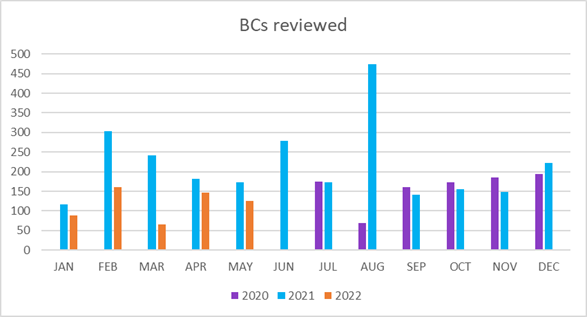
Resource Consent
Applications Received:

88. We
will be losing two Senior Environmental Planners at the end of the month.
Recruiting planners is always challenging, but even more so at this
level. We are actively advertising roles and investigating other
recruiting options.
89. Our
Environmental Planners have recently been focusing on continual improvement
initiatives, such as refreshing our decision templates and conducting team
training on concepts of proportionality and conciseness.
90. There
have been ongoing enquiries about whether the provisions of the Resource
Management (Enabling Housing Supply and Other Matters) Amendment Act, passed
into law on 20 December 2021, can be applied prior to 20 August 2022. We recently
shared legal advice with our customers on how we are processing those
applications already submitted. Applications can only be processed under the
current provisions as the new provisions only have legal effect from 20 August.
91. The
Development Engineering team is currently on top of referrals with applications
coming in steadily this month. Applications in May were exactly the same
as last year, with 21 consents received for engineering assessment.
92. It
has been another busy month for the Development Contribution Advisors team,
with 166 building consents assessed for development contributions in May. The
team is seeing more complex developments coming through, such as multi-unit
developments, rather than the standard 3-bedroom consents. The calculation of
DC revenue in May is approximately $1.7m on building consents. The team has
also been collaborating closely with the policy team to provide feedback and
improvement suggestions in relation to the DC Policy.
93. The
team has also commenced a new trial for online applications for Resource
Consents. Seven external consultancies are taking part in the pilot and
providing feedback on the process, which will run until 15 July.
94. Environmental
Monitoring incidents rose again in May, with 33 incidents reported. The team
managed to resolve 28 incidents this month, including 11 that were deemed
'Unconfirmed/Unsubstantiated'. There are a total of 28 unresolved
incidents for this financial year, as of the end of May 2022.

95. Eighty-nine
individual Resource Consents were monitored in May, resulting in a total of 109
individual monitoring activities. This is a positive trend, showing how the
team is managing to dedicate more time to monitoring RC consent conditions,
which should reduce incidents in the long term.

96. Noise
incidents also rose this month, with 27 incidents being reported – the
biggest issue being residential noise. Our Noise Vibration Specialist is
currently monitoring Port noise and recently presented results findings to a
range of stakeholders at the Port Noise Liaison Group Meeting on 2 June.

97. Most
of the Monitoring team visited the Takitimu North Link sites in May for an
overview of the project. This is a huge operation, including a vast
amount of earthworks (~3 million cubic metres), tunnelling and new bridges and
it was great to see it first hand.


All of the Environmental Planning
team took part in training with Lance Burdett recently. This included how
specific, measurable Resource Consent conditions can positively affect
environmental monitoring outcomes and managing challenging situations. The team
took a lot away from these valuable training sessions.
City
Development And partnerships
City
Partnerships
98. Staff
are working on a high-level assessment of external funding options for the Te
Manawataki O Te Papa Civic Precinct projects, which will be presented to the
Commissioners later this month.
99. Attached
is a copy of the latest Bay Venues Quarterly Report relating to Quarter 3
(Jan-Mar 2022). The move back into orange level Covid Protection Framework
settings has seen business return and Bay Venues has seen a significant
improvement in trading conditions, as would be expected with facilities now
being open for events and activities, largely without any restrictions in
place.
100. Staff
have provided feedback to the draft annual plans received from the four
mainstreet organisations (Mount Business Association, Greerton Village, Papamoa
Unlimited and Downtown Tauranga). Final copies of annual plans, incorporating
TCC feedback, are due on 30 June 2022.
Civic
Redevelopment
101. 91
Willow Street was handed over to LT McGuinness (the developers) on 12 May. An
official farewell with approximately 60 staff, mana whenua and representatives
from LT McGuinness came together to share stories of the past and excitement
for the future development of the site.
102. On
13 June, the downtown bus terminal was moved from Willow Street to Durham
Street. Security fencing has been extended into the bus parks on Wharf Street to
allow for the removal of the Willow Street building veranda, which will start
in approximately two weeks’ time.
KiwiRail
underpass
103. Work
is well-progressed on a pedestrian railway underpass on The Strand Extension,
behind Harbourside Restaurant. This will help ensure the delivery of Stage 1 of
the Memorial Park to The Strand coastal pathway can be delivered as currently
planned.
104. Contractors
have a three-day window to install the underpass when the railway will be
closed (4-6 Jan 2023), otherwise the project will need to be delayed for 12
months to fit within KiwiRail operating restrictions.

Tunks
Reserve / Elizabeth Street East
105. Planning
and design work on the Tunks Reserve/Elizabeth Street East streetscape work is
progressing well, with the development plan completed and the detailed design
well underway.
106. Work
on the northern side of Elizabeth Street East, adjacent to the entrance to the
car park behind the Regional Council building, will be postponed until the
construction of 90 Devonport Rd is almost complete.

Dive
Crescent Car Park
107. The
final concept plans for the upgraded Dive Crescent car park are expected at the
end of June, with site preparation works to begin in early July.
108. Onsite
works will include an upgrade of the area surrounding and including Fixation
Coffee, and the leased car park area on the southern side of Fixation Coffee.
Attachments
1. Bay
Venues Quarterly Report relating to Quarter 3 - A13583219 ⇩ 
|
Ordinary Council meeting Agenda
|
27 June 2022
|
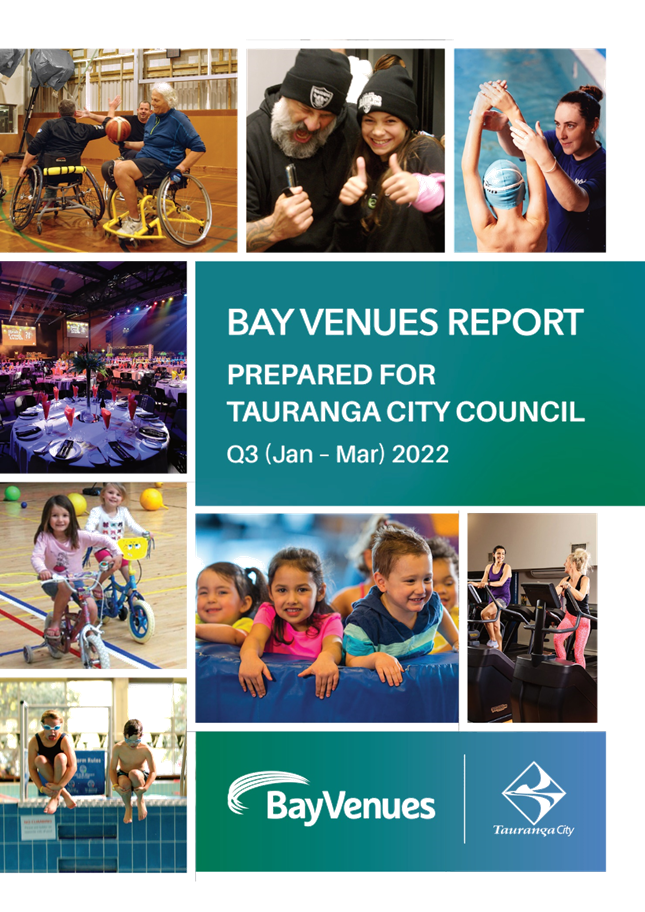






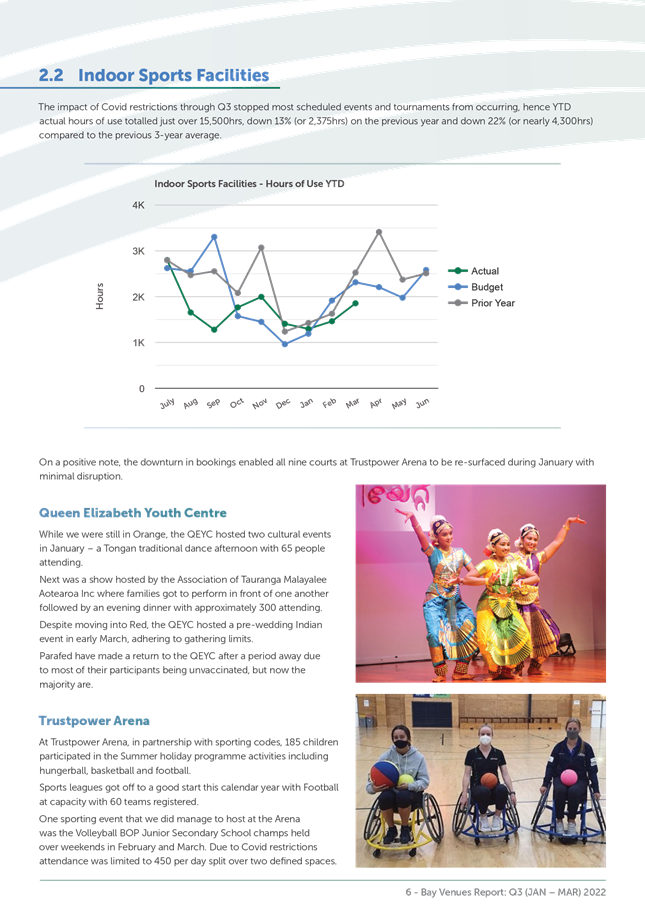
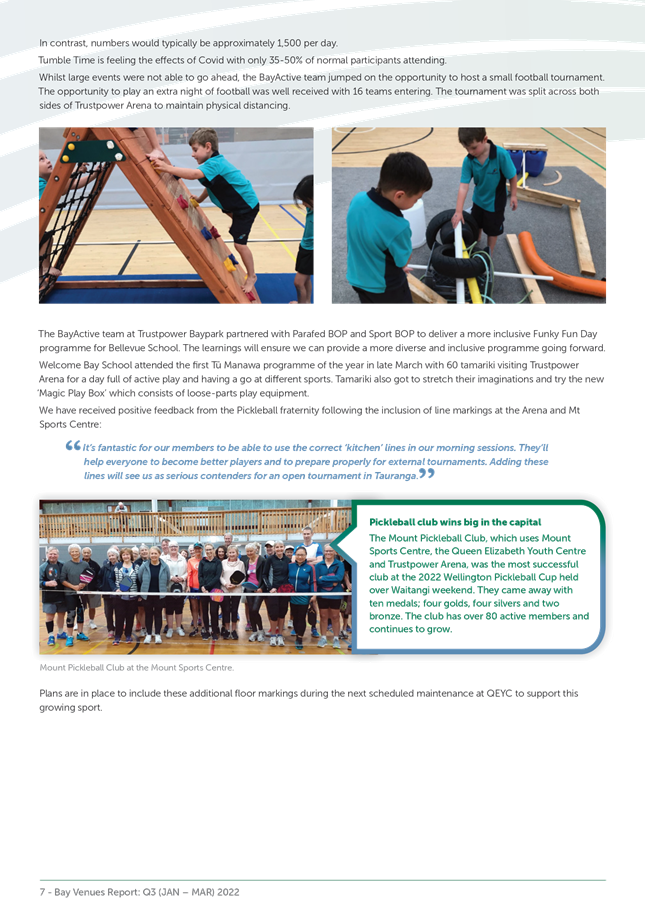
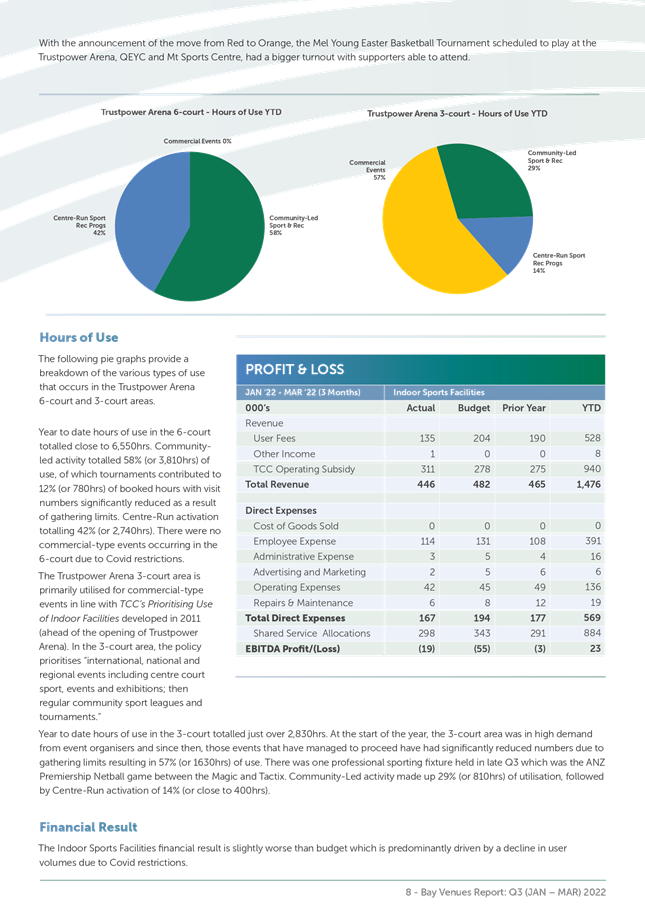

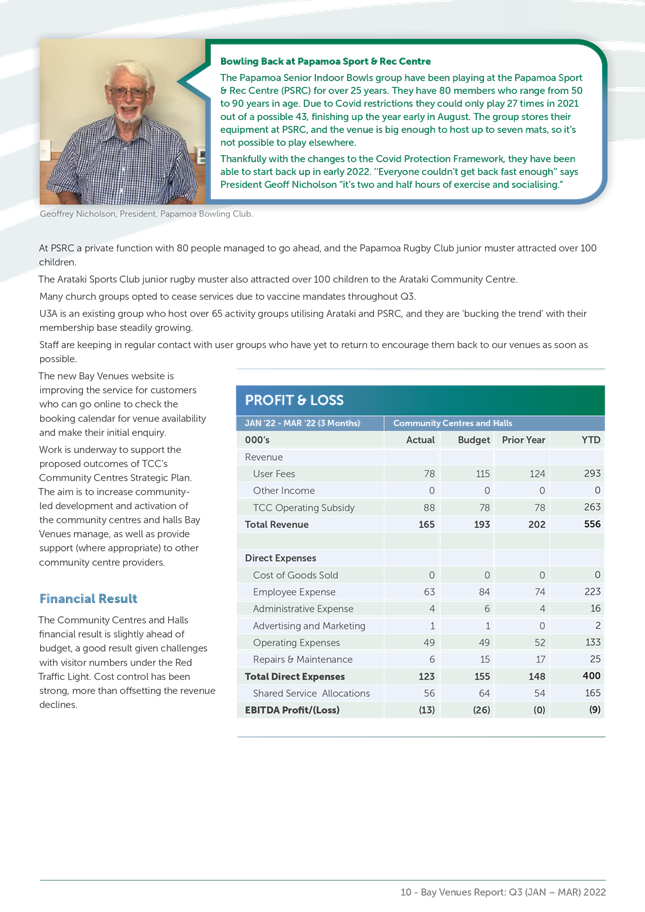
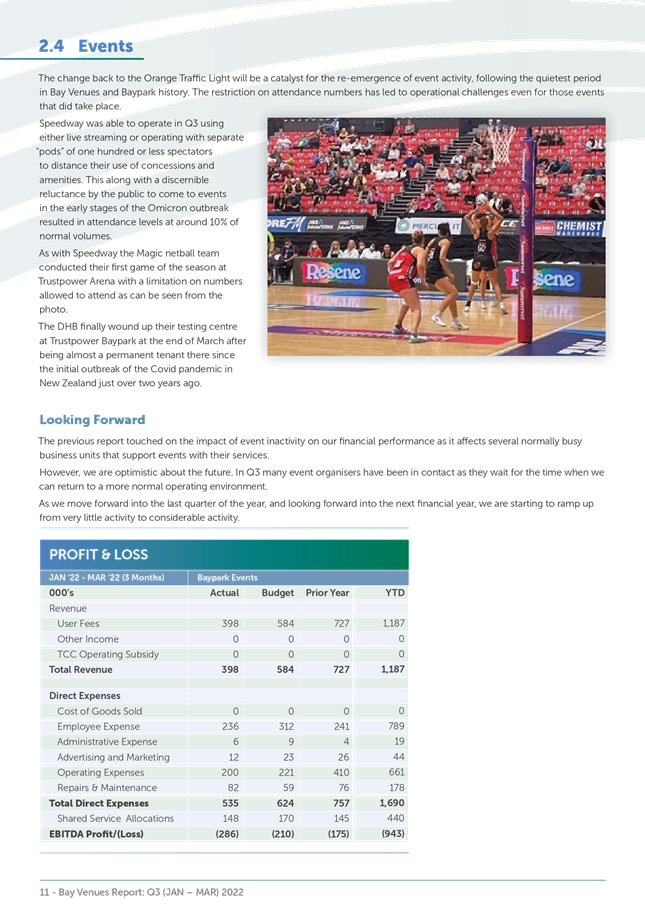








11.7 Draft
strategic framework
File
Number: A13384633
Author: Anne
Payne, Strategic Advisor
Authoriser: Christine
Jones, General Manager: Strategy & Growth
Purpose
of the Report
1. This
report proposes a strategic framework with high level content for Council to
consider and adopt as a draft for public consultation. This report sits
alongside the draft environment strategy and draft inclusive city strategy
report on this agenda.
|
Recommendations
That the Council:
(a) Receives
the Draft Strategic Framework Report.
(b) Adopts
the draft framework and high-level content, Our Direction – Tauranga
2050, as a draft for public consultation, incorporating any amendments as
directed by Council at this meeting.
(c) Delegates
the Group Manager: Strategy & Growth to approve the final wording of
amendments (as per Council direction) prior to public consultation.
|
Executive
Summary
2. The
strategic framework refresh project aligns Council’s strategies and plans
so that Council’s strategic direction – what we are aiming to
achieve for our communities – is clearer and more understandable for our
communities and our own staff.
3. This
project has run in parallel with the City Vision project to ensure that our
refreshed strategic framework incorporates and reflects the new Vision for
Tauranga, endorsed as a vision for the city and adopted as Council’s
Vision for Tauranga on 13 June 2022.
4. Our
framework is based around our five community outcomes (what we seek to achieve
for our communities) and our three approaches (how we do everything),
which taken together identify how and what Council contributes to achieving the
Vision for Tauranga. We are working on a diagram that shows how our
outcomes and approaches weave together and look forward to sharing this when
available.
5. The
strategic framework comprises our Vision, primary strategies (one for each
community outcome), and a set of action and investment plans to deliver the
strategies. This project will ensure all strategies and plans are current
and can be used to identify the right projects and initiatives to drive into
the Long-term Plan 2024-2034, and potentially into the 2023/24 Annual
Plan. The project will also put in place monitoring, reporting and review
processes, to ensure our streamlined suite of strategies and plans are
implemented and remain current over time.
6. This
report provides the draft strategic framework and high-level content contained
in Our Direction – Tauranga 2050 (Attachment 2) for Council to
adopt as a draft for public consultation.
7. The
consultation is proposed to run for four weeks from 11 July to 5 August
2022. It will run in conjunction with consultation on our two new draft
strategies, Tauranga Mataraunui – Inclusive City Strategy 2022-2023 and
Tauranga Taurikura – Environment Strategy 2022-2032.
8. We
will report back on 5 September for Council to adopt the final strategic
framework and, pending community feedback, the two strategies.
Background
9. The
strategic framework project concept was approved by the Strategy, Finance and
Risk Committee on 28 June 2021.
The project concept envisaged drawing on information received through
prior engagement processes as far as possible, and comprised two parts:
(a) Working
with the community to develop a City Vision for Tauranga, and
(b) Refreshing
Tauranga City Council’s strategic framework to ensure Council’s
strategic direction contributes to that City Vision and is clearly articulated
and understood.
10. Progress
on the Council’s strategic framework refresh was reported to Council on
13 September 2021,
the Strategy, Finance and Risk Committee on 1 November 2021,
and on 16 May 2022.
11. On
13 June 2022, Council endorsed the Vision for Tauranga as a vision for the
city, and also adopted the vision as Council’s Vision for Tauranga.
The vision and strategic framework workstreams of the overall project have
worked closely together to ensure Council’s new Vision for Tauranga is
accurately incorporated into Council’s strategic framework.
Project purpose
12. The
framework will provide a clear line of sight between the vision for Tauranga, Tauranga
City Council’s community outcomes and the ‘what and how’ of council
delivering on its commitments. The project process has also allowed the council
to identify gaps in its strategies and plans and to enable these gaps to be
acknowledged and addressed.
13. For
Tauranga City Council, the key outcomes from this project are that:
(a) Our
community and partners will be easily able to see how the organisation is
contributing to our adopted community outcomes and the vision for Tauranga.
(b) Our
governance and staff will have a shared understanding of what the organisation
is trying to achieve and how we aim to get there, and our people will know how
they contribute.
(c) We
will be guided by a set of current, relevant, and succinct strategic documents,
which ‘weave together’ where this makes sense.
(d) We
will have a clear focus for evaluating existing programmes, and those
considered in the future, to ensure all efforts support our overarching
purpose.
(e) The
refreshed and fit for purpose set of strategies and action plans will provide
future council governance teams with a clear roadmap to continue progress
towards the community outcomes and vision.
Project outputs
14. Primarily
web-based – our refreshed strategic framework is envisaged as
primarily a web-based tool publicly available on Council’s website.
This web-based structure will give us more flexibility to show that our
strategies and plans normally contribute to more than one community outcome. It
is more difficult to show this relationship in a written format.
15. Printable
documents – a range of printable documents will also be available
from the website. This will include a high-level summary of Council’s
strategic direction, as well as printable strategies and action plans.
16. Refreshed
strategies and plans – all strategies and action plans will be
updated as 2022 documents, or underway/planned and scheduled for completion by
early 2023, to inform the upcoming 2024-2034 Long-term plan development.
(Note: joint strategies and plans cannot be updated as part of this process,
but review points identified will be fed into the next review process for each
joint strategy or plan).
17. Rescinding
those no longer required – a process will be developed to formally
rescind any strategies and plans that have been superseded or are no longer
needed, along with a programme to complete this work.
18. Tracking
our progress and keeping it relevant – responsibilities for
monitoring and reporting on progress will be assigned, and processes and
systems put in place to enable this to be delivered. This includes
monitoring and reporting at action level right through to outcome level, as
well as managing review timeframes for the suite of strategies and plans.
Project timelines
19. The
project has been scheduled within tight timeframes to enable our strategic
framework, including any new strategies and action plans, to guide development
of our next Long-term Plan. These timeframes also allow the strategic
framework to be in place ahead of the 2023/24 Annual Plan.
20. To
meet these timeframes, we will need any new strategies and action plans to be
in place close to the end of this calendar year.[5]
discussion –
Council’s draft strategic framework
21. The
strategic framework is simply how we align our strategies and action plans to
ensure that we do the right things to contribute to a better Tauranga now and
in the future.
22. To
do so we must be clear about what we are aiming for, have the right strategies
and plans in place, ensure these are funded and delivered, and check progress
to correct the course where needed.
23. The
diagram below shows where our strategic framework fits in our planning cycle,
with the changes made through this project identified in green text:
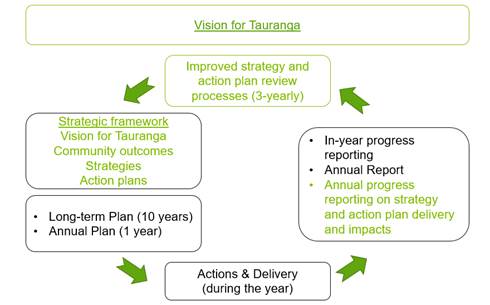
24. The
driver for the project was the council’s perceived lack of strategic
direction, in part due to the numerous unconnected strategies and plans
confusing the landscape for both the council staff and our communities.
25. We
have created a framework that aligns our strategies and plans to clearly
contribute to Council’s five adopted community outcomes, which is how
Council contributes to the citywide vision for Tauranga. Council’s
five community outcomes are that Tauranga is:
· An
inclusive city – Tauranga Mataraunui
· A
city that values, protects and enhances our environment
– Tauranga Taurikura
· A
well planned city – Tauranga Tātaitia rā
· A
city that we can move around easily – Tauranga Aru Rau
· A
city that supports business and education – Tauranga Eke Tangaroa.
26. Additionally,
our framework brings focus to our three approaches which are about the way we
do things, so are principles-based rather than actions focused. These are
deliberately intentional focus areas that commit us to doing things
differently, and making this change consistently across the organisation and
over time. These are our approaches to:
· Te
Ao Māori (developed in partnership with Tangata Whenua)
· Sustainability
(incorporating social, economic, cultural and environmental aspects of
sustainability), and
· Working
beyond Tauranga (particularly how we contribute to the wider region, upper north
island).
27. A
one-page summary showing our high-level strategic direction is included on page
4 of the draft Our Direction – Tauranga 2050 document (Attachment
2 to this report).
28. We
are working on a graphic that will depict how the elements of our new framework
weave together, how interconnected they are, and that is localised to
Tauranga. We look forward to sharing this concept once it is further
refined.
29. Our
strategic framework will enable us to better balance our strategic direction
and priorities across the social, environmental, economic and cultural aspects
of community wellbeing.
30. The
lack of an overarching vision for Tauranga has also contributed to Council’s
perceived lack of strategic direction. The parallel workstream to this
project facilitated development of a vision for Tauranga. On 13 June
2022, Council both endorsed the vision for Tauranga for others to use, and
adopted it as Council’s vision for Tauranga.
Framework structure and content
31. To
make our strategies and plans more accessible, we are streamlining them and
including information about how they work together. We have developed a
very simple hierarchy and some clear guidance for what a strategy or action
plan should include. All strategies and action and investment plans will
be succinct, action-focused documents that support Council to deliver at pace
and with purpose for our communities.
32. The concept for our strategic
framework hierarchy is shown in the diagram below. This diagram describes
the levels in our framework, moving from strategy to action as we move down
each level, so does not identify specific community outcomes, strategies or
action plans.
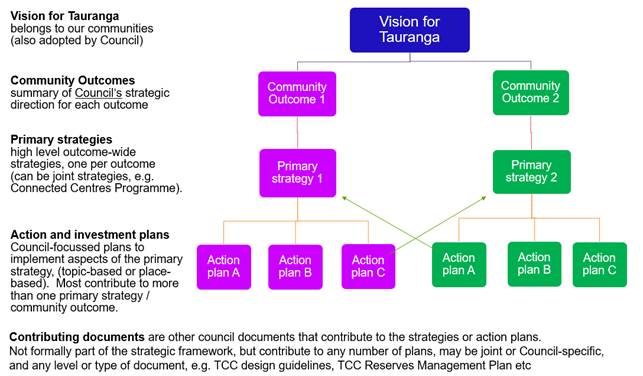
33. A
more detailed explanation of each of the levels of the framework was provided
in the 16 May 2022 report to the Strategy, Finance and Risk Committee.
34. A
diagram showing the full framework structure, excluding specific action and
investment plans, is included as Attachment 1 to this report.
35. Key
points to note are:
High level content
– vision and ‘at a glance’ summaries
(a) Our
new Vision for Tauranga provides a long-term aspiration for the city out to
2050. We have mirrored this timeframe for our strategic framework,
particularly at the ‘At a Glance’ level. Our primary
strategies will range from 10 years out to 2050 (now just under 30 years),
while our action and investment (action) plans will normally range from 3 to 10
years. This is a general guide only.
(b) The
levels of the hierarchy signal increasing levels of detail from ‘at a
glance’ summaries to action plans. All levels are equally important, each
is a critical component required to achieve the council’s goals for our
communities.
(c) In
line with the high-level nature of the ‘at a glance’ summaries,
progress measures within these documents are high-level and focus on trends for
a few key indicators. Progress measures become more detailed as you move
down the hierarchy.
(d) We
have drafted a summary of Council’s strategic direction that links the
Vision for Tauranga with Council’s strategic framework (our response to
the vision). This document is designed to provide a headline summary of
the council’s direction of travel at a particular point in time and once
finalised, is envisaged to be one of our first printable documents for the
framework.
(e) With
a working title of Our Direction – Tauranga 2050, this draft
document will form the basis of our consultation material and is provided as Attachment
2 to this report.
Strategies and action and investment plans
(f) As
envisaged, we needed new primary strategies for our two ‘critical
gap’ community outcomes of Inclusive City and Valued & Protected
Environment. Both strategies have been drafted through the
project workstreams involving staff and key external stakeholders.
(g) Refer
to a separate report on this agenda for further information about the Draft
Tauranga Taurikura – Environment Strategy and the Draft Tauranga
Mataraunui – Inclusive City Strategy.
(h) Our
new strategies are brief high-level documents that will show where they fit
within our strategic framework and within our wider strategic context, and will
identify the action plans that will implement them. Implementation plans
will now be included only in the action plans, rather than within strategies
themselves.
(i) The
five community outcome workstreams are also assessing existing strategies and
plans that contribute to their outcome, many of which are wholly or partly
outdated or have been implemented. There are currently more than 60,
including many joint strategies and plans that cannot be unilaterally
updated. We will take our assessments of Council actions within our
existing joint strategies through to the next review for each of these
strategies.
(j) The
workstreams have identified a suite of potential action plans that will
together deliver what Council is aiming to achieve for the communities of
Tauranga, now and in the future. A very simplified diagram showing
current thinking was provided to the 16 May 2022 Strategy, Finance and Risk
Committee.
Further work is underway to confirm and develop the final action plans.
Consultation on the draft strategic
framework
36. This
report seeks Council approval to consult on the draft strategic framework and
its high-level content contained in the draft Our Direction – Tauranga
2050 document (Attachment 2 to this report).
37. Consultation
will run for four weeks from 11 July to 5 August 2022.
38. The
amended draft framework, including the Our Direction – Tauranga 2050
summary document, will be brought back to Council for adoption on 5 September
2022.
39. The
purpose of this consultation is to ensure anyone who may have a potential
interest in the strategic framework has an opportunity to have their say.
Communication about the consultation will be targeted for different audiences
and people involved in existing or proposed strategies and action plans will be
prioritised.
40. Community
consultation will focus on the following two questions:
(a) Does
this draft strategic framework provide sufficient clarity about how the
Council’s strategies and plans fit together?
(i) Yes/No
– if no, how do you think it could be improved?
(b) The
community outcomes were adopted by the Council in March 2021 as part of the
2021-2031 Long-term Plan development process. For each outcome we have
summarised Council’s response ‘at a glance’. These
summaries are contained in the Our Direction – Tauranga 2050
document.
For as
many of the outcomes that you wish to comment on: does the ‘At a Glance’
summary sufficiently capture the key issues and Council actions that it needs
to?
(i) Yes/No
– if no, what gaps are there that you think need to be addressed?
41. The
responses to these questions will help inform the final strategic framework,
including high level content and proposed action plans.
42. Additionally,
community consultation will be an opportunity to begin to engage people on
development of our action and investment plans, particularly any interested
people that weren’t aware of the work to date. The consultation
material will reference this opportunity and ask people to indicate any plans
they are particularly interested in being involved with.
43. We
note that this consultation process will be run in conjunction with
consultation on the draft Tauranga Taurikura – Environment Strategy and
Tauranga Mataraunui – Inclusive City strategies (refer to the separate
report on this agenda).
Strategic / Statutory
Context
44. The
strategic framework project is a process (alongside the development of a vision
for Tauranga) to align all of Council’s strategies and plans.
45. The
framework will provide a clear line of sight between the Vision for Tauranga, Council’s
community outcomes and the ‘what and how’ of Tauranga City Council
delivering on its commitments. The framework process will also allow
Council to identify any gaps in its strategies and plans, enabling these gaps
to be acknowledged and addressed.
Options Analysis
46. Two
options are identified in the tables below, which outline the benefits,
disadvantages and key risks for both options.
Option
1 – Adopt draft strategic framework for public consultation (RECOMMENDED)
|
Description
|
|
Adopt the draft strategic framework including the high-level
content contained in Our Direction – Tauranga 2050, as outlined
in this paper, for public consultation (incorporating any specific amendments
as directed at this meeting and delegating the General Manager: Strategy and
Growth to approve final wording of the amended documents).
|
|
Benefits
|
Disadvantages
|
Key risks
|
|
Clear strategic direction will be formalised in time to
guide 2024-2034 Long-term plan development.
Staff time can be used more effectively, as less time will
be spent on determining strategic priorities and re-creating base work for
each long-term plan.
Our delivery is prioritised and targeted to meet our
strategic priorities, resulting in better outcomes for our communities.
Our communities, stakeholders and partners can have more
confidence in Council’s planning and delivery processes.
|
Timeframes for this project are tight. As a result,
the proposed public consultation on the draft framework will be limited in
its scope and reach.
|
Some of our communities feel they haven’t had an
opportunity to be involved in the strategic framework development.
|
Option
2 – Do not adopt the draft strategic framework for public consultation
|
Description
|
|
Do not adopt the draft strategic framework, as outlined in
this paper, for public consultation.
|
|
Benefits
|
Disadvantages
|
Key risks
|
|
More time to engage or consult with affected communities,
stakeholders and partners.
|
May not have clear strategic direction formalised in time to
guide 2024-2034 Long-term Plan development.
Council’s lack of clear, coherent strategic direction
continues to negatively impact on staff through difficulty in determining
priorities and needing to start from scratch for each long-term plan process.
Council’s lack of clear, coherent strategic direction
continues to confuse and frustrate our communities, stakeholders and
partners.
|
Sub-optimal 2024-2034 Long-term Plan process and
outcome/content.
Internal misalignment or conflict between priorities,
leading to staff disengagement.
Lack of clarity for our communities, stakeholders and
partners, leading to disengagement from Council.
Loss of potential funding, particularly from central
government and key city partners.
|
47. Option
one is the recommended option. Although timing is a limiting factor, we
have taken into account the significant feedback from our communities,
stakeholders and partners over recent years. This leads us to the view
that there is likely to be greater community interest in the strategies and
action plans within our strategic framework than in the framework itself.
48. We
note that development of new or reviewed strategies and action plans will
follow their own consultation and engagement processes, which will provide
opportunities for our communities, stakeholders and partners to be involved.
Financial Considerations
49. The
costs of consultation are minimal, with consultation material having been
anticipated within the project budget. The potential costs of
implementing the refreshed strategic direction will be addressed at a project
level in the action and investment plans, and then flow into Annual Plan and
LTP processes.
Legal Implications /
Risks
50. Potential
legal implications relate primarily to meeting the Local Government Act 2022
significance and engagement requirements for public consultation. These
implications have been carefully considered and mitigated, as outlined in the
Consultation section of this report.
51. Risks
associated with the project have been considered during planning and implementation
of the workstreams for each ‘strand’ of the framework.
52. A
key risk to delivery of the project within targeted timeframes relates to
potential Covid-19 impacts on staff, consultants, and key stakeholders for the
project. While we continue to manage around the people impacts from
Covid-19 as far as possible, our reality is that if key people are impacted at
critical times, some timeframes may need to move as a result. At this
stage no major targets have been missed for this reason, but this risk will
remain for the duration of the project.
Significance
53. The
Local Government Act 2002 requires an assessment of the significance of
matters, issues, proposals and decisions in this report against Council’s
Significance and Engagement Policy. Council acknowledges that in some
instances a matter, issue, proposal or decision may have a medium degree of
importance to individuals, groups, or agencies affected by the report.
54. In
making this assessment, consideration has been given to the likely impact, and
likely consequences for:
(a) the current
and future social, economic, environmental, or cultural well-being of the
district or region
(b) any persons who are likely to be
particularly affected by, or interested in, the proposal.
(c) the capacity of the local authority to
perform its role, and the financial and other costs of doing so.
55. In
accordance with the considerations above, criteria and thresholds in the
policy, it is considered that the proposal to adopt Tauranga City
Council’s draft strategic framework for public consultation is of medium significance.
CONSULTATION / ENGAGEMENT
56. Taking
into consideration the above assessment, that the proposal to adopt Tauranga
City Council’s draft strategic framework for public consultation is of medium
significance, staff are of the opinion that the nature of this project requires
our communities’ involvement as outlined in this report.
57. There
has been considerable consultation and engagement with our communities to date,
as referenced in the background section of this report. Further
involvement with both the general community and key stakeholders is outlined in
the consultation and next steps sections of this report.
Next Steps
58. Pending
decisions from this Council meeting, key steps for the remainder of the project
and beyond are:
(a) 11
July to 5 August: Community feedback sought on the draft framework
and high level content.
(b) Mid-August:
Staff will analyse feedback and make recommendations on changes.
(c) Council
5 September: adopt a final version of the framework and high level
content, along with a programme of work to complete development of any
remaining action and investment plans. This will close the project.
(d) Post-project
work – September through to early 2023: includes completing any
remaining action plans as programmed, formally rescinding superseded strategies,
and implementing ongoing strategy (and action plan) monitoring and review
processes.
(e) Council
early 2023: adopt any updates to the framework and the documents within it
once all action plans have been finalised.
(i) Council
will adopt the draft Tauranga Taurikura – Environment Strategy and draft
Tauranga Mataraunui – Inclusive City Strategy goals ‘in
principle’ until the action plans to deliver those strategies have been
completed. This will enable strategy goals, and potentially the related
community outcome ‘at a glance’ summary, to be updated where
required to ensure consistency throughout the levels of our framework.
59. Note:
Development of individual strategies and action plans will follow their own
consultation and engagement processes. For efficiency, we will seek to
dovetail these consultation and engagement processes in with the wider
framework processes where these align.
Attachments
1. Proposed
strategic framework structure - A13585483 ⇩ 
2. Draft 'Our
Direction - Tauranga 2050' - A13581623 ⇩ 
|
Ordinary Council meeting Agenda
|
27 June 2022
|
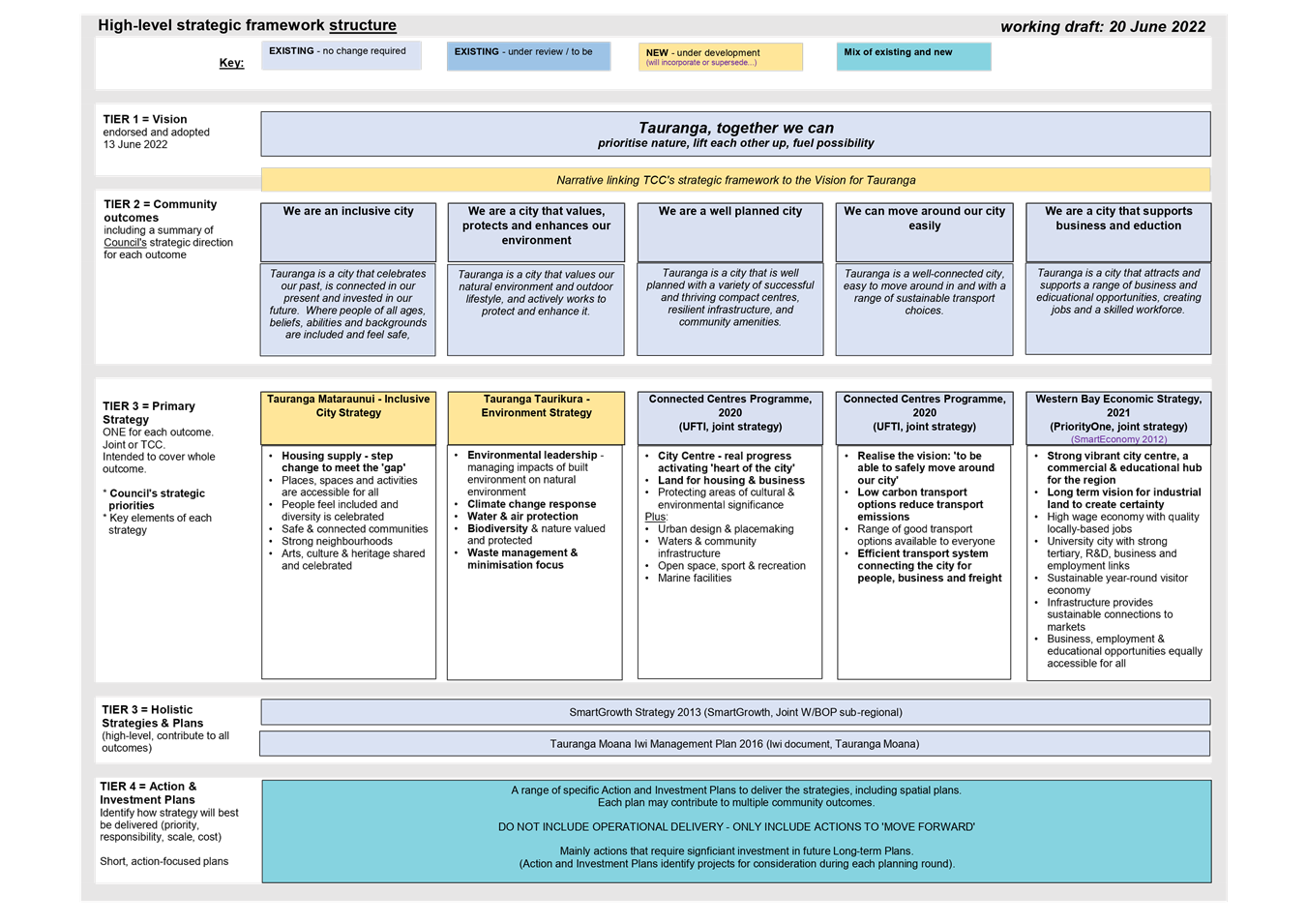
|
Ordinary Council meeting Agenda
|
27 June 2022
|
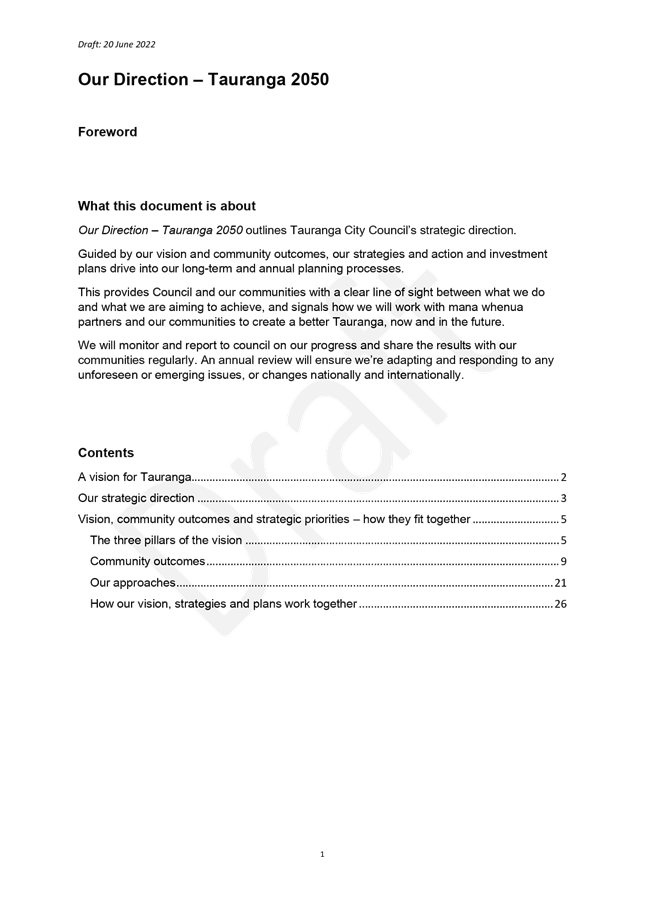

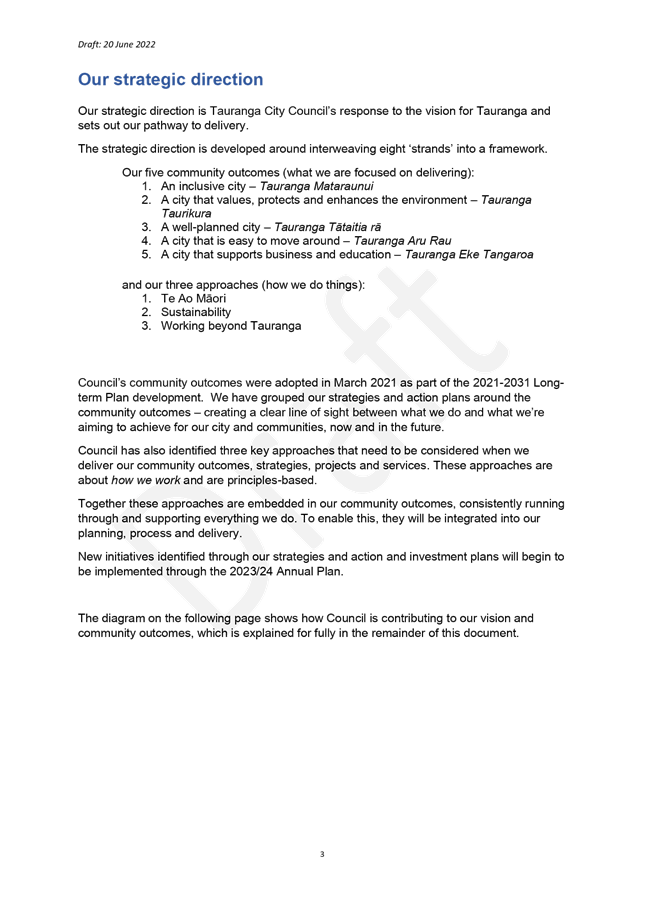

11.8 Draft
Environment Strategy and Draft Inclusive City Strategy
File
Number: A13508410
Author: Rebecca
Scott, Principal Strategic Advisor
Nick Chester, Inclusive Cities
Advisor
Anne Payne, Strategic Advisor
Authoriser: Christine
Jones, General Manager: Strategy & Growth
Purpose
of the Report
1. This
report provides the draft Environment Strategy and the draft Inclusive City
Strategy for Council to consider and adopt as drafts
for public consultation. This report sits alongside the draft
strategic framework report on this agenda.
|
Recommendations
That the Council:
(a) Receives
the draft Environment Strategy and draft Inclusive City Strategy report.
(b) Adopts
the Draft Tauranga Taurikura – Environment Strategy as a draft for
public consultation, once any changes directed at the Council meeting have
been incorporated.
(c) Adopts
the Draft Tauranga Mataraunui – Inclusive City Strategy as a draft for
public consultation, once any changes directed at the Council meeting have
been incorporated.
(d) Delegates
the Group Manager: Strategy & Growth to approve the final wording of
these amendments and any minor editorial changes prior to public
consultation.
(e) Approves
the proposed public consultation process for both draft strategies as
outlined in this report.
(f) Notes
that the goals for both strategies are adopted ‘in principle’ and
will remain ‘in principle’ until the action and investment plans
delivering on the strategies are completed to ensure alignment throughout the
final framework.
|
Executive
Summary
2. The
two draft strategies provided within this report have been developed to address
critical gaps in Council’s formal strategic direction. The
strategies have been developed as part of the wider strategic framework
project, and the draft strategic framework is reported separately to this
Council meeting.
3. Both
draft strategies build on earlier work and input from our communities,
particularly the draft Environment Strategy, which completes a process
originally started in 2017.
4. Our
new strategies, and the Action and Investment Plans that deliver them, are
consciously succinct and action-focused documents.
5. The
draft Tauranga Taurikura – Environment Strategy 2022-2023 sets out
Council’s goals and high-level actions to progress our ‘valued,
protected and enhanced environment’ community outcome, which in turn
contributes particularly to the ‘prioritising nature’ element of
our new Vision for Tauranga. The draft strategy is provided as Attachment
1 to this report.
6. The
draft Tauranga Mataraunui – Inclusive City Strategy 2022-2023 sets out
Council’s goals and high-level actions to progress our ‘an
inclusive city’ community outcome, which in turn contributes particularly
to the ‘lifting each other up’ element of our new Vision for
Tauranga. The draft strategy is provided as Attachment 2 to this
report.
Background
7. The
strategic framework refresh project concept was approved by the Strategy,
Finance and Risk Committee on 28 June 2021,
following several previous iterations of this work. The two key elements
of this project are:
(a) To
work with the community to develop a vision for Tauranga. This was
endorsed and adopted by Council on 13 June 2022.
(b) To
refresh Tauranga City Council’s strategic framework to ensure
Council’s strategic direction contributes to that vision for Tauranga,
and is clearly articulated and understood. Progress is reported
separately to this meeting in the Draft strategic framework report, which
details the background to the overall project including these two workstreams.
8. The
‘valued, protected and enhanced environment’ and ‘inclusive
city’ community outcomes were identified early in the strategic framework
project (part b above) as areas in which Council needed much clearer strategic
direction.
9. The
two draft strategies provided in this report have been developed as a first
step in meeting this need. Both draft strategies build on all previous
Council work, including a wide range of engagement feedback received from our
communities, stakeholders and partners.
DRAFT
Tauranga taUrikura – environment strategy 2022-2032
Background and History
10. In
April 2017, Council’s Environment Committee agreed to develop an
Environment Strategy to guide the work of Council and identify how the
community could contribute to the priority areas and targets once set.
11. Engagement
was undertaken with the community, partners and stakeholders to gain their
views on the natural environment, what they valued, what their concerns were,
and what Council should be doing better. This was done through two main
activities:
(a) In-depth
interviews with people and organisations that were considered to have expertise
in and impact on the topics Council was trying to address: partners like
Tangata Whenua and the Regional Council, and other stakeholders such as
organisations that are active in sustainability and influential in delivering
environmental outcomes.
(b) An
online survey gathered insights on what people want for the future of
Tauranga’s environment, with over 1,000 responses received.
12. The
Strategy development was intended to consist of 4 stages: to understand our
starting point, to create a strategy, to develop action plans, and to deliver
on those action plans to implement the strategy. The first stage was
completed in early 2018. Stage 2 work to create a draft strategy began in
early/mid 2018 and was partially completed. Stages 3 and 4 were not started.
2022 Strategy Development Process
13. Strategy
development has benefitted from considerable engagement, both directly with
stakeholders during the 2017-2018 process, and indirectly with our communities
when we have asked them what is important to them (Vital Updates 2020, My
Tauranga Vibe 2021, 2020 strategic conversations workshops, annual residents’
surveys, and a range of submission processes).
14. It
is very clear that our communities are deeply connected to our natural
environment, care about it and want to help protect it.
15. In
February 2022, the environment strategy development was reinitiated as part of
the strategic framework project. The draft Tauranga Taurikura –
Environment Strategy 2022-2032 is built on previous work and existing knowledge
base, including 2021 sustainability stocktake work, and incorporates new
legislation and national strategies.
16. Staff
and key external groups and organisations have helped develop this draft
strategy, most recently through a workshop in May and subsequent communications
to refine the initial draft. We sought feedback and input from Te
Rangapū Mana Whenua o Tauranga Moana on 20 May 2022.
Draft Strategy – Vision and Goals
17. The vision for the draft
strategy is that ‘Tauranga is a city that values our natural
environment and outdoor lifestyle, and actively works to protect and enhance
it’.
18. The
goals for the draft strategy are goals for the city. Success in achieving our
goals cannot be achieved without a commitment by all – the Tauranga
community. To reach our goals, we will need to work together and take
responsibility for action, each at our own level. Actions that
will primarily be the responsibility of Council to achieve are highlighted
within the Strategy.
19. The
Draft Tauranga Taurikura – Environment Strategy, 2022-2032 is provided as
Attachment 1 to this report.
20. To
enable consistency between the strategy and the Action and Investment Plans
(‘Action Plans’) currently under development, our intention is to
retain the strategy goals ‘in principle’ until all required action
plans have been completed. This will enable the strategy goals (and other
elements of the strategic framework such as the Valued, Protected and Enhanced
Environment At a Glance) to be updated to reflect learnings during the action
plan development processes.
21. Our
aim is that all new action plans will be in place by early 2023. Council
will formally adopt the entire framework, including At a Glances, strategies
and action plans within it, at that point.
Draft Strategy – Key Points
22. A
10-year horizon for the strategy has been set as there is still significant
work that needs to be achieved to understand what good looks like in some
areas, for example biodiversity. We also need the time to absorb new and
impending legislation, what that means for the council and how we will respond.
We propose to review and improve this strategy within 3 years.
23. Council
has some choices to make about how far we aim with this strategy, and the
current process, particularly the public consultation process, will help inform
those decisions. The strategy, and the action plans that will deliver on
it, are not static positions, they will be formally reviewed and updated on a
regular basis to ensure they reflect our world, and direction, at all
times. However, two of the ‘how far do we go now’ choices
currently facing Council are:
(a) The
most consistent theme from internal and external stakeholders, across the years
and variety of forums, is addressing the tension between growth and
environmental impacts. The draft strategy speaks to the need to balance these
tensions. Consistent feedback is that Council should, but currently does not,
prioritise the natural environment over growth. Has our draft strategy
landed in the right place regarding this tension?
(b) Another
common question during strategy development was how far we can go, what is
Council’s position on a particular element? For example, do we
limit circular economy practices to waste or do we consider Tauranga becoming a
circular economy? Council’s strategic priority of environmental
leadership can be interpreted as leading in the sector, which might lead to
goals such as ‘Tauranga is New Zealand’s first circular
economy’.
24. The
proposed strategy measures are typically outcome statements with actions or
approaches to achieve the desired outcomes. Targets and more quantifiable
measures will be incorporated within the action plans. This approach allows for
bottom-up work to be completed to ensure robust future measures.
25. Tauranga
Taurikura 2022-2032 will be implemented through a number of action plans. The strategy therefore provides high-level direction to inform more
detailed planning and actions. Work is already underway to initiate some
of these action plans such as for Climate and for Nature and Biodiversity
(replacing Growing Tauranga Green 2006).
26. For
example, actions that might contribute to the strategy goal 5: Thriving
nature and biodiversity at the heart of our communities, might be:
(a) To
increase tree canopy cover and urban forest across the city by:
(i) Delivering a programme
of increased tree canopy cover on Council land; and
(ii) Seeking ways to influence and
increase tree canopy cover on private land e.g. through education, support
(and/or regulation).
(b) Similar
actions to increase the area of land (Council and non-Council) across the city
that provides a home for nature and indigenous biodiversity.
27. All
actions within the action plans will have defined timeframes, targets and
responsibilities for delivery. As noted above, these action plans are
already being developed or simply refreshed where appropriate.
DRAFT tauranga mataraunui
– inclusive city strategy 2022-2032
Background and History
28. Council
has a longstanding focus on ensuring that all residents feel included, where
barriers to participating in civic life are removed.
29. Currently,
there are several different strategies and plans that contribute to Tauranga as
an inclusive city, but there is currently no overarching strategic direction in
this area. Developing a balanced strategic framework has enabled this
critical gap to be confirmed and addressed through development of this draft
strategy.
2022 Strategy
Development Process
30. The
draft strategy takes into account the large number of existing strategies and
plans that contribute to building a more inclusive Tauranga, and recognises the
significant input from many parts of our communities in developing these. Many
of our existing strategies and plans have been developed or reviewed recently,
while others are older and no longer fit for purpose.
31. The
draft strategy has been developed over a number of months. An internal
working group developed an initial draft of the strategy, considering key
feedback received from our communities. This initial draft was then tested
and further developed with key stakeholders in December 2021 through to April
2022. Feedback and input from Te Rangapū Mana Whenua o Tauranga
Moana was also sought on 20 May 2022.
Draft Strategy –
Vision and Goals
32. The
vision for the draft strategy is that ‘Tauranga is a city that
celebrates our past, is connected in our present and invested in our future,
where people of all ages, beliefs, abilities and backgrounds are included, feel
safe, connected and healthy’.
33. The
five goal areas within the draft strategy are: wellbeing (a higher-level,
almost overarching goal); access; inclusion and diversity; safe communities;
and strong neighbourhoods. The goals are underpinned by clear statements on how
Council will contribute to each goal.
34. The
Draft Tauranga Mataraunui – Inclusive City Strategy 2022-2032 is provided
as Attachment 2 to this report.
35. As for the draft Environment
Strategy above, it is intended to adopt the strategy goals ‘in
principle’ while further work is done.
Draft Strategy –
Key Points
36. “Inclusion”
is a broad term and encompasses a range of ideas. However, there are common
themes which have been captured in the draft strategy vision and goals. These
themes centre around the desire to support a city that removes barriers so that
all members of the community can enjoy civic life.
37. Some
issues relating to inclusion will be more directly addressed in other community
outcome areas, for example ensuring that all of our communities have access to
public transport, or to sport and recreation facilities. Close alignment
with other strategies will be critical to overall success.
38. The
proposed strategy measures are typically outcome statements with actions or
approaches to achieve the desired outcomes. Targets and more quantifiable
measures will be incorporated within the action plans. This approach allows for
bottom-up work to be completed to ensure robust future measures
39. Tauranga
Mataraunui will be implemented through a number of action plans. The strategy
therefore provides high-level direction to inform more detailed planning and
actions. All actions within the action plans will have defined
timeframes, targets and responsibilities for delivery. The action plans
will be a combination of:
(a) Existing
plans that have been developed recently, are fit for purpose and can contribute
to the vision of the strategy
(b) Combining
existing plans where commonalities exist, and review to create a new action plan
(c) New
action plans where gaps have been identified.
40. For
example, actions that might contribute to the strategy goal 2. Access: To create
a city that works for all, where no-one experiences physical barriers or is
unable to access information that enables them to live their best life,
might be that:
(a) New
council facilities are designed and built to be fully accessible for all ages
and abilities
(b) Council
information (both physical and through the council website) can be accessed by
everyone in the community.
41. All
actions within the action plans will have defined timeframes, targets and
responsibilities for delivery. As for the environment workstream, these
action plans are already being developed or simply refreshed where appropriate.
Strategic / Statutory
Context
42. The
strategic framework project is a process (alongside the development of a vision
for Tauranga) to align all of Council’s strategies and plans.
43. The
framework will provide a clear line of sight between the Vision for Tauranga, Council’s
community outcomes and the ‘what and how’ of Tauranga City Council
delivering on its commitments. The framework process will also allow
Council to identify any gaps in its strategies and plans, enabling these gaps
to be acknowledged and addressed.
44. The
two draft strategies included in this paper will form key elements of the
proposed strategic framework. The strategies are being developed through
separate workstreams under the umbrella of the strategic framework project.
Options Analysis
Draft Tauranga Taurikura
– Environment Strategy 2022-2032
45. Two
options are identified in the tables below, which outline the benefits,
disadvantages and key risks for both options.
Table
1: Option 1 – Adopt the draft Environment Strategy for public
consultation (RECOMMENDED)
|
Description
|
|
Adopt the draft Tauranga Taurikura – Environment
Strategy 2022-2032 for public consultation, noting that
· The
strategy goals are to be adopted in principle until supporting action plans
are completed, as outlined in this paper.
· Specific
amendments are to be incorporated as directed at this meeting, with the
General Manager: Strategy and Growth delegated to approve the final wording
of the draft documents.
|
|
Benefits
|
Disadvantages
|
Key risks
|
|
Clear strategic direction will be formalised in time to
guide 2024-2034 Long-term plan development.
Staff time can be used more effectively on action plan
development, which will include input from key stakeholders, partners and our
communities.
Council can more confidently design and deliver projects and
initiatives that support our environmental goals.
|
Timeframes for this project are tight. As a result,
the proposed public consultation on the draft strategy will be limited in its
scope and reach.
|
Some of our communities may feel they haven’t had an opportunity
to be involved in the strategy development.
|
Table
2: Option 2 – Do not adopt the draft Environment Strategy for public
consultation yet
|
Description
|
|
Do not adopt the draft Tauranga Taurikura –
Environment Strategy 2022-2032 for public consultation, as outlined in this
paper.
|
|
Benefits
|
Disadvantages
|
Key risks
|
|
More time to engage of consult with affected communities,
stakeholders and partners.
|
Reduced time to develop action plans that implement the
strategy, affecting 2024-2034 Long-term Plan development.
|
Potential for sub-optimal 2024-2034 Long-term Plan process
and outcome/content.
|
Draft Tauranga Mataraunui
– Inclusive City Strategy 2022-2032
46. Two
options are identified in the tables below, which outline the benefits,
disadvantages and key risks for both options.
Table
3: Option 1 – Adopt the draft Inclusive City Strategy for public
consultation (RECOMMENDED)
|
Description
|
|
Adopt the draft Tauranga Mataraunui – Inclusive City
Strategy 2022-2032 for public consultation, noting that
· The
strategy goals are to be adopted in principle until supporting action plans
are completed, as outlined in this paper.
· Specific
amendments are to be incorporated as directed at this meeting, with the
General Manager: Strategy and Growth delegated to approve the final wording
of the draft documents.
|
|
Benefits
|
Disadvantages
|
Key risks
|
|
Clear strategic direction will be formalised in time to
guide 2024-2034 Long-term plan development.
Staff time can be used more effectively on action plan
development, which will include input from key stakeholders, partners and our
communities.
Council can more confidently design and deliver projects and
initiatives that support our inclusive city goals.
|
Timeframes for this project are tight. As a result,
the proposed public consultation on the draft strategy will be limited in its
scope and reach.
|
Some of our communities feel they haven’t had an
opportunity to be involved in the strategy development.
|
Table
4: Option 2 – Do not adopt the draft Inclusive City Strategy for public
consultation yet
|
Description
|
|
Do not adopt the draft Tauranga Mataraunui – Inclusive
City Strategy 2022-2032 for public consultation, as outlined in this paper.
|
|
Benefits
|
Disadvantages
|
Key risks
|
|
More time to engage or consult with affected communities,
stakeholders and partners.
|
Reduced time to develop action plans that implement the
strategy, affecting 2024-2034 Long-term Plan development.
|
Potential for sub-optimal 2024-2034 Long-term Plan process
and outcome/content.
|
47. Option
one is the recommended option for both draft strategies (refer Tables 1 and 3
above).
48. Although
timing is a limiting factor, we have taken into account the significant
feedback from our communities, stakeholders and partners over recent years and
incorporated this feedback into both draft strategies. We believe that
there is likely to be greater community interest in the action plans that will
deliver these strategies, and are seeking such signals of interest from our communities
through the draft strategy consultation process.
Financial Considerations
49. The
costs of consultation are minimal, with consultation material having been
anticipated within the wider strategic framework project budget. The
potential costs of implementing the strategies will be addressed at a project
level in the action and investment plans.
Legal Implications /
Risks
50. Potential
legal implications relate primarily to meeting the Local Government Act 2022
significance and engagement requirements for public consultation. These
implications have been carefully considered and mitigated, as outlined in the
Consultation section of this report.
51. Risks
associated with the project have been considered during planning and
implementation of the workstreams for each ‘strand’ of the
framework.
52. A
key risk to delivery of the project within targeted timeframes relates to
potential Covid-19 impacts on staff, consultants, and key stakeholders for the
project. While we continue to manage around the people impacts from
Covid-19 as far as possible, our reality is that if key people are impacted at
critical times, some timeframes may need to move as a result. At this
stage no major targets have been missed for this reason, but this risk will
remain for the duration of the project.
Consultation /
Engagement
53. This
report seeks Council approval to consult on the draft Tauranga Taurikura
– Environment Strategy and the draft Tauranga Mataraunui –
Inclusive City Strategy, noting that the goals of the respective strategies
will be approved in principle only. As outlined in the discussion section
of this report (‘draft strategy vision and goals’), strategy goals
will be finalised once supporting action plans have been developed and adopted,
to ensure alignment.
54. The
consultations will run for four weeks from 11 July to 5 August 2022, in
conjunction with the consultation on the draft strategic framework. Our
intention is that the amended draft strategies will be brought back to Council
for adoption at the Council meeting on 5 September 2022. However, if
community feedback signals that more time is needed to complete either strategy,
we will advise Council and provide options for a revised schedule on or before
5 September.
55. The
purpose of these consultations is to ensure anyone who may have a potential
interest in the strategies has an opportunity to have their say.
Communication about the consultations will be targeted for different audiences
and people involved in existing or proposed strategies and action plans will be
prioritised.
56. The
feedback received will help inform the final strategies and the action plans
that support them, both of which will identify what should be considered for
inclusion in the next Long-term Plan and potentially the 2023/24 Annual Plan.
57. Additionally,
community consultation is an opportunity to begin to engage people on
development of our action plans, particularly any interested people that
weren’t aware of the work to date. The consultation material will
reference this opportunity and ask people to indicate any action plans they are
particularly interested in being involved with.
58. We
note that these consultation processes will be run in conjunction with
consultation on the draft strategic framework (refer to the separate report on
this agenda).
Significance
59. The
Local Government Act 2002 requires an assessment of the significance of
matters, issues, proposals and decisions in this report against Council’s
Significance and Engagement Policy. Council acknowledges that in some
instances a matter, issue, proposal or decision may have a high degree of
importance to individuals, groups, or agencies affected by the report.
60. In
making this assessment, consideration has been given to the likely impact, and
likely consequences for:
(a) the current
and future social, economic, environmental, or cultural well-being of the
district or region
(b) any persons who are likely to be
particularly affected by, or interested in, the proposal.
(c) the capacity of the local authority to
perform its role, and the financial and other costs of doing so.
61. In
accordance with the considerations above, criteria and thresholds in the
policy, it is considered that the proposal to adopt Tauranga City
Council’s draft strategic framework for public consultation is of high
significance.
ENGAGEMENT
62. Taking
into consideration the above assessment, that the proposal to adopt Tauranga
City Council’s draft strategic framework for public consultation is of
high significance, staff are of the opinion that the nature of this project
requires our communities’ involvement as outlined in this report.
63. There
has been considerable consultation with our communities to date, as referenced
in the background section of this report. Further involvement with both
the general community and key stakeholders is outlined in the consultation /
engagement section of this report.
Next Steps
64. Next
steps to progress both draft strategies are outlined in the Consultation /
Engagement section of this report.
Attachments
1. Draft
Tauranga Taurikura - Environment Strategy 2022-2032 - A13591538 ⇩ 
2. Draft Tauranga
Mataraunui - Inclusive City Strategy 2022-2032 - A13576636 ⇩ 
|
Ordinary Council meeting Agenda
|
27 June 2022
|
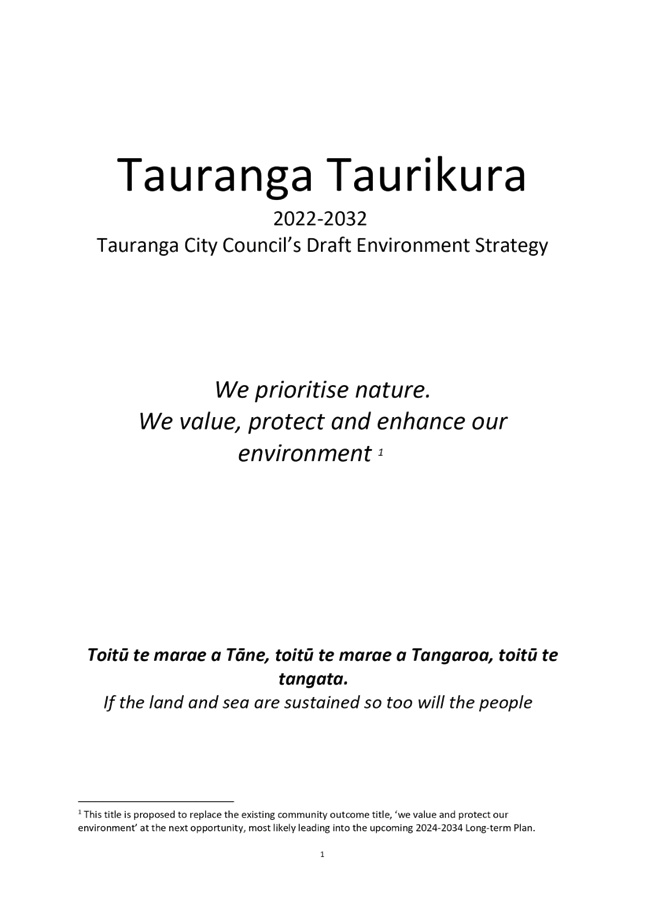
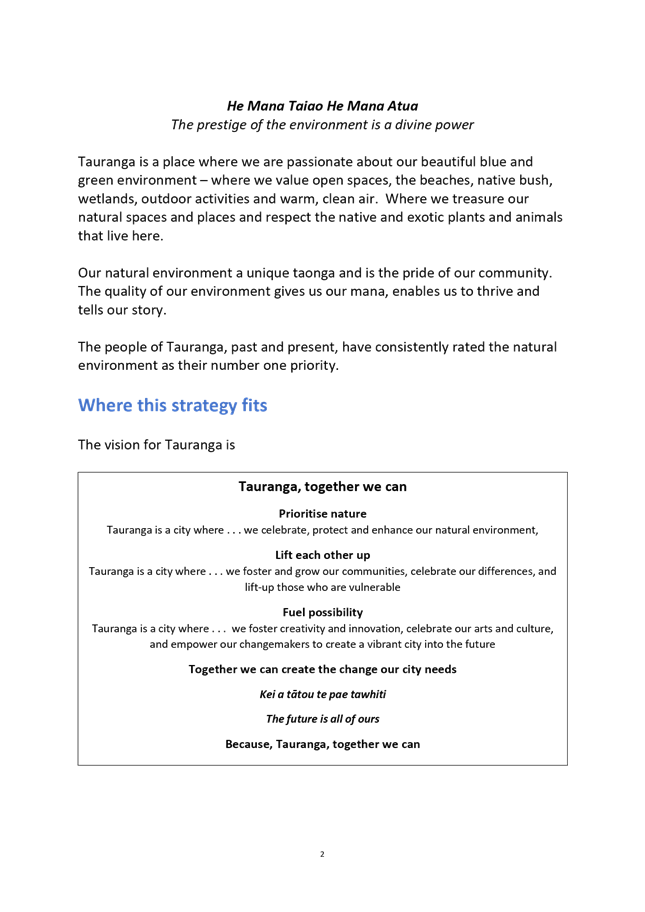
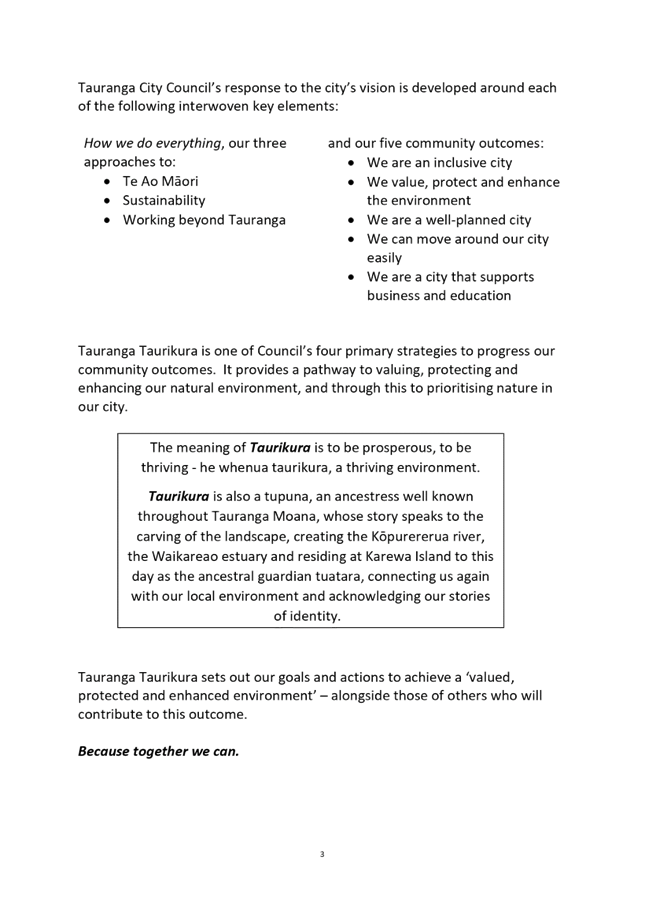
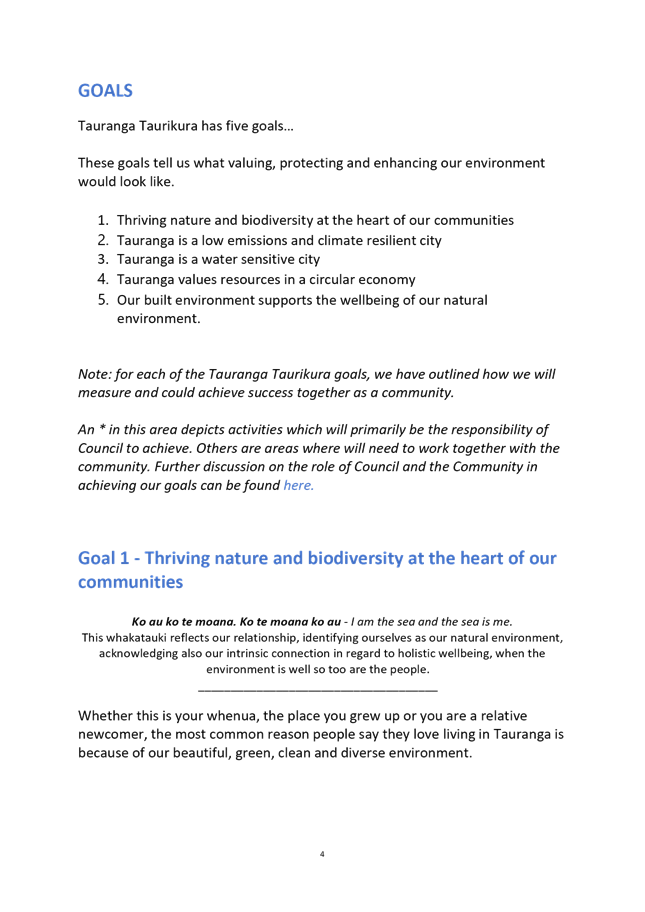
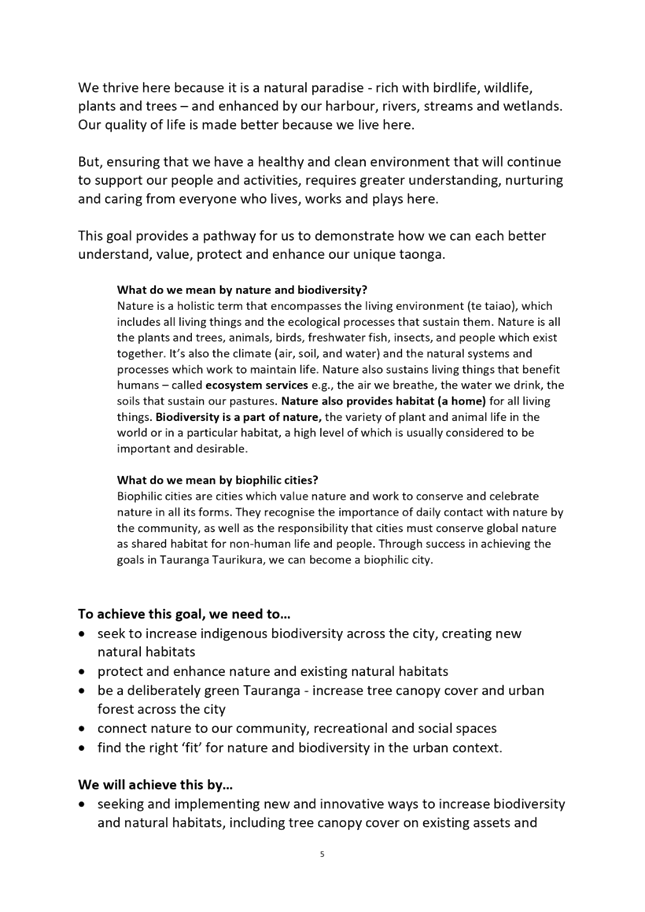
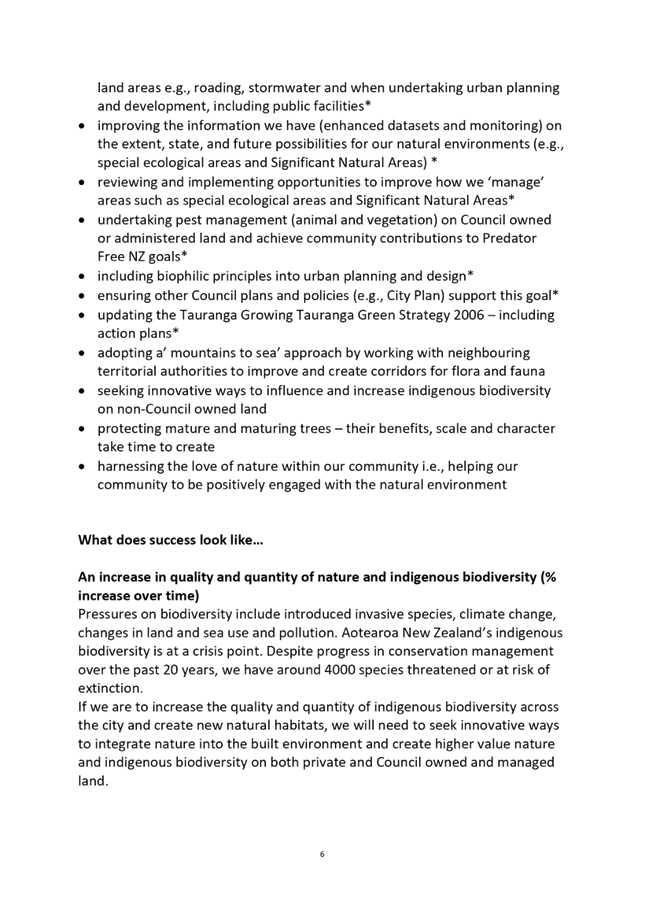
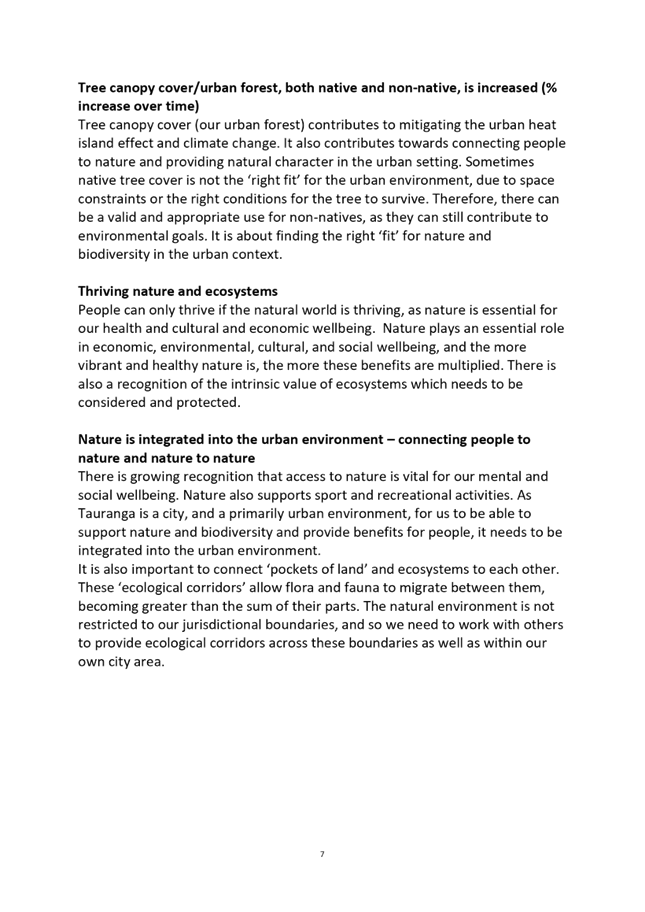
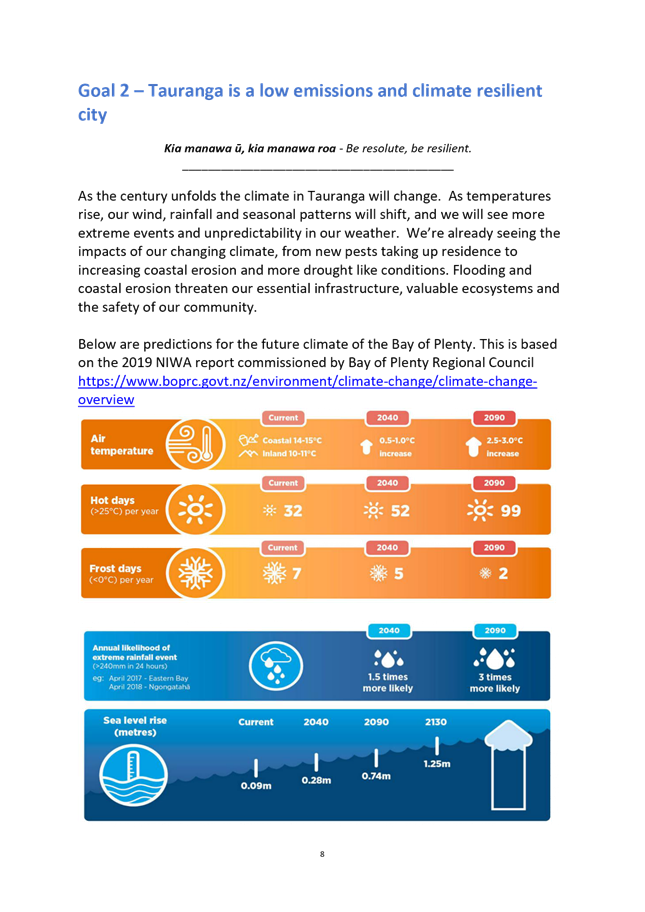
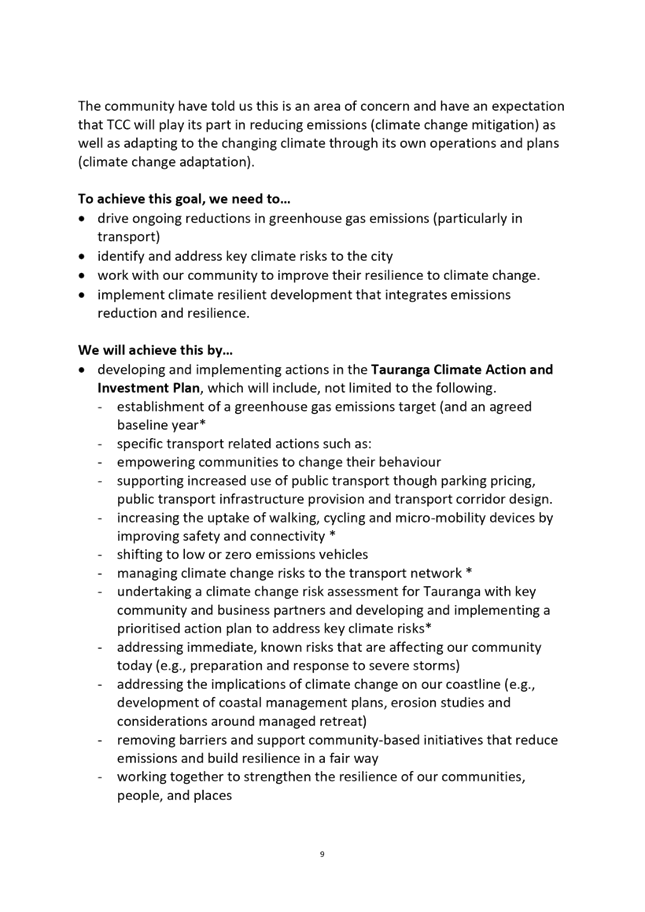
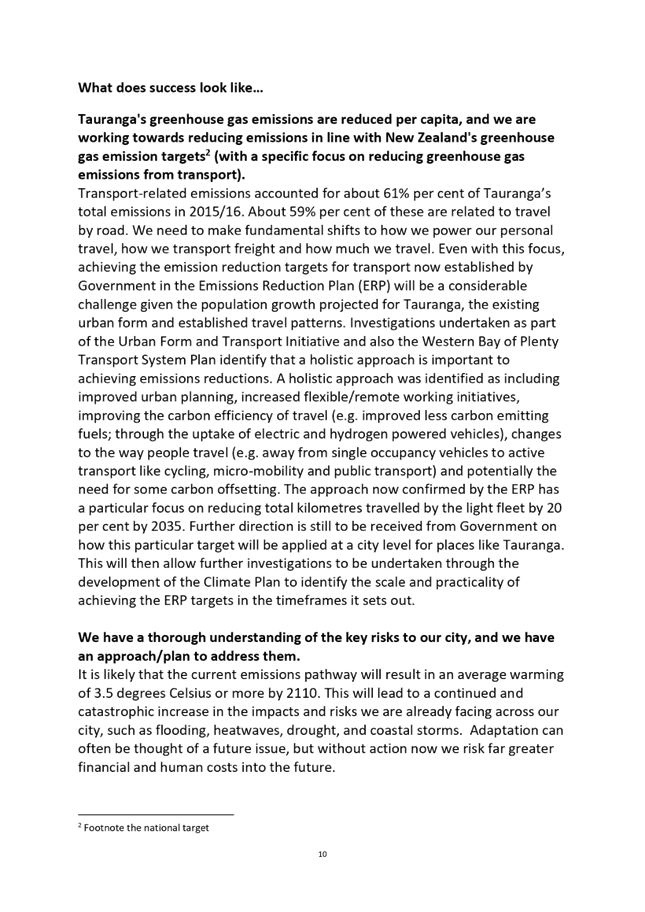
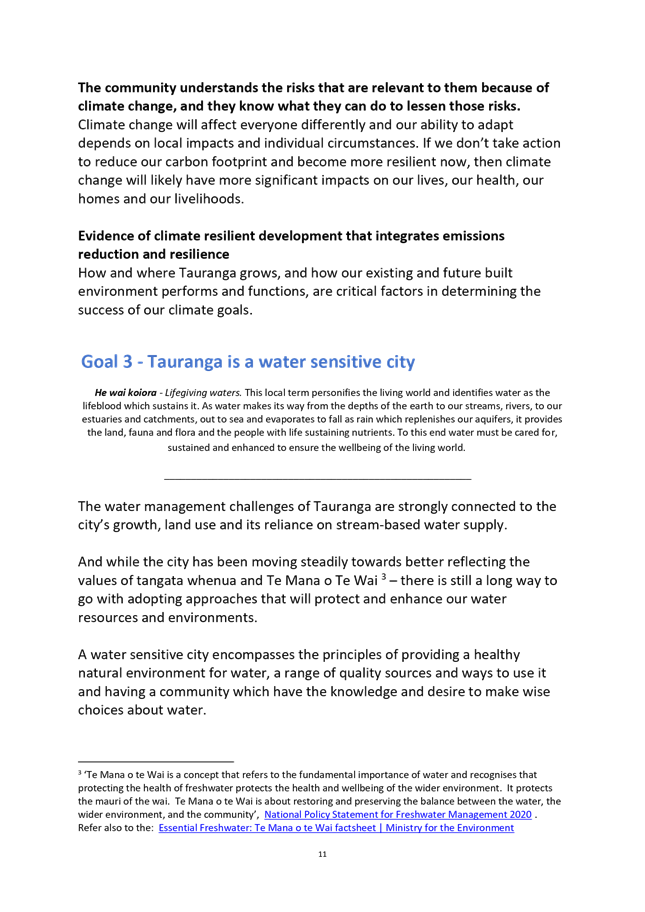
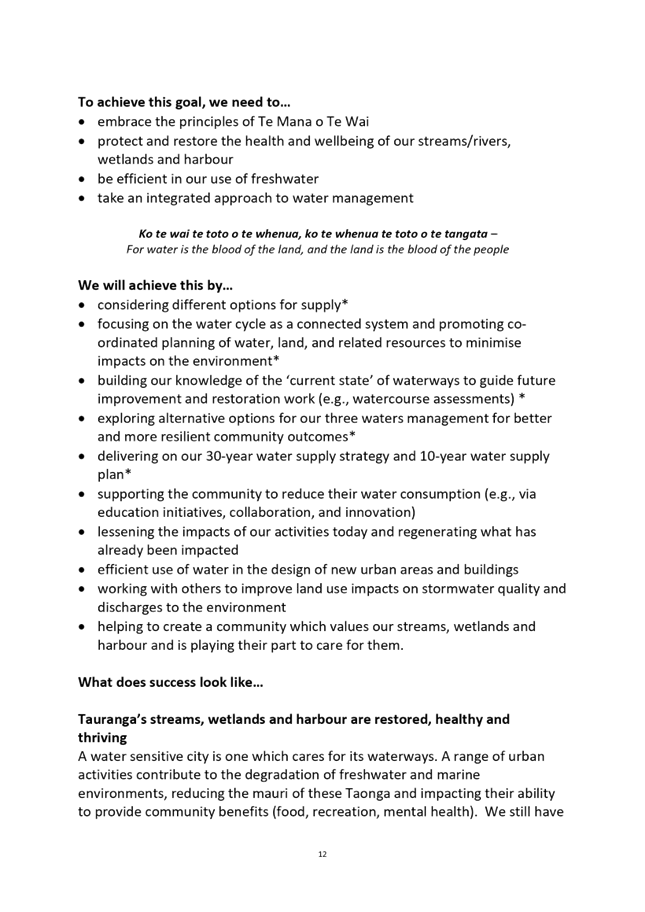
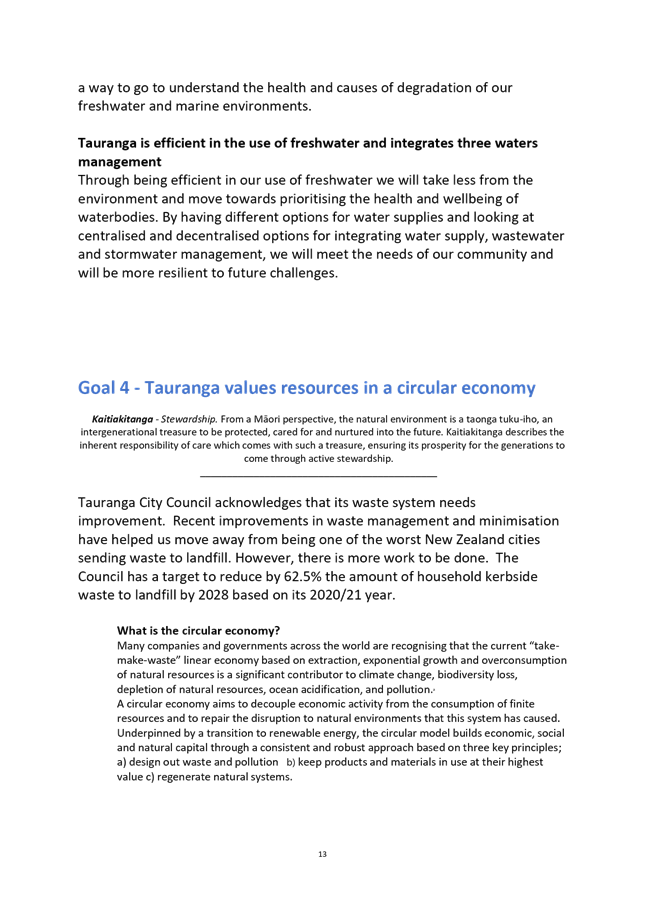
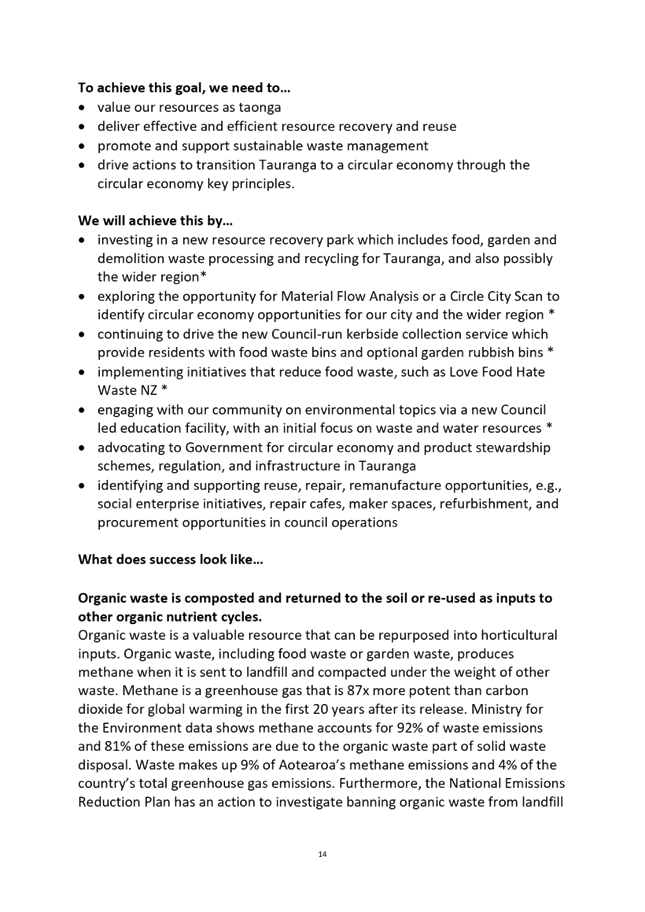
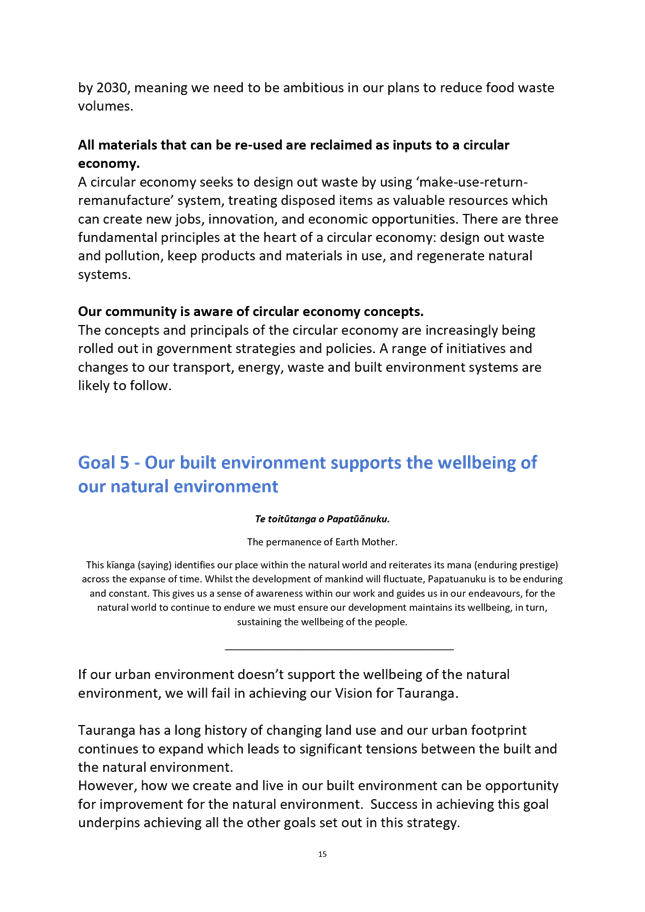
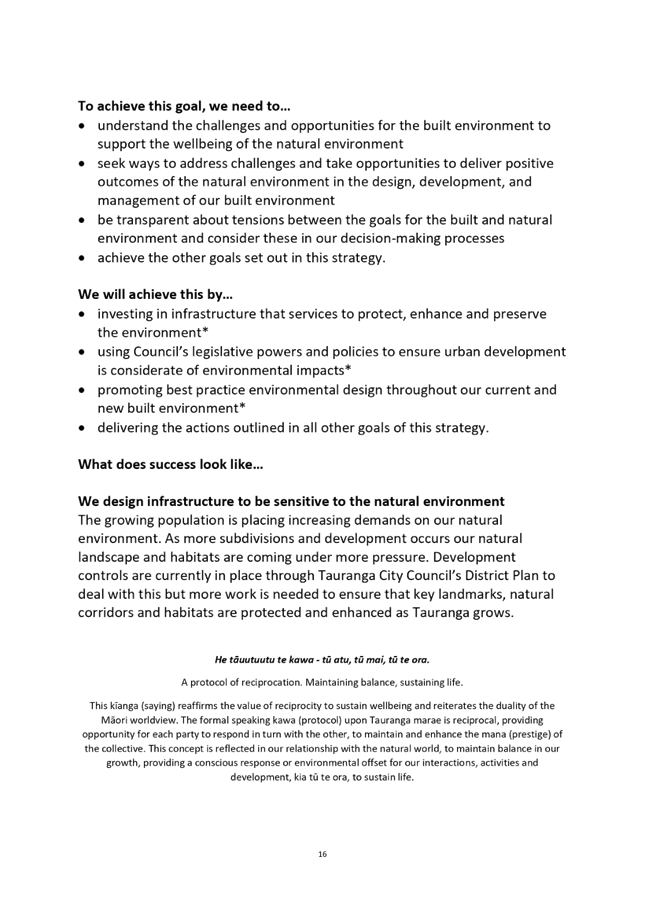
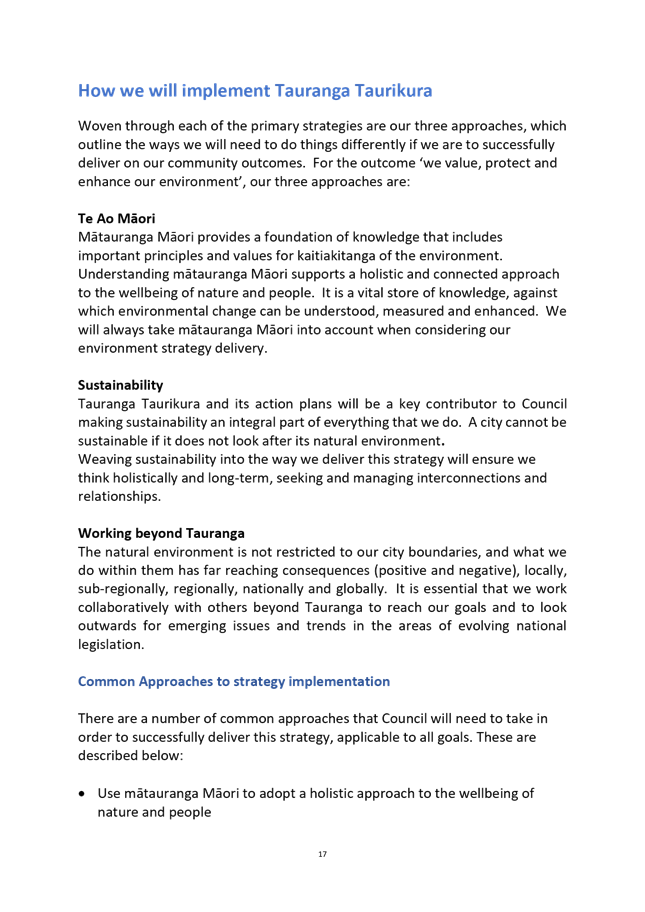
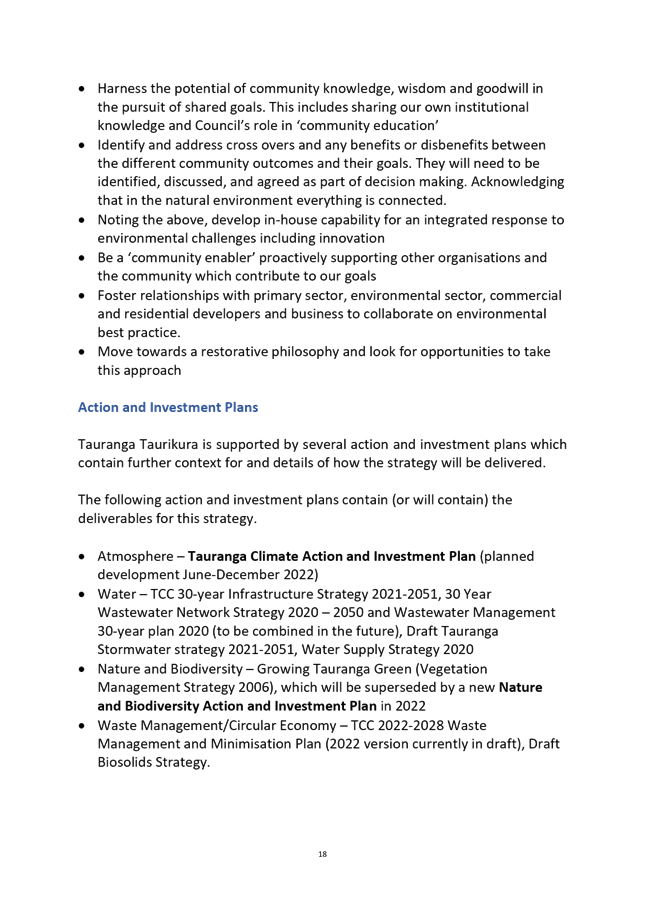
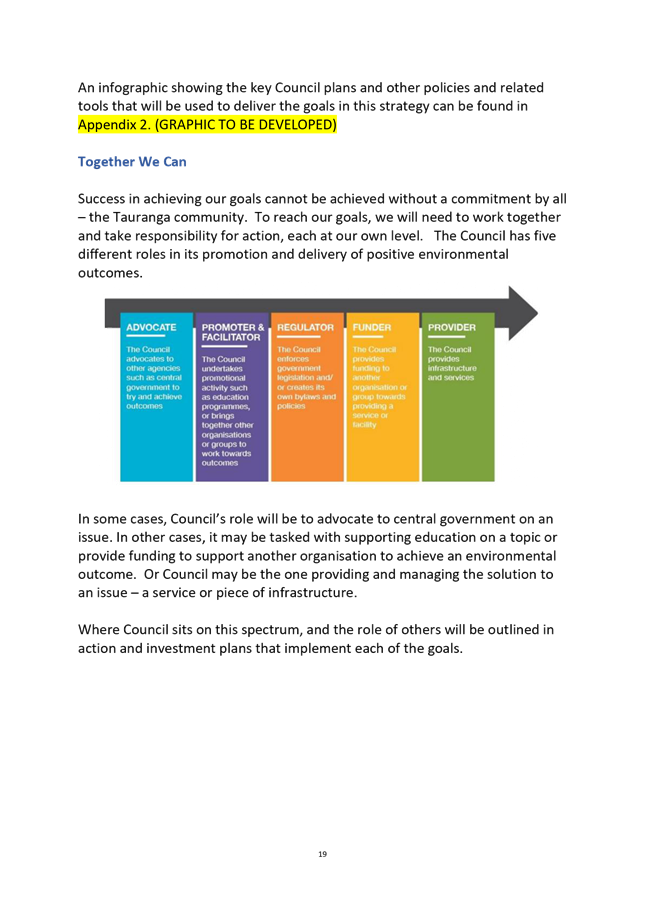
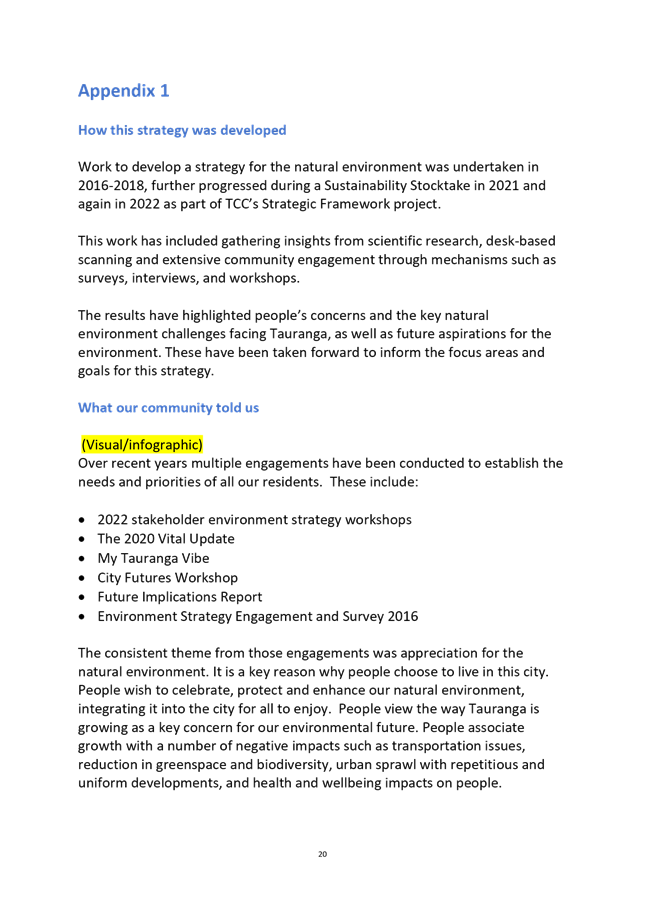
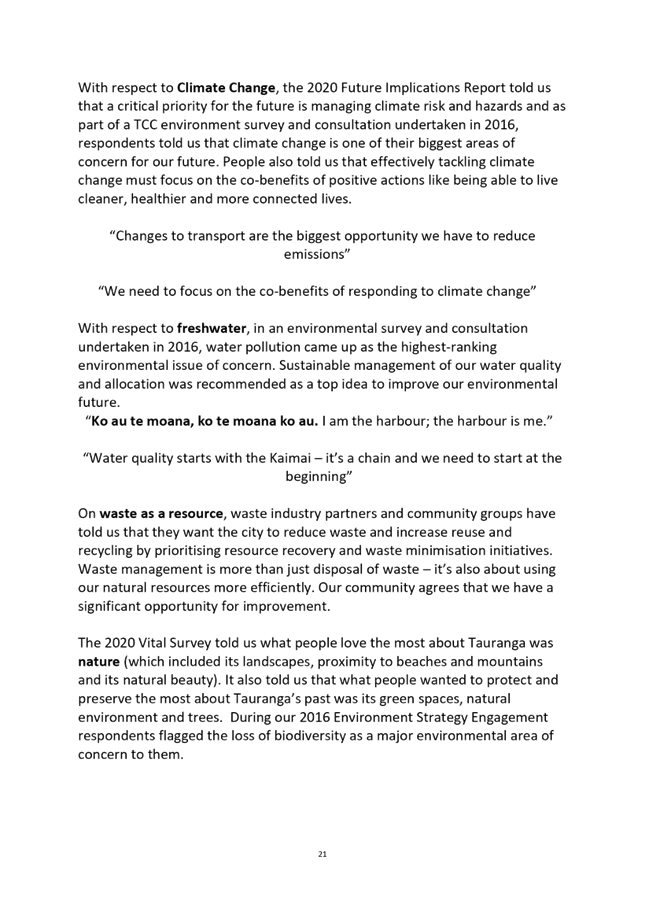
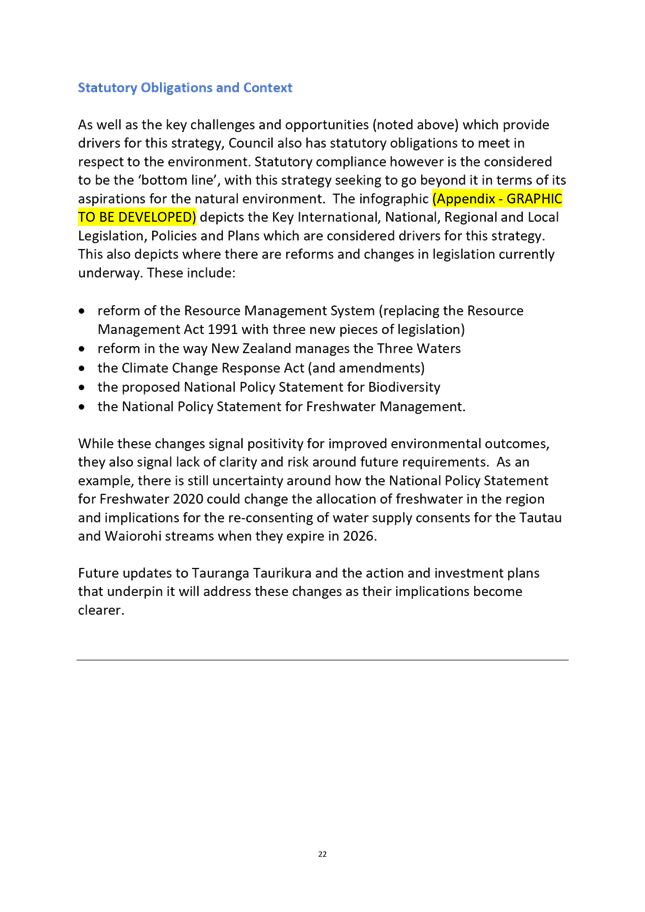
|
Ordinary Council meeting Agenda
|
27 June 2022
|
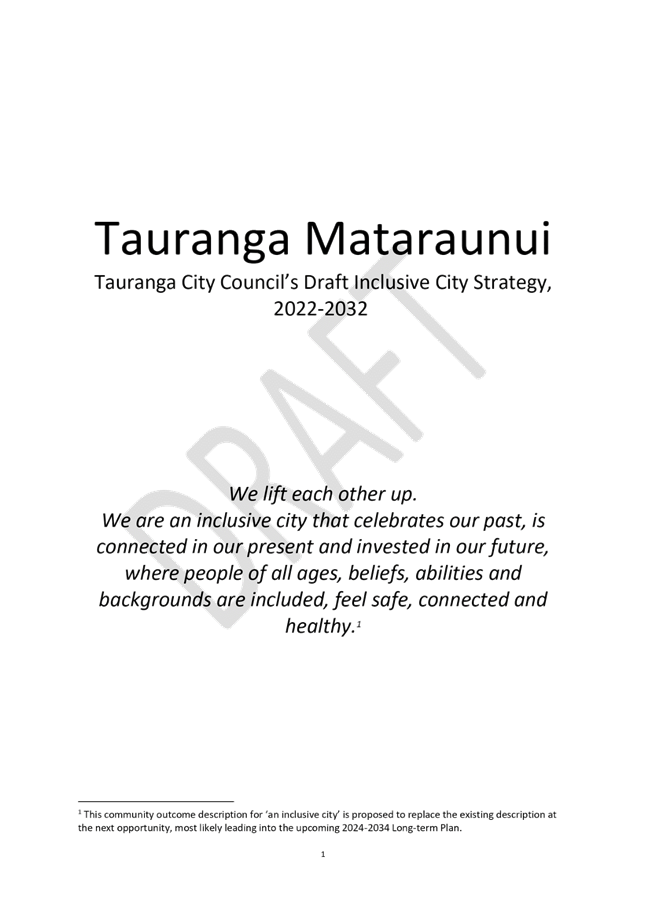
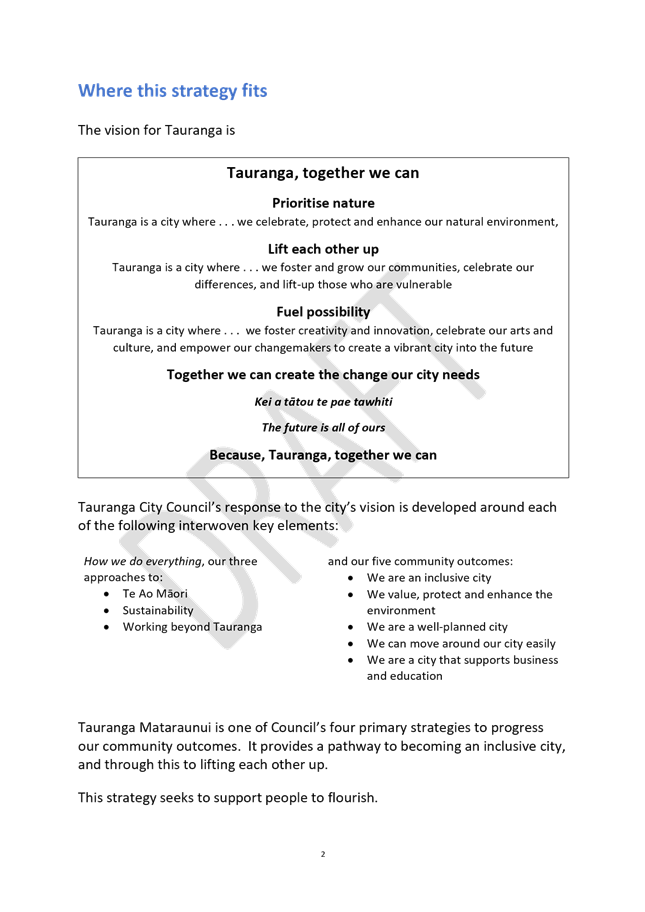
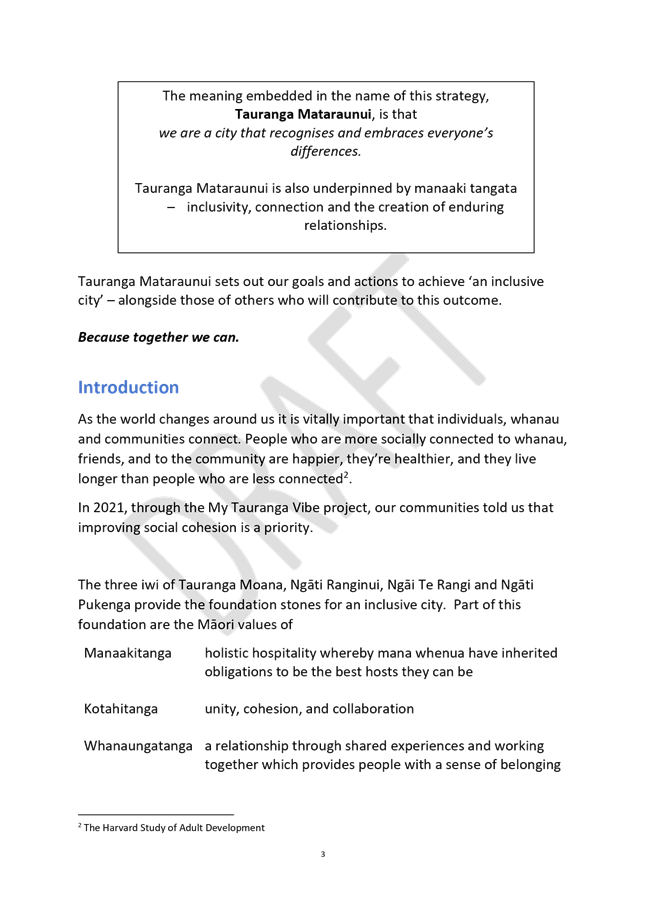
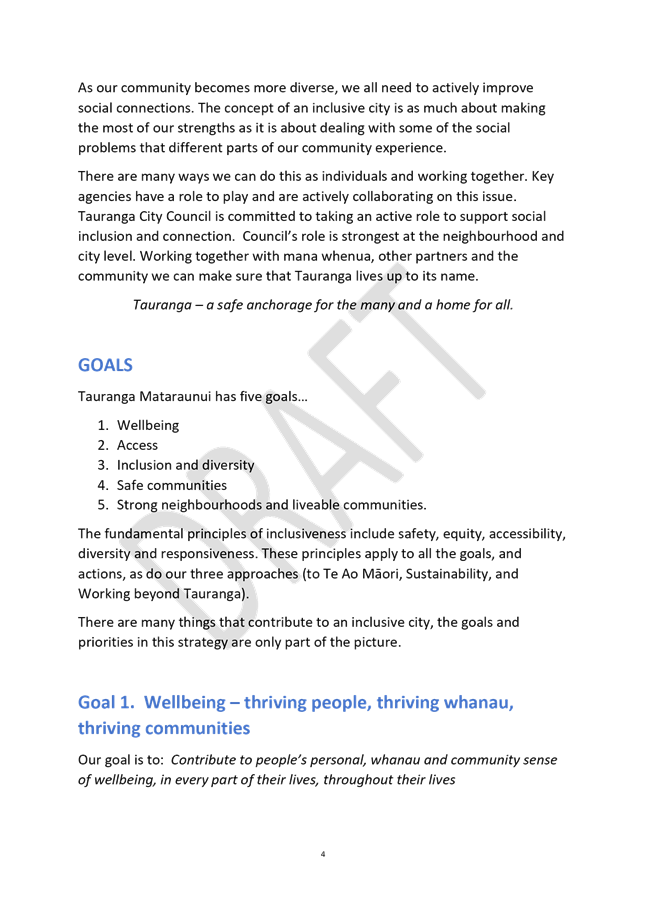
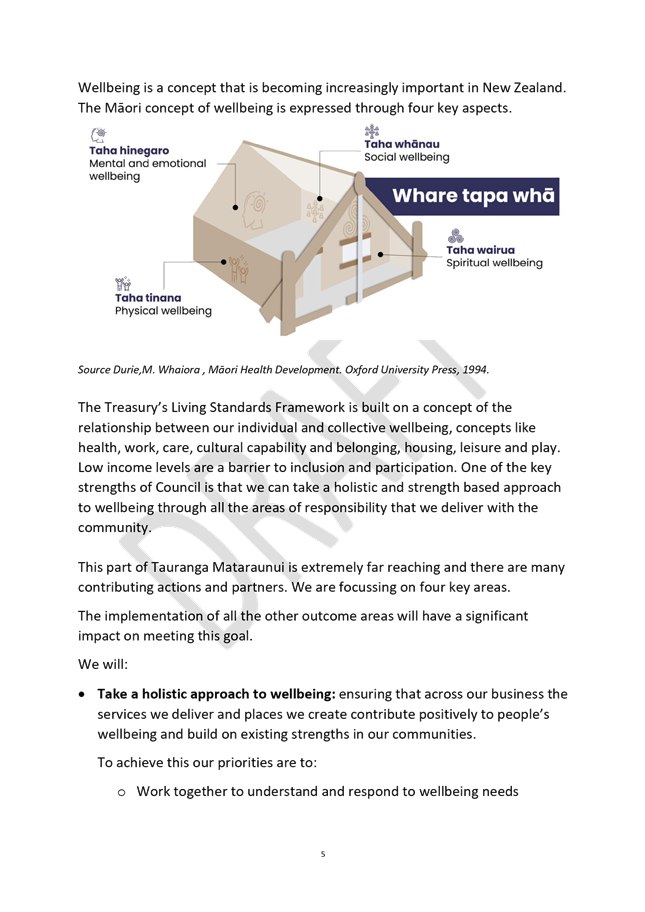
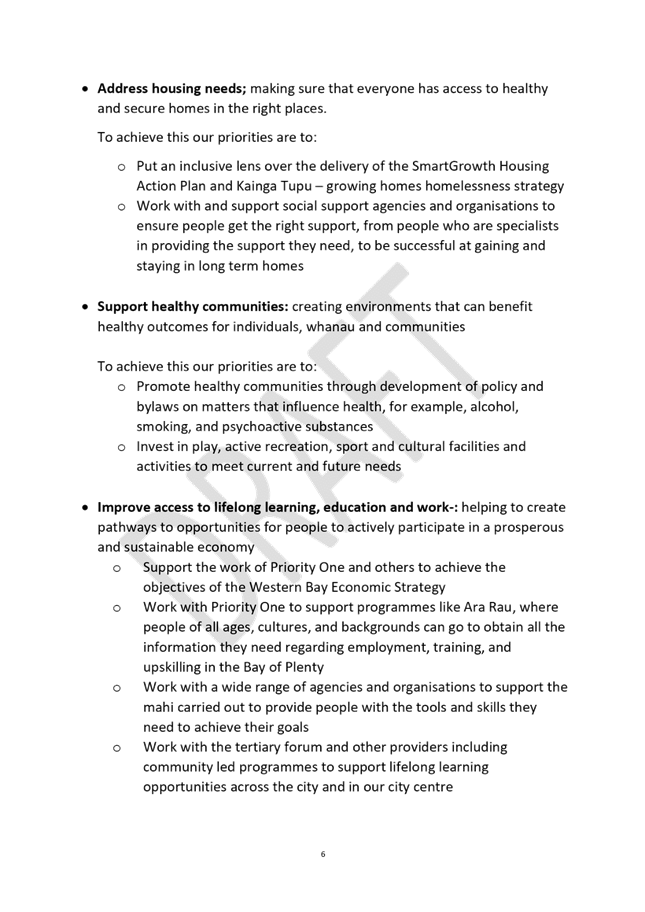
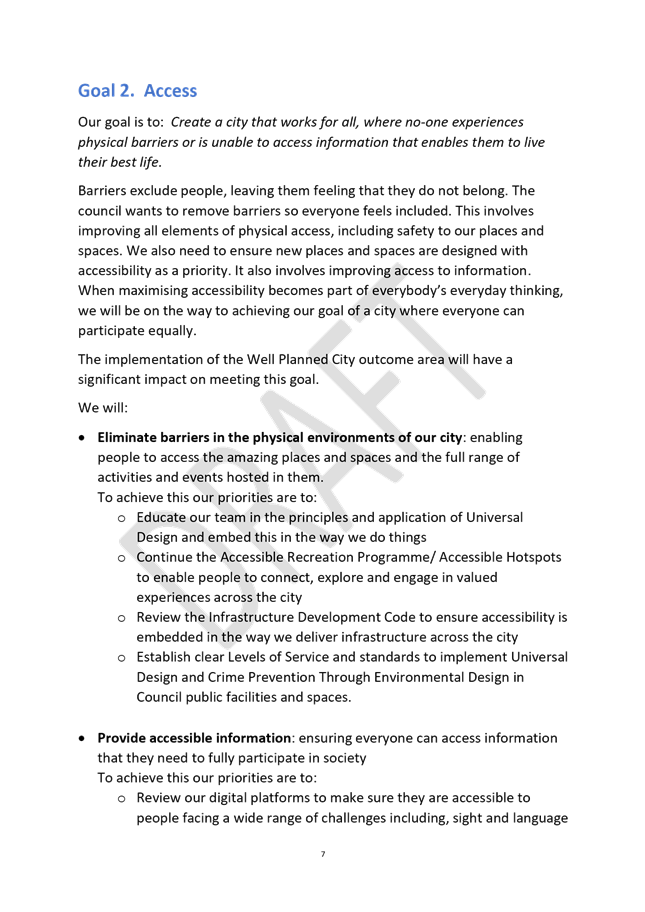
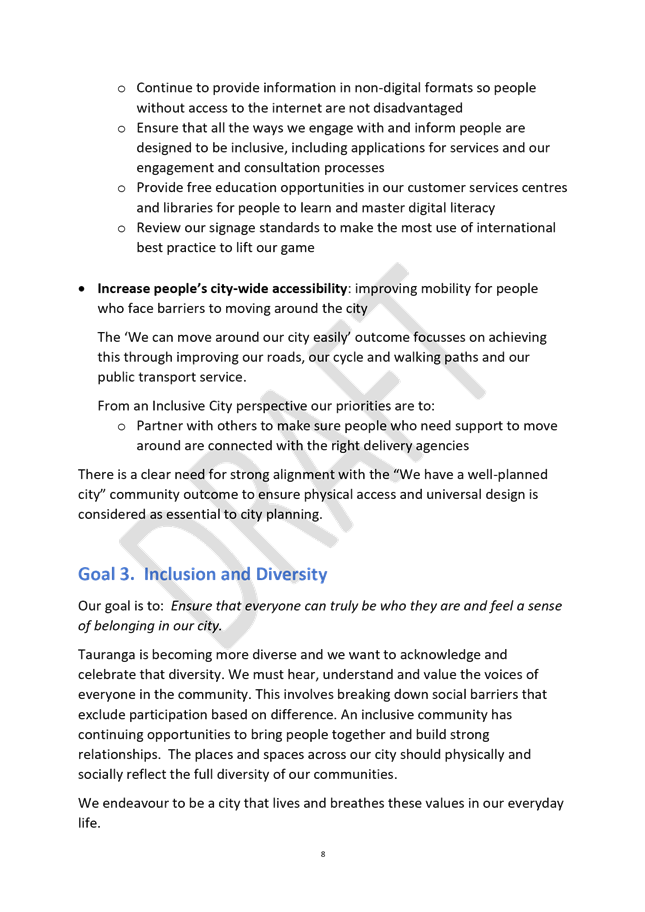
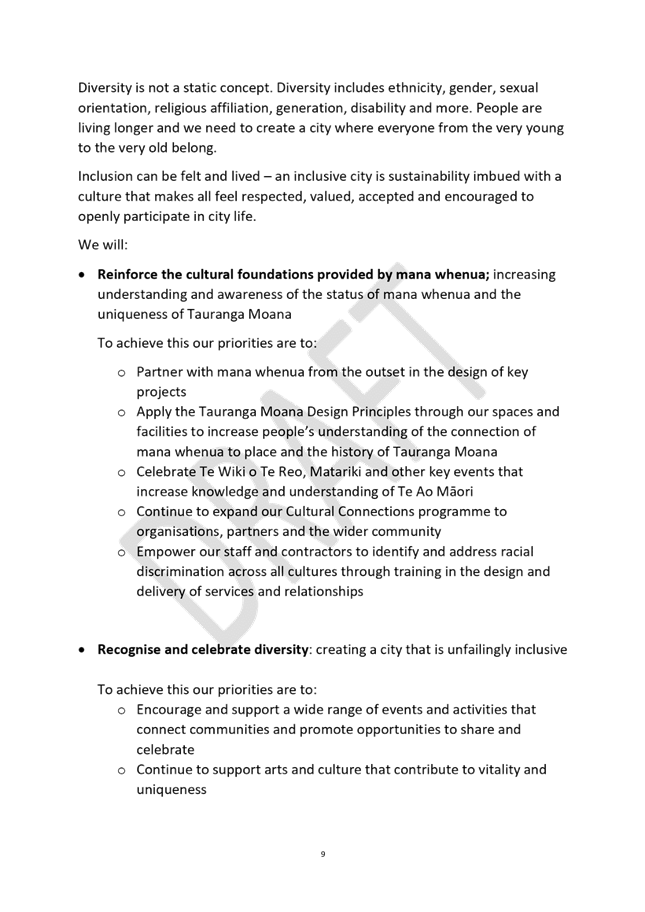
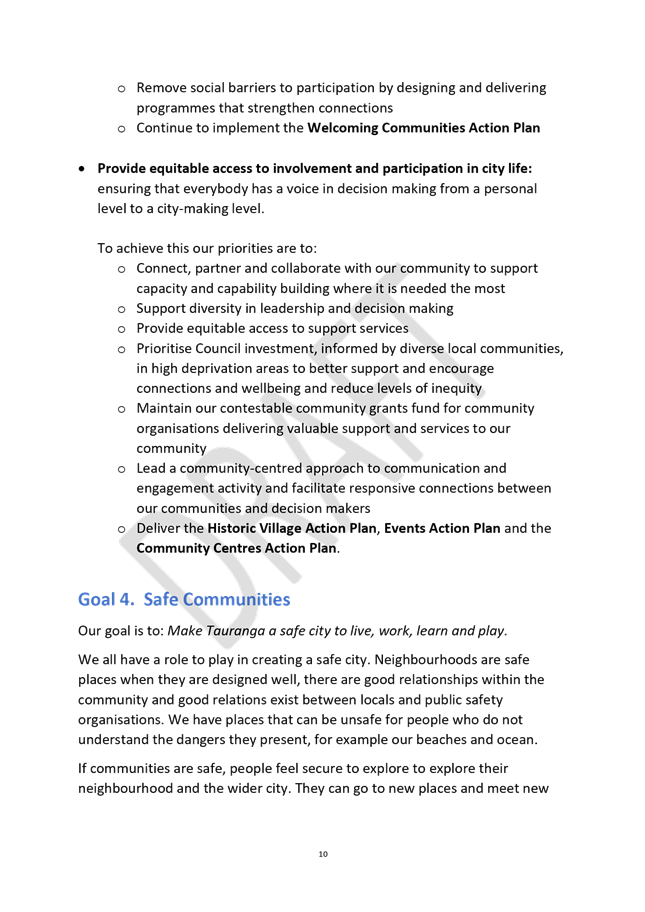
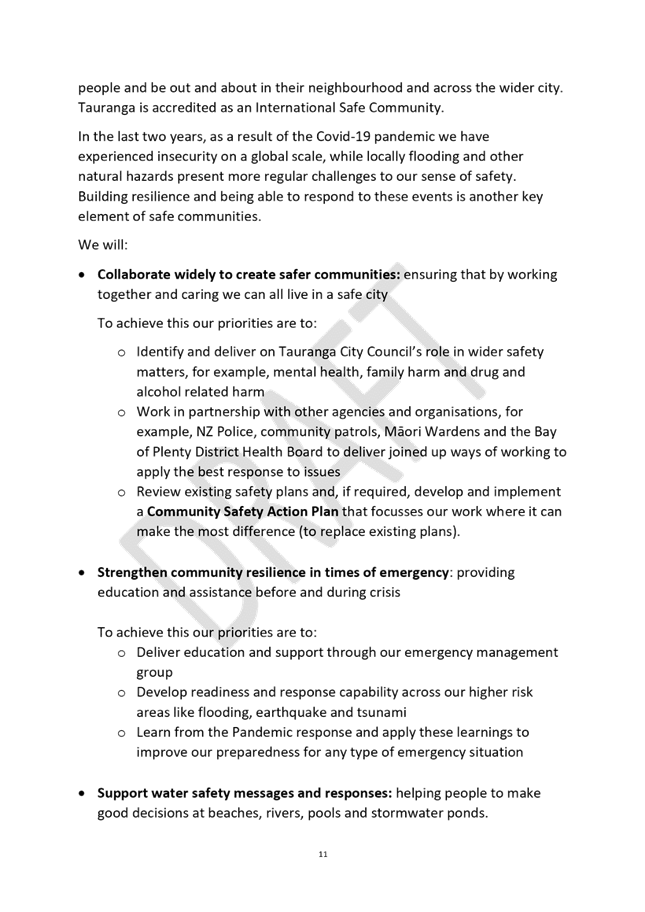
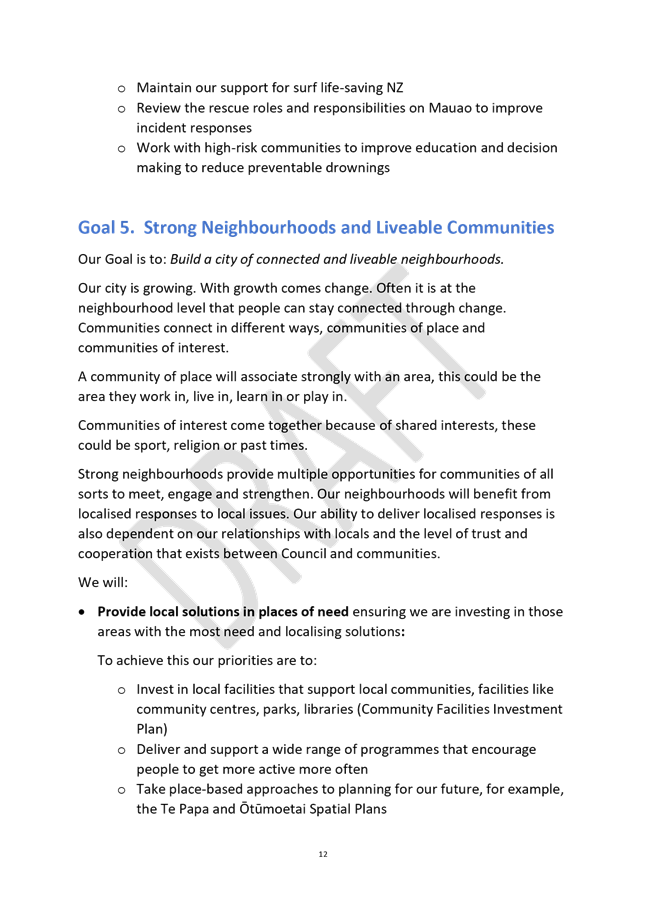

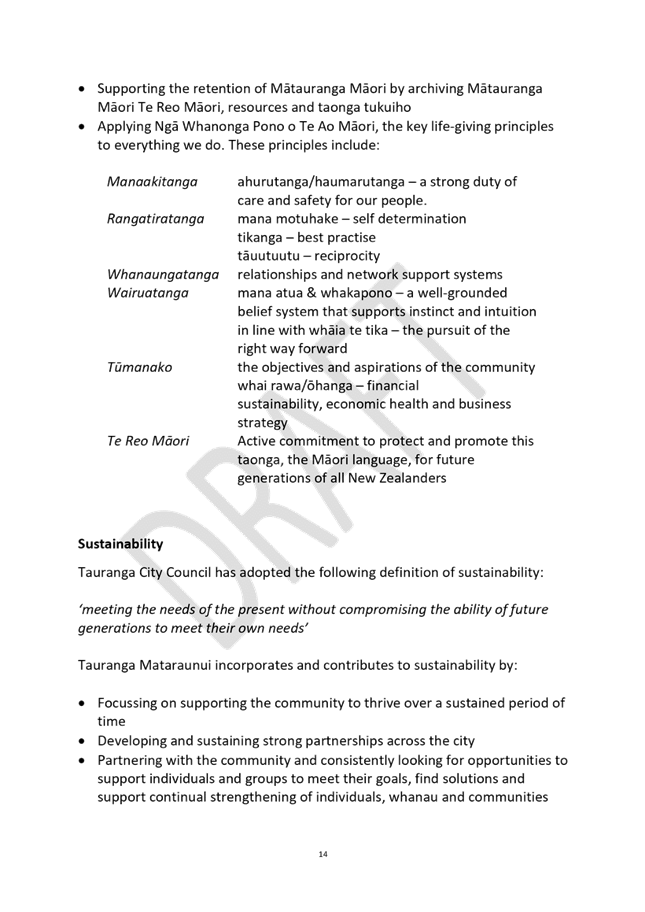
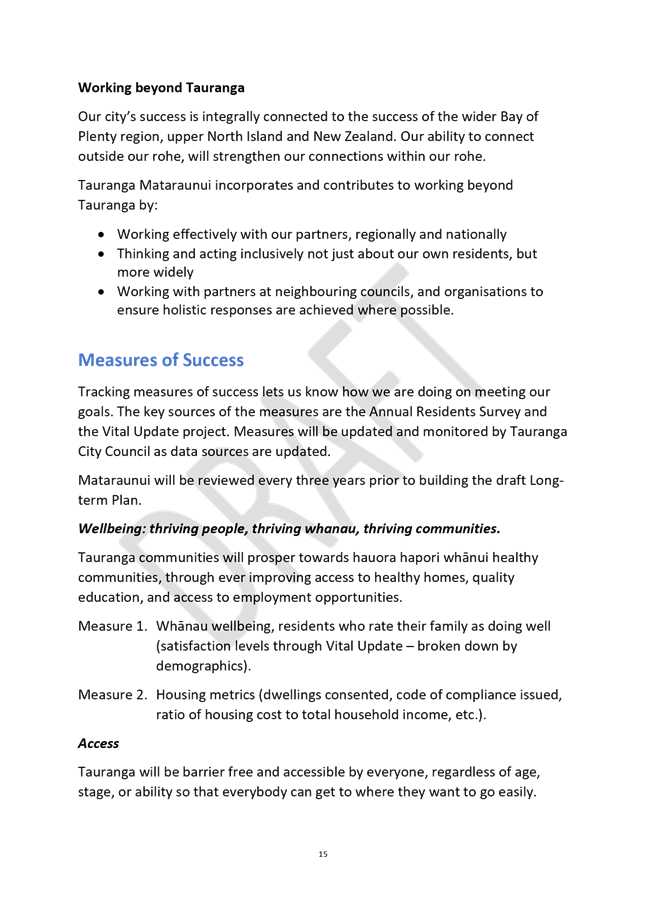
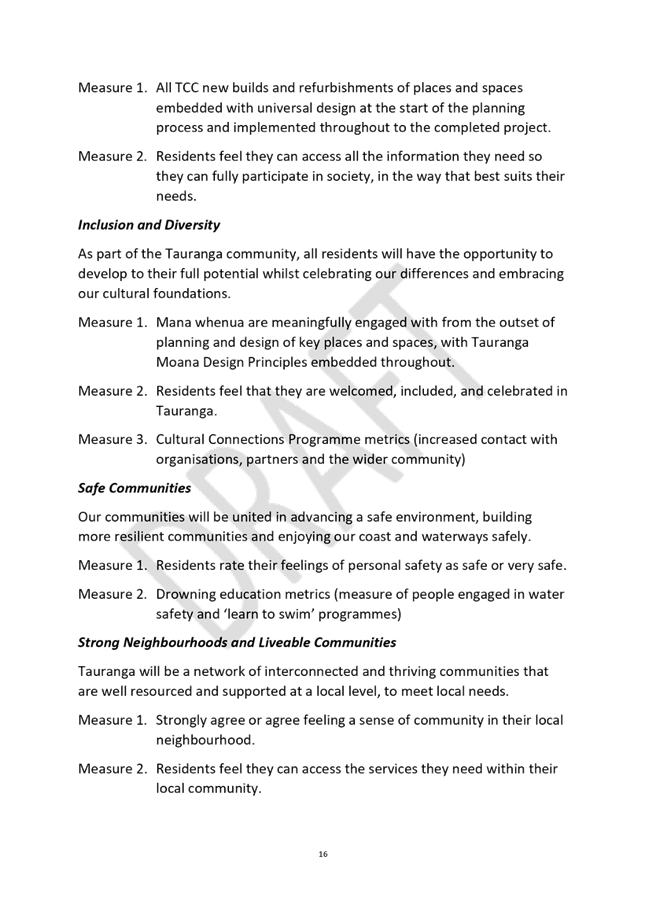
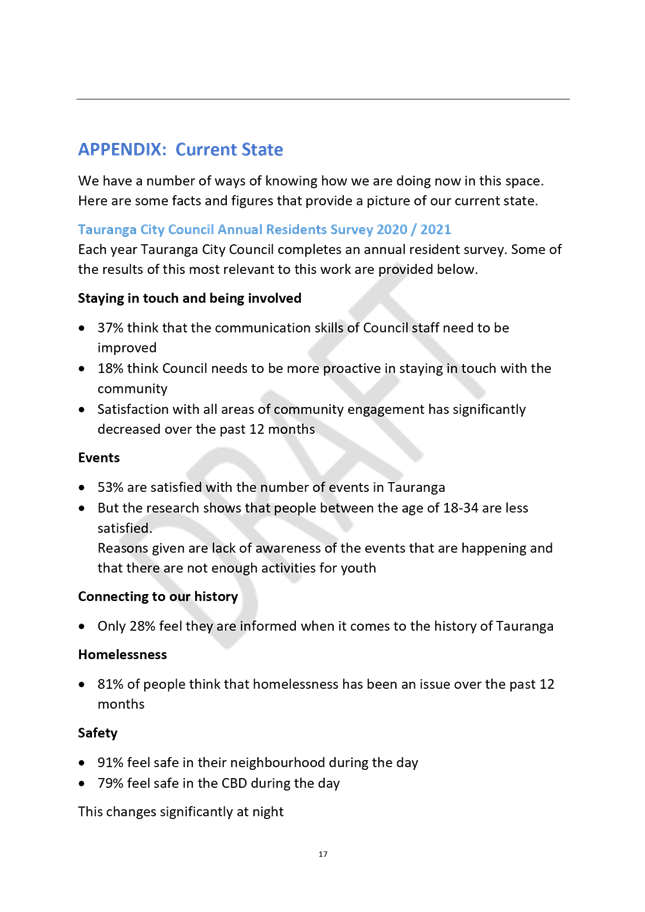
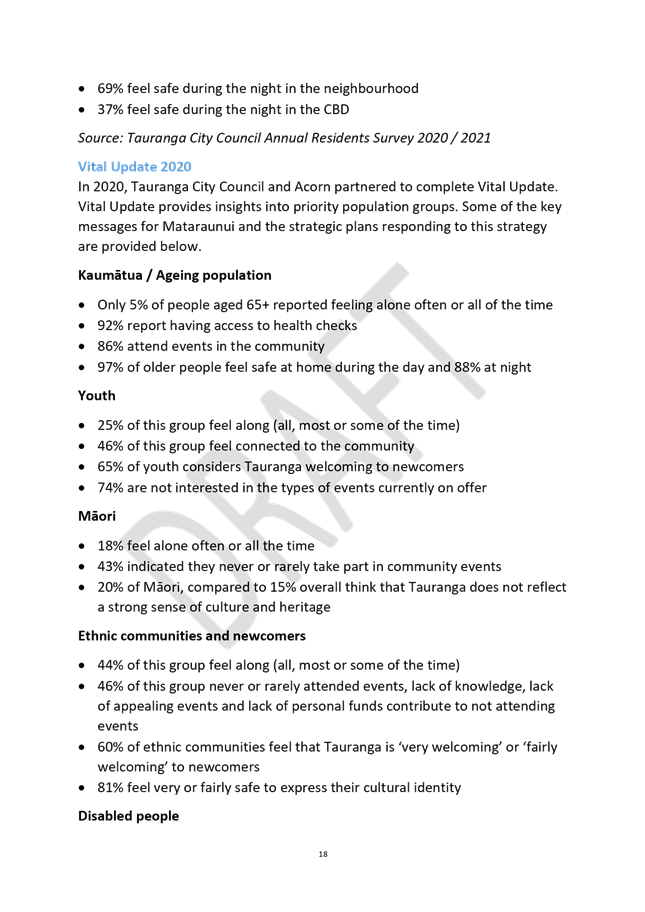
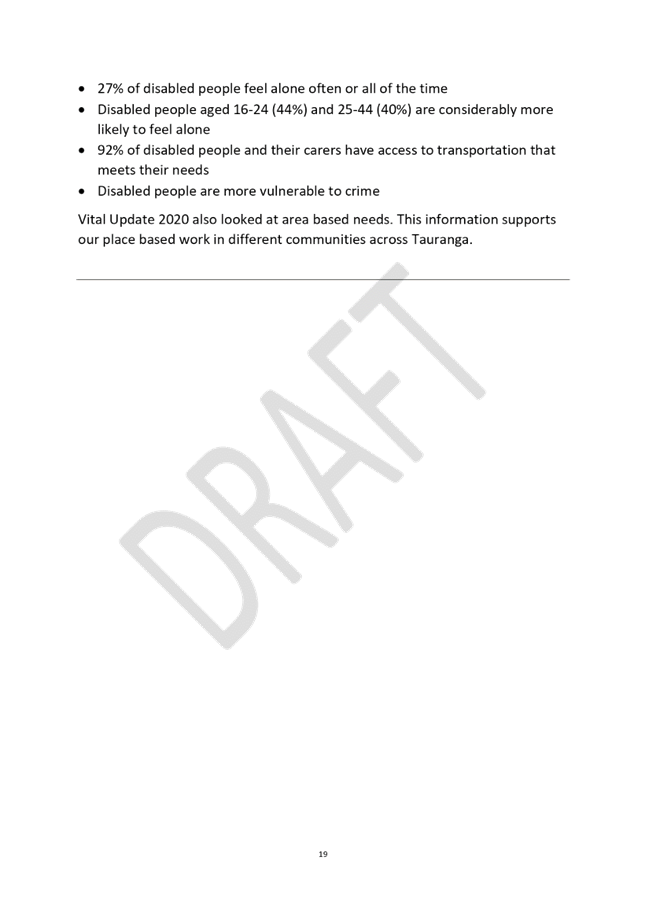
11.9 Marine
Park reclassification hearings report
File
Number: A13576696
Author: Gert
van Staden, Senior Strategic Advisor
Authoriser: Christine
Jones, General Manager: Strategy & Growth
Purpose of the Report
1. To
hear verbal submissions and receive the written submissions forming part of the
public consultation of the reclassification of part of Marine Park.
|
Recommendations
That the Council:
(a) Receives
the written submissions in relation to the proposed reclassification of part
of Marine Park and hear verbal submissions in support of the written feedback
received.
(b) Notes
that a final decision on the reclassification will be made by way of a later
deliberations report to fully consider the submissions received, tangata
whenua engagement and any feedback from the Minister of Conservation.
|
Executive
Summary
2. On
4 October 2021, Council resolved to initiate the reclassification of part of
Marine Park, more particularly identified by SO Plan 530292 which has been
approved as to survey.
3. Public
consultation on the reclassification commenced formally on 16 May 2022 and
concluded on 20 June 2022.
4. Council
received 108 objections and 213 submissions in support of the reclassification.
5. In
terms of the Reserves Act 1977 (Reserves Act), Council must consider the
objections received before resolving to confirm or abandon the
reclassification.
6. Overall,
the reclassification proposal has been received well, with 65.9% of submission
being in support.
Background
7. Council
has initiated a reserve reclassification process for part of Marine Park. This
report presents the results of the public consultation and introduces the
public hearing.
8. Engagement
with iwi and hapū is still underway and feedback will be included in the
deliberations report on 25 July 2022.
9. For
a more comprehensive history of this workstream, readers are referred to the 4
October 2021 report.
Strategic / Statutory
Context
10. In
terms of the Reserves Act, Council is required to consider all submissions
before deciding whether to confirm the proposed reclassification.
11. At
the 4 October 2021 meeting, Council resolved to have a public hearing for those
submitters wishing to be heard. According to the Act, all objections must be in
writing, and the verbal submissions made today will be to support the written
submissions already received.
12. All
of the submissions received, as well as any feedback received from the Minister
of Conservation (Minister), will be considered in the deliberations report
which is scheduled for 25 July 2022.
Consultation
13. During
the consultation, members of the public were asked whether they supported or
objected to the reclassification.
14. Council
received a total of 323 submissions. The submissions can be categorised into
three main categories, namely objections, neutral submission, and submissions
in support.
15. 65.9%
of submissions were in support of the reclassification, and 33.4% of
submissions objected to the proposal. 0.6% of submissions received were
neutral.
Image 1: Bucketed percent

16. The
graph below sets out the individual responses to the consultation on the
reclassification.
Image 2: Individual responses
(not bucketed according to category)

17. The
graphs above include one submission in opposition which was received twice.
This will be cleaned up for the deliberations report.
18. The
Reserves Act stipulates that the objections must be considered before deciding
to proceed with the reclassification, to assist with this consideration, the
objections have been assessed by identifying key issues raised.
19. The
assessment of submissions identified a number of key objection points which
were all grouped according to the theme to which the objection best
relates.
20. A
significant portion of the objections relate to one of the two themes (Open
Space and Alternative Site/Use), the remainder of the objection points were
themed as “Other” as the numbers did not justify the creation of
another standalone theme.
21. The
below table illustrates the key objection points and how they were themed,
objections without justifications are not included in this table.
 Table 1: themed submissions
Table 1: themed submissions
22. A
full list of submissions can be found at attachment A.
23. The
deliberations report set for 25 July 2022 will contain a detailed consideration
of the objections received a well as an analysis of the submissions in support.
Options Analysis
24. There
are currently no options to consider. Council must consider the submission
received.
25. Council
will have the option of confirming or abandoning the reclassification on 25
July 2022.
Financial Considerations
26. There
are no impacts to existing budget lines, and no funding is being requested.
Legal Implications /
Risks
27. As
mentioned under the Options Analysis, Council is statutorily required to
consider the objections and submissions received prior to deciding on the
reclassification proposal.
Consultation /
Engagement
28. The
Local Government Act 2002 requires an assessment of the significance of
matters, issues, proposals and decisions in this report against Council’s
Significance and Engagement Policy. Council acknowledges that in some
instances a matter, issue, proposal or decision may have a high degree of importance
to individuals, groups, or agencies affected by the report
Significance
29. The
Local Government Act 2002 requires an assessment of the significance of
matters, issues, proposals, and decisions in this report against
Council’s Significance and Engagement Policy. Council acknowledges
that in some instances a matter, issue, proposal or decision may have a high
degree of importance to individuals, groups, or agencies affected by the
report.
30. In
making this assessment, consideration has been given to the likely impact, and
likely consequences for:
(a) the current
and future social, economic, environmental, or cultural well-being of the
district or region
(b) any persons who are likely to be
particularly affected by, or interested in, the proposal.
(c) the capacity of the local authority to
perform its role, and the financial and other costs of doing so.
31. In
accordance with the considerations above, criteria and thresholds in the
policy, it is considered that the issue is of medium significance.
ENGAGEMENT
32. Taking
into consideration the above assessment, that the issue is of medium significance,
officers are of the opinion that no further consultation is required prior to
Council hearing the submissions as the consultation period has closed.
Next Steps
33. Following
the hearing of submissions, officers will prepare a deliberation report for
Council to fully consider all objections received, further tangata whenua
engagement, as well as any feedback from the Minister.
34. Deliberations
are set for 25 July 2022, after which the Council may resolve to confirm or
abandon the reclassification.
Attachments
1. Attachment
A: Full list of submitters - A13591808 ⇩ 
2. Attachment
B: Submitters wishing to be heard - A13591831 ⇩ 
3. Attachment
C: All hard copy and additional document uploads - A13590069 ⇩ 
|
Ordinary Council meeting Agenda
|
27 June 2022
|
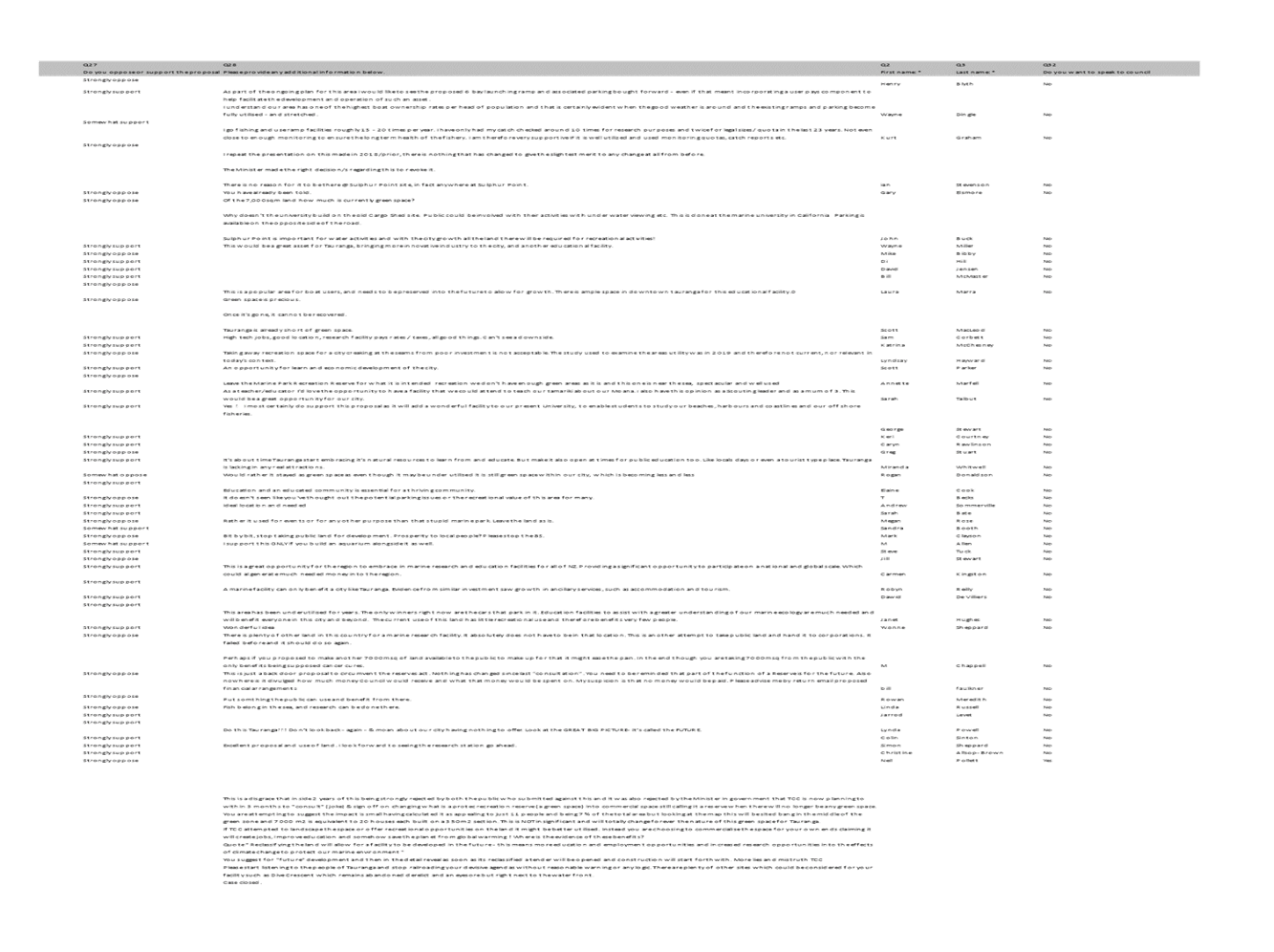
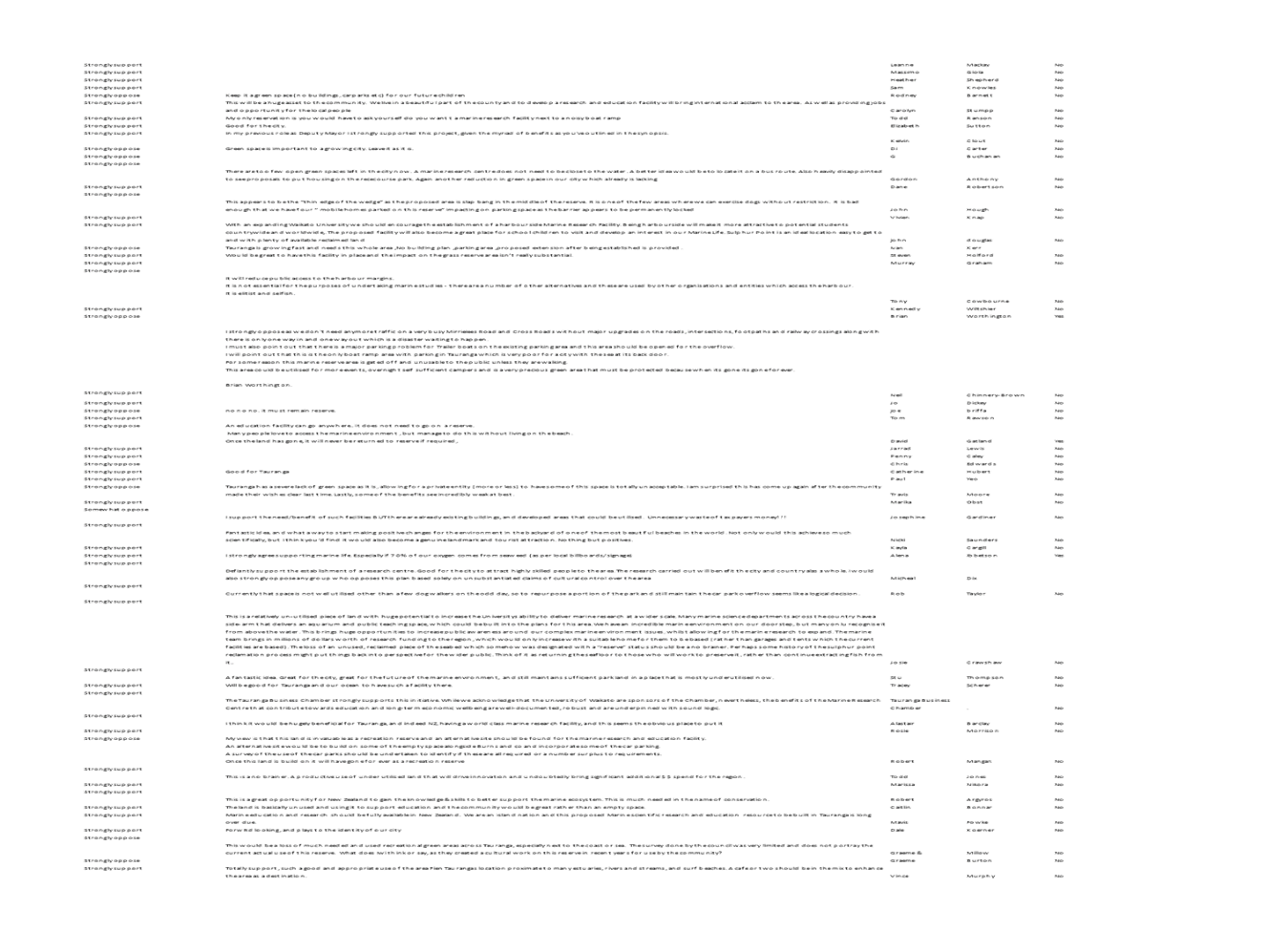
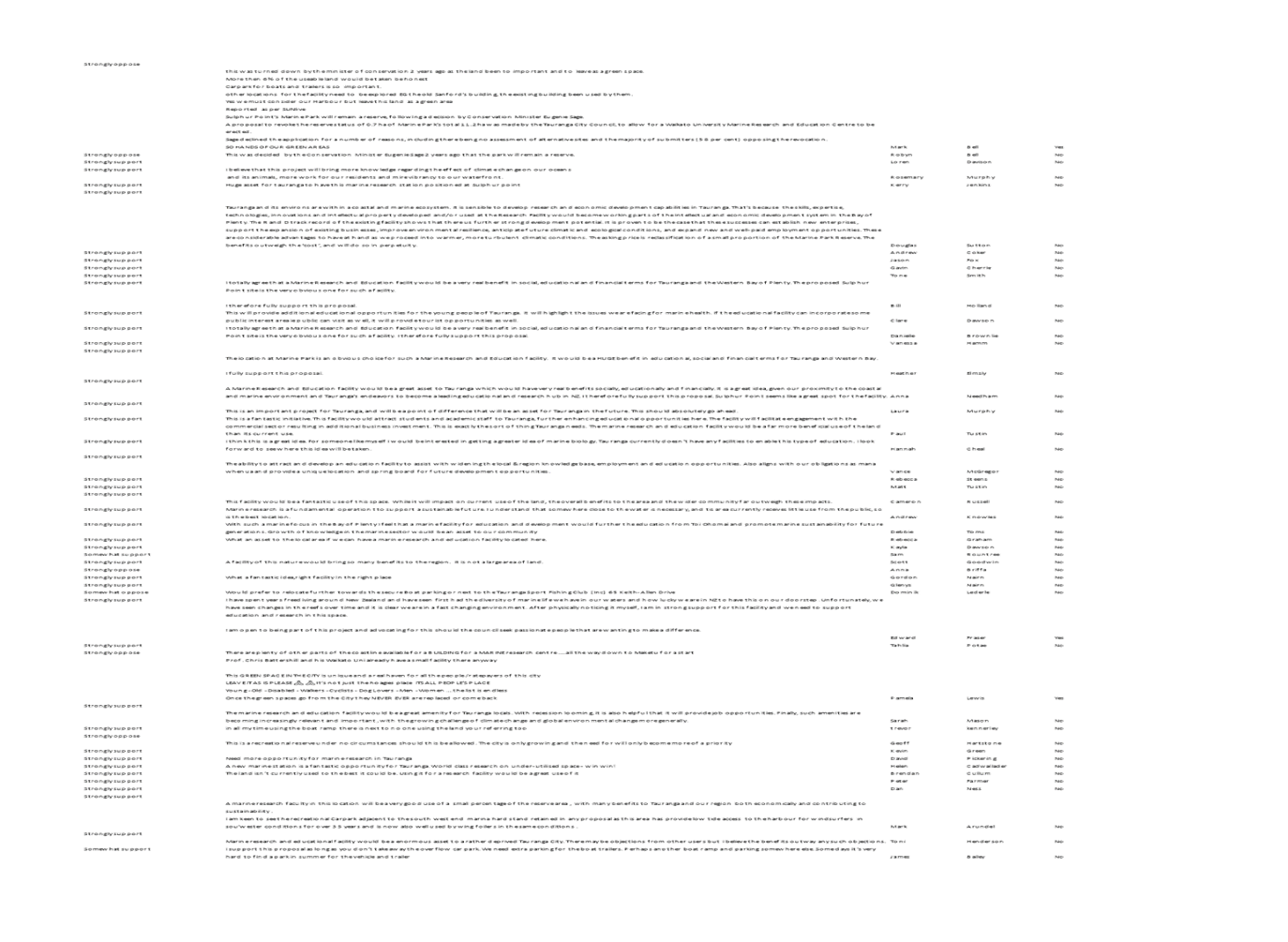
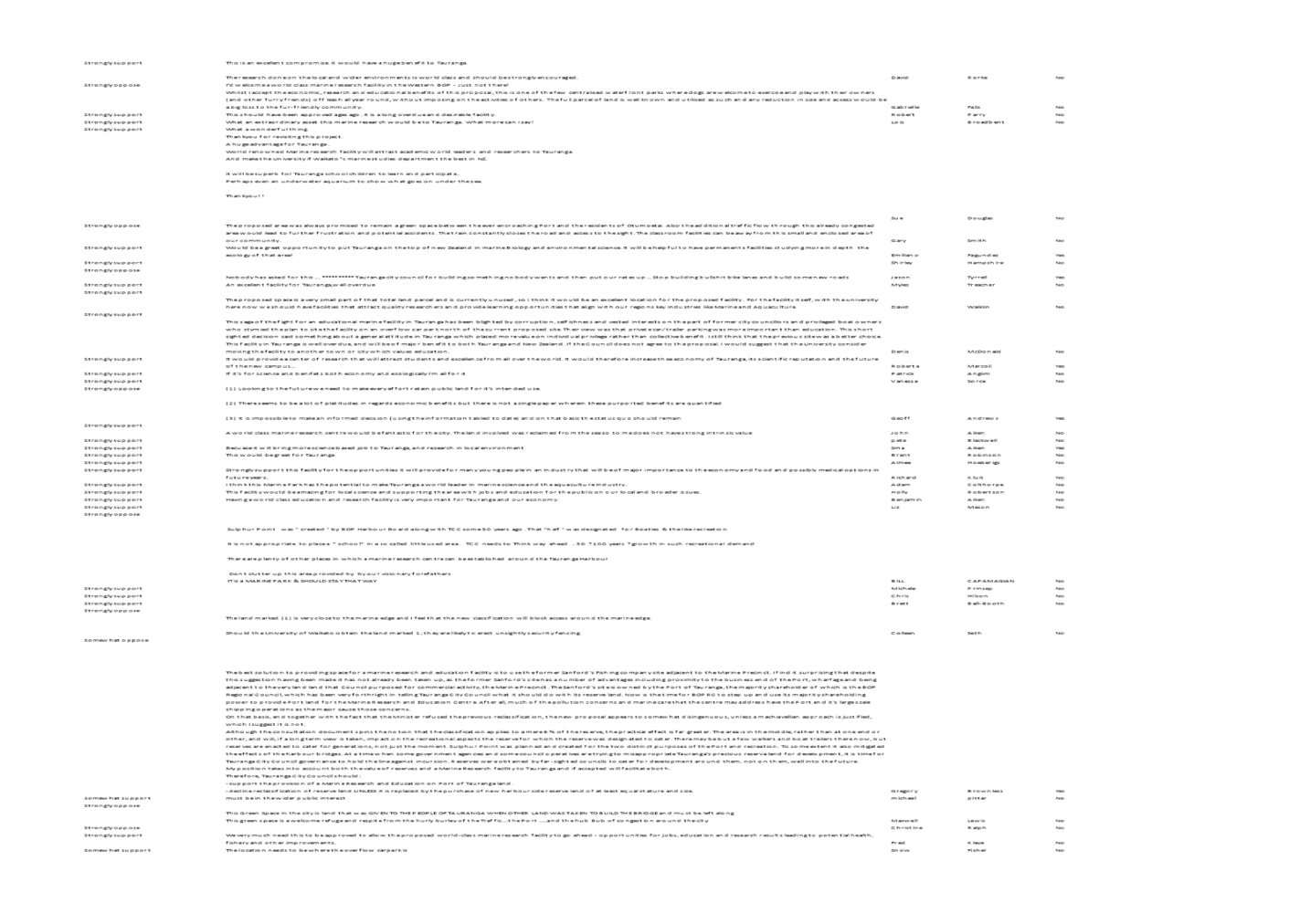
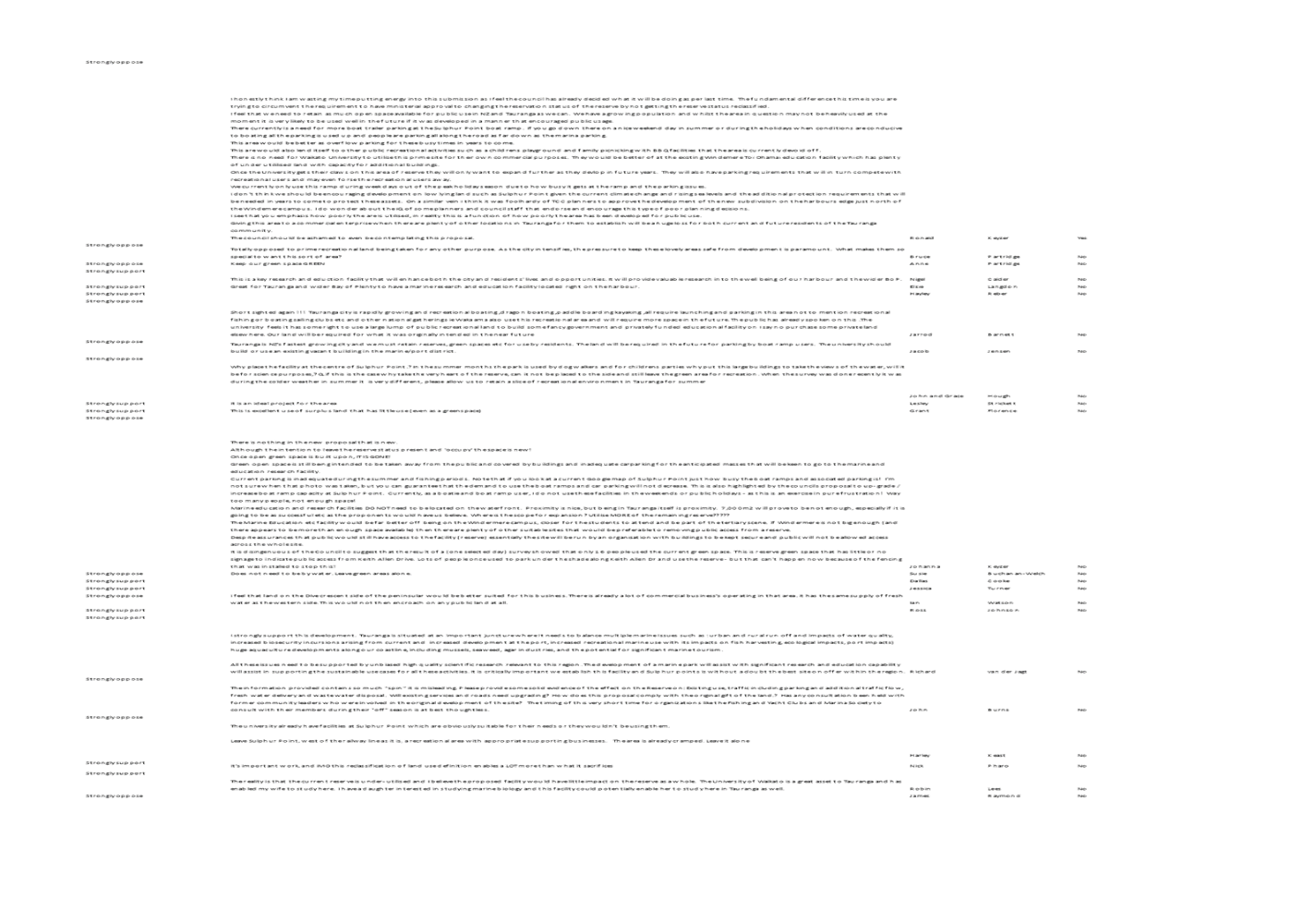
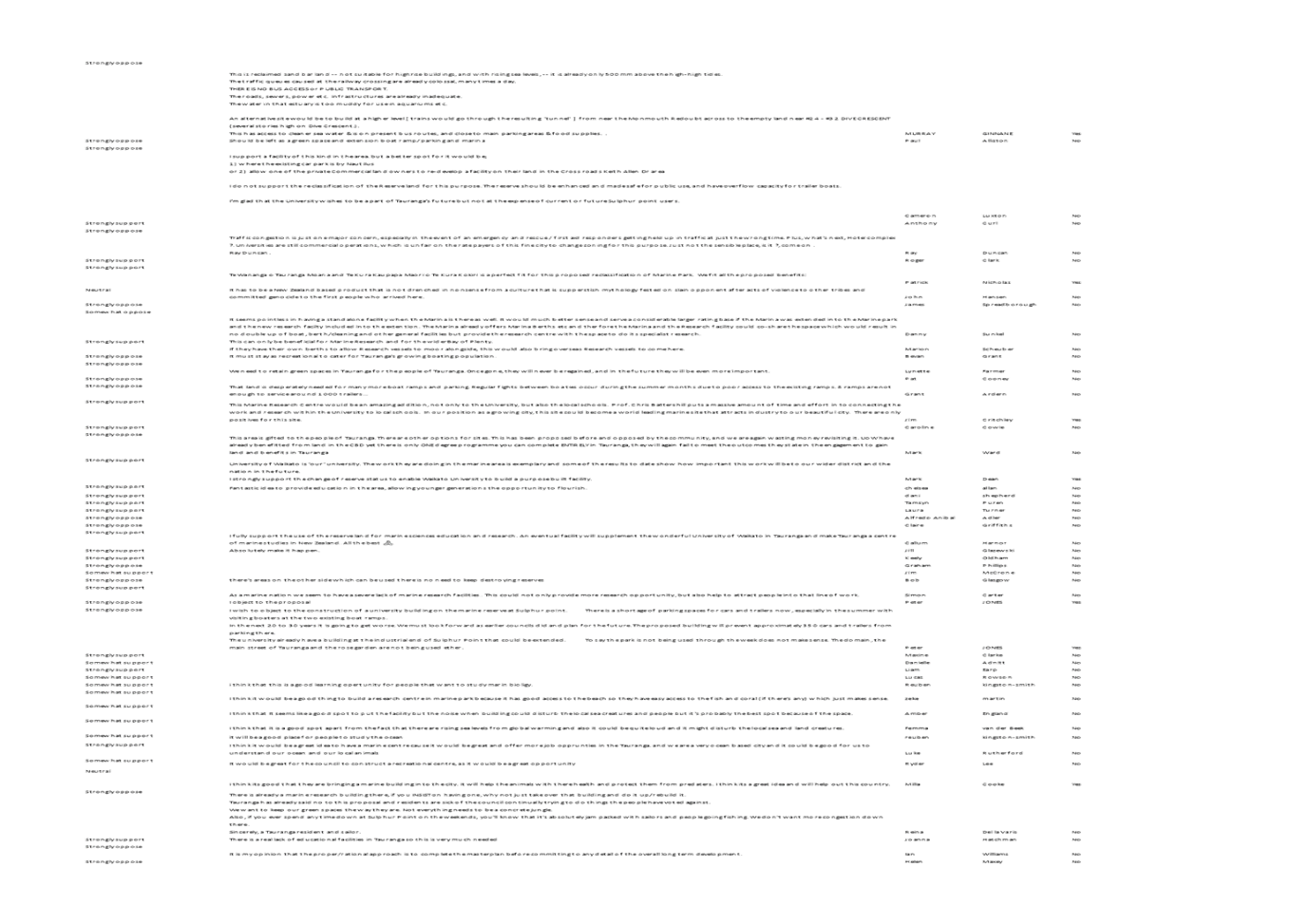
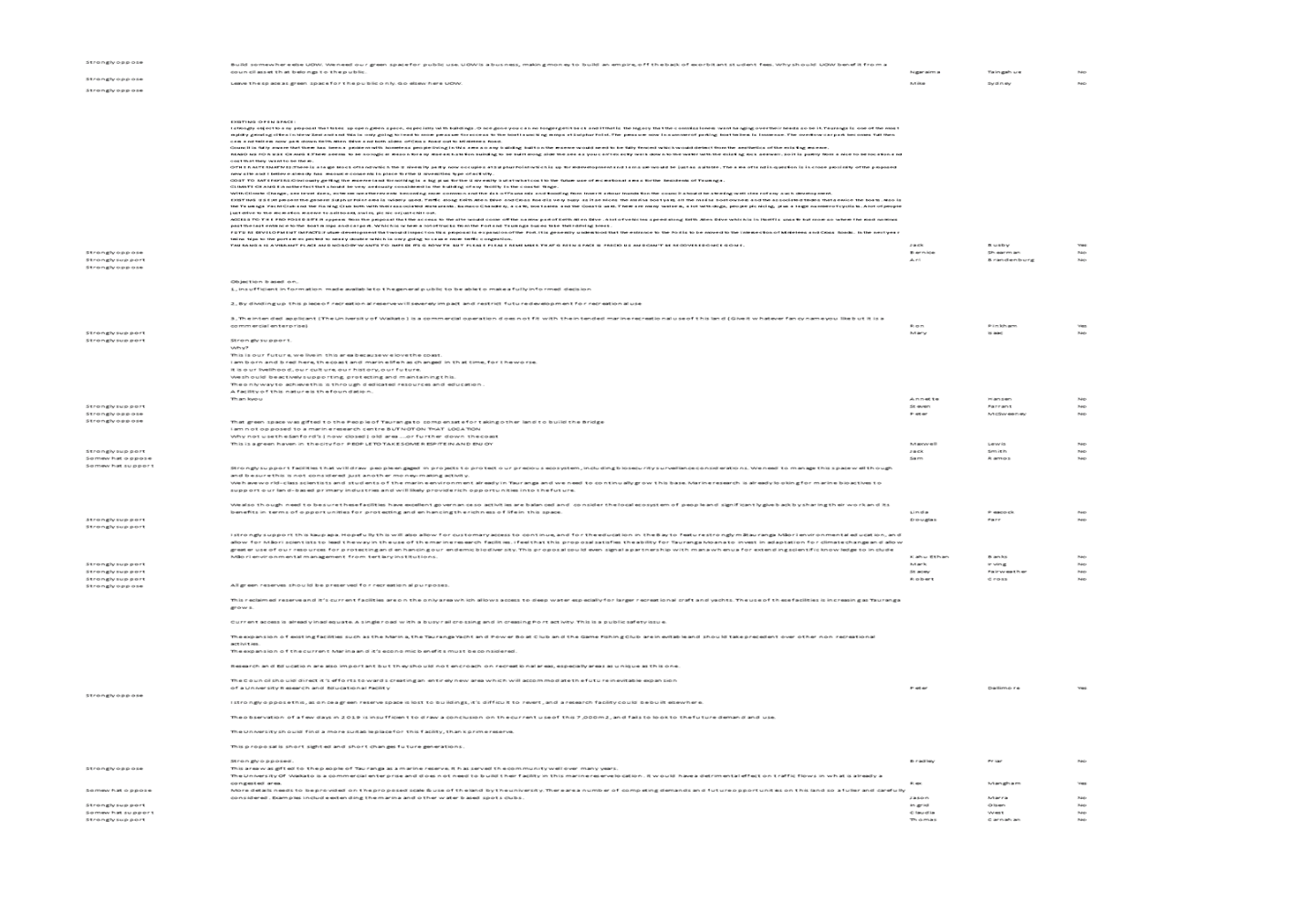
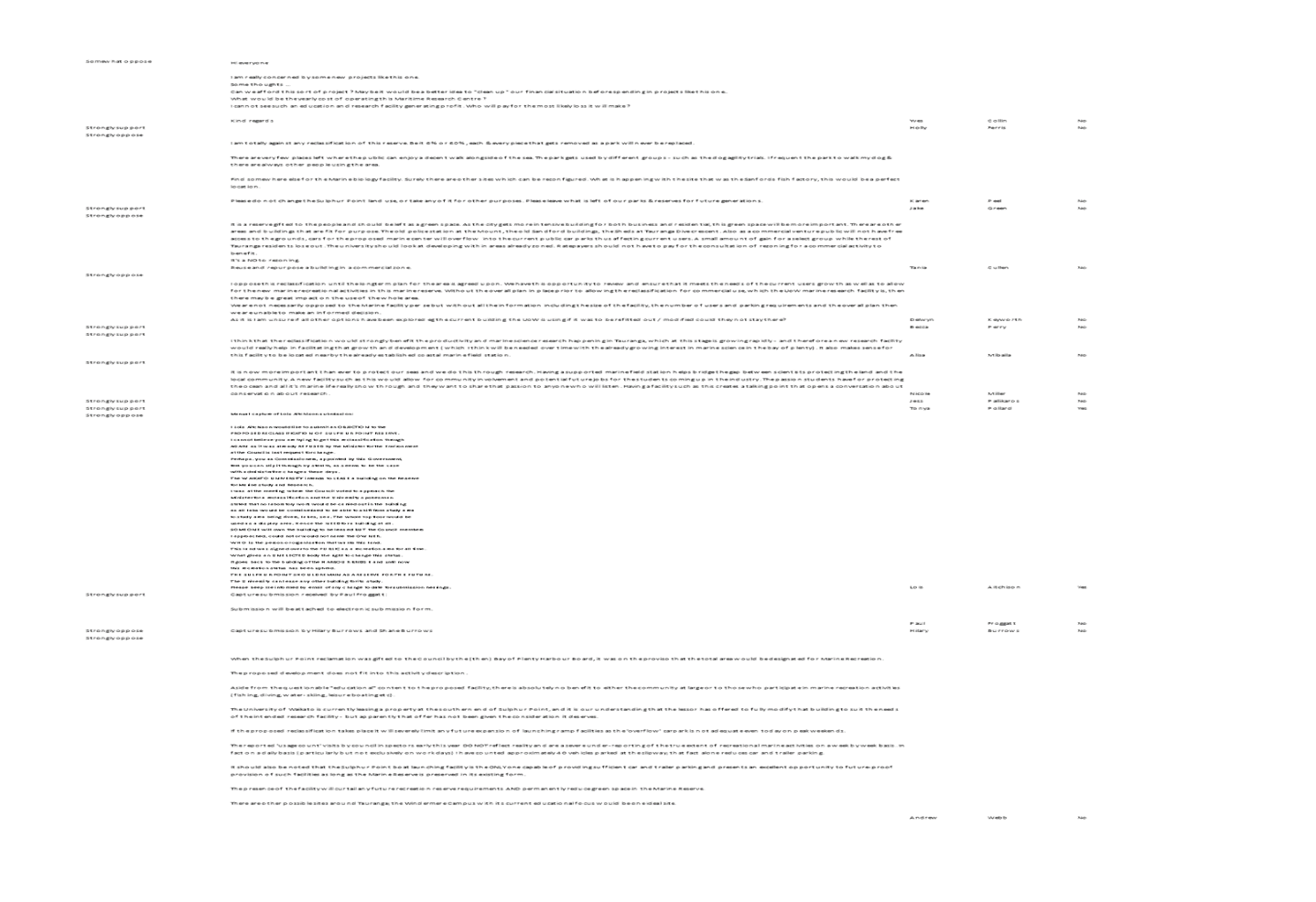

|
Ordinary Council meeting Agenda
|
27 June 2022
|
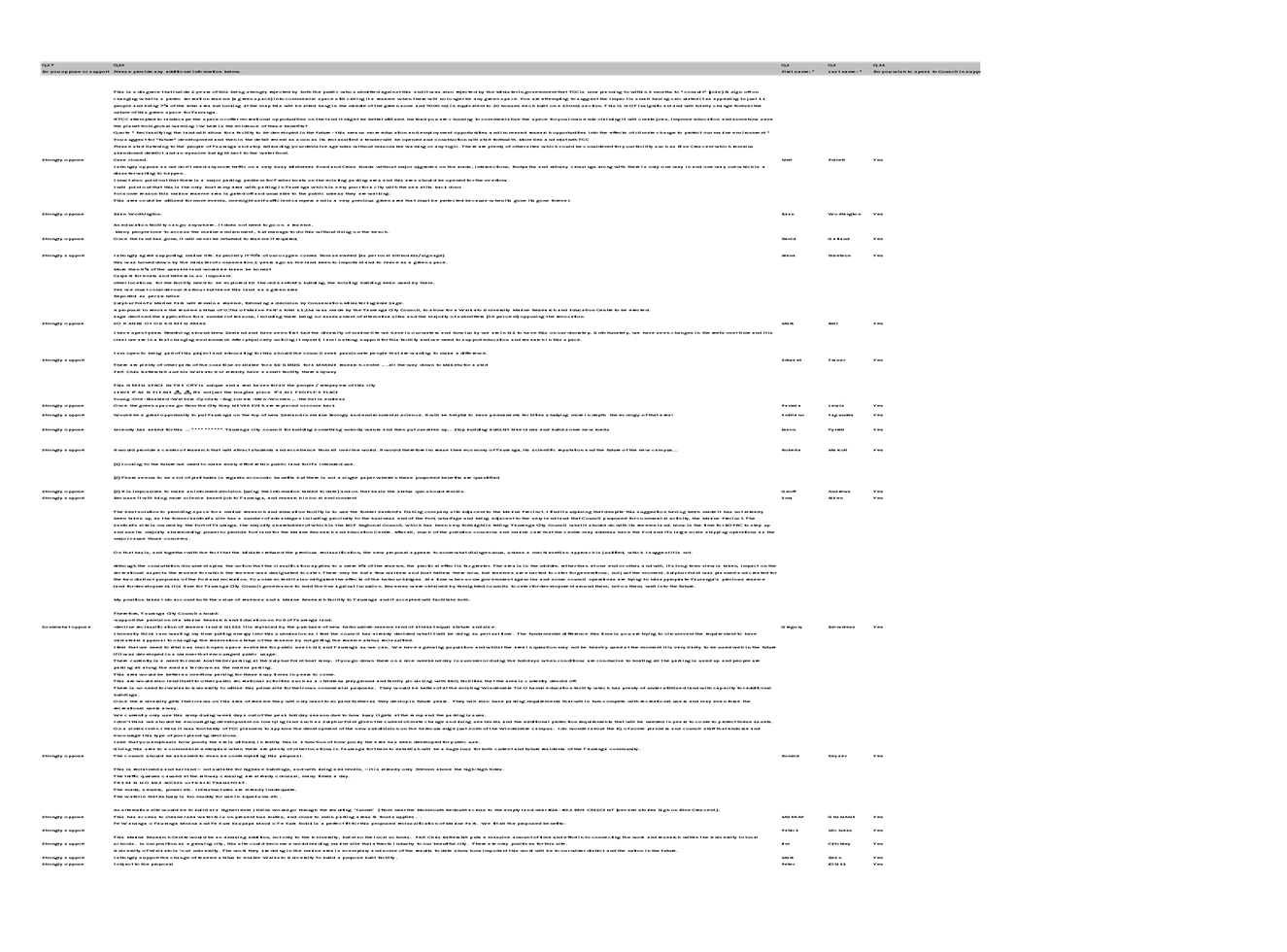
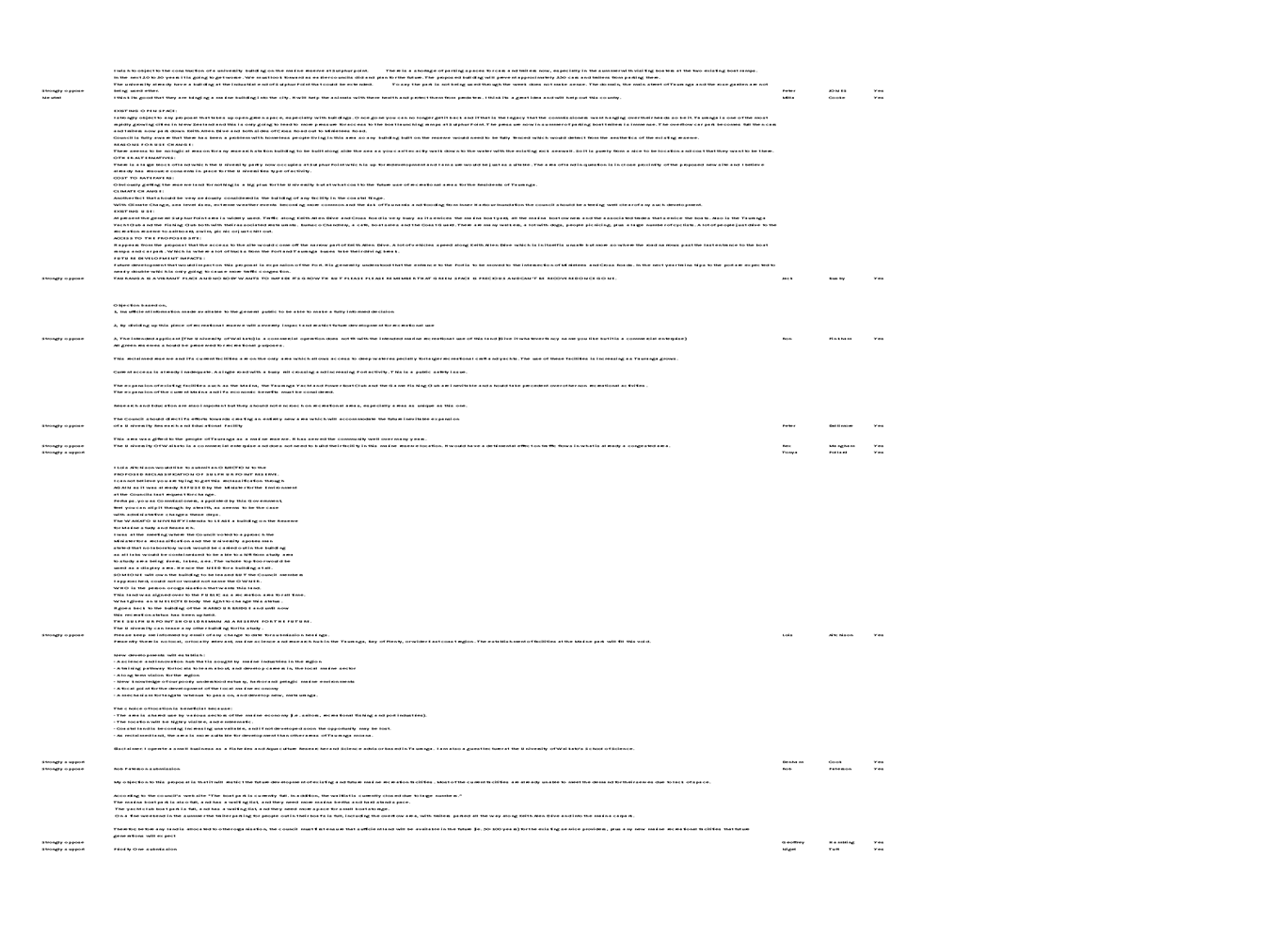
|
Ordinary Council meeting Agenda
|
27 June 2022
|
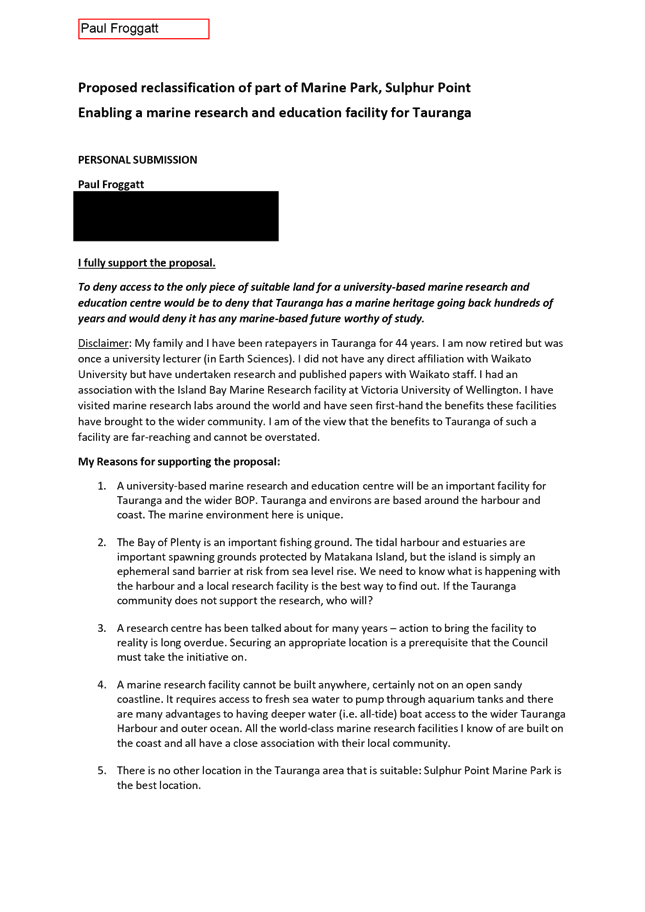
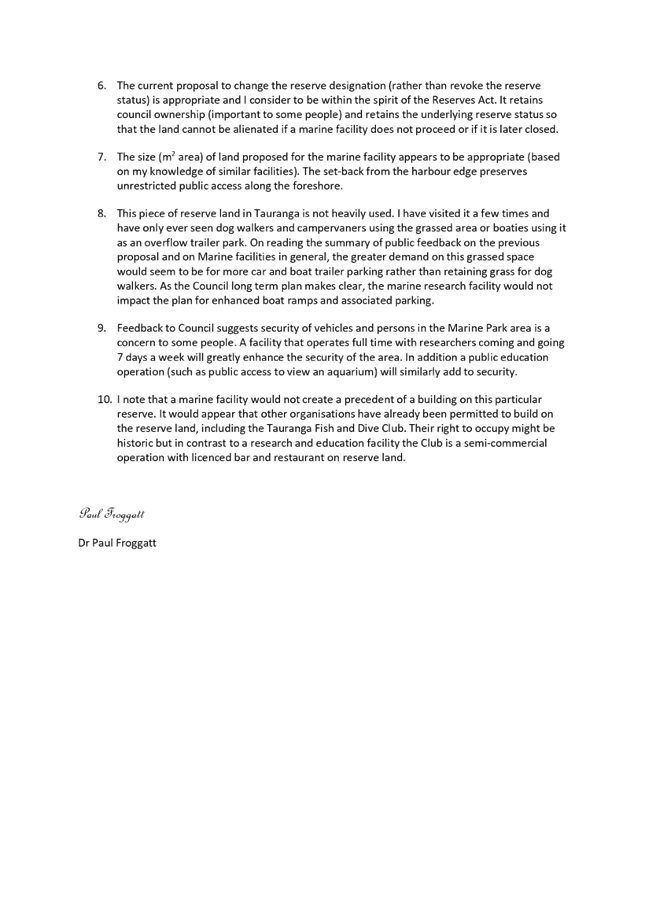
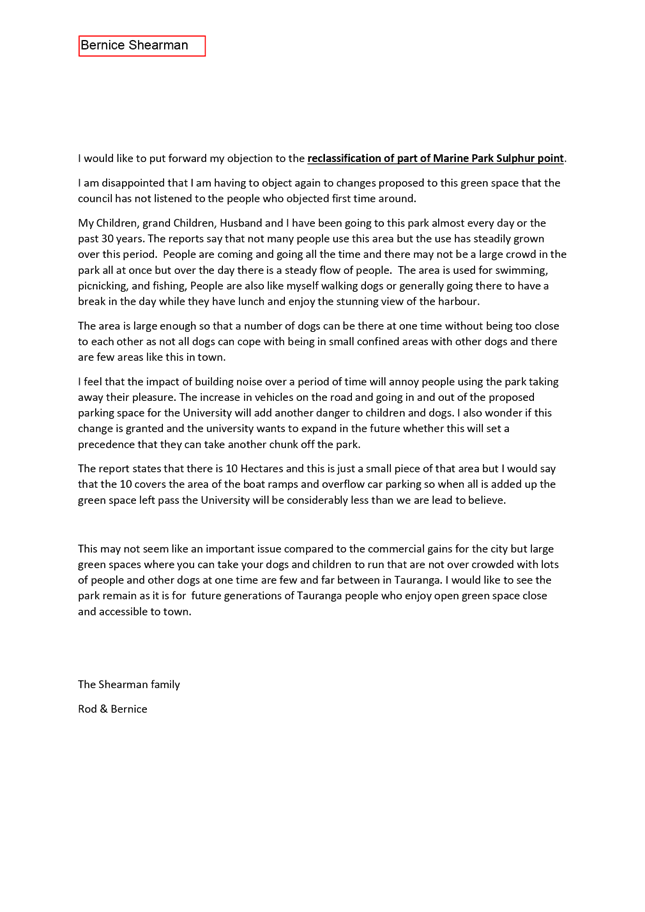
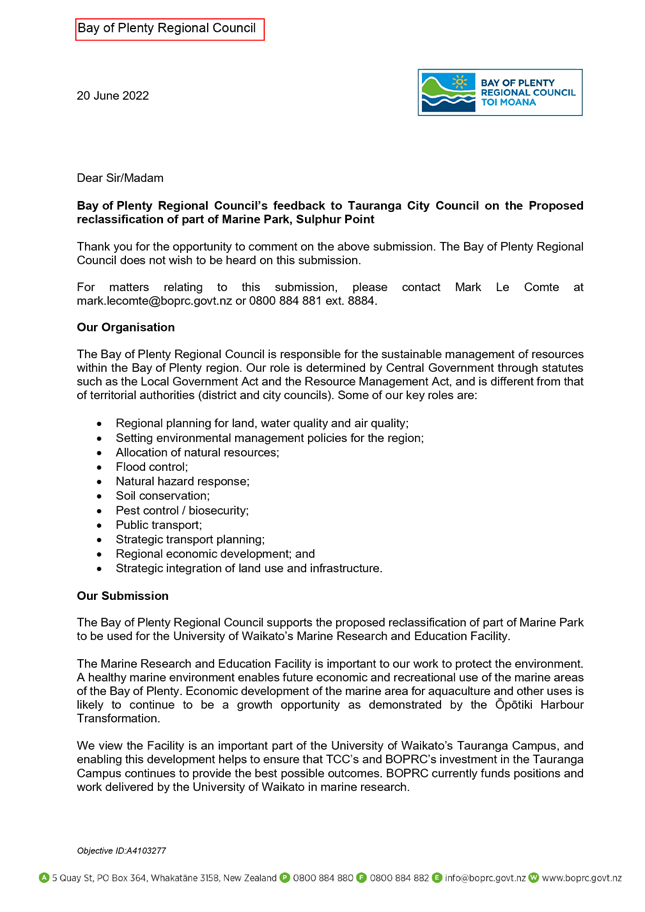

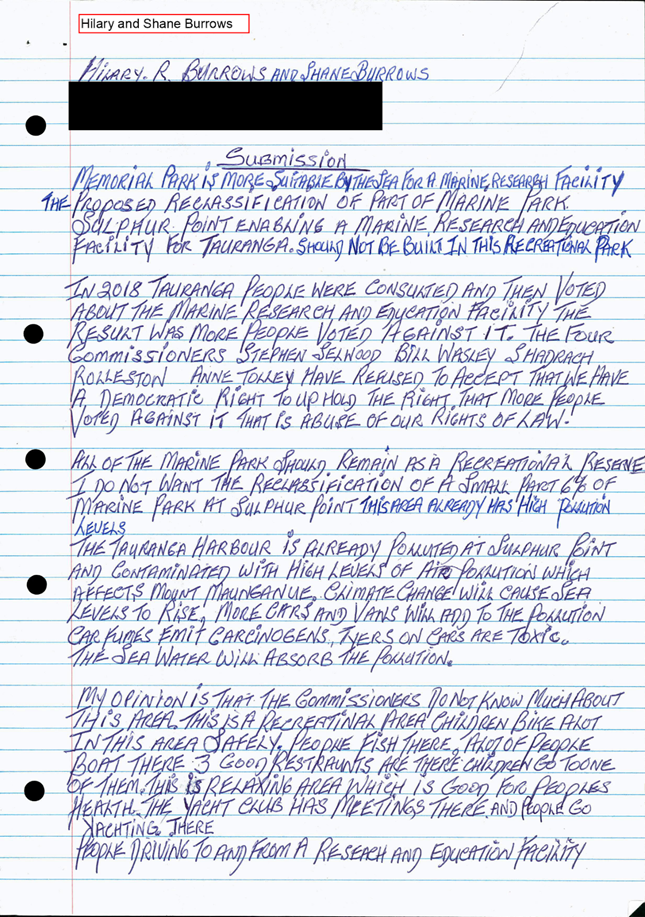

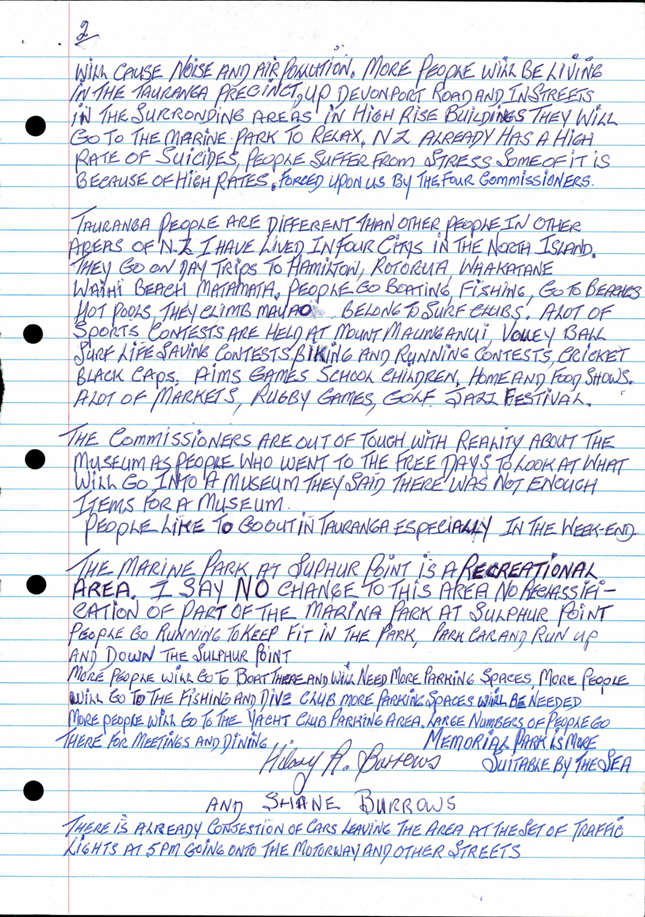
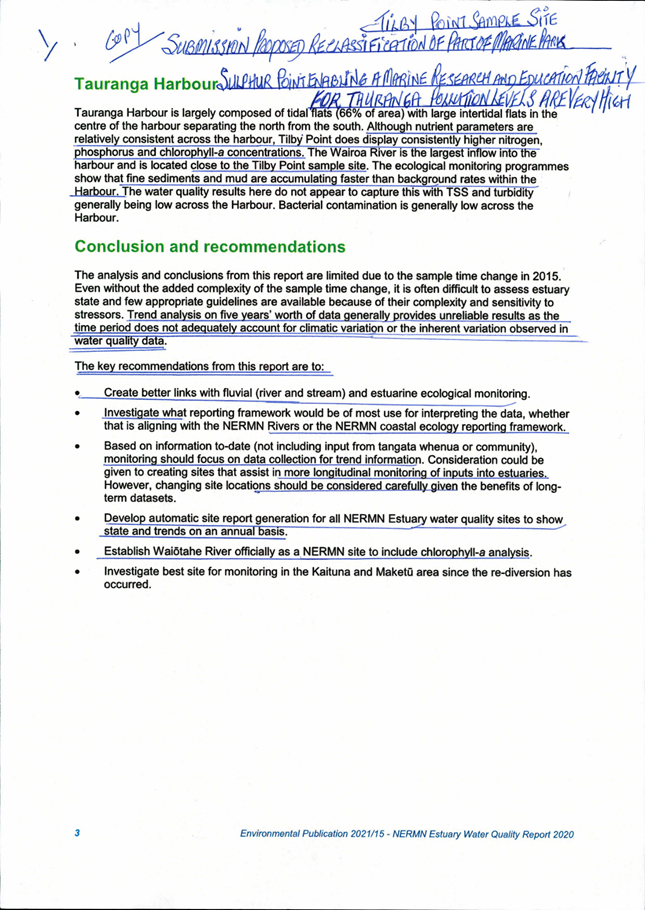
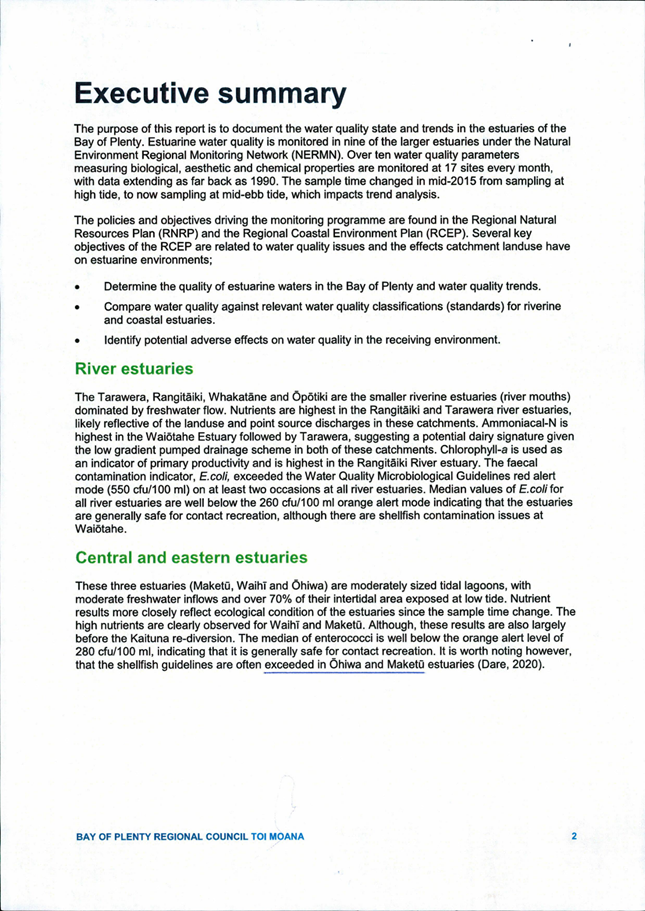
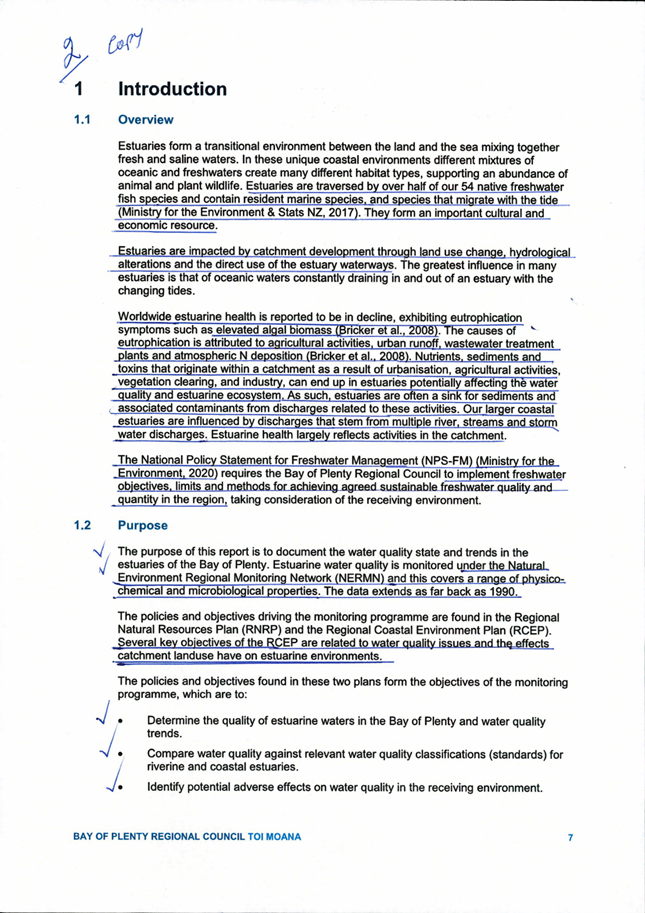
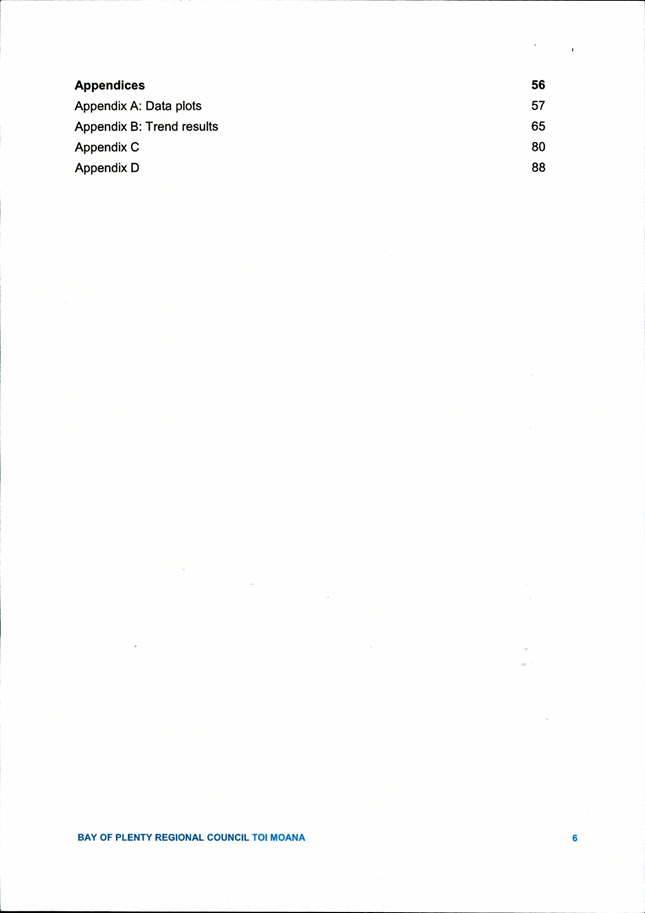
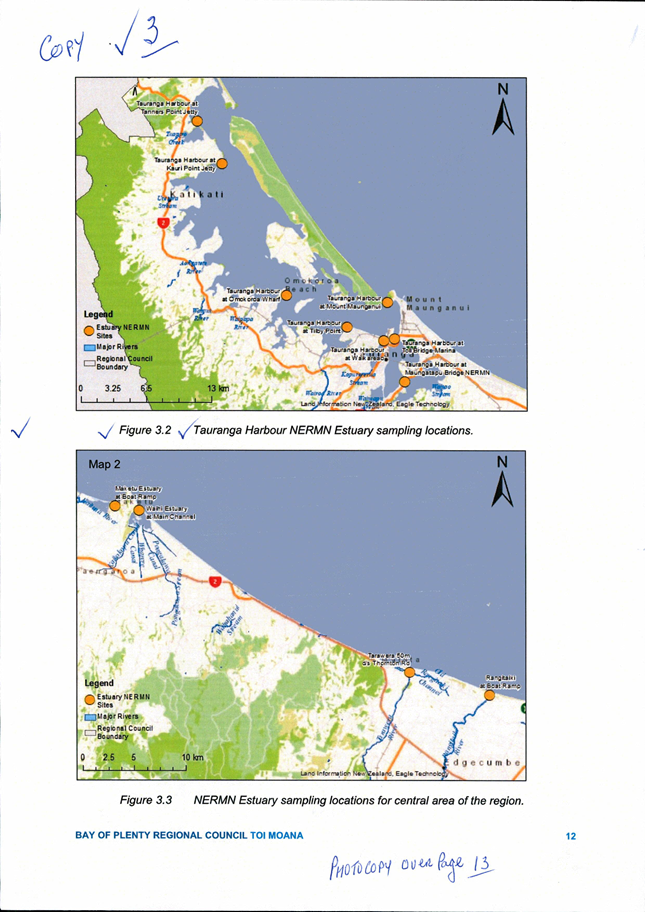
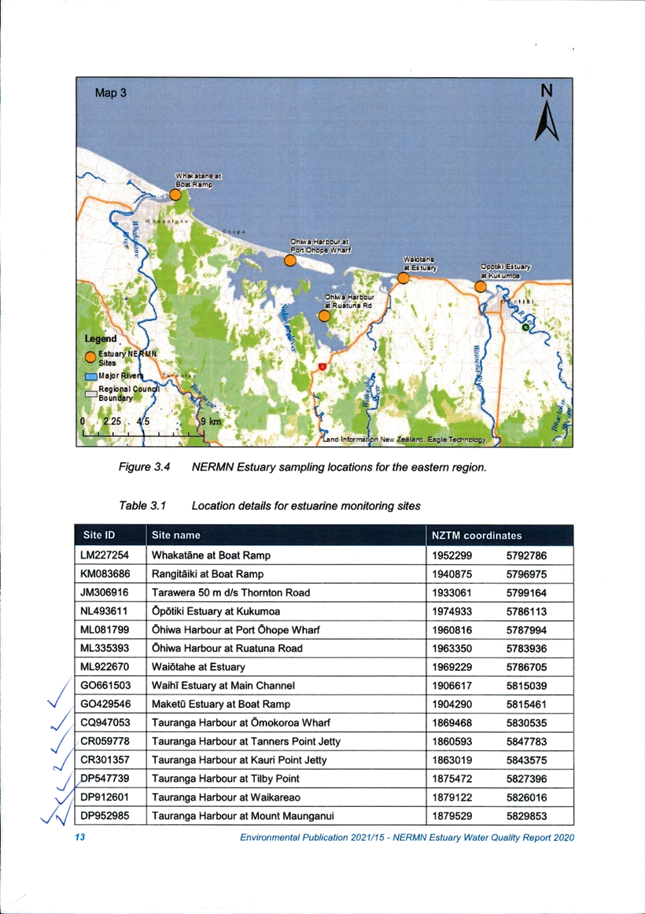
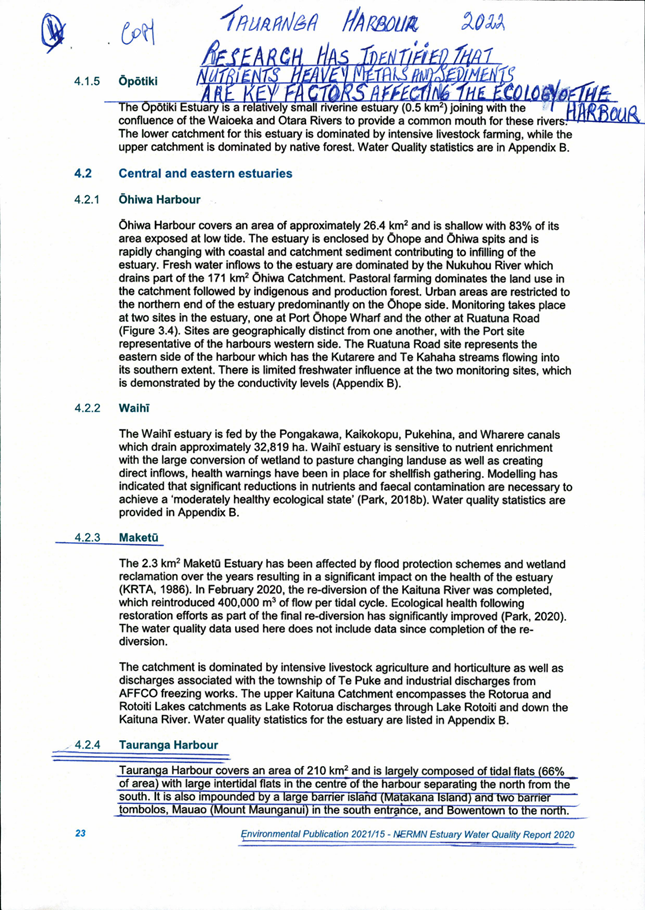
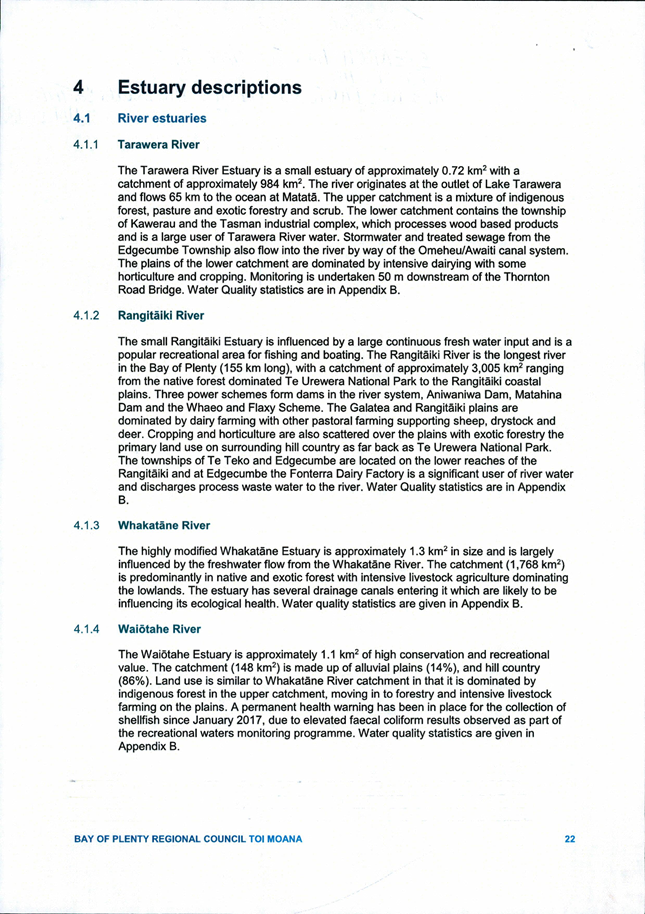
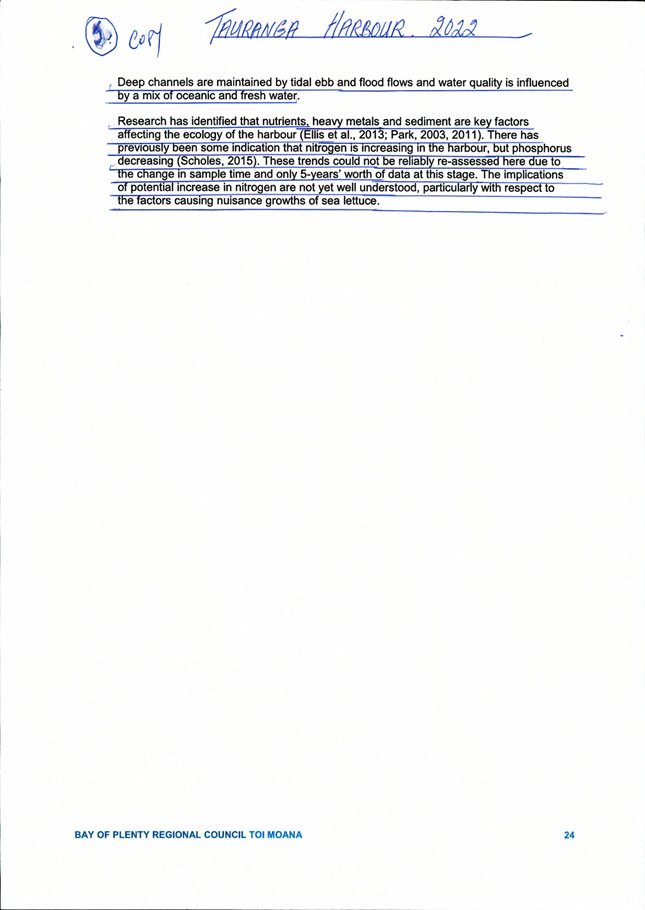

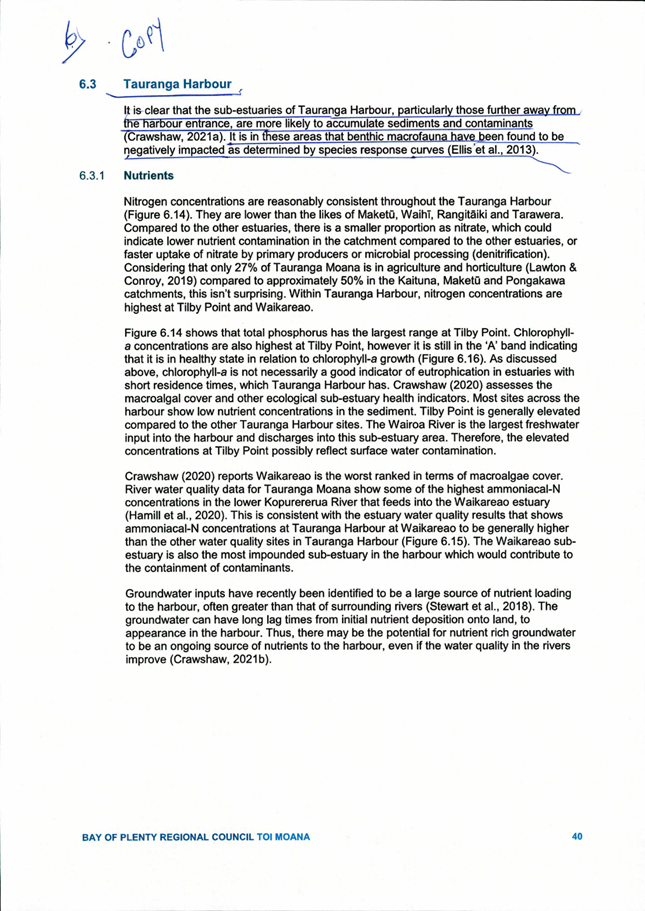
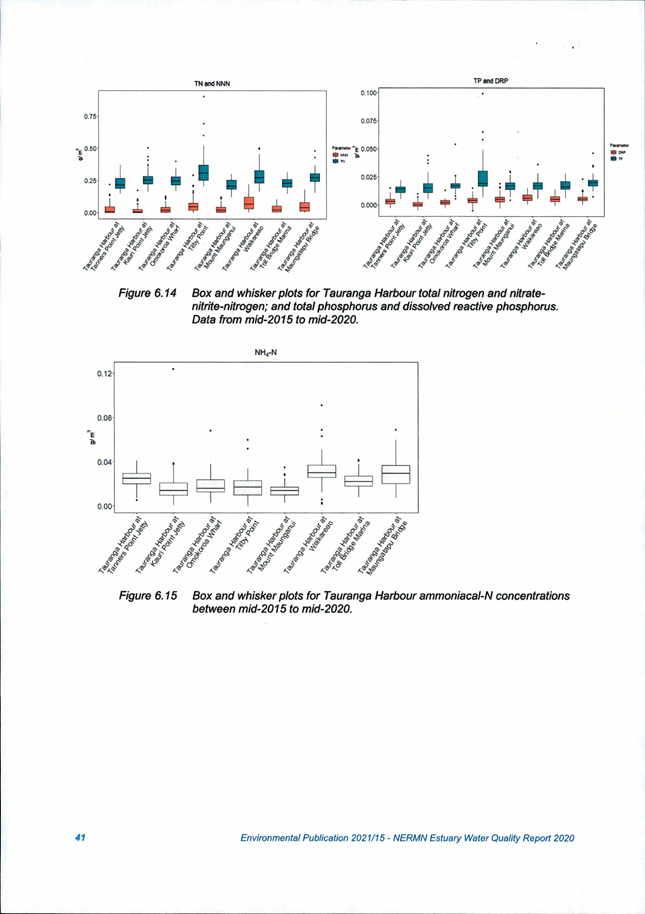
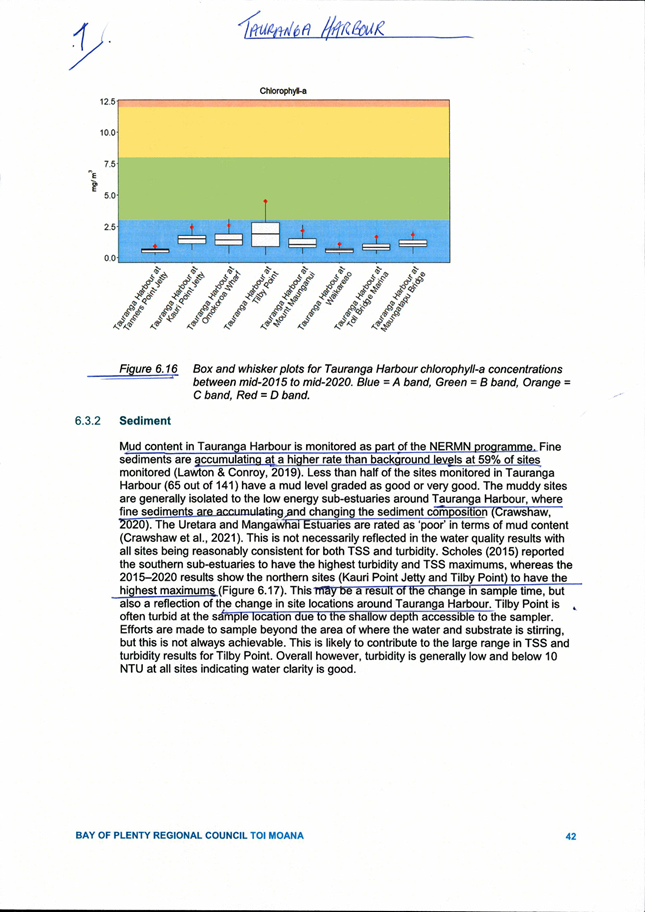
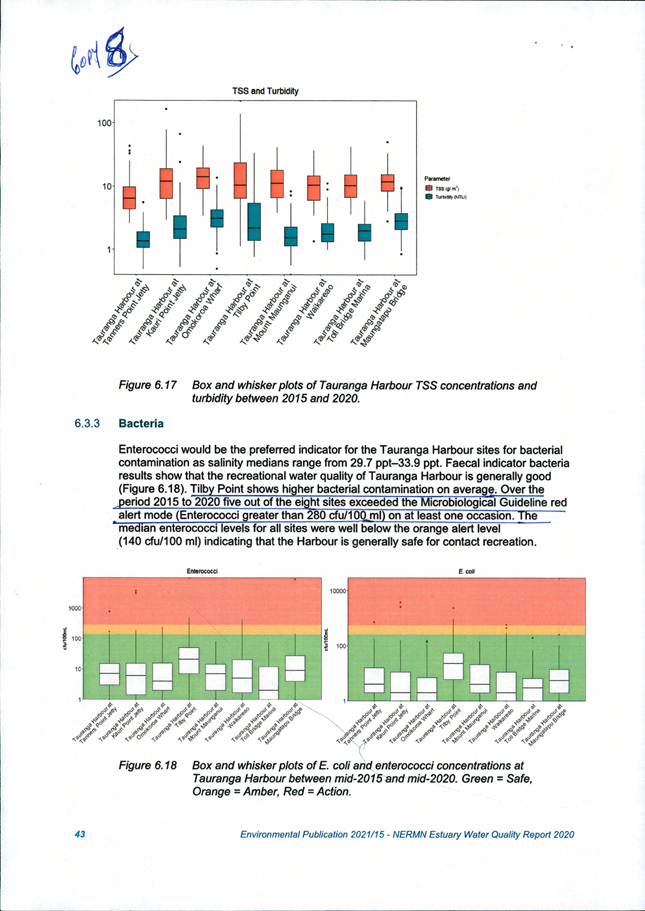
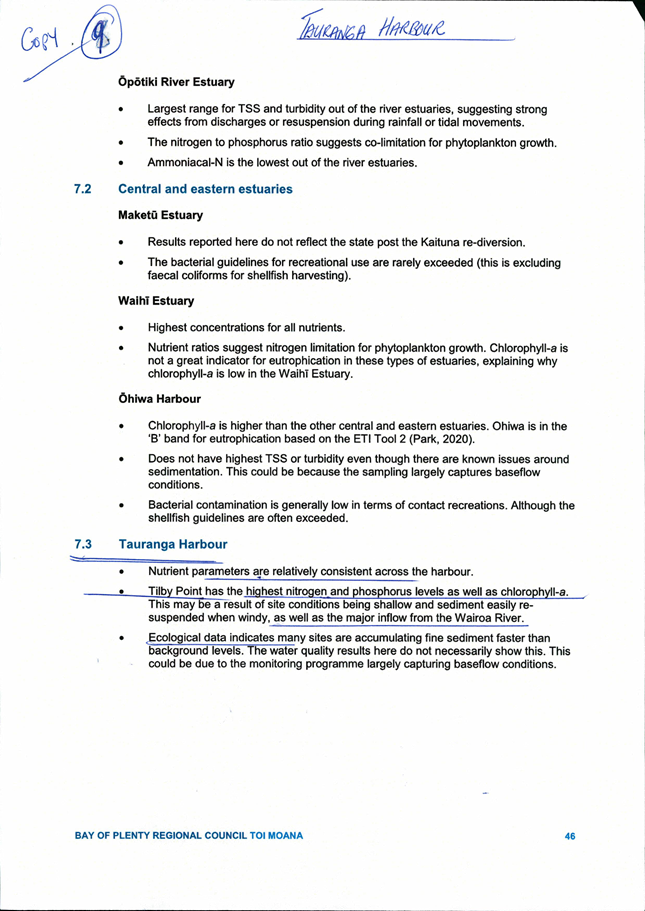
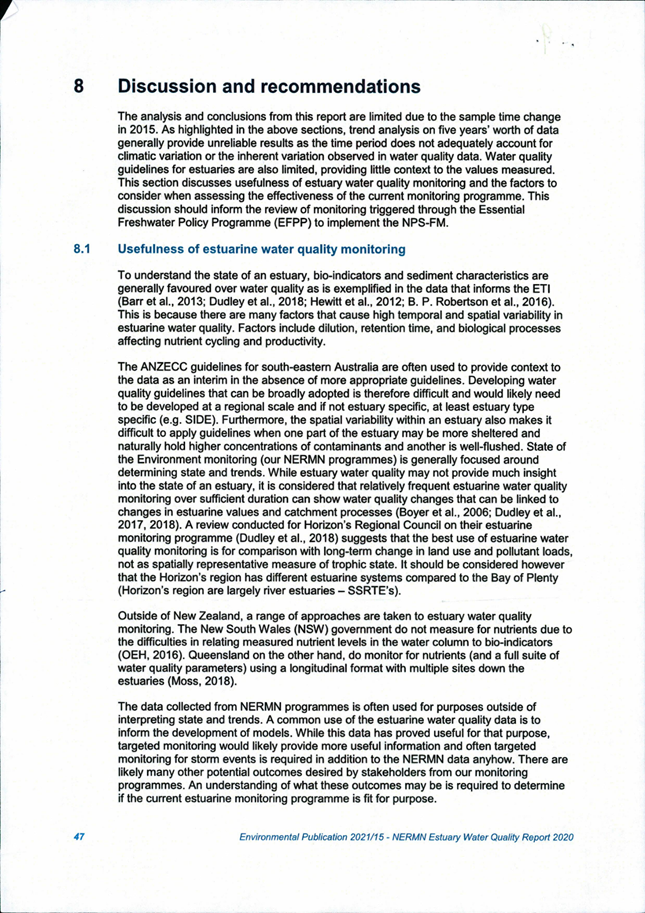
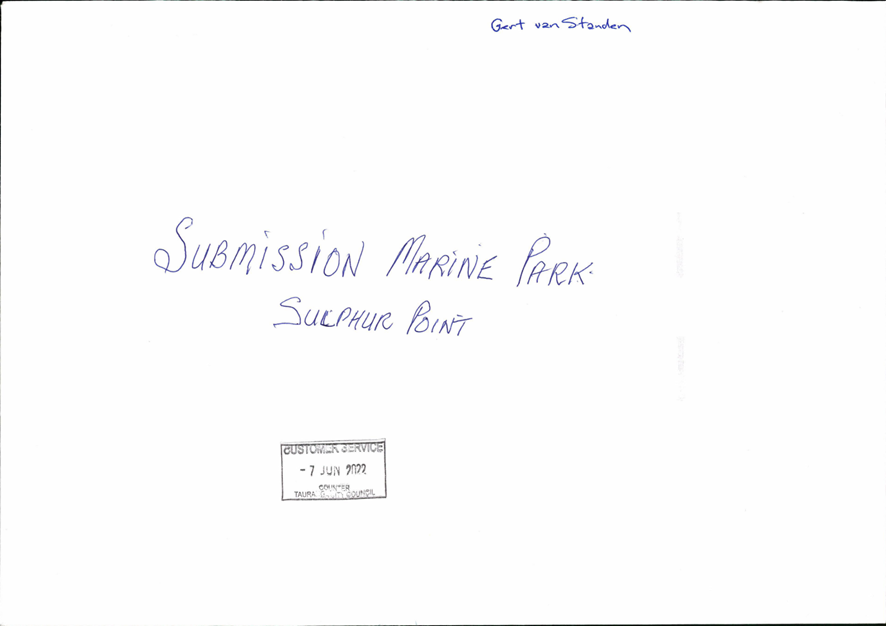
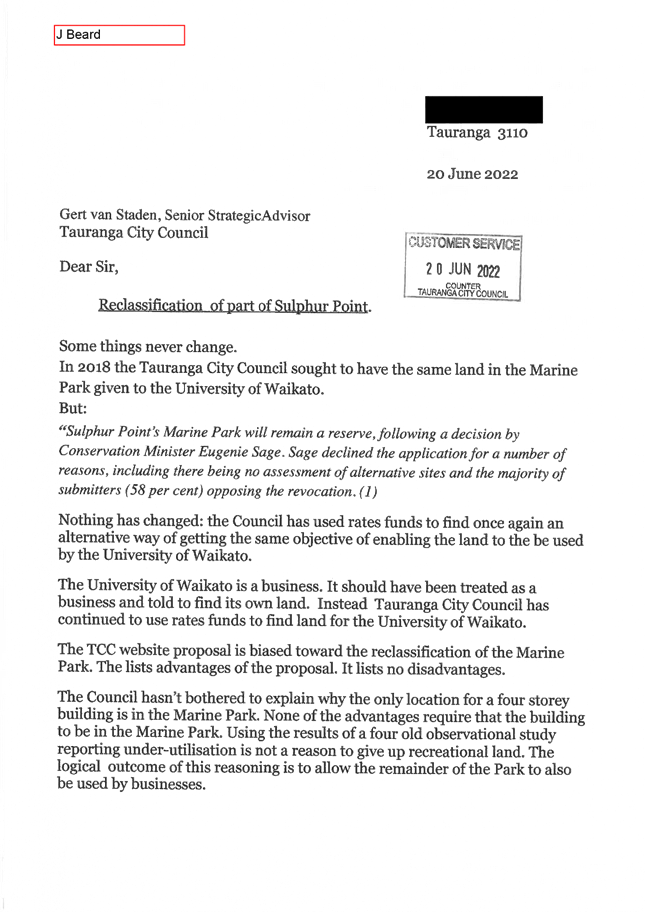

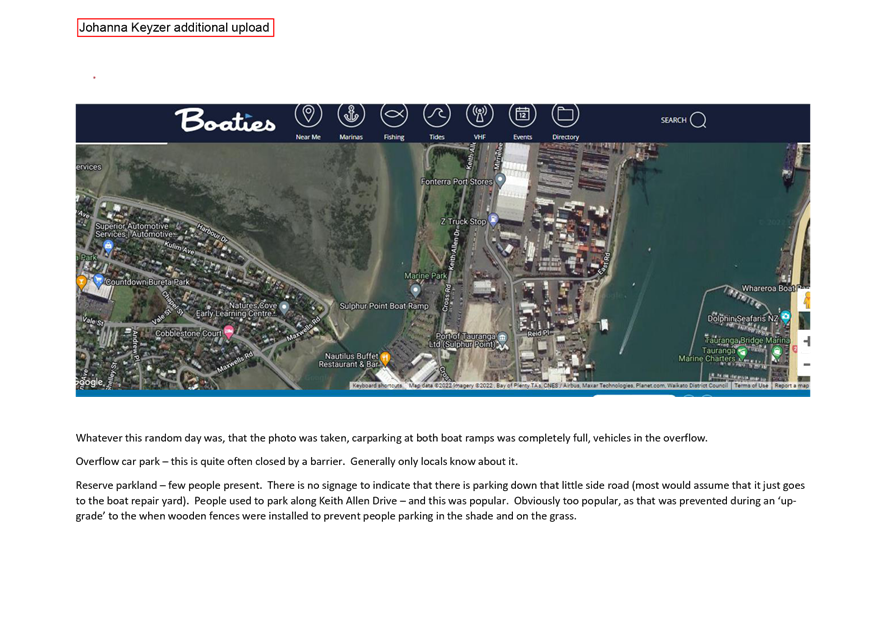
12 Discussion
of late items
13 Public
excluded session
RESOLUTION TO
EXCLUDE THE PUBLIC
|
Recommendations
That the public be
excluded from the following parts of the proceedings of this meeting.
The general subject
matter of each matter to be considered while the public is excluded, the
reason for passing this resolution in relation to each matter, and the
specific grounds under section 48 of the Local Government Official
Information and Meetings Act 1987 for the passing of this resolution are as
follows:
|
General subject of each matter to be
considered
|
Reason for passing this resolution in
relation to each matter
|
Ground(s) under section 48 for the
passing of this resolution
|
|
13.1 - Public Excluded Minutes of the
Council meeting held on 28 February 2022
|
s7(2)(a) - The withholding of the information is
necessary to protect the privacy of natural persons, including that of
deceased natural persons
s7(2)(b)(ii) - The withholding of the information
is necessary to protect information where the making available of the
information would be likely unreasonably to prejudice the commercial
position of the person who supplied or who is the subject of the
information
s7(2)(g) - The withholding of the information is
necessary to maintain legal professional privilege
s7(2)(h) - The withholding of the information is
necessary to enable Council to carry out, without prejudice or
disadvantage, commercial activities
s7(2)(i) - The withholding of the information is
necessary to enable Council to carry on, without prejudice or disadvantage,
negotiations (including commercial and industrial negotiations)
|
s48(1)(a) - the public conduct of the relevant
part of the proceedings of the meeting would be likely to result in the
disclosure of information for which good reason for withholding would exist
under section 6 or section 7
|
|
13.2 - Public Excluded Minutes of the
Council meeting held on 24 March 2022
|
s7(2)(a) - The withholding of the information is
necessary to protect the privacy of natural persons, including that of
deceased natural persons
s7(2)(b)(ii) - The withholding of the information
is necessary to protect information where the making available of the
information would be likely unreasonably to prejudice the commercial
position of the person who supplied or who is the subject of the
information
s7(2)(g) - The withholding of the information is
necessary to maintain legal professional privilege
s7(2)(h) - The withholding of the information is
necessary to enable Council to carry out, without prejudice or
disadvantage, commercial activities
s7(2)(i) - The withholding of the information is
necessary to enable Council to carry on, without prejudice or disadvantage,
negotiations (including commercial and industrial negotiations)
|
s48(1)(a) - the public conduct of the relevant
part of the proceedings of the meeting would be likely to result in the
disclosure of information for which good reason for withholding would exist
under section 6 or section 7
|
|
13.3 - Public Excluded Minutes of the
Council meeting held on 23 May 2022
|
s7(2)(a) - The withholding of the information is
necessary to protect the privacy of natural persons, including that of
deceased natural persons
s7(2)(g) - The withholding of the information is
necessary to maintain legal professional privilege
s7(2)(h) - The withholding of the information is
necessary to enable Council to carry out, without prejudice or
disadvantage, commercial activities
s7(2)(i) - The withholding of the information is
necessary to enable Council to carry on, without prejudice or disadvantage,
negotiations (including commercial and industrial negotiations)
|
s48(1)(a) - the public conduct of the relevant
part of the proceedings of the meeting would be likely to result in the
disclosure of information for which good reason for withholding would exist
under section 6 or section 7
|
|
13.4 - Public Excluded Minutes of the Council
meeting held on 24 May 2022
|
s7(2)(b)(ii) - The withholding of the information
is necessary to protect information where the making available of the
information would be likely unreasonably to prejudice the commercial
position of the person who supplied or who is the subject of the
information
|
s48(1)(a) - the public conduct of the relevant
part of the proceedings of the meeting would be likely to result in the
disclosure of information for which good reason for withholding would exist
under section 6 or section 7
|
|
13.5 - Public Excluded Minutes of the
Council meeting held on 7 June 2022
|
s7(2)(i) - The withholding of the information is
necessary to enable Council to carry on, without prejudice or disadvantage,
negotiations (including commercial and industrial negotiations)
|
s48(1)(a) - the public conduct of the relevant
part of the proceedings of the meeting would be likely to result in the
disclosure of information for which good reason for withholding would exist
under section 6 or section 7
|
|
13.6 - Public Excluded Minutes of the
Council meeting held on 13 June 2022
|
s7(2)(a) - The withholding of the information is
necessary to protect the privacy of natural persons, including that of
deceased natural persons
s7(2)(b)(ii) - The withholding of the information
is necessary to protect information where the making available of the
information would be likely unreasonably to prejudice the commercial
position of the person who supplied or who is the subject of the
information
s7(2)(g) - The withholding of the information is
necessary to maintain legal professional privilege
s7(2)(h) - The withholding of the information is
necessary to enable Council to carry out, without prejudice or
disadvantage, commercial activities
s7(2)(i) - The withholding of the information is
necessary to enable Council to carry on, without prejudice or disadvantage,
negotiations (including commercial and industrial negotiations)
|
s48(1)(a) - the public conduct of the relevant
part of the proceedings of the meeting would be likely to result in the
disclosure of information for which good reason for withholding would exist
under section 6 or section 7
|
|
13.7 - Exemption to open competition:
Mauao Placemaking Project - professional services and physical works for
cultural interpretation
|
s7(2)(b)(ii) - The withholding of the information
is necessary to protect information where the making available of the
information would be likely unreasonably to prejudice the commercial
position of the person who supplied or who is the subject of the
information
s7(2)(h) - The withholding of the information is
necessary to enable Council to carry out, without prejudice or
disadvantage, commercial activities
|
s48(1)(a) - the public conduct of the relevant
part of the proceedings of the meeting would be likely to result in the
disclosure of information for which good reason for withholding would exist
under section 6 or section 7
|
|
13.8 - Council Resolution for Closed
Competition - Kiwirail Underpass
|
s7(2)(a) - The withholding of the information is
necessary to protect the privacy of natural persons, including that of
deceased natural persons
|
s48(1)(a) - the public conduct of the relevant
part of the proceedings of the meeting would be likely to result in the
disclosure of information for which good reason for withholding would exist
under section 6 or section 7
|
|
14 Closing
karakia



































































